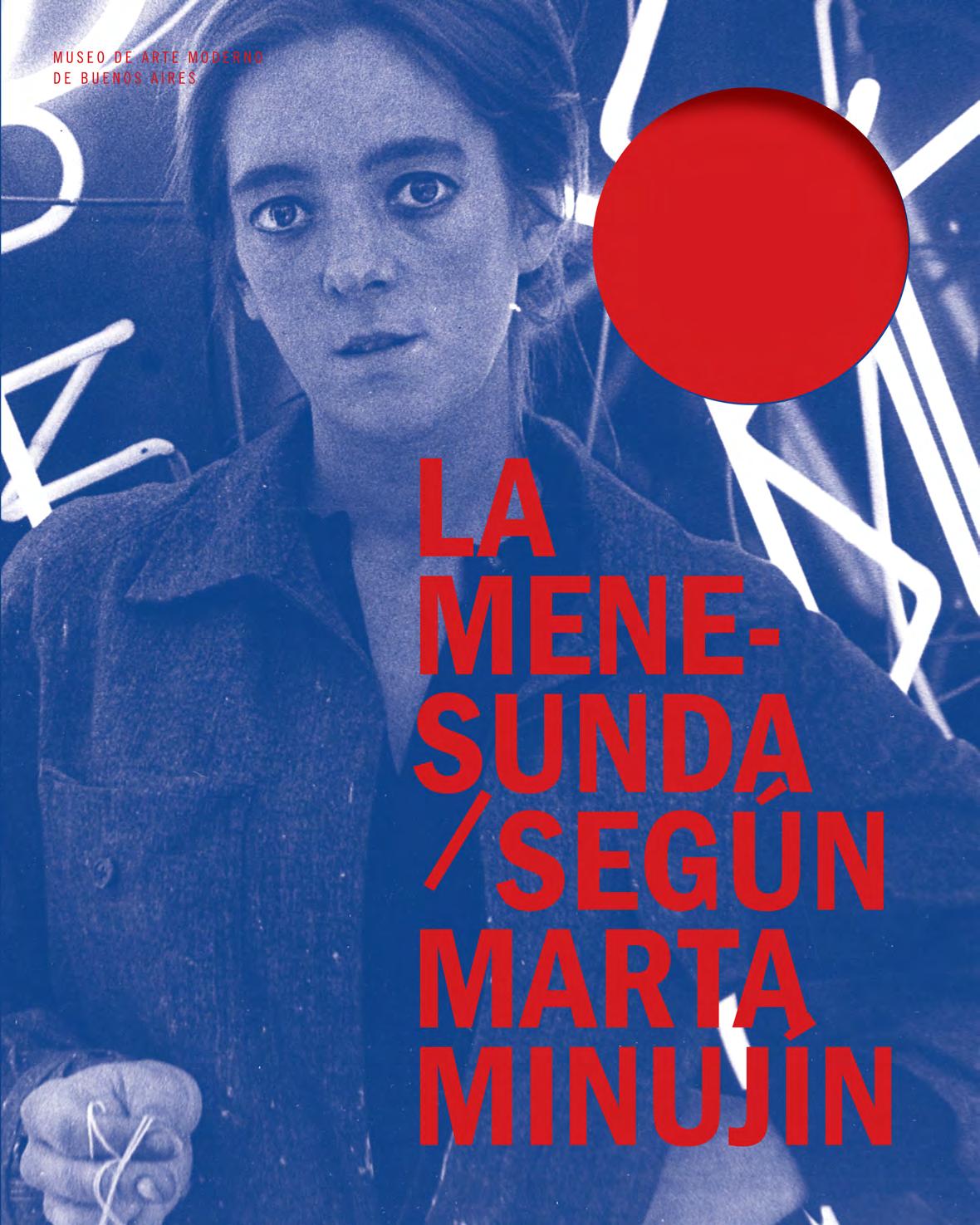

1
2
ALIADO ESTRATÉGICO
CON LA COLABORACIÓN DE
MEDIOS ASOCIADOS SPONSOR APOYO
AUTORIDADES DEL GOBIERNO DE LA CIUDAD DE BUENOS AIRES
Ing. Mauricio Macri Jefe de Gobierno
Lic. Horacio Rodríguez Larreta Jefe de Gabinete de Ministros
Ing. Hernán Lombardi Ministro de Cultura
María Victoria Alcaraz Subsecretaria de Patrimonio Cultural
Pedro Aparicio Director General de Museos
Lic. Victoria Noorthoorn Directora del Museo de Arte Moderno de Buenos Aires
3

Contactos La Menesunda, 1965
Del 8 de octubre de 2015 al 28 de febrero de 2016
LA SEGÚNMENESUNDA MINUJÍNMARTA

DE ARTE MODERNO DE BUENOS AIRES
MUSEO
Este libro fue publicado en ocasión de La Mesesunda según Marta Minujín, presentada en el Museo de Arte Moderno de Buenos Aires desde el 08 de octubre de 2015 al 28 de febrero de 2016
© Imágenes reproducidas: Museo de Arte Moderno de Buenos Aires, 2015
Noorthoorn, Victoria
La Menesunda según Marta Minujín / Victoria Noorthoorn.1a ed. edición bilingüe. - Ciudad Autónoma de Buenos Aires: Ministerio de Cultura del Gobierno de la Ciudad Autónoma de Buenos Aires.
Dirección General de Museos, 2015.
220 p. ; 25 x 20 cm.
ISBN 978-987-1358-40-3
1. Arte Argenitno. I. Título.
CDD 709
Museo de Arte Moderno de Buenos Aires
Av. San Juan 350 (1147) Buenos Aires
Impreso en Argentina
Akian Gráfica Editora Clay 2972 Buenos Aires, Argentina www.akiangrafica.com
6
ÍNDICE INDEX
p.08 Agradecimientos Por Victoria Noorthoorn
p.21 La Menesunda Por Sofía Dourron
p.57 Film Stills de La Menesunda (1965) por Leopoldo Maler
p.157 La reconstrucción de La Menesunda
Por Sofía Dourron, Iván Rösler, Almendra Vilela, Javier Villa y Agustina Vizcarra
p.186 Biografía Marta Minujín
p.202 Biografía Rubén Santantonín
p.211 Bibliografía
7
p.08 p.21 p.57 p.159 p187 p.203 p.211
Agradecimientos
Por Victoria Noorthoorn
8
El Museo de Arte Moderno de Buenos Aires tiene el privilegio de presentar la reconstrucción de La Menesunda (1965), la obra emblemática realizada por Marta Minujín y Rubén Santantonín por encargo de Jorge Romero Brest, Director del Centro de Artes Visuales del Instituto Torcuato Di Tella, y que contó con la importante colaboración de Floreal Amor, David Lamelas, Leopoldo Maler, Rodolfo Prayón y Pablo Suárez. Esta reconstrucción, es, sin dudas, un momento de inflexión en la gestión del Museo por los inmensos desafíos que implica poner en escena esta obra compleja, que permanece como un mito en la memoria de tantos profesionales del arte y artistas argentinos.
La Menesunda buscaba provocar al espectador e instarlo a la acción: movilizarlo, agitarlo y ofrecerle una nueva experiencia estética, donde lo culto y lo popular se confundiesen en un espacio en el que habrían de confluir lo más sofisticado del arte contemporáneo del momento y una enorme cantidad de elementos de la experiencia estética de la vida cotidiana, en un tiempo en que el consumo y la nueva cultura de masas estaban cambiando el paisaje de la ciudad y los hogares de la clase media argentina. En La Menesunda, la calle y los lenguajes de vanguardia se combinaban a través de una sucesión de estímulos multisensoriales, estéticos y éticos. Entre el folclore y el espectáculo mediático, la “confusión” a la que apelaba la obra quedó registrada en la prensa de la época como memoria de un tiempo de profundos cambios en los modos de entender y experimentar el arte: marcó un punto de quiebre, un antes y un después. En La Menesunda confluyen dos artistas que, cada uno por separado, revolucionó el arte argentino tensionando hasta el extremo las posibilidades de la vanguardia del momento.
Reconstruir La Menesunda implicó sortear múltiples desafíos. En primer lugar, abordar la reconstrucción sin Rubén Santantonín presente. De allí la importancia del título del proyecto en el Moderno: La Menesunda “según Marta Minujín”, que pone de relevancia el rol fundamental de Marta Minujín en la posibilidad misma de llevar adelante este ambicioso proyecto originalmente ideado y dirigido por sus dos autores. Con esta cláusula en el título del proyecto, el Museo de Arte Moderno asume las limitaciones que pueda presentar este emprendimiento y que bien podrían deberse a la falta de interlocución con Rubén Santantonín.
En segundo lugar, encarar cincuenta años después la reconstrucción de uno de los grandes mitos de la cultura artística y visual, en un contexto de recepción en el que la noción de lo monumental ha cambiado radicalmente. Aquello que sorprendía en 1965 apenas sorprenderá hoy. Apostamos, entonces, por afirmarnos en 1965 desde el comienzo mismo de la obra, y recuperar aquella experiencia de escala 1:1, de escala humana, en la cual la experiencia artística se medía por la puesta en acción del propio cuerpo del espectador.
Por último, el desafío de lanzarse a reconstruir La Menesunda sin contar con los planos originales. A partir de una nueva investigación, los equipos técnicos estructuraron los once ambientes que componían el recorrido y sus
9
espacios de transición basándose en un análisis pormenorizado de las fuentes documentales (fotografías, artículos de prensa, correspondencia, y registros audiovisuales, incluido el film de Leopoldo Maler), en los relatos de la propia Minujín —cuya memoria, hemos constatado, es realmente prodigiosa— y de otros protagonistas de la época que la recorrieron.
Una obra de reconstrucción de estas características sólo es posible gracias al trabajo de un enorme equipo de profesionales y empresas y pone a prueba los conocimientos técnicos y la estructura del Museo, como sucede con todas las obras que tensionan su tiempo expandiendo sus límites, e incluso poniendo en crisis el orden de lo aceptable.
La Menesunda según Marta Minujín ha contado con el apoyo incondicional y la activa participación del Gobierno de la Ciudad de Buenos Aires, a través del Régimen de Promoción Cultural, de los equipos técnicos del Museo, de Marta Minujín y de nuestros generosos sponsors.
Dentro del Gobierno de la Ciudad de Buenos Aires, agradecemos muy especialmente el apoyo a la gestión del Museo que recibimos constantemente de Horacio Rodríguez Larreta, Jefe de Gabinete de Ministros, Hernán Lombardi, Ministro de Cultura, María Victoria Alcaraz, Subsecretaria de Patrimonio Cultural, Pedro Aparicio, Director General de Museos, y Alejandro Capato, Director General Técnico, Administrativo y Legal del Ministerio de Cultura, y sus respectivos equipos. Vaya también nuestro agradecimiento a Franco Moccia, Subsecretario de Planeamiento y Control de Gestión, y a Juan Pablo Fasanella, Director General de Evaluación del Gasto, por su constante atención a este gran museo de la ciudad, que busca posicionarse como referente líder en arte argentino en nuestra ciudad y en el mundo.
Asimismo, agradecemos al Consejo de Promoción Cultural por apoyar muy especialmente este gran proyecto, que permite que los ciudadanos del mundo puedan reencontrarse con una de las obras históricas más importantes de la cultura visual de la Argentina. A Juan Manuel Beati Vindel, Presidente del Consejo, y a sus miembros: Carlos Ernesto Gutiérrez, Carlos Ángel Porroni, Maria Anahí Cordero, Astrid Obonaga y Celso Alberto Silvestrini; a los Consejeros Alternos en Artes Visuales: María Silvia Corcuera, Marion Eppinger y Ataúlfo Pérez Aznar, nuestra especial gratitud.
Deseo expresar nuestro más profundo agradecimiento al Banco Supervielle, aliado estratégico del Museo de Arte Moderno de Buenos Aires que hace posible nuestra actividad durante los 365 días del año. Le agradecemos por recibir con tanto entusiasmo nuestra propuesta de apoyar la presentación de La Menesunda según Marta Minujín en el Moderno, una obra cuyos desafíos son tan importantes que sería imposible llevarla a cabo sin un apoyo estratégico tan contundente.
Asimismo, extiendo mi agradecimiento personal a nuestra Asociación
10
Amigos y a su flamante Comisión Directiva que se entusiasma a cada paso con los proyectos que proponemos todos los días para hacer de este Museo una institución de excelencia del siglo XXI, como también a nuestros sponsors que acompañan cada una de nuestras iniciativas: Alba Artística, Grupo Clarín, Durlock, Gancia, Plavicon, Fundación Andreani e Interior Forma Knoll, quienes contribuyeron activamente al proceso de construcción del proyecto.
Dentro del Museo de Arte Moderno de Buenos Aires, agradezco a Javier Villa, Curador de Arte Contemporáneo del Museo, y a Sofía Dourron, Asistente Curatorial del Museo, por su seguimiento curatorial de este proyecto, que requirió tanta atención en tan diversas instancias. Recién llegada al Museo, Sofía abrazó este proyecto con extremo rigor y valentía y produjo gran parte de los textos que se publican hoy en este catálogo, que nos enorgullece. Por su interlocución a lo largo de este proceso, que se desprende de su trabajo de investigación sobre la obra de Marta Minujín, agradezco asimismo a Jimena Ferreiro, Coordinadora de Curaduría y Curadora Asistente, quien también colaboró en la producción de esta importante publicación.
Ahora bien, más allá del fundamental seguimiento curatorial, este proyecto sólo puede materializarse con un impecable y obsesivo equipo de Producción. Mi agradecimiento especialísimo, entonces, a Iván Rösler, Jefe de Diseño y Producción de Exposiciones, que aceptó el desafío de dirigir este proyecto a pesar de su escala y complejidad, y cuyo desempeño estuvo a la altura de todas las exigencias de excelencia que nos propusimos. Dentro de su equipo, Almendra Vilela, Coordinadora de Producción, lideró el proyecto con el mayor profesionalismo, atendiendo a la necesidad de lograr en todo momento —tanto en su estructura como en los detalles— fidelidad absoluta al proyecto original. Por su generosidad, dedicación, calma y sabiduría, le agradezco el enorme esfuerzo y trabajo dedicado a este gran proyecto. Por su parte, Agustina Vizcarra asumió como propios los desafíos de La Menesunda según Marta Minujín y también contribuyó a que el proyecto viera la luz con una fidelidad al original y una exigencia pocas veces vista. Vaya mi agradecimiento a Pino Monkes, Jefe de Conservación del Museo, por su importantísima interlocución a lo largo de todo este proceso.
Dentro del equipo de Marta Minujín, mi agradecimiento al Arquitecto Fernando Manzone, quien trabajó en los planos de La Menesunda, y a Gerardo Peña, el constructor que asumió el desafío no sólo de encarar el proyecto de la construcción de estructuras, sino de comprender las múltiples necesidades de perfección que un proyecto como éste exige a cada paso.
Este proyecto demandó, como pocos, el enorme compromiso y trabajo de nuestro equipo de Desarrollo de Fondos. Agradezco el inmenso trabajo puesto en conseguir el necesario apoyo para La Menesunda según Marta Minujín de María Florencia Munaretto, nuestra siempre creativa Jefa de Desarrollo de Fondos, de Silvia Braun, Coordinadora de Desarrollo de Fondos, por su tenacidad para conseguir apoyos a cada paso, de Isabel Palandjoglou, por su
11
capacidad para liderar los procesos relativos a la Ley de Mecenazgo que hacen posible este proyecto y de Verena Schobinger, quien día a día contribuye a llevar a este Museo a otros horizontes a través de sus siempre entusiastas gestiones a cargo de la Cooperación Internacional.
Asimismo, la publicación que usted tiene en sus manos forma parte del programa editorial que hemos lanzado hace dos años. Al frente de este libro han estado María Sibolich, en calidad de Diseñadora Gráfica Senior, y Ailin Staicos, en calidad de Coordinadora de Comunicación. Ambas han hecho posible que lleguemos a buen puerto con este libro, en tiempo y forma. Les agradezco muy especialmente su pasión a cada momento y ante cada proyecto a ellas y a sus colegas en el equipo de Comunicación, Francisco Capuzzi y Lucía Ladreche, Diseñadores Gráficos, Victoria Onassis y Mercedes Ezquiaga, responsables de Prensa, Mariel Breuer, a cargo de las redes sociales, y Josefina Tommasi, a cargo de la Fotografía. Juntos logran transmitir la pasión de este Museo por todos los proyectos que han surgido a partir de La Menesunda. Les agradezco muy especialmente su dedicación y compromiso, la belleza de este ejemplar, de todas las piezas gráficas y los productos desarrollados, así como el desafío que asumen para acercar las exposiciones y los proyectos de este Museo a cada persona de nuestra sociedad. Agradezco, también, las múltiples gestiones de Ruben Mira, quien con tanto compromiso se dedicó a soñar las posibilidades de este Museo más allá de sus muros.
Agradezco finalmente a Joaquín Rodríguez, Coordinador de Dirección, y a María José Oliva Vélez, Coordinadora de Exposiciones, que colaboraron en la coordinación general del proyecto, así como a cada uno de los integrantes del equipo del Museo que colaboró activamente con el ambicioso proceso de la exposición y de esta publicación.
Por último, para Marta Minujín sólo tengo palabras de admiración, profundo reconocimiento y especial agradecimiento por haber confiado en los equipos del Museo de Arte Moderno de Buenos Aires para presentar este gran proyecto. Le agradecemos no sólo su confianza, sino su dedicación para acercarse paso a paso y cada vez más a La Menesunda original contrastando su propia memoria y la de sus colegas con las fuentes documentales y los materiales que le fuimos aportando. Ha sido un verdadero placer y un gran honor para este Museo trabajar con una persona excepcional, la artista que ha desafiado en la Argentina a la institucionalidad desde los años 60 hasta la actualidad, con un sentido crítico poco reconocido por el público general. Así, el Museo de Arte Moderno de Buenos Aires se complace en presentar al público de la Argentina y del mundo la obra que Marta Minujín ideó junto a Rubén Santantonín en su juventud y que hoy permanece desafiante, provocadora e irrefutablemente contemporánea.
12
Acknowledgements
Por Victoria Noorthoorn
The Museo de Arte Moderno de Buenos Aires has the great privilege of presenting a reconstruction of La Menesunda (1965), the iconic artwork by Marta Minujín and Rubén Santantonín commissioned by Jorge Romero Brest, Director of the Centro de Artes Visuales at the Instituto Torcuato Di Tella, in collaboration with Floreal Amor, David Lamelas, Leopoldo Maler, Rodolfo Prayón and Pablo Suárez. This reconstruction undoubtedly marks a watershed for the Museo due to the immense challenges involved in reconstructing a legendary piece in the memory of Argentine artists and art professionals.
La Menesunda sought to provoke the spectator and spur them into action, offering them a new aesthetic experience in which both high and low culture would merge in a space that brought together some of the most sophisticated and thought-provoking proposals of contemporary art at the time and so many elements drawn from the aesthetic experience of daily life, during a period when consumer culture and mass media were changing the landscape of the city. In La Menesunda, the street and the languages of the avantgarde combined in a complex and invigorating succession of multisensory, aesthetic and ethical stimuli. On the cusp between folklore and a society of the spectacle, the ‘confusion’ the artwork sought to create was recorded in the contemporary press as a memory of a period of profound change in the ways that art was understood and experienced: it marked a new departure, a before and after. In La Menesunda, two artists who revolutionized Argentine art in very different ways came together to stretch the potential of avant- garde art of the time to breaking point.
Reconstructing La Menesunda meant overcoming many different challenges. Firstly, we had to take it on without the presence of Rubén Santantonín. This is why it was crucial to entitle the project at the Moderno: La Menesunda “according to Marta Minujín”, to highlight Marta Minujín’s fundamental role in an ambitious project that was originally conceived and directed by two central authors. With the extra clause in the project title, the Museo de Arte Moderno acknowledges the limitations of the enterprise and the possible flaws that may very well have occurred as a result of Rubén Santantonín’s absence.
Secondly, we were undertaking the reconstruction of one of the great legends of visual and artistic culture in Argentina fifty years after the fact, when perceptions of what is monumental have changed radically. What was
13
surprising in 1965, would barely raise an eyebrow today. So, right from the start of the project we thought in 1965 terms, aiming to reconstruct the experience on a 1:1, human scale, in which the artistic experience is measured by the degree of action that has been stimulated in the spectator’s body.
The final challenge was to rebuild La Menesunda without the original plans. The technical team carried out painstaking research, rebuilding the eleven environments included in the work and their transition spaces based on a detailed analysis of documentary sources (photographs, press articles, correspondence and audio-visual records, including a film by Leopoldo Maler), the accounts of Minujín herself —we confirmed once again in the process that she has a prodigious memory— and other people who experienced the piece at the time.
A reconstruction project like this is only possible with an enormous team of professionals and companies, and puts to the test the technical expertise and structure of the Museo, as is appropriate for any work that pushed the boundaries in its time and even subverted the limits of what was seen as acceptable.
La Menesunda según Marta Minujín has benefitted from the unconditional support of the Government of the City of Buenos Aires, via its Ley de Mecenazgo (Regime for Cultural Promotion), and our generous sponsors, and from the hard work, enthusiasm, and strong commitment of the technical teams at the Museo and of course, Marta Minujín herself.
At the Government of the City of Buenos Aires, we are especially grateful for the constant support that the Museo’s administration has received from Horacio Rodríguez Larreta, Head of the Cabinet of Ministers, Hernán Lombardi, Minister of Culture, María Victoria Alcaraz, Undersecretary for Cultural Patrimony, Pedro Aparicio, Director General of Museums and Alejandro Capato, Director General of Technical, Administrative and Legal Affairs at the Ministry of Culture and their respective teams. Our thanks also go out to Franco Moccia, Undersecretary of Planning and Administration Control, and Juan Pablo Fasanella, Director General of Spending Evaluation, for their attention to this museum, which is seeking to position itself as the leading institution in Argentine art in our city and across the world.
We would also like to thank the Council of Cultural Promotion for supporting La Menesunda según Marta Minujín, allowing the citizens of the world to rediscover one of the most important works in the history of visual culture in Argentina. Our special and sincere thanks go to Juan Manuel Beati Vindel, President of the Council, and its members: Carlos Ernesto Gutiérrez, Carlos Ángel Porroni, Maria Anahí Cordero, Astrid Obonaga and Celso Alberto Silvestrini; and to the Alternate Council in Visual Arts: María Silvia Corcuera, Marion Eppinger and Ataúlfo Pérez Aznar.
14
I wish to express my deep gratitude to Banco Supervielle, the strategic ally of the Museo de Arte Moderno de Buenos Aires that makes our activities possible, for receiving our proposal to support the presentation of La Menesunda según Marta Minujín at the Moderno so enthusiastically— a work whose challenges were so big that its reconstruction would have been impossible without such a firm strategic support.
In addition, I extend my personal thanks to our Asociación Amigos and its new Board of Directors who welcome the projects we propose to help this institution achieve the necessary excellence, as well as the sponsors who participate in every one of our initiatives: Alba Artística, Grupo Clarín, Durlock, Gancia, Plavicon, Fundación Andreani and Interior Forma Knoll, all of which have actively contributed in the construction of the project.
At the Museo de Arte Moderno de Buenos Aires, I thank Javier Villa, Curator of Contemporary Art, and Sofía Dourron, Curatorial Assistant, for their careful and committed curatorial supervision of the project which required so much attention for such an extended period of time; recently arrived at the Museo, Sofía has embraced this project with extreme rigour and courage and has produced most of the texts in this catalogue, in which we take so much pride. For her valuable contribution throughout this process, a natural extension of her previous research project on the work of Marta Minujín, I thank Jimena Ferreiro, Coordinator of the Curatorial Department and Assistant Curator, who has also played an active role in this important publication.
Now, this project could only have come about with an impeccable and obsessive Production team. My very special thanks go, then, to Iván Rösler, Head of Exhibition Design and Production, who took on the challenge of directing this project in spite of its scale and complexity and who met every hurdle with the level of excellence required to get past it. In his team, Almendra Vilela, Production Coordinator, led the project with the greatest professionalism, answering the need of achieving at all times —both in the structure and in every detail— fidelity to the original project. For their generosity, dedication, calm and wisdom, I thank them for the enormous effort and work they put into this great project. Agustina Vizcarra, Production Assistant, also took the challenges of La Menesunda según Marta Minujín to heart, and with an attention to detail rarely seen, she contributed hugely to achieving outstanding quality and the desired degree of fidelity to the original. I am further grateful to Pino Monkes, Head of Museum Conservation, for his extremely important involvement throughout the process.
Within Marta Minujín’s team, I am thankful to architect Fernando Manzone, who worked on the floorplans for La Menesunda, and Gerardo Peña, the builder who did not just take on the challenge of the construction project but also understood the multiple requirements of perfection that such an ambitious endeavour demands at every stage.
15
This project required an unprecedented degree of commitment and work from our Development Department. I am grateful for the immense amount of work put into garnering the necessary support for La Menesunda según Marta Minujín from María Florencia Munaretto, our always creative Head of Fundraising, and Silvia Braun, Fundraising Coordinator, for managing to earn support at every stage. I thank, as well, Isabel Palandjoglou, for her ability to take the lead in all the processes related to the Ley de Mecenazgo which made this project possible and Verena Schobinger, who every day helps to expand the Museo’s horizons with her always enthusiastic administration of International Cooperation.
The publication that you have in your hands is part of the Editorial Programme we launched two years ago. Taking the lead in this book were María Sibolich, in her role as Senior Graphic Designer, and Ailin Staicos, in her role as Communications Coordinator. It is thanks to their orchestrated efforts that we have managed to deliver this book on schedule. I thank them especially for their passion at every turn and during each project that they and their colleagues in the Communications team, Francisco Capuzzi and Lucía Ladreche, Graphic Designers, Victoria Onassis and Mercedes Ezquiaga in the Press Department, Mariel Breuer, Head of Social Media and Josefina Tommasi, Photographer, produce every day. Together they manage to transmit the excitement of this Museo for all the projects that we have developed for and around La Menesunda. I thank them very especially for their dedication and commitment, the beauty of this publication, and for assuming the challenge of bringing the Museo’s projects and exhibitions to our society. I am also grateful to Ruben Mira, who has been so committed to the dream of this museum’s potential beyond its own walls.
I extend my gratitude, as well, to Joaquín Rodríguez, in the Director´s Office, and María José Oliva Vélez, Exhibition Coordinator, who contributed actively to the general coordination of this project as well as every member of the Museo’s team who worked actively on the ambitious process of the exhibition and the publication.
Lastly, for Marta Minujín I have only words of admiration, profound respect and sincere gratitude for having trusted the teams of the Museo de Arte Moderno de Buenos Aires to present this unique project. We thank her not just for her faith, but for her dedication in accompanying the project step by step, as we got ever closer to the original La Menesunda, contrasting her own memories and those of her colleagues with the documentary sources and materials we supplied to her. It has been a true pleasure and genuine honour for this Museo to work with such an exceptional person, the artist who has challenged artistic institutions in Argentina from the 60s to the present day with a critical sensibility for which she is rarely given credit by society at large. It is therefore with huge pride that the Museo de Arte Moderno de Buenos Aires presents to the public of Argentina and the world the work that Marta Minujín created together with Rubén Santantonín in their youth and that today remains challenging, provocative and irrefutably contemporary.
16
17

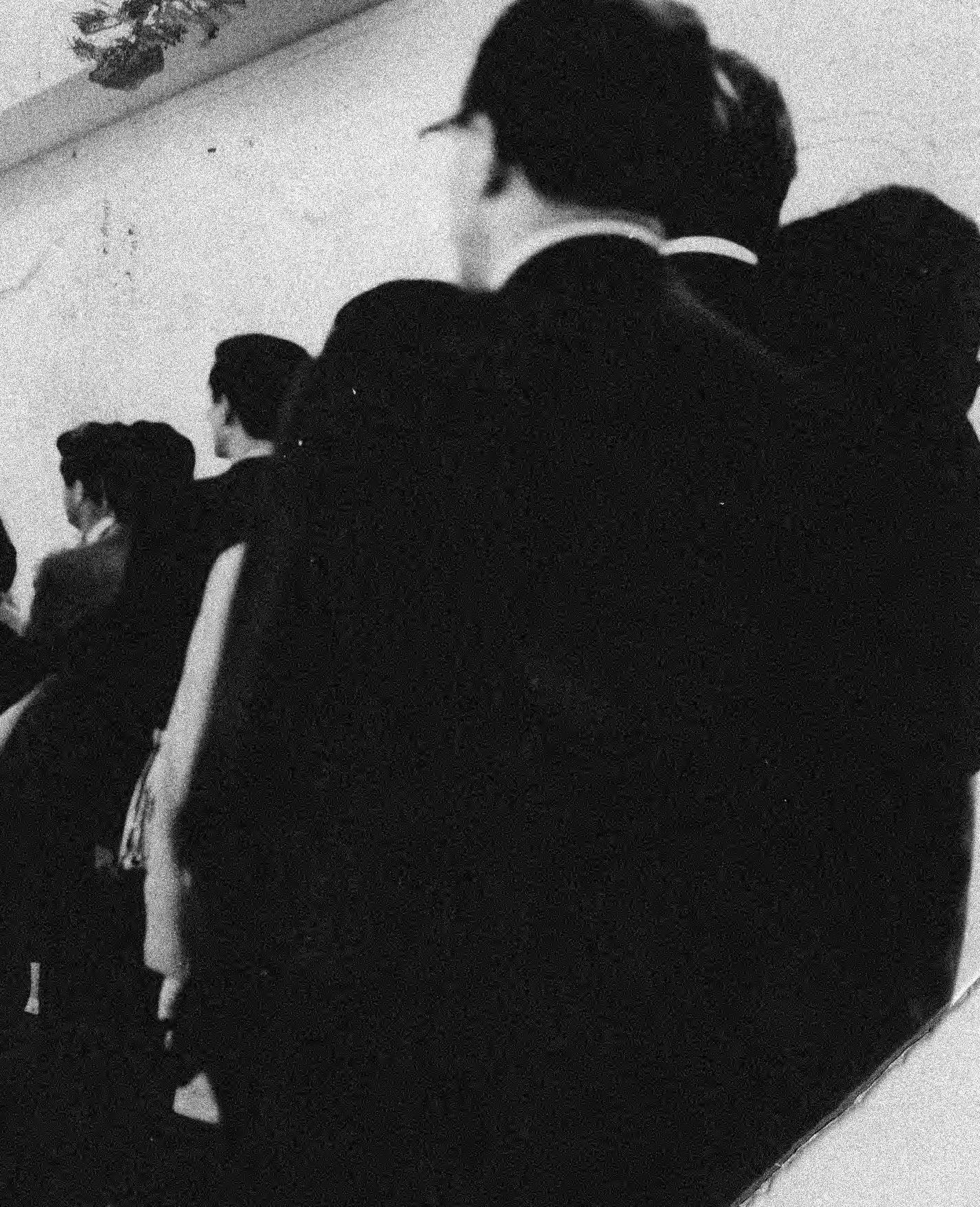
20
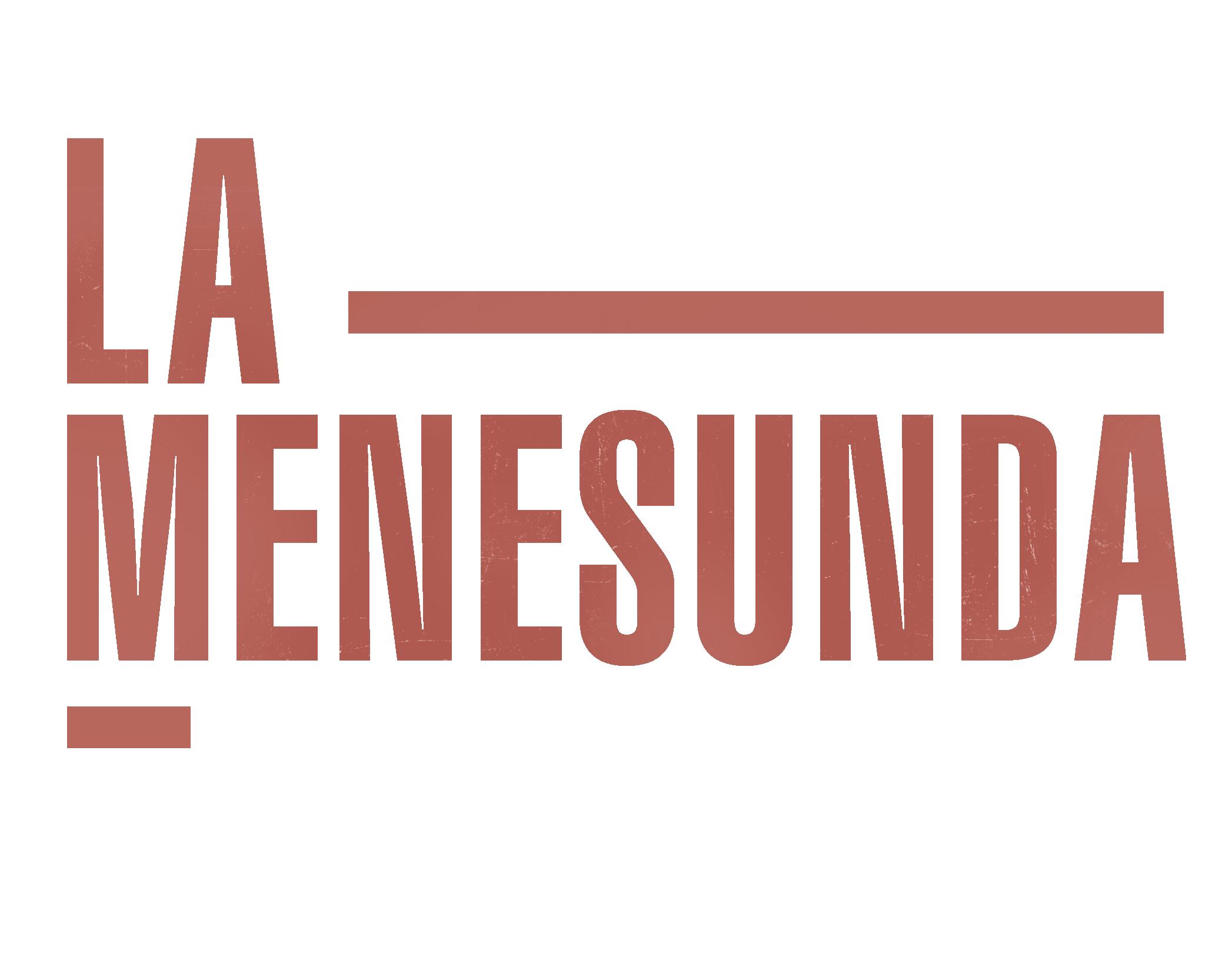
21
Por Sofía Dourron

22 La Menesunda , 1965 Vista general del Túnel de neón Cortesía Archivo Marta Minujín La Menesunda , 1965 General view of The Neon Tunnel Courtesy Marta Minujín Archive
La Menesunda
Por Sofía Dourron
A mediados de mayo de 1965, cientos de porteños se agolpaban en la calle Florida haciendo cola a la intemperie durante horas, bloqueando las entradas de las boutiques y provocando miradas y cuchicheos entre los transeúntes. Aguardaban, pacientes, para ingresar de a uno por vez a La Menesunda , la mítica obra que Marta Minujín y Rubén Santantonín construyeron dentro del Instituto Torcuato Di Tella. Bajo la premisa “Más acá de dioses e ideas / sentimientos / mandatos y deseos”, 1 el enrevesado laberinto confrontaba, incomodaba, sorprendía y zarandeaba a todo aquel que osara traspasar su umbral. Sacudiendo al espectador de su habitual pasividad y sumergiéndolo en un agitado revoltijo, la obra confundía la cotidianeidad doméstica con el bullicio de las calles del centro y el más reciente de los lenguajes de la vanguardia, todo en una misma sala. Uno tras otro, los visitantes eran impulsados a través de estrechos pasillos que los conducían de un insólito ambiente a otro, en medio de una sucesión de estímulos multisensoriales, estéticos y éticos ideados para impactar sus sentidos y su sensibilidad, incluso la de los más escépticos, desconfiados y temerosos. La Menesunda , dijeron sus creadores, no era obra ni happening , tampoco espectáculo. Entre rito folclórico porteño y espectáculo mediático, La Menesunda , con su desfachatez, espíritu revulsivo e histrionismo, era pura experiencia y provocación. Un proyecto de una magnitud descomunal que se convertiría en el escándalo del año, pero también en uno de los grandes hitos de la historia del arte argentino.
23
1-Marta Minujín, Rubén Santantonín, La Menesunda, Instituto Torcuato Di Tella, Buenos Aires, 1965, folleto
El gran despliegue que organizaron Minujín y Santantonín, junto con los artistas Floreal Amor, David Lamelas, Leopoldo Maler, Rodolfo Prayón y Pablo Suárez, sólo fue posible como parte de la culminación del proceso de modernización del arte y la cultura que, iniciado diez años antes, hacia 1965 parecía estar consolidado. El derrocamiento del peronismo en 1955 había instalado la convicción de que se estaba saliendo de años de aislamiento cultural y que se presentaba la gran oportunidad para que el arte se renovara y se pusiera a tono con el resto del mundo. Hacia mediados de los años cincuenta, apareció la noción de “arte nuevo” y se planteó con urgencia la necesidad de fundar estilos locales de alcance internacional, pero que, bajo ningún punto de vista, emularan las tendencias foráneas. Se trató de un corte radical con las estéticas del pasado. Desde finales de la década anterior, con el raudo ascenso de la pintura informalista, gestual y matérica, que buscaba despegarse de la tradición pictórica local, los artistas comenzaron a asumir una nueva actitud rupturista, con Kenneth Kemble (1923-1998) y Alberto Greco (1931-1965) a la cabeza, decididos a abandonar los antiguos cánones, sus formatos y materiales, para explorar nuevos caminos que acompañarían los virulentos quiebres con los lenguajes tradicionales del arte. Se investigaron los materiales más insólitos: brea, arena, trapos, chapas, cartones, una miscelánea de objetos de la cultura de masas y desperdicios que se adherían a los lienzos. La conmoción estética no sólo alteró los métodos de producción y los materiales, sino que también se elaboraron nuevas estrategias para la circulación y legitimación de las producciones contemporáneas. Se conformó un incipiente marco institucional que impulsó políticas culturales que se retroalimentaban del nuevo desarrollo económico. Se fundaron el Museo de Arte Moderno (1956) y el Fondo Nacional de las Artes (1958), a la vez que el Museo Nacional de Bellas Artes reabrió sus puertas en 1956. Finalmente, en 1960, inició sus actividades el catalizador por excelencia de los movimientos de vanguardia de la cultura argentina: el Instituto Torcuato Di Tella. El Centro de Artes Visuales del Instituto se lanzó en 1963, bajo la potestad del calvo e ilustrado Jorge Romero Brest, un
influyente crítico de arte, fundador de la revista Ver y Estimar y Director del Museo Nacional de Bellas Artes entre 1955 y 1963. Su espíritu de progreso, insuflado por la voluntad de modernización e internacionalización que rigió el país durante el período desarrollista, permitió fomentar la experimentación en el arte, inyectarle recursos y promoverla mediáticamente de una manera hasta entonces inusitada en el ámbito argentino. En 1964, las palabras del pope del arte dan clara cuenta de esta operación: “Los jóvenes no sólo rompen moldes, tarea que hicieron ya los de las generaciones anteriores, sino que adoptan actitudes más libres, y esto se logra únicamente actuando en campo total. La diferencia podrá ser excesivamente sutil [...] pero existe: es base de nuestro optimismo, nutrido además por el juicio coincidente de todos los críticos extranjeros que nos han visitado en los últimos años...”.2
Promediando la década del sesenta, muchos de los artistas que se nuclearon en torno al Di Tella habían realizado ya sus respectivos viajes transatlánticos de exploración y autodescubrimiento, con París como principal destino, luego reemplazada por Nueva York, nuevo centro neurálgico del arte moderno. Estos jóvenes exultantes y cargados de ideas volvían a Buenos Aires para desplegar y complejizar las experiencias vividas y las lecciones aprendidas en el exterior. El Di Tella les ofreció el espacio y la contención que necesitaban para tender sus redes y hacer avanzar el arte argentino hacia una nueva era. Durante algunos años, vanguardia e institución caminaron felices de la mano, y el Instituto logró condensar en su programación gran parte del afán de ruptura que reinaba entre los artistas. Se trató de un matrimonio que generó múltiples beneficios para ambas partes, pero que comenzó a resquebrajarse hacia fines de la década debido a las previsibles tensiones entre los artistas y la institución, que se fueron generando a partir de las divergencias de intereses y la distancia ideológica entre unos y otros. El Instituto finalmente mostró su hilacha conservadora ante el avance de la politización y radicalización de los artistas, que opusieron una fuerte resistencia a los intentos institucionales de edulcorar sus producciones y hacerlas aptas al ambiente institucional.
24
2- Romero Brest, Jorge. “Introducción.” En: New Art of Argentina. Cat. Exhib., Buenos Aires: Instituto Torcuato Di Tella, 1964.
Lo hicieron a través de diversas acciones, muchas de las cuales afloraron en torno al Premio Ver y Estimar, presentado en el Museo de Arte Moderno; a la exposición Experiencias 68, en el Di Tella, y al Premio Braque, auspiciado por la Embajada de Francia y presentado en el Museo Nacional de Bellas Artes.3
Sin embargo, durante los años de dicha institucional, los artistas explotaron la oportunidad y dieron rienda suelta a sus investigaciones en torno a una serie de estrategias que buscaron quebrar los límites de las categorías artísticas de rutina. Las aventuras del Pop, el happening , las ambientaciones, la desmaterialización de los objetos y los cruces disciplinarios se convirtieron en moneda corriente entre aquellos que circulaban por los alrededores de “La Manzana Loca”, mote cariñoso con el que se conocía la zona del Di Tella. Estas prácticas también fueron vehículo para una preocupación creciente por la contemporaneidad, por la rápida transformación del tiempo presente y la horda de dilemas culturales, políticos, económicos y sociales que ésta acarreaba. En este contexto de prueba y error, el problema del arte como experiencia y su potencial crítico se fue presentando cada vez con mayor vigor hasta que, a mediados de 1964, para indignación de la prensa y de los detractores de la vanguardia, el Instituto Di Tella otorgó su Premio Nacional a Minujín por sus obras ¡Revuélquese y Viva! , un habitáculo de colchones multicolor que invitaba al visitante a desatar su hedonismo y, literalmente, a revolcarse en la suavidad de la pieza, y Eróticos en Technicolor (1964). Asimismo, otorgaron una mención especial a Emilio Renart por Integralismo. Bio-Cosmos N°3 (1964), una instalación recorrible compuesta por esculturas y pinturas de diversos materiales que representaban inmensas y titilantes vaginas. El Premio no sólo legitimó y abrazó las prácticas de estos jóvenes artistas, sino que institucionalizó una serie de
problemáticas vinculadas a la intimidad, la sexualidad y el compromiso forzoso del cuerpo del espectador con la obra, empujando los límites de la moral y la decencia de la época, a lo que se sumó una explícita y estridente voluntad escandalizadora. Este es el año en que la palabra happening comenzó a aparecer en los medios masivos y el Di Tella se convirtió en objeto de polémica y discusión en los medios.
En la década del sesenta se abrió en el arte un espacio para la transgresión, para quebrar las barreras de aquello sobre lo que durante mucho tiempo no se había podido hablar, de aquello sobre lo cual apenas se había podido pensar, un portal a una nueva dimensión. Así surgen las preocupaciones políticas y sociales que atormentaban a la sociedad argentina en obras como Introducción a la esperanza (1963), de Luis Felipe Noé, que hizo estallar los límites de la pintura con la pura fuerza de la historia argentina, y los Vivo-Dito (1962-1965) del agitador de agitadores, Alberto Greco: acciones mediante las cuales el artista señalaba todo tipo de personajes encerrándolos en un círculo de tiza para luego firmarlos, como si fueran una escultura o una pintura, desacralizando el objeto artístico y utilizando el cuerpo ajeno como único soporte. Aparecen el azar y el humor en la obra de Federico Manuel Peralta Ramos, que en 1964 presenta en la Galería Witcomb unas pinturas tan inmensas que no se pudieron colgar y cuya gran cantidad de materia comenzó a deslizarse por el lienzo hasta llegar al piso de la galería, que se cubrió de pintura, rompiendo así con el rictus de la tradición artística. Peralta Ramos llegó incluso a serruchar una pintura que no pasaba por la puerta.
Tras un largo período de estricta tutela militar, inaugurado en 1955 por la Revolución Libertadora y extendido a los gobiernos de los radicales Arturo Frondizi y José María Guido, la frágil institucionalidad política que a duras penas había
3- En 1968, el medio artístico llegó a su punto de mayor tensión. En la inauguración del Premio Ver y Estimar, Eduardo Ruano lanzó un ladrillo contra su obra, un afiche de John F. Kennedy en una vitrina, al grito de “¡Fuera yanquis de Vietnam!” En mayo se realizó la exhibición Experiencias 68, que originariamente era el Premio Nacional Di Tella, y tomó el título de Experiencias a partir de 1967. Durante la inauguración, Pablo Suárez distribuyó su “Carta de renuncia”, dirigida a Romero Brest, en la puerta del Instituto, en la que manifestaba su disconformidad con la institución y su decisión de no seguir exhibiendo sus obras en ese contexto. Pocos días después, la policía clausuró la exhibición a raíz de las manifestaciones espontáneas del público contra el régimen de Onganía en la obra de Roberto Plate. Ante la clausura, los artistas retiraron sus obras del Instituto y las trasladaron a la calle Florida, donde las destruyeron. Algunos de los artistas fueron arrestados. En junio, el Premio Braque anunció un nuevo requisito: debía presentarse una descripción de los textos que se incluirían en las obras y los organizadores se reservarían el derecho de modificar las obras si lo consideraban necesario. Los artistas respondieron con cartas y manifiestos: primero Margarita Paksa, luego Plate y, finalmente, un grupo de artistas rosarinos liderado por Juan Pablo Renzi escribió y distribuyó el texto “Siempre es tiempo de no ser cómplices”. Durante la entrega de premios, otro grupo de artistas irrumpió en el Museo Nacional de Bellas Artes arrojando objetos y vociferando su propio discurso. Nuevamente, varios de los artistas fueron arrestados.
25
26

27 La Menesunda, 1965 Vista del Túnel de televisores Cortesía Archivo Marta Minujín View of The TV Tunnel Courtesy Marta Minujín Archive
logrado establecer el Dr. Illia generó, entre 1963 y 1966, una sensación de posibilidad que resultaba imperativo aprovechar. Sin embargo, el próximo golpe militar estaba a la vuelta de la esquina, y los grupos militares y económicos más poderosos del país respiraban en la nuca del doctor. La Guerra Fría sacudía al mundo entero, y la famosa “doctrina de seguridad nacional”, impulsada por Estados Unidos, infestaba a toda América Latina. Es el fin de la era de Kennedy, y el inicio del recrudecimiento de la lucha militarizada contra el comunismo y cualquier tipo de subversión que se atreviera a manifestarse contra los valores esenciales: los occidentales y cristianos. Es la guerra de Vietnam, la ocupación de la República Dominicana y la invasión de Bahía de Cochinos, es la guerrilla, la contra-cultura, el hippismo y la lucha por los derechos humanos. Para la Argentina, el período inaugurado por la Revolución Libertadora fue turbulento, políticamente convulsionado y económicamente inestable, interrumpido solamente por breves respiros de bonanza económica y alivio pseudo-democrático. Los artistas no permanecieron indiferentes.
El mismo año en que, al interior del paréntesis de aire fresco que era el Instituto, Renart y Minujín fueron galardonados por los ilustres jurados del Premio Nacional Di Tella —Romero Brest, Pierre Restany y Clement Greenberg—, también Julio Le Parc recibió una mención especial en la sección internacional del certamen. La obra Inestabilidad. Proposición arquitectural estaba compuesta por una serie de placas de aluminio curvas que, conectadas a un motor que provocaba su movimiento, permitía el paso intermitente de luces rasantes emitidas desde uno de los lados de la estructura. La pieza, en línea con las investigaciones del GRAV ( Groupe de Recherche d’Art Visuel ), del cual Le Parc formaba parte en París, se proponía como un lugar para la activación del visitante, abriéndose a los matices de su percepción y reclamando su cuota de participación.
Para fines de 1964, hacía tiempo que una serie de proyectos estructurados en torno a estos planteos que
esperaban ser realizados zumbaban como abejas en los oídos de Romero. Entre ellos, deambulaba por el Instituto un proyecto en forma de maqueta, producto de reuniones que por esos días mantenían Santantonín y Minujín con Renart, Kemble y Pablo Suárez, el germen de lo que poco después se convertiría en La Menesunda . 4 Desde 1963 circulaba también en las oficinas del Di Tella el proyecto Arte-cosa rodante de Santantonín. Una iniciativa que buscaba materializar sus ideas sobre el rol del espectador/participante/ mirón —como Santantonín definió al no-contemplador de su trabajo 5— en la obra de arte. De acuerdo con sus escritos, se trataba de una “especie de informe de superficie rojiza y seca extendido sobre una tarima arrastrada por un jeep [...] que se pasearía por la ciudad atrayendo por su semejanza con los monstruos populares de Bolivia, México o Perú. Una vez estacionado en una plaza se apelaría al público, invitando a la gente a penetrar en su interior. Una vez adentro, el espectador dejaría de serlo para participar directamente en este mundo mágico y distinto del cual él mismo crearía buena parte. Entraría en el vientre de una inmensa forma donde se encontraría moviendo y componiendo formas”.6 Arte-cosa rodante constituía el extremo mismo de “la cosa”, concepto acuñado en 1961 por Santantonín para nombrar a sus obras y que le ganó un lugar junto a Luis Wells en el panteón de “los malditos de Argentina” de Kenneth Kemble, 7 que los consideraba artistas incomprendidos por su innovación y que, anticipándose al futuro, se arriesgaban a ser ignorados.
Las claras manifestaciones de los artistas acerca de su contemporaneidad, en las que cuestionaban los términos de la participación del espectador en los procesos de creación y exposición de las obras, los límites cada vez más lábiles del lenguaje estético y su posibilidad de disrupción parecen haber inspirado a Romero Brest, también a instancias del acoso que le propiciaron los artistas y muy especialmente la infatigable Minujín, para finalmente comisionar la realización de un audaz proyecto. Así es que, a fines de 1964, se dio inicio
28
4- Este proyecto es mencionado en: Laura Buccelato, Greco Santantonín, Fundación San Telmo, 1987, catálogo de exposición; y en Marcelo Pacheco, “De lo moderno a lo contemporáneo. Tránsitos del arte argentino 1958-1965”. En Inés Katzenstein (ed), Escritos de vanguardia. Arte argentino de los años ´60, Fundación Espigas, Buenos Aires, 2007.
5- Rubén Santantonín, Hoy a mis mirones, Galería Lirolay, Buenos Aires, 1961, folleto.
6- Rubén Santantonín, archivo personal.
7- Kenneth Kemble, “Argentina’s Band of the Damned”, Buenos Aires Herald, 25 de septiembre de 1961.
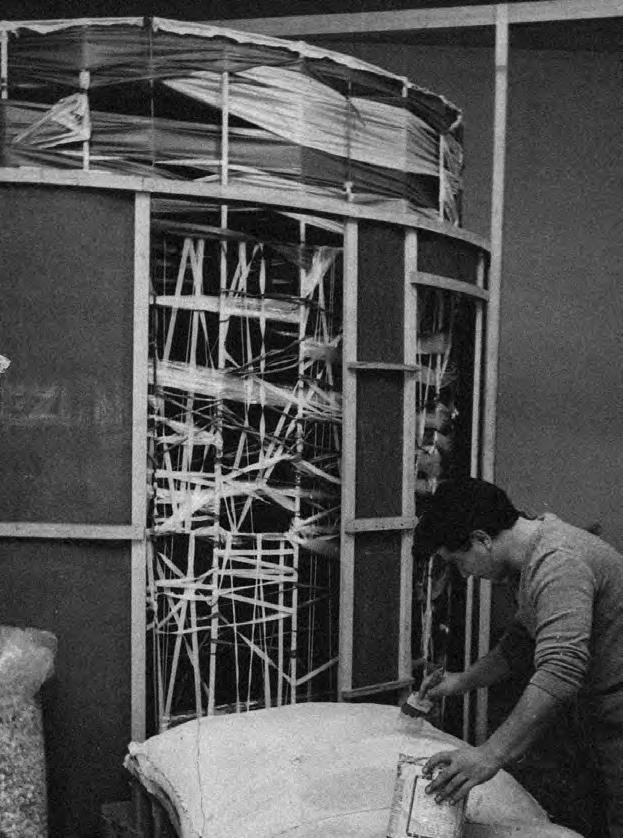



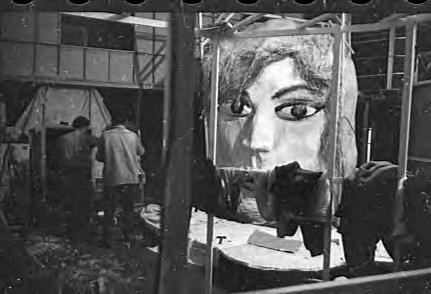
La Menesunda, 1965 Vistas de la construcción Cortesía Archivo Marta Minujín Installation views Courtesy Marta Minujín Archive
La Menesunda, 1965 Vista del Túnel de televisores Cortesía Archivo Centro de Artes Visuales, Universidad Torcuato Di Tella
View of The TV Tunnel Courtesy Centro de Artes Visuales Archive, Universidad Torcuato Di Tella

La Menesunda, 1965 Vista general del Túnel de neón Cortesía Archivo Centro de Artes Visuales, Universidad Torcuato Di Tella
View of The Neon Tunnel Courtesy Centro de Artes Visuales Archive, Universidad Torcuato Di Tella
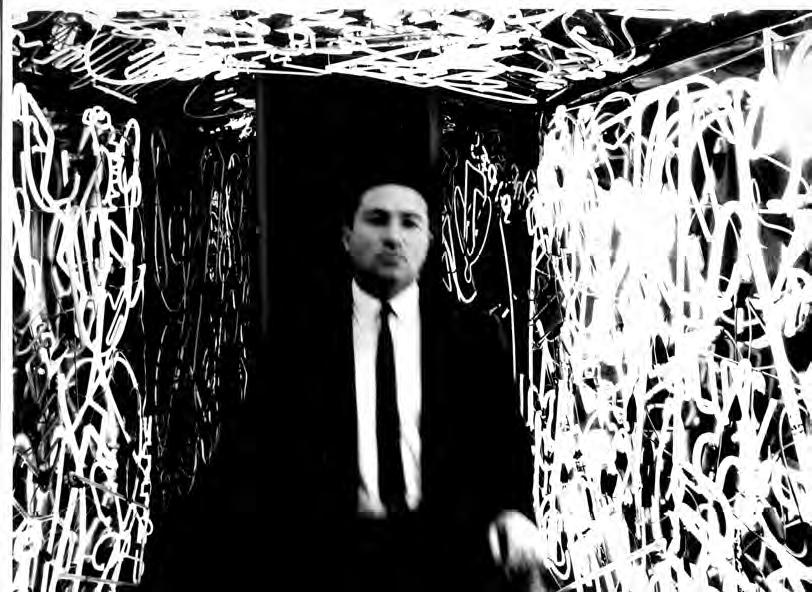
30
al titánico proyecto de La Menesunda , liderado por Minujín y Santantonín, quienes con la complicidad de Floreal Amor, Lamelas, Suárez, Prayón y Maler y un maestro mayor de obras cuyo nombre ha sido olvidado, se embarcaron en la creación de un laberinto de compartimentos contenedores de situaciones cuyo propósito era —según reza el folleto de la exhibición— “intensificar el existir”.
Esta obra, con sus once ambientaciones, laberíntica y confusa, como su nombre en lunfardo lo indica, producía un entramado visual y sensorial anclado en la vida moderna de la ciudad, una vida que para 1965 tenía en Buenos Aires una corta pero intensa existencia, con sus ritos colectivos, culturales y folclóricos, con itinerarios y preocupaciones establecidos, reconocibles a lo largo del recorrido. Tras una larga espera en la calle Florida y luego, entre las pinturas del moderno pintor Jean Dubuffet, la expectante audiencia ingresaba finalmente a la exposición de la que todos los medios hablaban. La prensa retrataba la escena con minucia: “Llegamos al Instituto Torcuato Di Tella (Florida 936) y nos encontramos con una larga fila de gente esperando entrar en La Menesunda. Hombres y mujeres. Escépticos unos. Sonrientes otros. Observaban ansiosos los rostros de los que salían. Querían saber de qué se trataba. Qué era lo que iban a ver. Qué les iba a pasar allí adentro…” 8
El primer paso consistía en atravesar un portal de acrílico rosa, a través de una alargada figura humana, donde un guardia recibía a los visitantes y los instruía acerca del uso de la obra. En el mismo tono, un cartelito indicaba que el visitante debía primero subir una empinada y precaria escalera que impedía el paso hacia un túnel de neones que emulaba las luces y el frenesí de las calles del centro. El visitante debía aventurarse escaleras arriba para encontrarse con el primero de los ambientes: una especie de cubierta de barco equipada con siete televisores, de los cuales dos reproducían la imagen del visitante en circuito cerrado y los cinco restantes emitían imágenes de programas de televisión abierta, desde el noticiero hasta el Club del Clan. Este pequeño espacio
resumía la naturaleza del resto del recorrido. La presencia de los aparatos de T.V., incipientes miembros de la gran familia argentina, y la posibilidad para muchos de ver aparecer su imagen por primera vez en una pantalla plantean una serie de cuestiones que aparecerán, a partir de aquí, en forma recurrente: el avance desaforado y el uso doméstico de la tecnología y de los medios de comunicación, la invasión del cuerpo y la privacidad del espectador y la absoluta inmersión en una estructura tan precaria como espectacular que impide que el espectador la evada o, lo que en este caso es igual, se evada a sí mismo. La Menesunda era, decididamente, una provocación; su objetivo, sacar a la gente del estupor de la vida cotidiana y obligarla a enfrentarse a esa cotidianeidad representada por objetos en extremo familiares, para abrir nuevas lecturas en oposición. ¿Será la televisión un nuevo y mejorado entretenimiento o un medio masivo de distracción y disputas de poder?
Luego de verse impactado por su propia imagen en una pantalla, el visitante debía optar por bajar hacia un túnel de neón que emulaba las luces de la Avenida Corrientes, o bien continuar rumbo al siguiente espacio, donde nuevamente se veía impactado por una imagen, esta vez la de una pareja que reposaba en paños menores en una cama.9 Los actores —una pareja que tras la larga estadía en la obra terminó por separarse y otra que apenas se conocía—10 pasaban el día fumando, tejiendo y escuchando a Los Beatles, mientras la gente circulaba por el costado de la cama, algunos increpándolos con preguntas, con miradas de desaprobación, y otros esbozando sonrisitas cómplices de asentimiento y aceptación. La desnudez y un lecho matrimonial expuestos a la luz del día: una afrenta a la moral, un cruce descarado de lo privado hacia lo público; en pocas palabras, un escándalo supino, o bien un golpe de liberación propinado por una juventud sofocada a una sociedad pacata que entronizaba la virtud cristiana. Esta imagen se reprodujo en varios medios y se convirtió en ícono de la obra y sinónimo de provocación. Sólo esto era suficiente para amedrentar a los visitantes, que tras golpearse la frente con el vano de la pequeña puerta de salida,
8- “‘Algo’ para locos o tarados”, Careo, 2 de junio de 1965.
9- Según los relatos de algunos de los artistas que colaboraron en la construcción de la obra, fue el lecho matrimonial y la actuación de sus performers lo que disparó el interés de los medios y el consiguiente aluvión de público curioso. Conversaciones de la autora con Leopoldo Maler y Rodolfo Prayón, mayo 2015.
10- Según el relato de Leopoldo Maler, mayo 2015.
31
debía continuar su camino a través de otra estrecha escalera hacia lo que luego sabría era el interior de una enorme cabeza de mujer, cuyo exterior había sido pintado por Pablo Suárez,11 y su interior, revestido con productos de belleza. Allí, una maquilladora profesional y una masajista ofrecían, solícitas, sus servicios a quien quisiera recibirlos. En un artículo, Minujín y Santantonín explicaban: “Con eso quisimos significar que el espectador se halla dentro del cerebro de una mujer de nuestra generación…,”12 a lo cual la prensa respondió con quejas y polémicas, alegando que era un agravio a las mujeres cuyos intereses no se centraban exclusivamente en el maquillaje y los tratamientos de belleza, sin admitirlo como una posible reflexión acerca del cambiante rol de la mujer y sus nuevas obligaciones y posibilidades en una sociedad en plena transformación.
El paso siguiente consistía en el dificultoso ingreso a un canasto de hierro giratorio recubierto por tiras de plástico de colores, que daba paso a otros dos espacios. El primero, un angosto pasillo de paredes recubiertas por enormes “intestinos” de polietileno, tenía un techo que se hacía más bajo a medida que el espectador avanzaba, hasta desembocar en un orificio, probablemente anal, por el cual podía asomarse y contemplar una serie de apacibles escenas de paisajes tomadas de películas del sueco Ingmar Bergman, figura con gran influencia sobre el nuevo cine argentino que atacaba la tradicional cinematografía de comedias burguesas y aventuras gauchescas.
La trama de referencias cultas y populares que se revela aquí da cuenta de la complejidad de una obra atenta a su entorno y sus transformaciones, así como de las posibilidades de vinculaciones que desbordan todos los ámbitos de la cultura y se encuentran reunidas y desjerarquizadas en un solo ambiente. El juego de oposiciones entre la sofisticación y densidad bergmanianas y la cultura de masas de la televisión argentina o sus productos de belleza tensiona de manera crítica la bases de la construcción de la contemporaneidad en la ciudad de Buenos Aires, donde convivían en constante negociación el Club del Clan y
Los Gatos, Rodolfo Walsh y Palito Ortega, Rodolfo Kuhn y Carlitos Balá, Los Beatles y el folclore nacional. Estos matices, sin embargo, se disiparon en el barullo de las acusaciones e insultos propiciados por la prensa; claro que semejante barullo era de esperarse con la irrupción de una propuesta de estas características en un foro público, plagado de innumerables contradicciones internas, que enfrentaba a una sociedad en plena modernización cultural con el avance de los militares y la imposición de sus valores anquilosados.
Tras el breve lapsus fílmico, el visitante debía retornar al canasto e ingresar a lo que los autores llamaron “La Ciénaga”, un pasillo mullido, tanto que se entorpecía el avance y las paredes desprendían pedacitos de goma espuma que iban cubriendo poco a poco el piso. A continuación, se ingresaba a una pequeña y oscura habitación, con un intenso olor a dentista potencialmente provocadora de ataques de claustrofobia, coronada por un inmenso dial de teléfono y una única instrucción: apriete el botón para abrir la puerta. 13 Un breve tránsito por una heladera con temperaturas bajo cero conducía a un pasillo ocupado por diversas formas y texturas, suaves y ásperas, placenteras e irritantes, que los transeúntes no tenían manera de evitar. Finalmente se llegaba a una habitación octogonal con paredes de espejos y olor a fritura, ese olor que en Buenos Aires se encuentra en la Avenida Corrientes entre la pizza de “Güerrin” y las milanesas del “Palacio de la papa frita”, en cuyo centro se ubicaba una cabina de acrílico transparente, desde la cual se activaban luces negras y ventiladores que provocaban un torbellino de papel picado que acompañaría a los visitantes durante todo el trayecto de vuelta a su hogar. Se trata del golpe final: un caos de papel picado volando por el aire, luces negras de boite bailable al mejor estilo Mau Mau, 14 paredes de espejos cual laberinto de parque de diversiones o casa del horror. Para algunos, suficiente material para varias sesiones de psicoanálisis. En esta habitación octogonal, la mirada no tenía adónde escapar, el reflejo la seguía a todas partes: era la confrontación final con la vanguardia, con la brutal transformación del arte y con
11- Conversaciones de la autora con Leopoldo Maler y Rodolfo Prayón, mayo 2015.
12-“‘Algo’ para locos o tarados”, Careo, 2 de junio de 1965.
13- El número secreto, aunque no tan secreto según informa la prensa, era indicado al momento de ingresar para evitar desmayos o sensaciones de claustrofobia entre los más sensibles a la oscuridad.
32
La Menesunda, 1965
Vista del espacio Dormitorio
Cortesía Archivo Marta Minujín
View of The Bedroom
Courtesy Marta Minujín Archive
La Menesunda, 1965
Entrada al espacio Heladera
Cortesía Archivo Centro de Artes Visuales, Universidad Torcuato Di Tella
Entrace to The Icebox
Courtesy Centro de Artes Visuales Archive, Universidad Torcuato Di Tella
La Menesunda, 1965
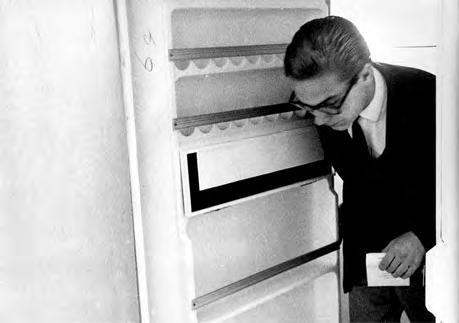
Rubén Santantonín y Marta Minujín
Cortesía Archivo Centro de Artes Visuales, Universidad Torcuato Di Tella
Rubén Santantonín and Marta Minujín

Courtesy Centro de Artes Visuales Archive, Universidad Torcuato Di Tella
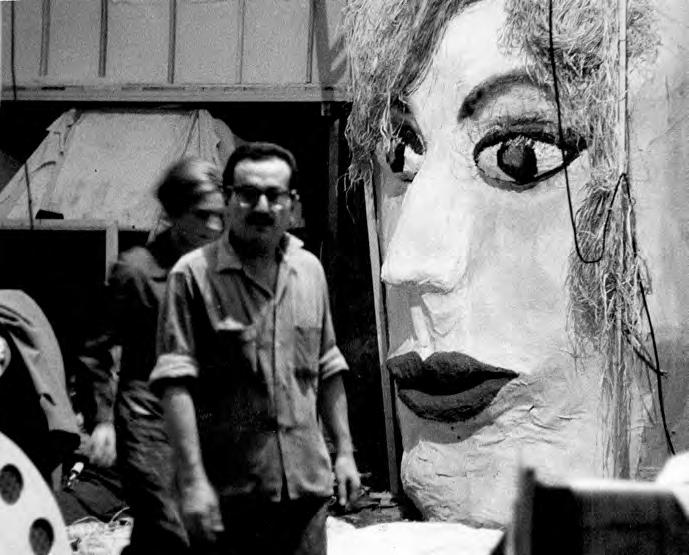
33
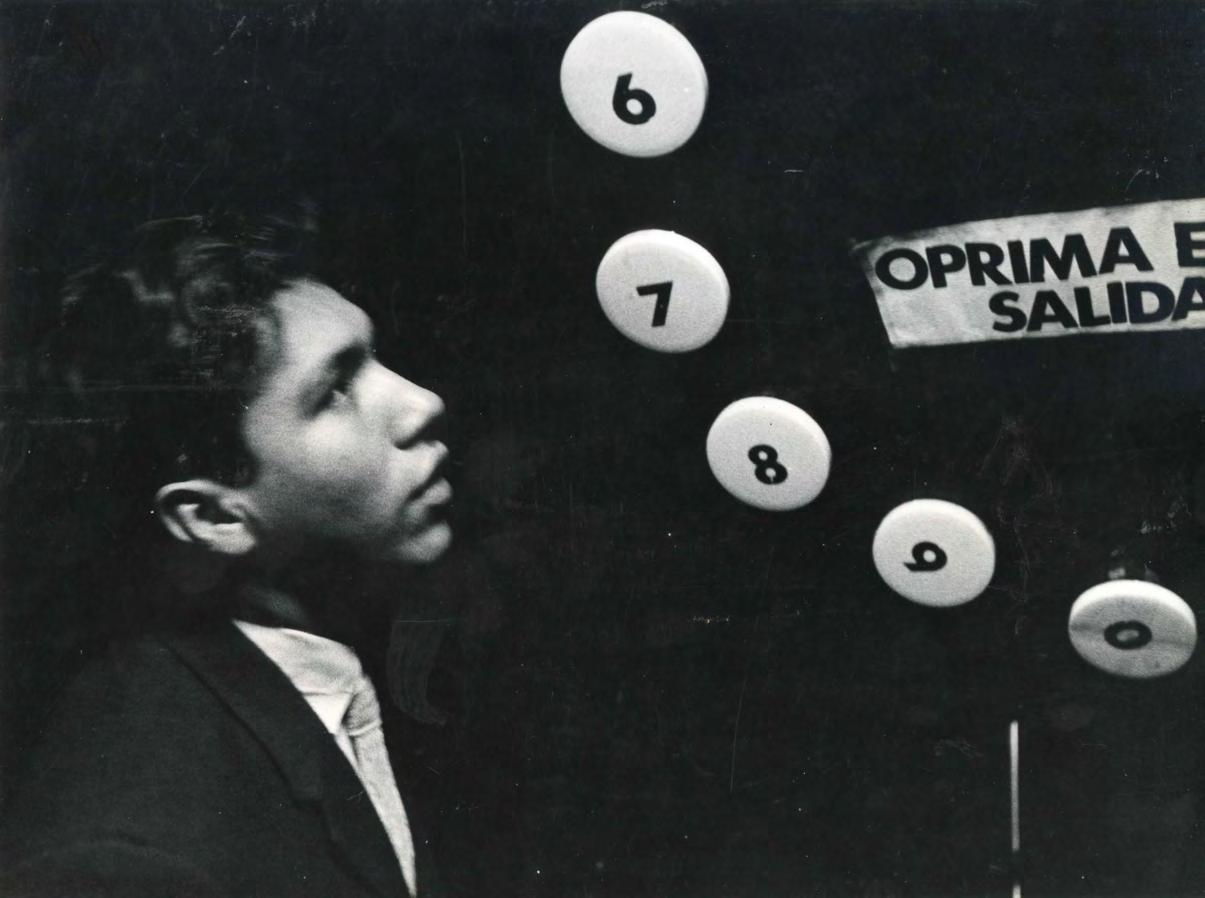
La Menesunda, 1965 Vista interior del Teléfono Cortesía Archivo Marta Minujín View of The Telephone Courtesy Marta Minujín Archive
el propio ego. No hay dudas de que, de ahí en adelante, ya no hubo vuelta atrás.
Además de las problemáticas inherentes a los lenguajes de la vanguardia, la participación del público, su experiencia, la cultura de masas y la colaboración como metodología de trabajo, este proyecto planteaba una dinámica que había sido inaugurada antes en iniciativas tales como la exposición de Arte Destructivo (1961), en la cual un grupo de artistas liderado por Kemble exhibió una serie de objetos encontrados y un audio realizado especialmente para la ocasión, o el famoso cartel ¿Por qué son tan geniales? (1965) que Edgardo Giménez, Charlie Squirru y Dalila Puzzovio realizaron junto a una agencia de publicidad e instalaron durante meses en la esquina de Florida y Viamonte, o las obras de la exultante dupla Delia Cancela y Pablo Mesejean, una sociedad pop que duró más de veinte años. La Menesunda no sólo abrazó la colaboración como práctica contemporánea, sino que esta producción desmesurada no habría sido posible sin ella. No solamente por su gran tamaño —el recorrido ocupaba toda la sala del Instituto—, sino por la gran complejidad constructiva y de planificación que este proyecto demandó, lo que lo convirtió en una empresa colosal que puso a prueba la voluntad, la paciencia y el compromiso de todos los participantes. Tanto fervor y entusiasmo había en este equipo que hubo incluso quienes perdieron sus trabajos en pos de La Menesunda. Lo que este tipo de asociación implicaba no era casual. No se trató sólo de una práctica diferenciada y una estrategia de visibilización y representación de la figura del artista, que se contraponía a las ansias subjetivas de reconocimiento encarnadas en artistas como Minujín y Greco, sino que expresa una clara postura que permite comenzar a releer la noción de autoría, anticipando los debates que estallarían en torno a este tema hacia finales de la década con las discusiones y escritos de Roland Barthes y Michel Foucault.15 La figura del autor comienza a perder sus contornos definidos, así como la obra de arte se escapa por los bordes de los marcos para convertirse en objeto y finalmente deshacerse en el aire. La Menesunda es, desde su más incipiente germen,
la suma de infinitas partes. Es la suma de Minujín y Santantonín, y de tantos otros cuyas influencias se filtraron por la grietas de las improvisadas paredes del laberinto. Por allí aparecen el Bio-cosmos n°1 (1962) de Renart, la Primera Exposición de Arte Vivo - Dito (1962) de Greco, Microsucesos (1965) de la compañía La Siempreviva, el espíritu libre de Federico Manuel Peralta Ramos, las Anthropométries de Yves Klein y los happenings de Allan Kaprow, Robert Whitman o Jim Dine, entre otros. Se trató de la confluencia de dos artistas que, por separado, revolucionaron el arte argentino, agitadores, cada uno a su manera, de la vanguardia artística, a través de su pensamiento crítico y su acción rotunda. Juntos forzaron la trama institucional del arte argentino de los años sesenta, para hacer entrar en ella una gigantesca y absurda obra, que tensionaría hasta el extremo las posibilidades de la vanguardia antes del estallido final del 68.
Minujín y Santantonín, Marta y Rubén, el día y la noche, el agua y el aceite. La joven Marta (Buenos Aires, 1943), efervescente y llena de entusiasmo, fascinada por el futuro y todo lo que éste tiene para ofrecerle, siempre ansiosa por conocer el mundo y que el mundo la conozca a ella; Rubén (Villa Ballester, 1919-1969), “pintorcosista”, 16 austero, sobrio, reflexivo y circunspecto, siempre preocupado por los males que aquejaban al hombre contemporáneo. Sus caminos ya se habían cruzado en ocasiones anteriores en exhibiciones organizadas en la Galería Lirolay (1962), en el Museo de Arte Moderno (1962) y en el Di Tella (1964). En el folleto de la exhibición El hombre antes del hombre (1962), una muestra colectiva que exploraba la creciente producción de los jóvenes artistas de la ciudad, promovida por la Galería Florida y auspiciada por el Museo de Arte Moderno su director y fundador Rafael Squirru,17 relataba que fue una conversación con ellos sobre la situación derrotista e indiferente del “ambiente” artístico contemporáneo en el país lo que lo inspiró para organizar ese proyecto. Se trata, sin embargo, de dos artistas de generaciones distintas, y temperamentos opuestos, pero que, en un momento dado de la historia, recorrieron caminos paralelos y simultáneos,
14- Famosa discoteca que funcionó en Buenos Aires entre mediados de los años sesenta y comienzos de los ochenta.
15- En 1968, Barthes publica “La muerte del autor”; al año siguiente, en 1969, Foucault publica su texto “¿Qué es un autor?”.
16- Así define Rubén Santantonín su actividad en un formulario del MAM, completado de puño y letra por el artista en 1966. Biblioteca y Archivo Museo de Arte Moderno de Buenos Aires.
35
que se iniciaron en la pintura informalista, oscura y existencial, de materiales precarios, para disolverse en los itinerarios de la obra de arte total y la experiencia de inmersión, transitando en distintos momentos y circunstancias por la senda de la destrucción de su propio trabajo.18
A comienzos de los años sesenta, Marta comenzaba a incorporar nuevos materiales a su ya tradicional pintura informalista. Incorporó cajas de cartón, las pintó de negro y en ocasiones hasta se metió dentro de ellas: es el comienzo de un largo camino. Poco después, en París, recolectaba colchones viejos y sucios, muchos de ellos provenientes de hospitales, con los cuales construía pequeños habitáculos, que sorprendentemente también indagaban en la posibilidad de habitar la obra. En 1963, Minujín ya estaba dejando atrás parte de su vinculación con el Nouveau Réalisme al quemar todas sus pinturas y colchones en una gran pira en el contexto de su acción conocida como La destrucción (1963). En una memoria escrita poco tiempo después, Minujín relata la acción en el Impasse Ronsin: “Sentía y afirmaba que el arte era algo mucho más importante para el ser humano que esa eternidad a la que sólo los cultos accedían, enmarcada en museos y galerías; para mí era una forma de intensificar la vida, de impactar al contemplador, sacudiéndolo, sacándolo de su inercia, ¿para qué, entonces, iba a guardar mi obra?...”.19 De esta manera, la artista se lanzó hacia la construcción de ambientes con sus colchones ahora multicolores y cosidos a mano, como La chambre d’amour (1963-1964), realizada junto a Mark Brusse: una estructura de madera recubierta de colchones, un ambiente habitable, lúdico, con guiños eróticos. De vuelta en Buenos Aires, la artista elaboró sus experiencias y realizó las obras con las que gana el ya citado Premio Di Tella. En octubre de 1964, Minujín realizó su primer happening en Buenos Aires, en el programa de televisión La campana de cristal , de Canal 7, que involucró decenas de gallinas, globos, untuosos atletas sólo cubiertos por slips, un pony que en vez de montura llevaba baldes de pintura, y a una provocativa Minujín bailando una desaforada danza Sioux.
La carrera artística de Santantonín fue veloz, tan veloz como potente y atípica. Nacido en 1919, recién en 1943, según acuerdan varias biografías de la época, se inició en la pintura de manera autodidacta, a instancia de las recomendaciones de Carlos Ripamonte, vecino de Villa Ballester. Realizó su primera exhibición individual en 1958: una serie de pinturas abstractas que rápidamente se convirtieron en informalistas y que igual de rápido se transformaron en cosas : bultos informes de telas enyesadas y materiales de descarte, papeles, cartones y tientos de cuero, que pendían del techo con alambres o hilos. Las cosas hicieron su primera aparición en público en 1961, en la exhibición Collages y cosas que Santantonín realizó junto con Luis Wells en la Galería Lirolay. Allí también presentó el texto/manifiesto que tituló Hoy a mis mirones , 20 donde declara: “Creo que hago cosas. Intuyo que comienzo a descubrir una forma de hacer que me coloca frente a la encrucijada existencial con una más intensa vibración que si reduzco mi ser, con su dilatada ansiedad, al canon de la pintura”. En 1964, las ideas del artista acerca de su propia producción y acerca del arte parecen consolidadas. En el folleto que acompañó su exhibición Cosas de 1964, explica: “La COSA como preocupación artística del problema es el acontecer del objeto. ACONTECE gracias a esa vida que le prestamos al concebirlo como COSA. Pues en tanto le quitemos la adhesión que ese préstamo implica, volverá a ser objeto irremediablemente. Entiendo a la COSA como la prevalencia de lo humano sobre los objetos, la poesía vital del objeto”.21 La cosa, lo puramente indeterminado, actúa como punto de partida, como lugar para la investigación de lo que está por ser; es también el comienzo del desplazamiento del espectador de la contemplación hacia la inmersión, el quiebre del hermetismo de la obra de arte como objeto.
Las inflexiones en las palabras de ambos artistas se hacen eco unas de otras. Desde el momento en que la pintura informalista ha quedado atrás se abren nuevos caminos para nuevas experiencias, más revulsivas y más comprometidas con su entorno y con el tiempo presente.
17- Fue Rafael Squirru quien en 1956 impulsó la creación del Museo de Arte Moderno de Buenos Aires. Crítico de arte y poeta, Squirru fue promotor del Informalismo, el movimiento de Arte Generativo, y muchos de los jóvenes artistas que circulaban en Buenos Aires entre mediados de los años cincuenta y comienzos de los sesenta.
18- En 1963, Marta Minujín realiza una acción conocida como La destrucción, cuando quema sus obras realizadas durante su estadía en París. En una tónica completamente diferente, en 1969, poco antes de morir, Rubén Santantonín destruye casi todas sus obras en una gran quema.
19- Marta Minujín, texto dactiloscrito sobre La destrucción, Archivo Marta Minujín.
20- Santantonín, Rubén, Collage y cosas, Galería Van Riel, Buenos Aires, 18 de septiembre de 1961, folleto de exposición.
21- Rubén Santantonín, “Porque nombro ‘cosas’ a estos objetos”, en Cosas, Galería Lirolay, Buenos Aires, 1964, folleto.
36
La Menesunda, 1965 Marta Minujín y Rubén Santantonín en la construcción Cortesía Archivo Marta Minujín
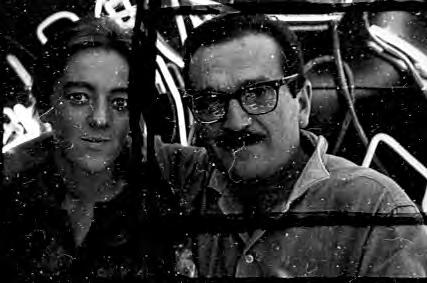
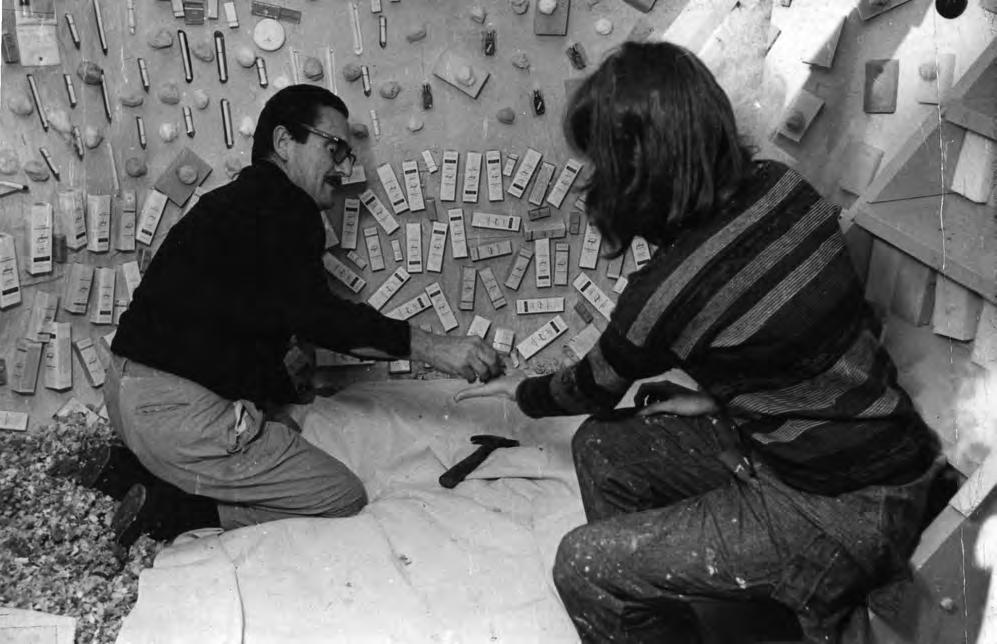
Marta Minujín and Rubén Santantonín installing The Woman´s Head Courtesy Marta Minujín Archive
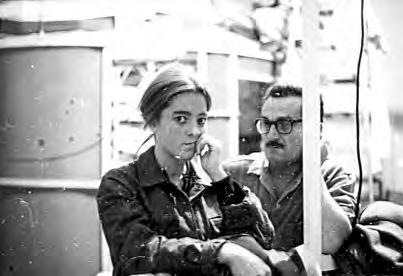
37
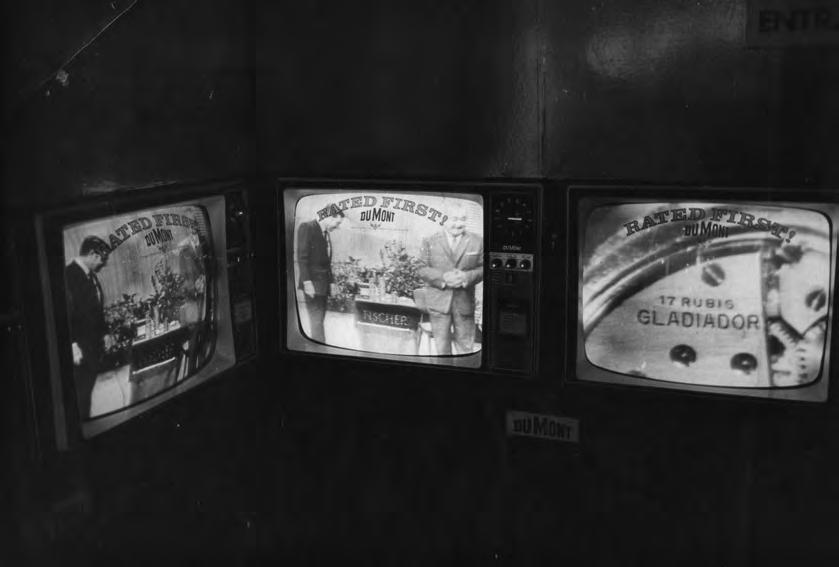
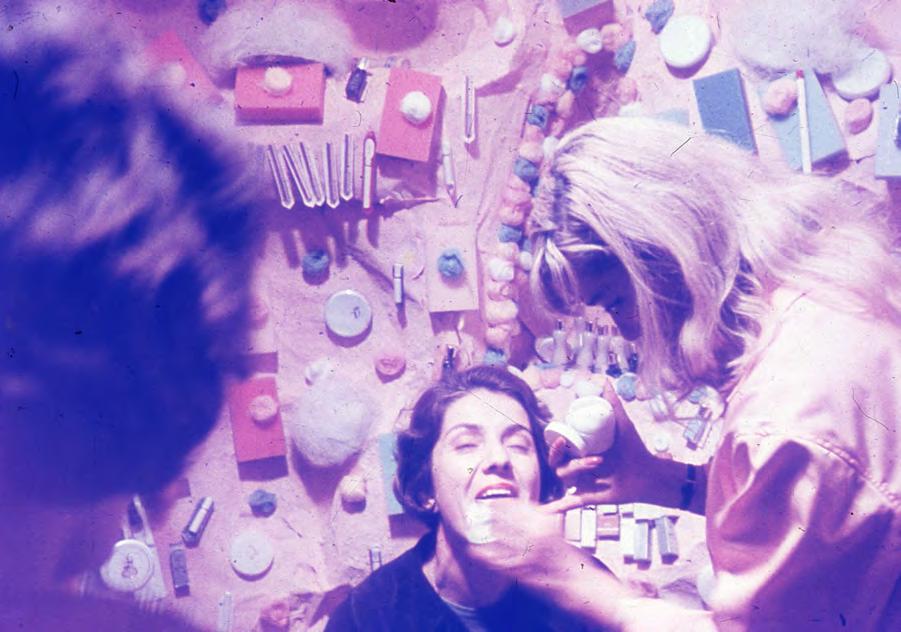
38
La Menesunda , 1965 Interior de la Cabeza de mujer Cortesía Archivo Marta Minujín View of The Woman´s Head Courtesy Marta Minujín Archive
La Menesunda, 1965 V ista gener al del Túnel de TV Cortesía Archivo Marta Minujín
View of The TV Tunnel Courtesy Marta Minujín Archive
La Menesunda resume la potencia de ambos: las acciones que Minujín realiza consistente y persistentemente desde que hace su primera aparición en escena, su praxis siempre arriesgada y cuestionadora, y la muy profunda reflexión de Santantonín en torno a su propia práctica, existencial pero de cara al futuro, arraigada en el estudio y trabajo minucioso con los materiales y las formas, y cómo estos se desenvuelven en el mundo y afectan al espectador.
La Menesunda es la materialización de las preocupaciones y los interrogantes de ambos artistas sobre las posibilidades del lenguaje artístico y su capacidad de afectar y transformar al espectador, íntimamente relacionada con su tiempo y su contexto. Un tiempo de transformación cultural, efervescencia artística y tensión política que la tiñen por completo. Todos estos elementos se catalizaron a través de un conjunto de elementos, en algunos casos precarios y cotidianos —bolsas de polietileno rellenas de aserrín, papel picado y goma espuma—, en otros, tan sofisticados como un circuito de televisión cerrado, organizados a partir de una endeble lógica basada en las fantasías del grupo, una secuencia desconcertante que sometía al visitante a pasar de un estado a su opuesto subiendo o bajando unos pocos escalones, atravesando un túnel de neón o un pasillo de “intestinos” con la total convicción de estar, si no transformando, al menos torciendo el paradigma moderno del arte y abriendo las puertas de la contemporaneidad.
Si a comienzos de los años sesenta la vanguardia comenzaba a incorporar elementos hasta el momento foráneos a una obra de arte, entrelazándose de manera íntima con la cultura popular, hacia mediados de la década este proceso parece consolidado. Ya no sólo se incorporaron objetos a la pintura, o se utilizaron de manera compositiva dentro de la pintura, la escultura o las exposiciones mismas, sino que se comenzó a reproducir el tiempo y el espacio real dentro del ámbito expositivo. Se estrecharon al extremo los vínculos con la realidad, que se reprodujo sin mediación alguna o que fue simplemente apropiada. Las escurridizas imágenes de la televisión, el cine y la publicidad se infiltraban
en la cultura, impulsadas por una juventud con ansias de futuro, que ahora confiaba plenamente en lo nuevo y sospechaba de todo lo que oliera a viejo. La cultura de masas se convirtió en fuente inagotable de material para los artistas pop, que encontraron inspiración en las páginas de las revistas y las tapas de los discos de las estrellas norteamericanas. Se exaltaron los valores de los objetos de consumo, los materiales vulgares y los colores brillantes, la simulación y lo artificial, que le disputaban el lugar al buen gusto tradicional, y el hedonismo juvenil como estrategia de disrupción del orden establecido. El Pop, con el tono festivo que lo caracterizó, apareció también como un arte reflexivo y crítico desde donde hacer patentes las mediaciones de los lenguajes y las estructuras sociales en la relación del hombre con el mundo y, a la vez, un catalizador del cambio histórico en el gusto estético.22 El espíritu juguetón, sus héroes, sus ídolos, sus deseos y fantasías aparecen en el manifiesto que Delia Cancela y Pablo Mesejean escriben en 1966:
“Nosotros amamos los días de sol, las plantas, los Rolling Stones, las medias blancas, rosas, plateadas, a Sony and Cher, a Rita Tushingam y a Bob Dylan. Las pieles, Saint Laurent y el young savage look, las canciones de moda, el campo, el celeste y el rosa, las camisas a rayas, que nos saquen fotos, los pelos, Alicia en el país de las maravillas, los cuerpos tostados, las gorras color, las caras blancas y los finales felices, el mar, bailar, las revistas, el cine, la cebellina. Ringo y Antoine, las nubes, el negro, las ropas brillantes, las baby-girls, las girls-girls, los boys-girls, las girls-boys, los boys-boys.”
La Menesunda asumió este problema como propio y reprodujo distintos aspectos de la realidad, como una arqueología de su propia contemporaneidad. Recogió elementos de la ciudad, pero sobre todo de la intimidad de los hogares de clase media, sus ritos y artilugios, fundiendo a los participantes con su entorno al introducirlos al interior de una serie de electrodomésticos, como el televisor, el teléfono, la heladera. Ya no se trataba de incorporar los desechos del consumo a las obras, sino de transformar los objetos de
39
22- Oscar Masotta, Revolución en el arte. Pop-art, happenings y arte de los medios en la década del sesenta, Buenos Aires, Edhasa, 2004. [Texto original sobre arte pop: El pop art, Buenos Aires, Columba, 1967]
uso doméstico en experiencia estética, exponiendo así los mecanismos que operaban en la sociedad de consumo de los sesenta, la banalidad, las estrategias del marketing y la manipulación de los consumidores. Indudablemente es irónico que este despliegue sucediera a costas de SIAM Di Tella, una de las empresas industriales más grandes del país. La Menesunda, por su masividad única y su cualidad autodestructiva (para el final de la exposición la obra estaba prácticamente destruida), logró escapar a la objetualización y, al mismo tiempo, a cualquier atadura al pasado o a la tradición que pudiera restringirla, distinguiéndose así de su prehistoria, caracterizada por la veneración de los objetos artísticos únicos. Se trató de una obra de arte total, que interpeló todos los sentidos del participante y también su sentido moral, y que apeló de manera tenaz a su voluntad de romper los antiguos límites.
Tanto Minujín como Santantonín elaboraron, con su característica vehemencia, reflexiones sobre el arte y la posibilidad de transformación del espectador a través de la experiencia de una obra, sobre sus prácticas individuales y sobre La Menesunda. Minujín escribió: “[…] Menesunda estimula la espontaneidad, la imaginación; la creatividad no admite frenos ni razones. Menesunda no está para ser contemplada sino vivida; su significación se encuentra en la persona que la incursiona“.23 En la misma tónica se encuentran las palabras de Santontonín: “[…] Queremos que el hombre sienta la vejez de su anterior actitud ante la cosa artística, que se sienta complicado, comprometido, con su propia imagen mezclada a lo que siente, ve e intenta hacer. / Provocar en el participante una sensación inédita, tan inédita que él mismo tenga que crearle un nombre”.24
En la conferencia que Romero Brest dictó en ocasión de la exhibición, además de referirse a las falencias y desaciertos del resultado final, aludió nuevamente a la noción de experiencia: “yo creo que los artistas de nuestro tiempo están intentando ampliar el campo de la experiencia, una experiencia que no termina, una experiencia, por lo tanto, que no tiene límite...”.25 El participante se veía compelido a unirse a la obra de arte, se fundía con ella para activarla y para ser activado, para
23- Marta Minujín, texto dactiloscrito sobre La destrucción, Archivo Marta Minujín.
24- Rubén Santantonín, archivo personal.
conocer y conocerse a sí mismo en el proceso, a través de sus propias actitudes, gestos y reflexiones.
Pero La Menesunda también indicaba el camino. Instruía, confrontaba y examinaba comportamientos, investigaba conductas y contraconductas que oscilaban entre el ejercicio de la libertad y la creatividad y el itinerario normativo de un laberinto-laboratorio. Asimismo, la obra trazaba patrones de orden y conducta, materializados en una serie de instrucciones de uso comunicadas a través de carteles y guardias de seguridad, instrucciones que en cierta medida limitaban la posibilidad de libre participación del visitante. Se trataba de un itinerario previamente diseñado, que desencadenó múltiples reacciones y contrapuso la feliz idea de la participación con una avalancha de estímulos que iban desde el roce de suaves texturas a la hostilidad de un ambiente a temperaturas bajo cero, de la grata sorpresa de verse reflejado en una pantalla de televisión al encierro en una pequeña y oscura “cabina telefónica”. El juego de oposiciones generó actitudes igualmente opuestas, que se acumulaban una tras otra a lo largo del recorrido, conformando una experiencia intensa y cargada de emociones. La Menesunda puso a prueba al espectador y su capacidad para incorporarse a la corriente que la obra proponía y para subsistir en medio de la vorágine de imágenes y estímulos que se le presentaban, ejerciendo su propia subjetividad al decidir los caminos a tomar y la actitud a asumir frente a cada situación.
En el contexto de un golpe de estado al acecho y un mundo penetrado por la Guerra Fría, las protestas, la guerrilla y la defensa de los derechos humanos, la idea de participación en cualquier caso excede los términos de la experiencia y resulta mucho más compleja que el entramado de estímulos sensoriales y espectáculo sobre el cual la prensa y la historia construyeron el mito de La Menesunda. La experiencia y la participación desbordaron la obra, y desbordaron también las ideas de los artistas. Y así, sin que nadie se diera cuenta, se convirtieron en experimento sociológico que observaba los comportamientos humanos en un contexto determinado, el de un laberinto devenido obra de arte vanguardista, en la Buenos Aires de mayo de 1965.
25- Jorge Romero Brest, Arte 1965: del objeto a la ambientación, 11 de junio de 1965, mimeo, Archivo JRB, UBA.
40
Pocos años después, Minujín maduraría y profundizaría estas ideas, lejos del caos de sus happenings con gallinas y motociclistas (Suceso Plástico, Montevideo, 1965), al sondear en las conductas humanas y sus usos sociales en obras posteriores como Minucodes (1967), una “ambientación social” en formato de video-instalación, que resultó de una convocatoria a grupos sociales de diversos campos profesionales: empresarios, políticos, modelos y artistas, quienes interactuaban en el marco de un mismo espacio considerado neutral. La manipulación y acoso mediáticos reaparecieron en Simultaneidad en simultaneidad (1966), llevada a cabo en el Di Tella, donde sesenta personas famosas, seleccionadas a partir de una especie de ranking mediático, fueron grabadas, filmadas y fotografiadas de frente y perfil, mientras, en paralelo, todo lo que acontecía en la sala podía verse en circuito cerrado de televisión. Una semana después, los mismos invitados fueron convocados nuevamente a la sala del Instituto para vivir la experiencia de ver su imagen devuelta por los medios. Durante los años setenta, Minujín incluso experimentó con el secuestro (voluntario) como forma de participación del espectador en la obra Kidnappening (1973), realizada en el MoMA de Nueva York con la colaboración de Gary Glover y cuarenta performers maquillados según cuadros cubistas del recién fallecido Pablo Picasso, que realizaban movimientos y cantos combinando ópera, poesía y danza, e instaban a la audiencia a participar. Una vez finalizada esa etapa, los performers secuestraban a quince espectadores —que habían prestado su consentimiento previamente— para depositarlos en distintos lugares de Nueva York y sus alrededores para continuar con su experiencia.
Los años posteriores al peronismo fueron un período de suma complejidad política, pero también económica: el país profundizó el proceso de crecimiento y modernización iniciado pocos años antes, obstaculizado, sin embargo, por una miríada de conflictos. Esta modernización económica introdujo profundos cambios en la sociedad argentina, y tuvo como consecuencia una correlativa transformación del orden social y cultural, que permeó todos los ámbitos de la vida. La masiva audiencia que convocó el Instituto Di Tella para esta ocasión fue un evento extraordinario que puso de manifiesto no sólo el gran poder de convocatoria
traccionado por los medios, sino también el surgimiento de un nuevo público para la cultura, conformado en gran parte por sectores profesionales de clase media, jóvenes intelectuales y estudiantes. Se trataba de un público ávido de consumos culturales y de información, una de cuyas fuentes principales fue el semanario Primera Plana, fundado en 1962 por Jacobo Timerman. Junto a Primera Plana surgieron Panorama (1963) y Confirmado (1964), tres semanarios de actualidad que fueron centrales para la difusión del ámbito político y cultural, nacional e internacional. Si bien estaban orientados a un público de clase media alta, pronto ampliaron su base de lectores a otros sectores de la sociedad. Para mayo de 1965, los problemas de las vanguardias artísticas eran ya un tema discutido en las páginas de estas publicaciones: Primera Plana se había acercado, no sin problemas, a las nuevas prácticas y movimientos, como el happening y el Pop, al cual dedicaría su portada un año más tarde. La Menesunda catalizó este interés y provocó un frenesí mediático, en medio del cual se la calificó de “un desesperado intento para espantar ‘al buen burgués’” y “una suerte de divertissement”, se la comparó con el Parque Retiro y parques de diversiones varios, pero hubo consideraciones sobre su valor de ruptura en “un medio tan pacato y provinciano (en el peor de los sentidos, el cultural)”, y sobre el riesgo que esto significaba.
Fermín Fèvre escribía: “La Menesunda implica riesgos, un verdadero acto de asumir un gran compromiso, no solamente ante la crítica o frente al destino posterior de los artistas ‘confabulados’ en esta oportunidad. Se trata de un trascendental compromiso ante el público y ante el arte”.
Las palabras del crítico condensan una atmósfera de ruptura pero también de apertura y contingencia, la aparición de un nuevo modo de acercamiento a la cultura, que afianza la experiencia como ámbito para la investigación y la práctica artística, como problema para la vanguardia y como medio para su expansión. Pierre Restany, crítico francés fundador del Nouveau Réalisme, recibe noticias de La Menesunda a través de los artistas y declara: “Menesunda est une contribution locale á la grande oeuvre commune. Elle illustre l’avènement à Buenos Aires d’une sensibilité autre,qui se pense et qui se veut à l’échelle du monde de demain”, 26
41
26- Pierre Restany, “Soyez réalistes: apprenez à conjuguer la vie au futur!”, París, mayo 1965. Documento mecanografiado, Archives de la critique d’art PREST.XSAML24/40 a 42.
La Menesunda, 1965
Vista interior de la entrada Cortesía Archivo Centro de Artes Visuales, Universidad Torcuato Di Tella
View of the entrance Courtesy Centro de Artes Visuales Archive, Universidad Torcuato Di Tella

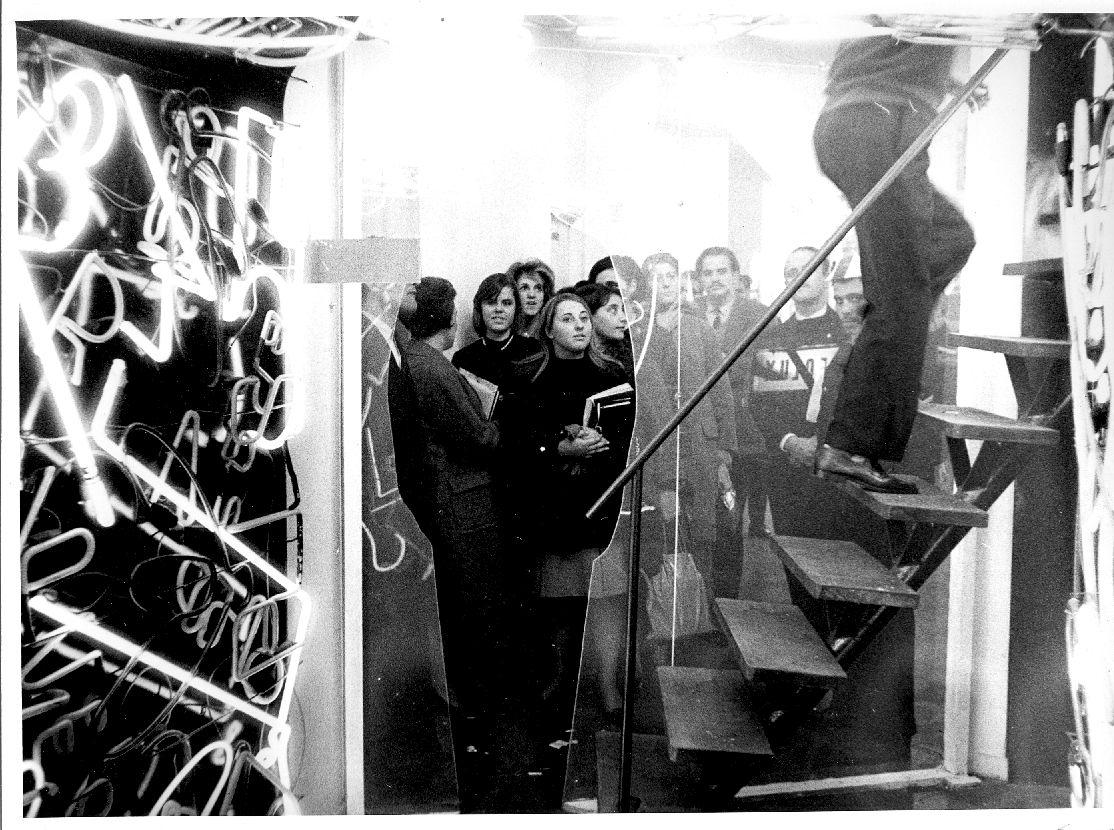
42
testimoniando en tiempo real el desenlace ineludible de los procesos de transformación que se habían sucedido en Buenos Aires año tras año. Un año después, el 28 de junio de 1966, Onganía lidera el golpe de Estado que derrocaría al presidente Illia, instaurando la Revolución Argentina. Es el fin del paréntesis democrático y el inicio de un nuevo período de censura y represión. El ambiente del arte se transformó, el Pop comenzó a sonar como una tontería o un juego de niños, las obras se destruyeron en medio de la calle, se radicalizaron, se manifestaron como pudieron contra el yugo militar. La Menesunda hizo su aparición en medio de la década, a medio camino entre el Pop y la política, en ese espacio liminal que se abre ante aquellos eventos capaces de transformar la realidad. Radicalizó la práctica artística, la expandió en el espacio, la conmocionó con su descaro y su deseo de provocación, para luego replegarse sobre sí misma: al cabo de dos semanas se desintegró, y su rastro quedó sólo en los diarios y en el cuerpo de aquellos que la transitaron. La Menesunda fue, no tanto un punto de partida, sino el cierre de un capítulo que abre la puerta al siguiente episodio de la historia del arte argentino.
43


La Menesunda, 1965
Vistas interior de la Habitación octogonal de espejos Cortesía Archivo Marta Minujín
View of The Octogonal Mirror Room Courtesy Marta Minujín Archive

45
La Menesunda
By Sofía Dourron
In the middle of May 1965, hundreds of Buenos Aires residents crowded onto Florida, standing outdoors for hours in a queue that blocked the entrances to local shops and attracted the curiousity and occasional comments of passers-by. They were patiently waiting for their chance to enter, one at a time, La Menesunda, the legendary artwork created by Marta Minujín and Rubén Santantonín at the Instituto Torcuato Di Tella. Under the premise “On this side of gods and ideas / feelings / mandates and desires,”1 the intricate maze challenged, unsettled, surprised and startled anyone who dared to cross its threshold. Jolting spectators out of their habitual passivity and immersing them in a hectic environment, the artwork combined domestic familiarity with the hustle and bustle of downtown streets and the latest avant-garde concepts, all in a single gallery space. One by one, visitors were led down narrow passages from one weird environment to another, amid a succession of multi-sensory, aesthetic and ethical stimuli designed to affect the senses and sensibilities of even the most sceptical, mistrustful or timid among them. La Menesunda, its creators said, wasn’t an artwork, nor a happening , nor a spectacle. Somewhere between an urban folk rite and media event, La Menesunda , with its brazen, melodramatic and revolutionary spirit, was pure experience and provocation. It was an unprecedentedly ambitious project that would become the scandal of the year and one of the great landmarks in the history of Argentine art.
The major operation organized by Minujín and Santantonín, together with the artists Floreal Amor, David Lamelas, Leopoldo Maler, Rodolfo Prayón and Pablo Suárez, was the culmination of a process of modernization in art and culture that had begun ten years before and, by 1965, seemed to have become well-established. The fall of Peronism in 1955 gave rise to the belief that years of cultural isolation were over, that there was a significant opportunity to renew art, to catch up with the rest of the world. In the mid-fifties, the notion of the ‘new art’
appeared, an urgent call to create local styles with an international appeal but that wouldn’t simply copy foreign trends. This was a radical departure from the aesthetics of the past. From the end of the previous decade, with the rapid rise of Informalist, gestural and material painting, which sought to break away from local pictorial traditions, artists started to take new, more radical postures, with Kenneth Kemble (1923-1998) and Alberto Greco (1931-1965) leading the way. They were determined to abandon the old canons, formats and materials and to explore new paths in their forthright rejection of the traditional languages of art. They experimented with a wide array of surprising materials: tar, sand, rags, metal sheets, cardboard, consumer waste and a series of objects produced by mass culture, attaching them to the canvas. This aesthetic upheaval did not just alter production methods and materials, it also saw the development of new strategies for the circulation and legitimization of contemporary production. It produced an emergent institutional framework that would implement cultural policies supported by an accelerating economic development. The Museo de Arte Moderno (1956) and the Fondo Nacional de las Artes (1958) were founded while the Museo Nacional de Bellas Artes was re-opened in 1956. Finally, in 1960, the supreme catalyst for avant-garde movements in Argentina, the Instituto Torcuato Di Tella, was inaugurated. The Instituto’s Centro de Artes Visuales was launched in 1963 under the directorship of the bald, august figure of Jorge Romero Brest, an influential critic and founder of the magazine Ver y Estimar (See and Evaluate) who had been the Director of the Museo Nacional de Bellas Artes between 1955 and 1963. Its zeal for progress, instilled with the modernizing, internationalist spirit that reigned in the country during this period of significant economic development known as ‘Desarrollismo’, saw it encourage experimentation in art, investing significant resources and promoting it in the media to an extent thus far unheard of in Argentina. Some words of this pope of art can illustrate the spirit of the process: “Young people don’t just break moulds, for previous generations have already done so; they adopt freer attitudes and this can only be achieved by significant action in every aspect of their lives. The difference might seem very subtle [...] but it exists: it provides the basis for our optimism, nourished
46
1- Marta Minujín, Rubén Santantonín, La Menesunda, Instituto Torcuato Di Tella, Buenos Aires, 1965, brochure.
by the general approval of the foreign critics who have visited us in recent years...,”2 he said in 1964.
Throughout the sixties, many of the artists who gathered around the Di Tella had already embarked upon transatlantic journeys of exploration and self-discovery, mainly to Paris. Subsequently they switched to New York, the new centre of modern art. These young people returned full of energy and ideas to Buenos Aires, where they would employ and develop their experiences and the lessons they had learned abroad. The Di Tella offered them the space and support they needed to lay their nets and usher in a new era in Argentine art. For a few years the avant-garde and the institutional happily went together hand in hand, as the Instituto’s programme managed to satisfy much of the artists’ determination to break with the past. It was a partnership that worked for both parties but that started to crumble at the end of the decade due to the predictable tensions that subsequently arose between artists and the institution, generated by a divergence of interests and ideologies. Eventually, the Instituto revealed its conservative side in the face of the politicization and radicalization of artists who fiercely opposed its attempts to tone down their output or adapt it to institutional rules and demands. They did so in a number of ways; most significantly in their reactions to the Premio Ver y Estimar presented at the Museo de Arte Moderno; to the exhibition Experiencias 68 at the Di Tella; and to the Premio Braque, sponsored by the French Embassy and presented at the Museo Nacional de Bellas Artes.3
However, during the years this happy marriage lasted, artists took the opportunity to give free rein to their explorations into strategies that sought to exceed the boundaries of traditional artistic categories. The adventures in Pop Art, happenings , installations, the dematerialization of objects and disciplinary cross-
overs became common among those who frequented the ‘Crazy Block’, as the affectionate nickname for the area around the Di Tella. These practices were driven by an increasing focus on contemporary life, with the rapid transformation of the present and the mass of cultural, political, economic and social dilemmas that this brought about. In this context of trial and error, the problem of art as experience and its critical potential was brought increasingly to the fore until in 1964, to the indignation of the press and the detractors of the avant-garde, the Instituto Di Tella awarded its National Prize to Minujín for her pieces ¡Revuélquese y Viva! (Roll Around and Live!), a small room filled with multicolour mattresses that invited the visitor to unleash their hedonism and literally roll around on the soft surface, and Eróticos en Technicolor (Erotics in Technicolor, 1964). Special mention was also given to Emilio Renart for Integralismo . Bio-Cosmos N°3 (Integralism. Bio-Cosmos N°3, 1964), a tour-able installation made up of mixed media sculptures and paintings of immense, twinkling vaginas. The Di Tella Prize did not just legitimize and embrace the practices of these young artists, it institutionalized a series of issues linked to intimacy, sexuality and the forced inclusion of the spectator’s body in the work, pushing the boundaries of morality and decency of the time, together with an explicit and strident desire to cause scandals. This was the year when the word ‘happening’ entered the mass media’s lexicon and the Di Tella became a topic for argument and discussion in the press.
During the sixties, a space opened up in art for transgression, for breaking down the barriers to everything that could not be discussed before, to subjects that one had barely been able to think about in the past; a portal to a new dimension. Thus, the political and social arguments that shook Argentine society to the core began to appear in artworks such as Introducción
2- Romero Brest, Jorge.”Introducción.” In New Art of Argentina. Exhibition catalogue., Buenos Aires: Instituto Torcuato Di Tella, 1964.
3- In 1968, the art scene reached its moment of greatest tension. At the opening of the Premio Ver y Estimar, Eduardo Ruano threw a brick against his piece, a poster of John F. Kennedy in a glass case, shouting “Yankies get out of Vietnam!” In May, the exhibition Experiencias 68 was held; known as the Premio Nacional Di Tella , it had assumed the title Experiencias in 1967. At the opening, Pablo Suárez distributed at the door of the Instituto his ‘letter of resignation’, addressed to Romero Brest, in which he stated his disappointment with the institution and his decision not to continue exhibiting his pieces in that context. A few days later, the police closed the exhibition after the public spontaneously covered the work by Roberto Plate with drawings and inscriptions deemed offensive by the Onganía regime. After the closure, the artists withdrew their works from the Instituto and took them out onto Florida, where they destroyed them. Some of the artists were arrested. In June, the Premio Braque announced a new requirement: a description of the texts to be included in the works had to be presented in advance and the organizers would reserve the right to modify the works whenever necessary. The artists responded with letters and manifestos: first Margarita Paksa, then Plate and finally a group of artists from Rosario led by Juan Pablo Renzi wrote and distributed the text “It is always time to refuse complicity ” During the ceremony, another group of artists entered the Museo Nacional de Bellas Artes, throwing objects and voicing their own speeches. Once more, several of the artists were arrested.
47
a la esperanza (An Introduction to Hope, 1963), by Luis Felipe Noé, which blew apart the limits of painting with the sheer power of Argentine history, and the VivoDitos (1962-1965) by the greatest agitator of them all, Alberto Greco: actions in which the artist drew attention to people by enclosing them in a chalk circle before signing them as if they were a sculpture or painting, desacralizing the artistic object, using other people’s bodies as his sole medium. Randomness and humour would also appear in the work of Federico Manuel Peralta Ramos, who in 1964 presented at the Galería Witcomb a set of paintings so large that they couldn’t be hung, and so overloaded with materials that they started to ooze down the canvas onto the gallery floor, covering it in paint, thus undermining the rigidity of the artistic tradition. At one point, Peralta Ramos even sawed off a painting that wouldn’t fit through the door.
After a long period of rigid military rule that began in 1955 with the Revolución Libertadora and extended into the governments of the Radical party members Arturo Frondizi and José María Guido, the fragile institutional structures that Dr. Illia had established between 1963 and 1966 offered a sense of new possibilities that it was essential to take advantage of. However, the next military coup was just around the corner and the most powerful military and economic groups in the country were breathing down the Doctor’s neck. The Cold War made the world dance to its tune, and the famous ‘national security’ doctrine imposed by the United States had spread throughout Latin America. It was the end of the Kennedy era and the renewal of an increasingly militarized war against Communism and any form of subversion of what were seen as essential values: Western, and Christian. These were the days of the Vietnam war, of the occupation of the Dominican Republic and the invasion of the Bay of Pigs; of guerrilla movements, counter-culture, hippies and the struggle for human rights. In Argentina, the period that began with the Revolución Libertadora was turbulent, politically chaotic and economically unstable, interrupted by brief periods of economic growth and pseudo-democratic
relief. Artists were not indifferent to any of this.
The same year that, within the bubble of fresh air created by the Instituto, Renart and Minujín were awarded prizes by the illustrious jury of the Premio Nacional Di Tella –Romero Brest, Pierre Restany and Clement Greenberg– Julio Le Parc received a mention in the international section of the award. The work Inestabilidad. Proposición arquitectural (Instability. An Architectural Proposition) consisted of a series of curved aluminium sheets that, connected to a motor, intermittently allowed bright lights to shine through one side of the structure. The piece, which was in line with the explorations of the GRAV ( Groupe de Recherche d’Art Visuel ) group that Le Parc was a member of in Paris, provided a space where spectators could open up to the subtleties of perception and claim their share of participation.
Towards the end of 1964, a series of projects based around these concepts were buzzing about Romero’s ears. One of these was a model that arose out of meetings being held by Santantonín and Minujín with Renart, Kemble and Pablo Suárez; the seed for what would soon become La Menesunda 4 Since 1963, Santantonín’s Arte-cosa rodante (Art-mobile thing) project had also been doing the rounds at the Di Tella offices. This was an initiative that sought to realize his ideas about the role of the spectator/participant/gawker –as Santantonín described the non-viewer of his work5– in an artwork. According to texts written by the artist it was a “kind of unformed piece with a dry, reddish surface stretched over a dais dragged around by a jeep [...] that would drive through the city attracting attention for its similarity with popular monsters in Bolivia, Mexico and Peru. Once it had parked in a plaza, the public would be invited to come inside, where they would cease to be spectators and become part of a different, magical world –one they had played a significant part in creating. They would enter the belly of a huge form where they themselves would be moving and composing forms.”6 Arte-cosa rodante constituted an extreme incarnation of ‘the thing’, a concept he adopted in 1961 to describe the works
48
4- This project is mentioned in: Laura Buccelato, Greco Santantonín, Fundación San Telmo, 1987, exhibition catalogue; Marcelo Pacheco, “De lo moderno a lo contemporáneo. Tránsitos del arte argentino 1958-1965” and in Inés Katzenstein (ed), Escritos de vanguardia. Arte argentino de los años ´60 Fundación Espigas, Buenos Aires, 2007.
5- Rubén Santantonín, Hoy a mis mirones, Galería Lirolay, Buenos Aires, 1961, flier.
6- Rubén Santantonín, personal archive.
that earned him, along with Luis Wells, a place in the pantheon of ‘Argentina’s Band of the Damned’, as they were called by Kenneth Kemble,7 who believed them to be artists whose innovations were misunderstood and in danger of being ignored for being ahead of their time.
Artistic statements about the contemporary situation, in which the artists challenged the terms of participation of the spectator in the processes of creation and exhibition of works; the increasingly ductile boundaries of aesthetic language and the possibility of disruption seem, along with perseverance by artists, especially the indefatigable Minujín, to have inspired Romero Brest to finally commission the audacious project. Thus it was that at the end of 1964 Minujín and Santantonín, with the complicity of Amor, Lamelas, Suárez, Prayón and Maler and a master builder whose name has been lost in the mists of time, work commenced on the titanic project of La Menesunda, a maze of compartments that would contain situations whose aim was –as the exhibition flier said– to “intensify existence.”
This work, with its eleven rooms, as labyrinthine and confused as its slangy name suggested, created a visual and sensory mixture related to modern life in the city, a life that in 1965 had a short but intense existence with its collective cultural and folkloric rites, with established itineraries and preoccupations that became apparent as one walked through it. After a long wait on Florida street, surrounded by works by the modern painter Jean Dubuffet, the eager audience was finally able to enter the exhibition that was all over the media. The press described the scene in great detail: “We arrive at the Instituto Torcuato Di Tella (Florida 936) and are met by a long line of people waiting to enter La Menesunda . Men and women, some of them sceptical and others smiling. They anxiously studied the faces of the people coming out. What were they about to see? What was going to happen to them inside?”8
The first stage implied walking through a pink acrylic portal, through an elongated human figure, where a
security guard met visitors and issued instructions about how the exhibition worked. In a similar vein, a sign told the visitors that they should first climb up a steep, precarious staircase that blocked the way to a tunnel of neon lights suggesting the dazzle, hustle and bustle of the city centre. The staircase led up to the first of the environments: a kind of ship’s deck equipped with seven televisions, two that played images of the visitor on a closed circuit and five more playing images from local television, everything from the news to a music programme called ‘El Club del Clan’. This small space was a microcosm of the rest of the itinerary. The presence of the television sets, which were only beginning to become widespread in family homes in Argentina, and the novelty, for most people of seeing themselves on television for the first time, addressed a series of issues that would later recur: the unstoppable progress and domestic spread of technology and the media, the invasion of the spectator’s body and privacy, their absolute immersion in a structure as precarious as it was spectacular, the impossibility of evading it, or of evading themselves –which in this case amounts to much the same thing. La Menesunda was without doubt a provocation; its objective was to shake people out of the stupor of everyday life and force them to confront these routines, represented by extremely familiar objects, and open their eyes to the possibility of new, critical readings. Would television be a new and improved form of entertainment or a power-serving and alienating mass medium?
After being confronted by an image of oneself on the screen, the visitor had to choose whether to go down the tunnel of neon lights that emulated the lights on Avenida Corrientes, or move on to the next space, where they would be presented with another striking image, that of a couple lying on a bed in their underwear.9 The actors –a couple who after a long shift in the artwork eventually broke up, and another pair who barely knew each other 10 –spent the day smoking, knitting and listening to The Beatles, while people walked around the bed. Some of the visitors made barbed comments or cast disapproving looks while others smiled in complicit acceptance and
49
7- Kenneth Kemble, “Argentina’s Band of the Damned”, Buenos Aires Herald, 25 September 1961.
8- “‘Algo’ para locos o tarados” , Careo, 2 June 1965.
9- According to some of the artists who took part in the construction of the work, it was the matrimonial bed and these actors’ performances that aroused the interest of the media and the subsequent flood of interested onlookers. Conversations between the author and Leopoldo Maler and Rodolfo Prayón, May 2015.
10- According to Leopoldo Maler, May 2015.
approval. Nudity and a matrimonial bed exposed to the light of day: an affront to morality, a shameless transfer from the private to the public realm; in short, this was either a supine scandal or a blow for the liberation of a youth suffocated by a prudish society that idolized Christian virtue. This image was eagerly reproduced by the media, becoming an icon for the artwork and synonymous with provocation. This alone was enough to shock visitors, who, after hitting their heads on the low doorframe of the exit, continued down another narrow staircase into the inside of a huge woman’s head whose exterior had been painted by Pablo Suárez,11 while the interior was covered with beauty products. There, a professional make-up artist and a masseuse graciously offered their services to anyone who might want them. In an article, Minujín and Santantonín explained: “With this we wanted to indicate that the spectator was inside the head of a woman of our generation...,”12 to which the press responded with complaints and controversy, alleging that this offended women whose interests were not focused exclusively on make-up and beauty treatments, without considering that it was a possible reflection on the changing role of women and their new obligations and opportunities in a rapidly changing society.
The next stage implied stepping, with no little effort, into a spinning iron basket covered in strips of coloured plastic which in turn led to other spaces. The first, a thin passage covered in enormous polyethylene ‘intestines’, had a roof that gradually got lower, narrowing the space available to the spectator and ending in an apparently anal orifice that one could look through to watch peaceful scenes taken from films by Ingmar Bergman, a figure who had a significant influence on the new Argentine cinema which at the time was questioning the local tradition of bourgeois comedy and gaucho adventures.
This wealth of both learned and popular references evinces the complexity of a work that closely examined its fast-changing environment, taking these references out of their cultural context and juxtaposing them, on an equal footing, in a single environment. The game of
contrasts between the sophistication and density of a Bergman movie and the popular culture of Argentine television and beauty products underscored the tensions of contemporary life in the city of Buenos Aires, where the Club del Clan and Los Gatos, Rodolfo Walsh and Palito Ortega, Rodolfo Kuhn and Carlitos Balá, The Beatles and national folk music were always jostling for position. However, these details were lost among the flood of accusations and insults cast at the artwork by the press: of course this uproar was only to be expected when such a project was presented in a public forum, rife with internal contradictions that accurately reflected the clash between a society in the midst of a cultural modernization and the rise of the military with its rigid, out-dated values.
After the brief cinematic interlude, the visitor returned to the basket and entered what its creators called ‘The Swamp’, a spongy passage covered by pieces of rubber foam falling from the walls that made walking extremely difficult. Next, one entered a small, dark room that smelled intensely of a dental surgery, potentially designed to cause attacks of claustrophobia, furnished with an immense telephone dial and a single instruction: ‘Press the button to open the door’.13 A brief passage through a refrigerator where the temperature was set to freezing led to a hallway full of different forms and textures: rough, smooth, pleasant and unpleasant surfaces that could not be avoided. Finally, one arrived at an octagonal room with mirrored walls that stank of deep frying, the smell that in Buenos Aires can be found on Avenida Corrientes emanating from pizzas at ‘Güerrin’ and milanesas at the ‘Palacio de la papa frita’, at the centre of which was a transparent acrylic cabin from which ultraviolet lighting and fans were switched on to cause a whirlwind of confetti that would stick to the spectators on their journey home. The nightclub-style ultraviolet lighting evoked the Mau Mau club,14 while the mirrored walls were reminiscent of theme parks and haunted houses. All in all: enough material for several sessions of psychoanalysis. In this octagonal room, the gaze had nowhere to escape and one’s reflection
50
11-Conversations by the author with Leopoldo Maler and Rodolfo Prayón, May 2015.
12- “‘Algo’ para locos o tarados”, Careo, 2 June 1965.
13- The secret number, although according to the press it wasn’t that secret, was given to the visitors to prevent fainting or claustrophobia among those most susceptible to darkness.
14- A famous nightclub that ran in Buenos Aires from the mid-sixties to the eighties.
followed them everywhere: it was the final encounter with the avant-garde and its brutal transformations of art and ego. There was certainly no going back now.
In addition to the problems posed by the combination of avant-garde language, public participation, experience, mass culture and collaboration as a working methodology, this project was part of a dynamic that had begun with initiatives such as the exhibition Arte Destructivo (Destructive Art, 1961), in which a group of artists led by Kemble exhibited a series of found objects and an audio recording made especially for the occasion, and the famous poster ¿Por qué son tan geniales? (Why Are They so Brilliant?) that Edgardo Giménez, Charlie Squirru and Dalila Puzzovio created with an advertising agency and displayed for months at the central city corner of Florida and Viamonte, and the works by the elated duo Delia Cancela and Pablo Mesejean, a pop partnership that lasted more than twenty years. La Menesunda did not just embrace collaboration as a contemporary practice; this exuberant production wouldn’t have been possible without it. This was not just because of its large size –although the exhibition structure took up the whole of the Instituto’s gallery–: the complexity of its structural and planning requirements made it a colossal enterprise that challenged the will, patience and commitment of all the participants. The team set about its task with such enthusiasm and fervour that some even lost their jobs because they were working on La Menesunda . Nor were they indifferent to the implications of this kind of venture. These practices and strategies did not just make the figure of the artist more visible and better represented; contrary to the subjective desire for recognition displayed by artists such as Minujín and Greco, they expressed a clear posture that allowed for a re-reading of the notion of authorship, prefiguring the debates that would break out on the issue at the end of the decade, in the work of Roland Barthes and Michel Foucault.15 The definition of the author grew blurred while the work of art started to escape the boundaries of the frame to become an object and finally to disintegrate in thin air.
La Menesunda was, since its initial conception, the sum of infinite parts. It is the sum of Minujín and Santantonín and many other influences that filtered through the cracks in the walls of the improvised labyrinth. These include Bio-cosmos n°1 (1962) by Renart, the Primera Exposición de Arte Vivo-Dito (First Exhibition of VivoDito Art, 1962) by Greco, Microsucesos (Microevents, 1965) by the company La Siempreviva, the free spirit of Federico Manuel Peralta Ramos, the Anthropométries by Yves Klein and the happenings by Allan Kaprow, Robert Whitman and Jim Dine, among others. It was the confluence of two artists who, in their own separate ways, revolutionized Argentine art, catalyzing the artistic avant-garde with their critical thought and forthright action. Together they blew a hole in the institutional space of Argentine art in the sixties, big enough to include a gigantic, absurd work that would stretch the avant-garde’s potential to its extremes until its eventual explosion in 1968.
Minujín and Santantonín, Marta and Rubén, day and night, oil and water. The young, bubbly, enthusiastic Marta (Buenos Aires, 1943), fascinated by the future and everything it had to offer, anxious to discover the world and for the world to discover her; Rubén (Villa Ballester,1919-1969), pintor-cosista (painter-thingist),16 austere, serious, thoughtful and circumspect, forever worrying about the wrongs that trouble contemporary man. Their paths had already crossed at previous exhibitions organized at the Galería Lirolay (1962), the Museo de Arte Moderno (1962) and the Di Tella (1964). In the exhibition brochure for El hombre antes del hombre (Man Before Man, 1962), a collective show that explored the proliferating output of young artists in the city, promoted by the Galería Florida and sponsored by the Museo de Arte Moderno, the Museum’s director and founder, Rafael Squirru,17 said that he was inspired to organize the event after a conversation with them about the defeatist and indifferent atmosphere that surrounded the contemporary artistic environment. These were, however, two artists from different generations and of
15- In 1968, Barthes published “The Death of the Author”; the next year, in 1969, Foucault published his text “What is an Author?”
16- This
how
51
was
Rubén Santantonín defined his activities in a form for the MAM, which he diligently filled out in 1966. Museo de Arte Moderno de Buenos Aires Library and Archive.
17- In 1956, Rafael Squirru created the Museo de Arte Moderno de Buenos Aires. An art critic and poet, Squirru was a promoter of Informalism, the Generative Art movement, and of many of the young artists who lived in Buenos Aires from the mid-fifties to the early sixties.
contrasting temperaments who at a given historical moment walked the same path, starting out with dark, existential Informalist painting and the use of precarious materials and moving on to lose themselves in the total art work and immersive experiences, and who at different times and in different circumstances explored the process of destroying their own work.18
In the early sixties, Marta started to incorporate new materials into her traditional Informalist painting such as cardboard boxes, which she painted black and occasionally crawled into: this marked the beginning of a lengthy new career path. Soon afterwards, in Paris, she began collecting old, dirty mattresses, many of them from hospitals, with which she built small dwellings, suggesting new ways of inhabiting a work of art. In 1963, Minujín was already distancing herself from Nouveau Réalisme by burning all her paintings and mattresses on a large pyre as part of an action known as La destrucción (The Destruction, 1963). In a memoir written shortly afterwards, Minujín describes the action at Impasse Ronsin: “I felt and stated that art was much more important to humanity than an eternity to which only the cultured have access, framed in museums and galleries. To me it was a way of intensifying life, to impact upon the observer, to shake them up and jolt them out of their inertia. So why would I hold on to my work?”19 The artist thus set about building spaces with mattresses that were now multi-coloured and hand-sewn, such as La chambre d’amour (1963-1964), made together with Mark Brusse: a wooden structure covered in mattresses, a habitable, playful room with erotic overtones. Back in Buenos Aires, the artist organized and created the experiences and artworks that won her the aforesaid Premio Di Tella. In October 1964, Minujín held her first happening in Buenos Aires, on the Channel 7 television programme La campana de cristal, which involved dozens of chickens, balloons, voluptuous athletes in their underwear, a pony loaded with paint buckets as a saddle and a provocative Minujín performing a wild Sioux dance.
Santantonín’s artistic career was as rapid as it was powerful and unusual. Born in 1919, it was only in 1943, as several accounts state, that he taught himself to paint, on the recommendation of Carlos Ripamonte, one of his neighbours in the Buenos Aires neighbourhood of Villa Ballester. He held his first individual exhibition in 1958: a series of abstract paintings that soon became Informalist and just as quickly became things: loosely shaped bundles of plastered canvas and waste materials, paper, cardboard and leather thongs that hung from the ceiling on wire or thread. The things made their first public appearance in 1961 at the exhibition Collages y cosas (Collages and Things) that Santantonín organized together with Luis Wells at the Galería Lirolay. There he also presented the text/manifesto entitled Hoy a mis mirones (To My Gawkers Today),20 in which he says: “I think that I make things. I sense that I am starting to discover a method that places me at a more intense existential crossroads than if I were to reduce myself, with all my well-developed anxiety, to the canon of painting.” In 1964, the artist’s ideas about his production and art seem to have consolidated. In the flier that accompanied his exhibition Cosas (Things) from 1964, he says: “The THING as an artistic approach to the problem is the result of the advent the object. IT HAPPENS thanks to the life we lend it on perceiving it as a THING. The moment that we cease to lend it this status, it will immediately revert back to being an object. I see the THING as the human effect upon objects, the vital poetry of the object.”21 The thing , essentially indeterminate, acts as the starting point for an investigation into what is to come. It is also the beginning of a shift by the spectator from contemplation to immersion, the breakdown of the hermetic isolation of the work of art as an object.
Each artist’s words seem to find echoes in the other’s. From the moment that Informalist painting was left behind, paths were opened up for new, more turbulent experiences, and more engaged with their context and present. La Menesunda embodies both their power: the
52
18- In 1963, Marta Minujín carried out an action known as La destrucción (The Destruction), when she burned the artworks she had made during her stay in Paris. In a completely different spirit, in 1969, shortly before his death, Rubén Santantonín destroyed almost all his artworks in a large bonfire.
19- Marta Minujín, typed text on La destrucción (The Destruction), Marta Minujín Archive.
20- Santantonín, Rubén, Collage y cosas, Galería Van Riel, Buenos Aires,19 September1961, exhibition brochure.
21- Rubén Santantonín, “Porque nombro ‘cosas’ a estos objetos”, in Cosas, Galería Lirolay, Buenos Aires, 1964, brochure.
actions that Minujín had consistently and persistently organized since she first appeared on the scene with her risky, challenged praxis and Santantonín’s deep consideration of his own practice, existential in nature but looking towards the future, rooted in detailed study and in work with materials and forms, exploring how they develop in the world and affect the spectator.
La Menesunda is the materialization of the preoccupations and experimentation of both artists with the potential of artistic language and its ability to affect and transform the spectator. These interests were intimately related to their time and context; a period of cultural transformation, artistic exhilaration and political tension that had a profound effect on them. All these elements were catalyzed by the materials they chose, some of which were disposable and of everyday use –polyethylene bags filled with sawdust, shredded paper and rubber foam– while others, such as closed circuit television, were sophisticated, organized according to an unstable logic based on the fantasies of the group. The result was a disconcerting sequence that forced the spectator to pass from one state to its exact opposite, going up and down stairs, walking through a neon tunnel or a corridor of intestines, in the conviction that they were, if not transforming, then at least altering the paradigm of modern art and paving the way for a new vision of contemporary life. If in the early sixties, the avant-garde started to incorporate elements that had previously been foreign to artworks, forging close links to popular culture, by the middle of the decade the process was wellestablished. Objects were not just being incorporated into paintings and being used as compositional elements in their own right in paintings, sculptures and exhibitions, but real time and space were also being reproduced within the exhibition environment. The relationship with reality was brought to an extreme, reproduced without any form of mediation, or simply appropriated. Fleeting images from television, cinema and advertising filtered into the culture, driven by youths who yearned for the future, who were devoted to the new and suspicious of anything that seemed old. Mass culture became an inexhaustible source of material for pop artists, who found inspiration in the pages of magazines and record
covers by North American musicians. The value of consumer goods was exalted: their vulgar materials, bright colours, simulation and artificiality, challenging the prominence of traditional good taste. Juvenile hedonism became a strategy for disrupting the established order. Pop, with its festive tone, was also a reflexive, critical art that revealed some of the many ways in which languages and social structures mediated the relationship of man and world, while causing a historic change in aesthetic tastes.22 This playful spirit, with its heroes, idols, desires and fantasies, appears in the manifesto written by Delia Cancela and Pablo Mesejean in 1966:
“We love sunny days, plants, the Rolling Stones, white, pink and silver socks, Sony and Cher, Rita Tushingam and Bob Dylan. Furs, Saint Laurent and the young savage look, popular songs, the countryside, sky blue and pink, striped shirts, having our photos taken, hair, Alice in Wonderland, tanned bodies, coloured caps, white faces and happy endings, the sea, dancing, magazines, cinema, and sable. Ringo and Antoine, clouds, black, bright clothing, baby-girls, girls-girls, boys-girls, girls-boys, and boys-boys.”
La Menesunda adopted these concepts as its own, reproducing different aspects of reality in an archaeology of the present. It brought together several urban elements but especially the domesticity, rites and utensils of middle class homes, merging the spectators with its context by forcing them inside a series of appliances: the television, the telephone, and the refrigerator. This was no longer about incorporating consumer waste into artworks but rather transforming domestic objects into an aesthetic experience and thus exposing the mechanisms of the consumerist society of the sixties; its banality, marketing strategies and manipulation of consumers. It’s certainly ironic that funding for these projects came from SIAM Di Tella, one of the largest industrial conglomerates in the country. Because of its unique size and selfdestructive qualities (by the end of the exhibition the artwork was practically destroyed), La Menesunda escaped being converted into an object, thus severing any potentially restrictive ties to the past or tradition. It thus differentiated itself form a prehistory characterized
53
22- Oscar Masotta, Revolución en el arte. Pop-art, happenings y arte de los medios en la década del sesenta, Buenos Aires, Edhasa, 2004. [Original text on Pop Art: El pop art, Buenos Aires, Columba, 1967]
by the veneration of unique artistic objects. It was a work of total art that stimulated all of the spectator’s senses but also their moral sensibility, consistently stoking the urge to break the old shackles.
Both Minujín and Santantonín presented their thoughts about art and the possibility of transforming the spectator through the experience of an artwork, about their individual practices and La Menesunda with characteristic vehemence. Minujín wrote: “[…] Menesunda stimulates spontaneity and the imagination: creativity cannot be hindered or reasoned with. Menesunda is not meant to be contemplated but lived; its meaning will be found in the person who enters it.”23 Santantonín writes in a similar vein: “[…] We want man to feel how out-dated his previous attitude to the artistic thing was, we want him to feel challenged, committed, to find his own image mixed up with what he feels, sees and tries to do. / To provoke a brand new sensation within the participant, so new that they are forced to find a name for it.”24
In the conference that Romero Brest held during the exhibition, in addition to admitting the flaws and mistakes in the final product, he alluded once more to the notion of experience: “I believe that the artists of our time are trying to expand the field of experience, an experience that never ends, an experience, furthermore, without limits...”25 The participant is compelled to become part of the work of art, merging with it so it can be activated, to know it and know themselves in the process through their own attitudes, actions and thoughts.
But La Menesunda also pointed the way. It informed, confronted and examined people’s actions, it investigated behaviour and counter-behaviour, oscillating between the exercise of freedom and creativity and the normative itinerary of a labyrinth-laboratory. The work also set down patterns of order and conduct in a series of instructions communicated through signs and security guards, instructions that to some extent limited the possibilities of the visitor’s free participation. It was a pre-planned route that set in motion multiple reactions and combined the joyful idea of participation with a flood of stimuli ranging from the touch of soft textures to the hostility
of a freezing environment, from the pleasant surprise of seeing oneself on a television screen to enclosure in a small, dark ‘telephone box’. The play of contrasts generated similarly contrasting attitudes that accumulate throughout the tour, creating an intense and emotional experience. La Menesunda put the spectator to the test, measuring their ability to join the flow of the work and withstand the whirlwind of images and stimuli that were thrown at them, exercising their own subjectivity as they decided which paths to take and how to react to each situation.
In the context of a looming coup d’état and a world haunted by the Cold War, protests, guerrilla movements and threats to human rights, the idea of participation came to exceed the terms of the experience itself and was much more complex than the combination of sensory stimuli and spectacles on which the press and historians have built the myth of La Menesunda. The experience and act of participation transcend the artwork and even the ideas of the artists. Without anyone realizing it, it turned into a sociological experiment, providing for the observation of human behaviour in a determined context; that of a maze rooted in avant-garde art, in Buenos Aires, in May 1965. A few years later, Minujín would develop and expand these ideas, moving far beyond the chaos of her happenings with chickens and motorcyclists ( Suceso Plástico [Plastic Event], Montevideo, 1965), and probing human behaviour and its social uses in works such as Minucodes (1967), a ‘social situation’ in video-installation format that involved inviting several groups from different social and professional fields: businessmen, politicians, models and artists, to interact in an ostensibly neutral space. The manipulation and exposure of the media would reappear in Simultaneidad en simultaneidad (Simultaneity in Simultaneity, 1966), held at the Di Tella, where sixty famous people, selected according to an impromptu media ranking, were filmed, recorded and photographed from the front and in profile while everything that happened in the room could be seen on closed circuit television. A week later, the same people were invited back to the Instituto gallery to have the experience of seeing their image replayed to them by the media. During the seventies, Minujín even
54
23- Marta Minujín, typed text on La destrucción, Marta Minujín Archive.
24- Rubén Santantonín, personal archive.
25- Jorge Romero Brest, Arte 1965: del objeto a la ambientación, 11 June 1965, photocopy, JRB Archive, UBA.
experimented with (voluntary) kidnappings as a form of spectator participation in the work Kidnappening (1973), held at the MoMA in New York with the collaboration of Gary Glover and forty performers made-up to look like cubist paintings by the recently deceased Pablo Picasso. These actors performed movements and songs that combined opera, poetry and dance and encouraged the audience to take part. Once this stage was over, the performers kidnapped fifteen spectators –who had given their permission beforehand– and left them in different places in New York and its surroundings to continue the experience.
The years following the fall of Peronism were extremely complex politically but also economically: the country continued the process of growth and modernization that had begun a few years earlier, but it was hindered by a long series of conflicts. Economic modernization caused profound changes in Argentine society leading to transformations in the cultural and social order that permeated every facet of life. The mass audience that the Instituto Di Tella attracted for the occasion was an extraordinary occurrence that made clear not only the great power of the media to reach audiences but also the rise of a new public for culture consisting mainly of the professional classes, young intellectuals and students. This was a public eager for new cultural content and information, one of the main sources of which was the weekly publication Primera Plana , founded in 1962 by Jacobo Timerman. Following Primera Plana , Panorama (1963) and Confirmado (1964) were founded, making three news weeklies that were central to spreading awareness of cultural and political events in Argentina and overseas. Although they were aimed at the upper middle class, they soon expanded their readership to other sectors of society. By May 1965, avant-garde themes were being discussed on the pages of these publications: Primera Plana had eventually and with some difficulty reached an understanding of new practices and movements such as happenings and Pop Art, to which it would dedicate its front page a year later. La Menesunda accentuated this interest and caused a media frenzy during which it was criticized as “a desperate attempt to shock ‘the respectable bourgeoisie’ and ‘a kind of
divertissement’ ;” it was also compared to Parque Retiro and several different amusement parks. However, there were also considerations of its value as a breakthrough in the “mediocre, provincial (in the worst sense of the word) sphere of culture”, and of the risks it took. Fermín Fèvre wrote: “ La Menesunda involves risks, a veritable act of great commitment not just with regard to the critics or the subsequent fates of the ‘conspiring’ artists on this occasion. It is a transcendent commitment to the public and to art.”
The critic’s words summed up an atmosphere of breaking with the past but also one of new horizons and eventualities, the advent of a new way of approaching culture, which establishes experience as its field of investigation and artistic practice, as a problem for the avant-garde and a means of its expansion. Pierre Restany, the French critic who founded Nouveau Réalisme, heard about La Menesunda from other artists and declared: “Menesunda est une contribution locale á la grande oeuvre commune Elle illustre l’avènement à Buenos Aires d’une sensibilité autre, qui se pense et qui se veut à l’échelle du monde de demain, ” 26 bearing witness in real time to the inevitable consequences of the transformations that had occurred in Buenos Aires in those years. One year later, on 28 June, 1966, Onganía led a coup d’état against President Illia, beginning the Revolución Argentina. This marked the end of the democratic interlude and the beginning of a new period of censorship and repression. The artistic environment was transformed, Pop started to seem frivolous, or mere child’s play, artworks were destroyed in the street, and artists grew radicalized and protested as much as they could against military repression. La Menesunda made its entrance in the middle of the decade, midway between Pop and politics, in the liminal space that is opened up by events that can transform reality. It radicalized artistic practice, expanded it beyond its space, shocked with its brazenness and need to provoke and then folded in on itself: two weeks later it had disintegrated, leaving its mark only in newspapers and the bodies of those who passed through it. La Menesunda was not the start but rather the closure of a chapter that opened the door to the next episode in Argentine art.
55
26- Pierre Restany, “Soyez réalistes: apprenez à conjuguer la vie au futur!”, Paris, May 1965. Photocopied document, Archives de la critique d’art PREST.XSAML24/40 to 42.
56
El orden de las imágenes que siguen no corresponde a la secuencia de la película de Maler sino a la experiencia que los visitantes tenían de la obra. The order of the images does not follow the sequence of Maler’s film but visitors’ experience of the artwork.

57
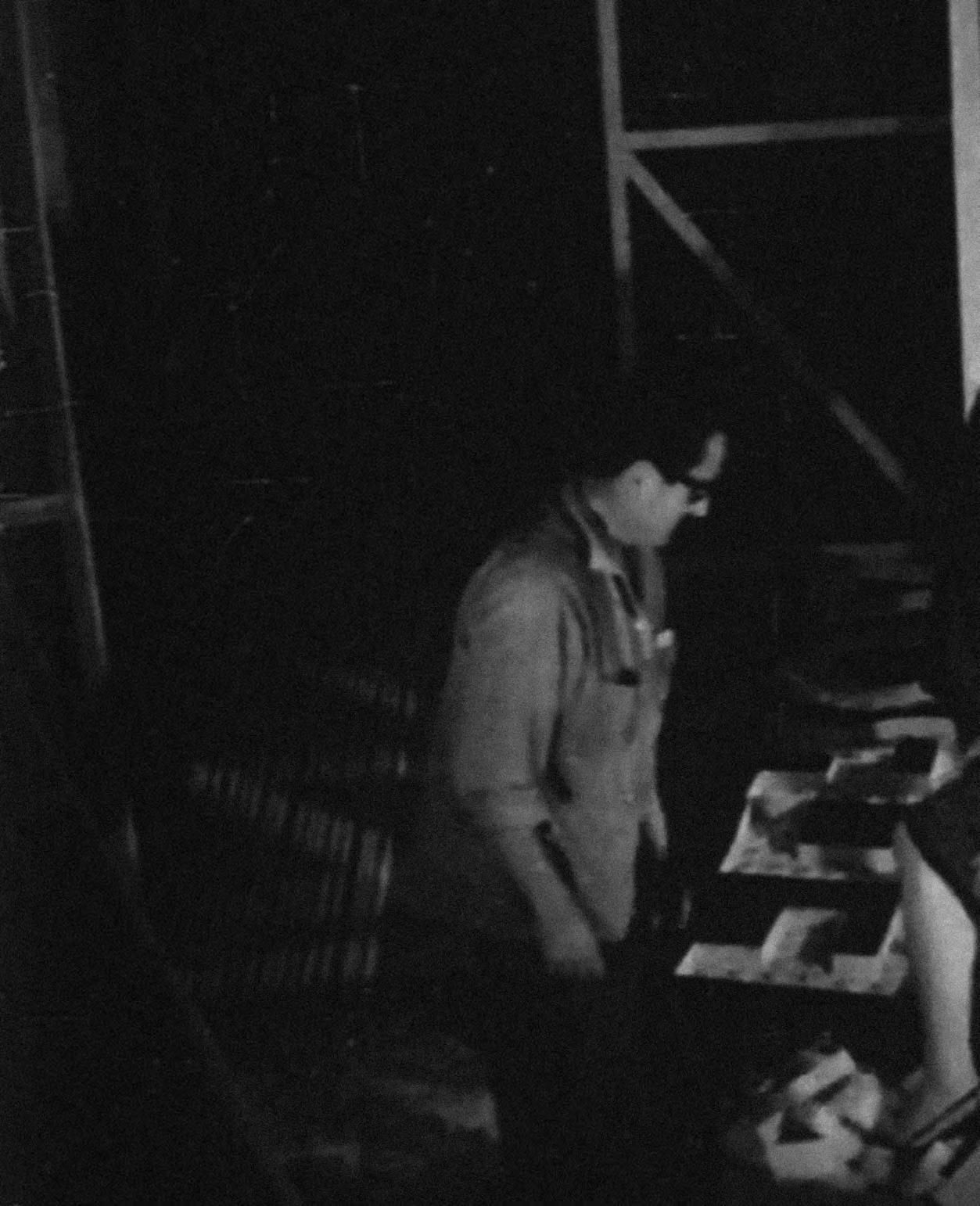





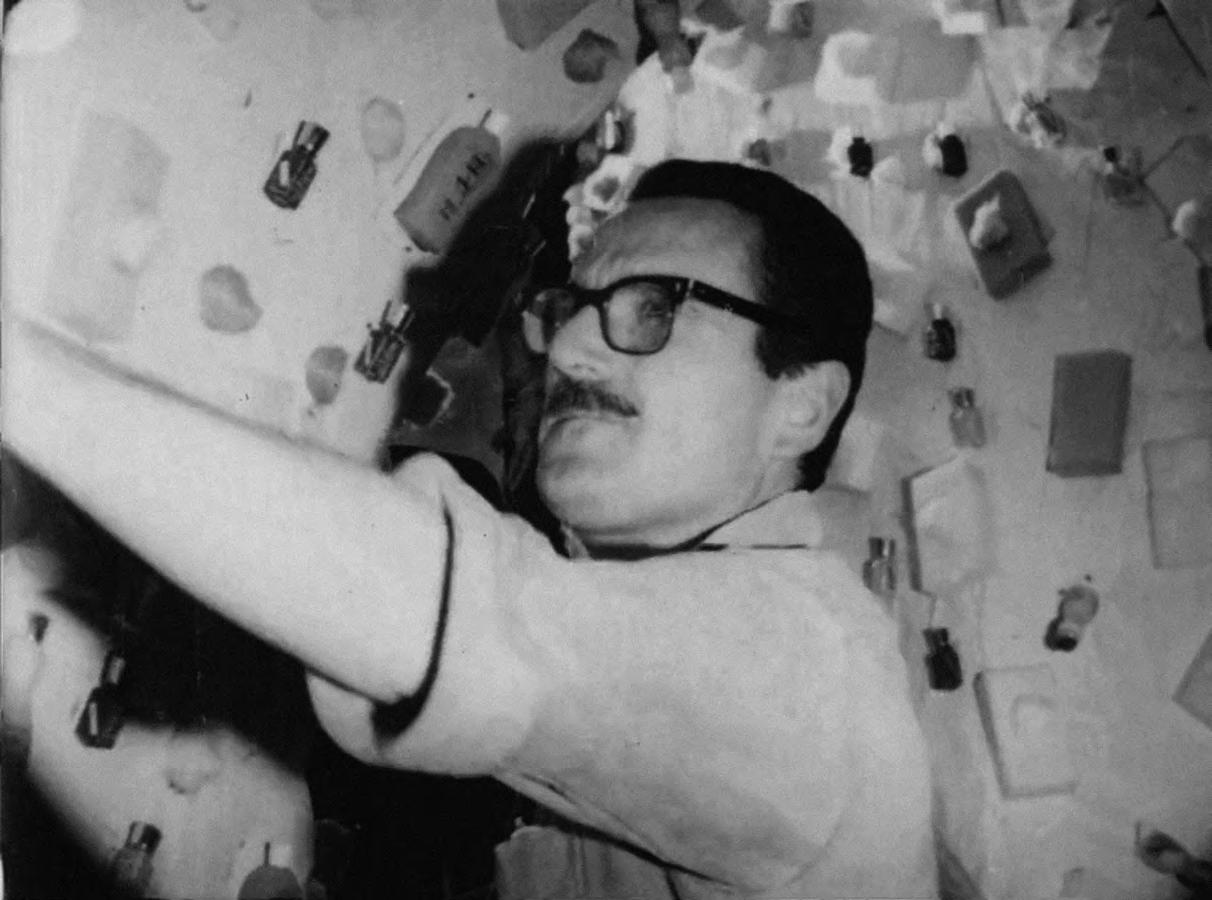

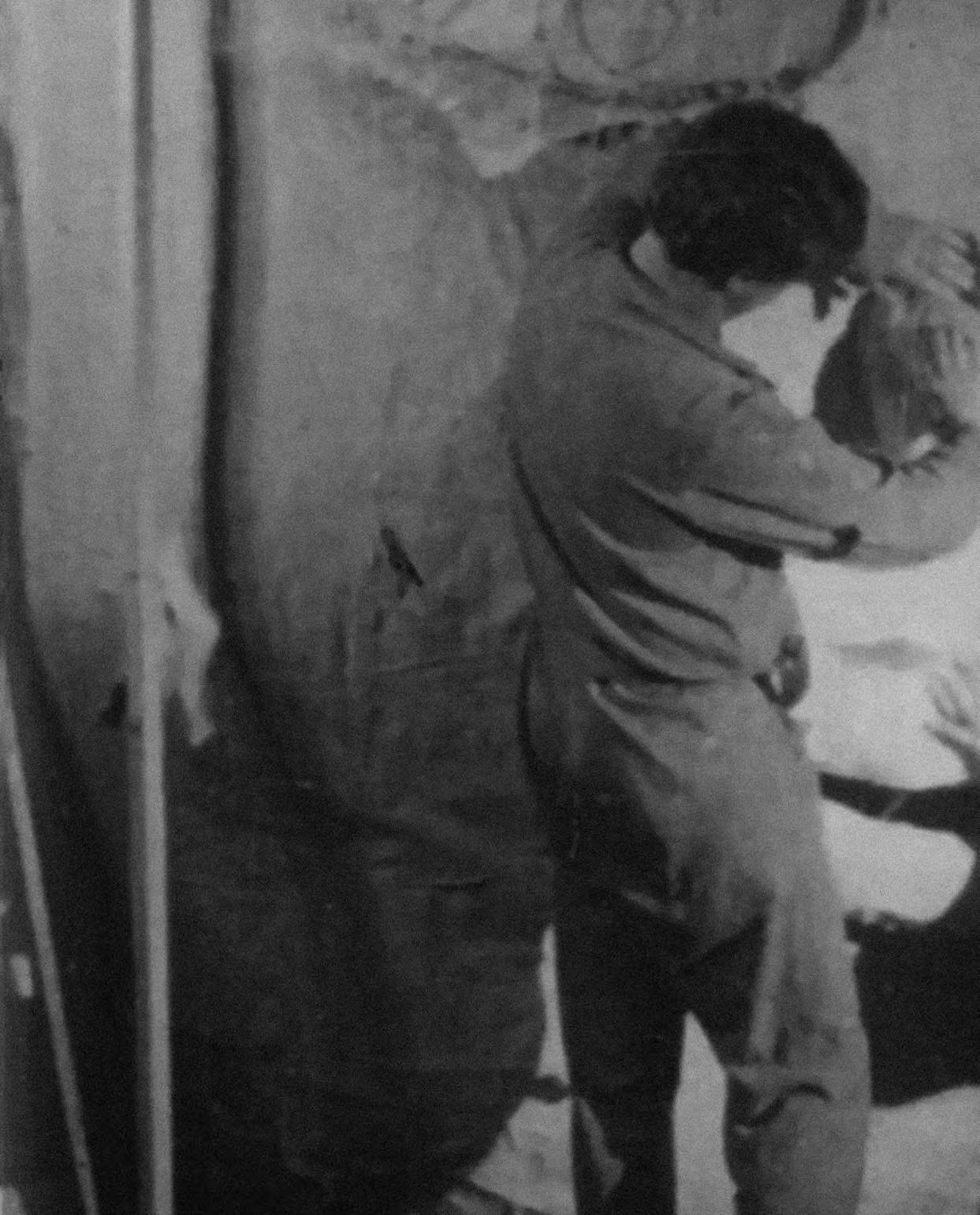
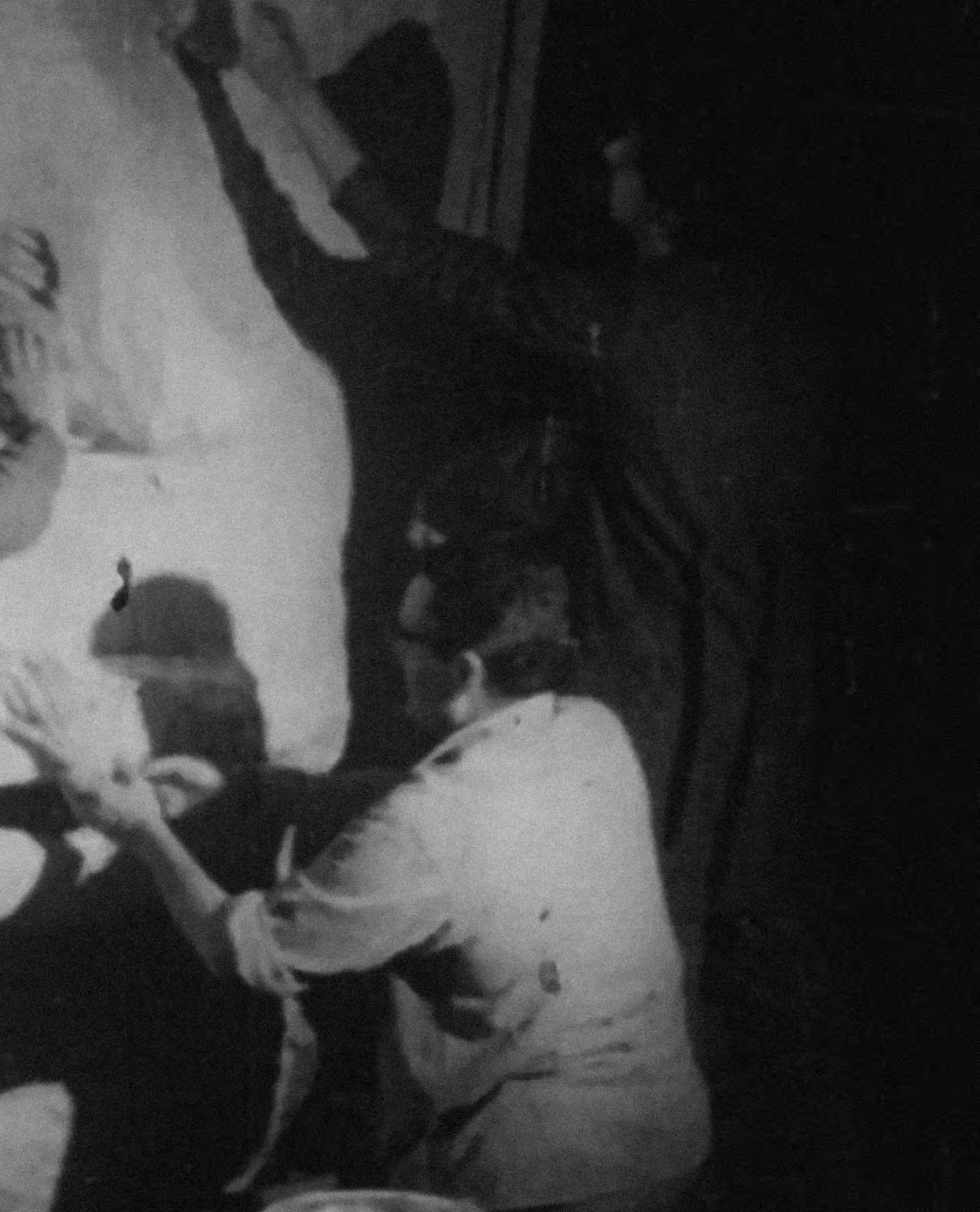
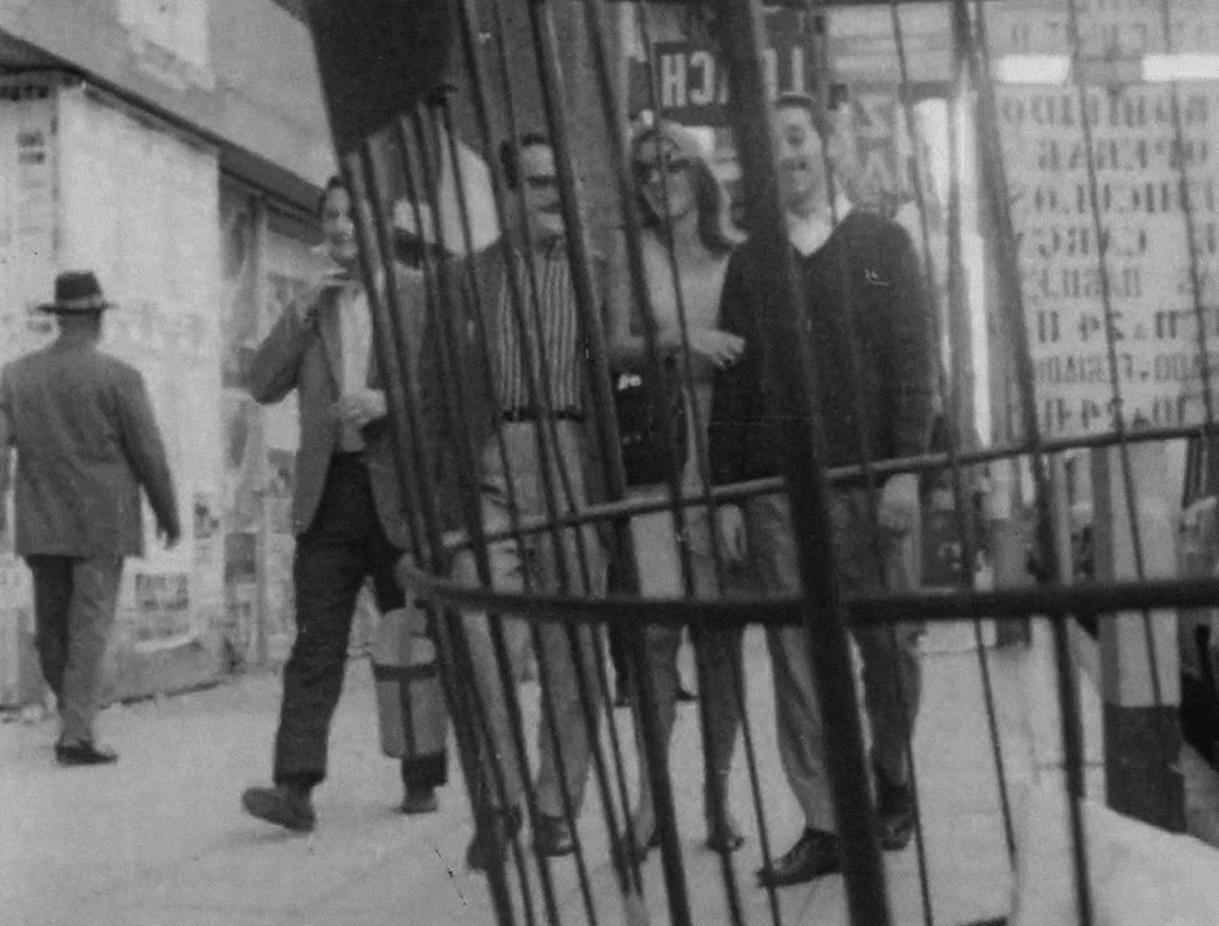


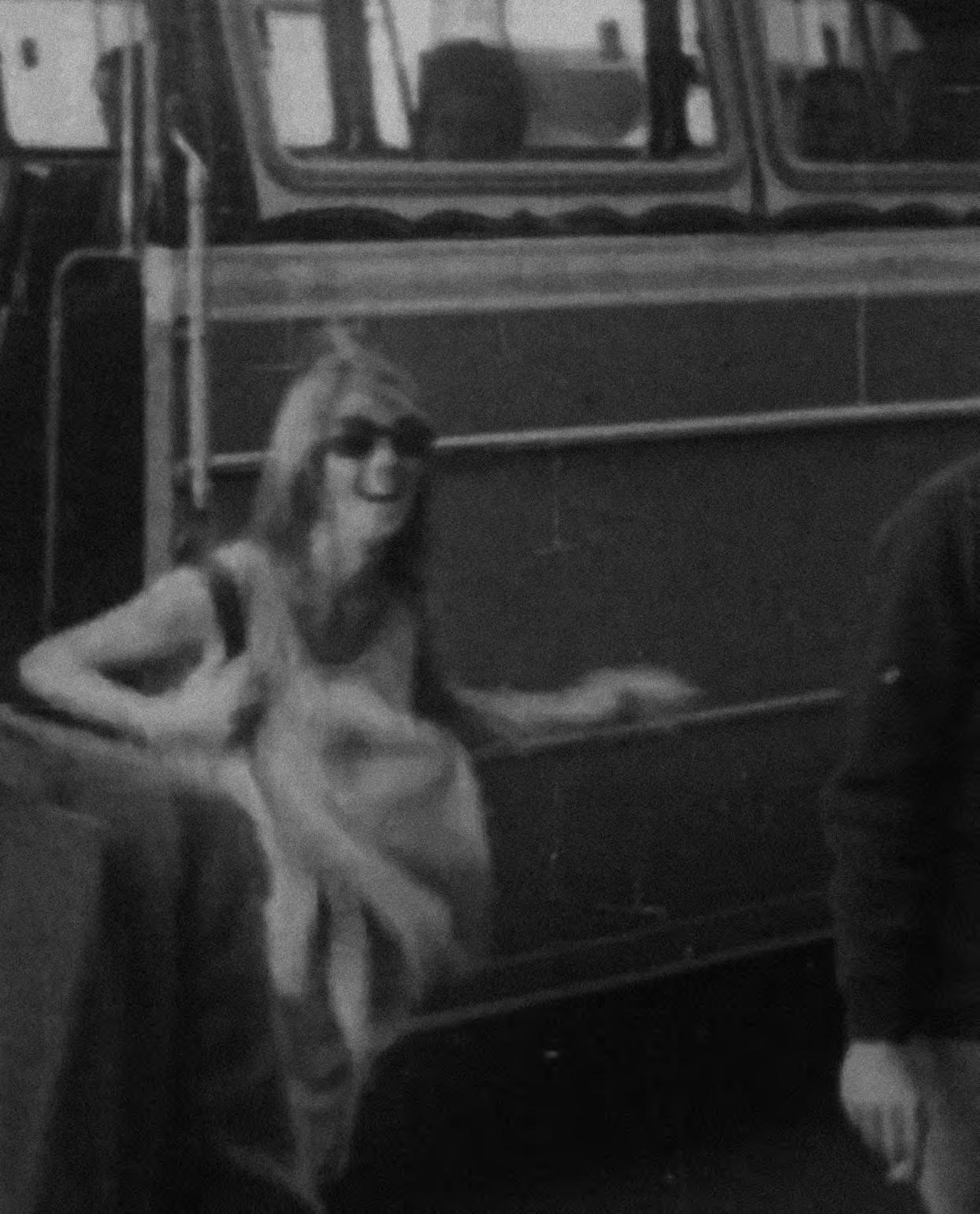

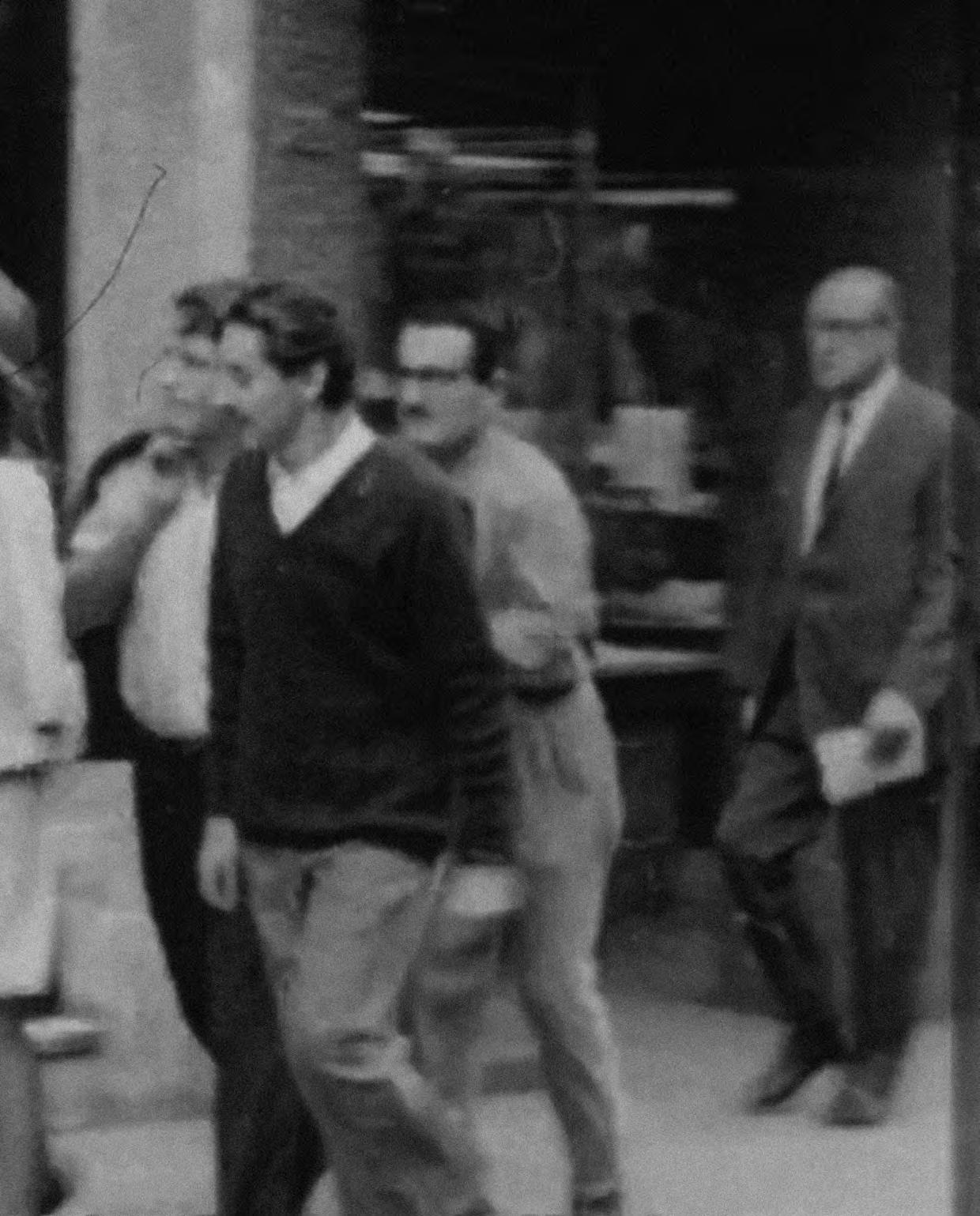
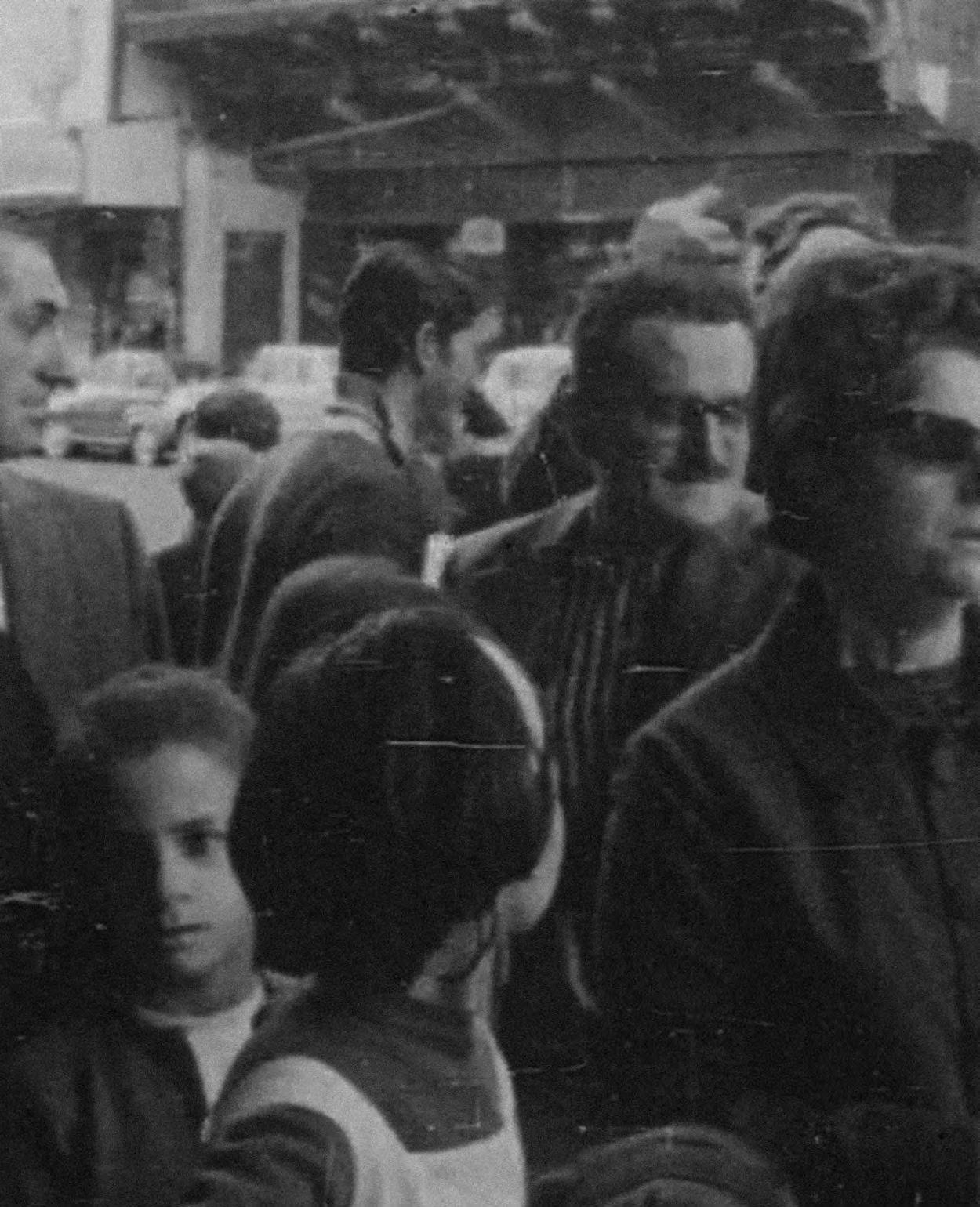



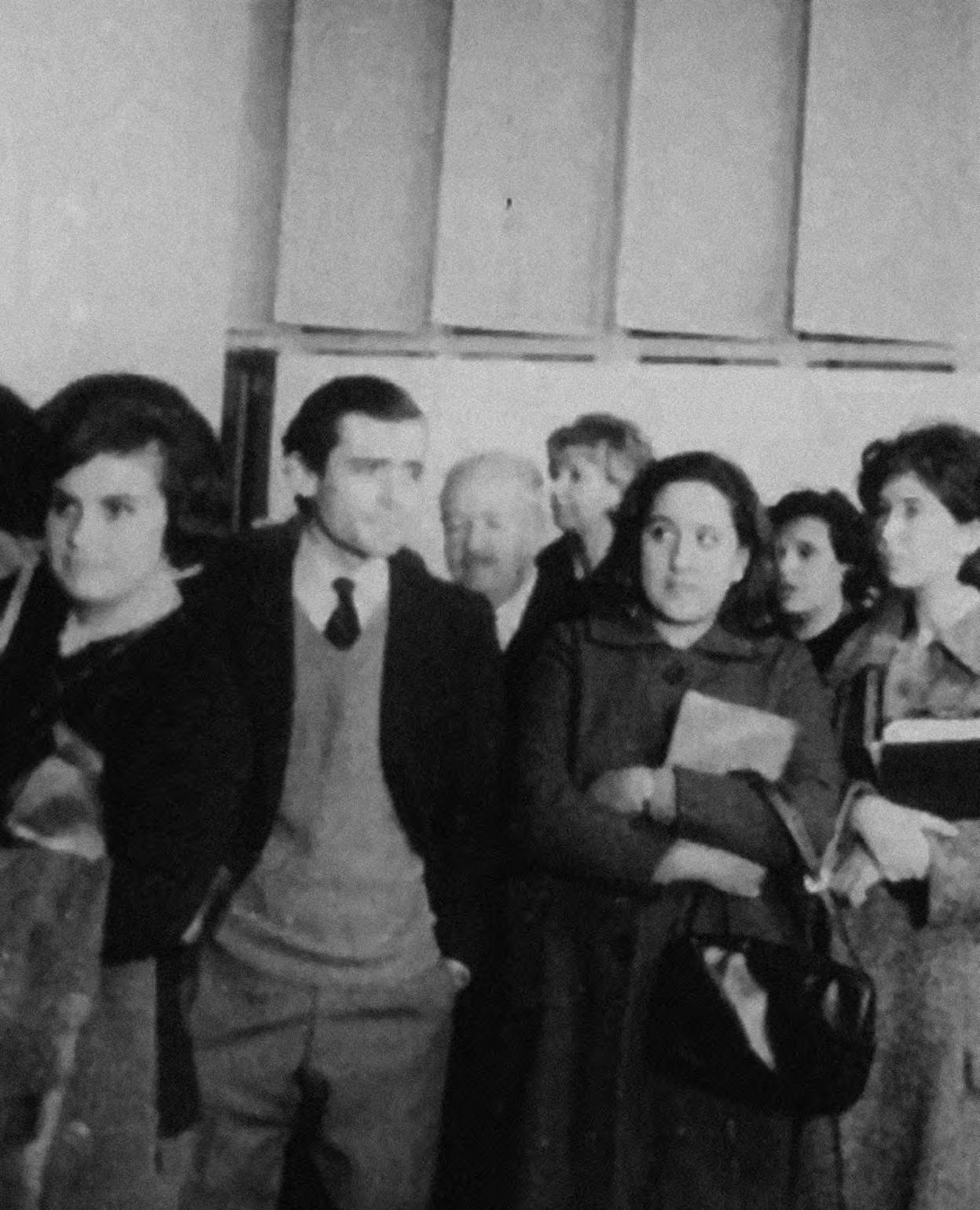

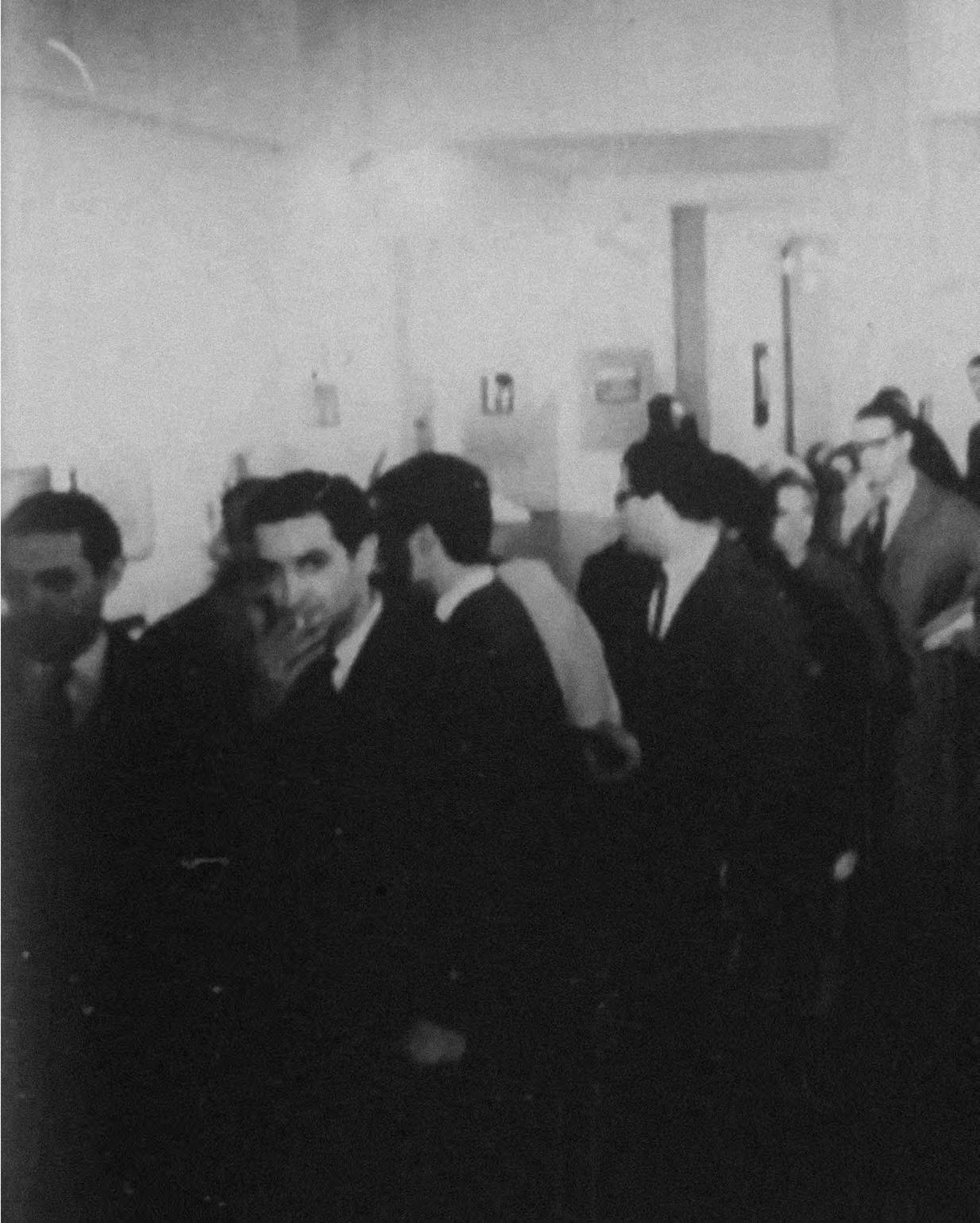



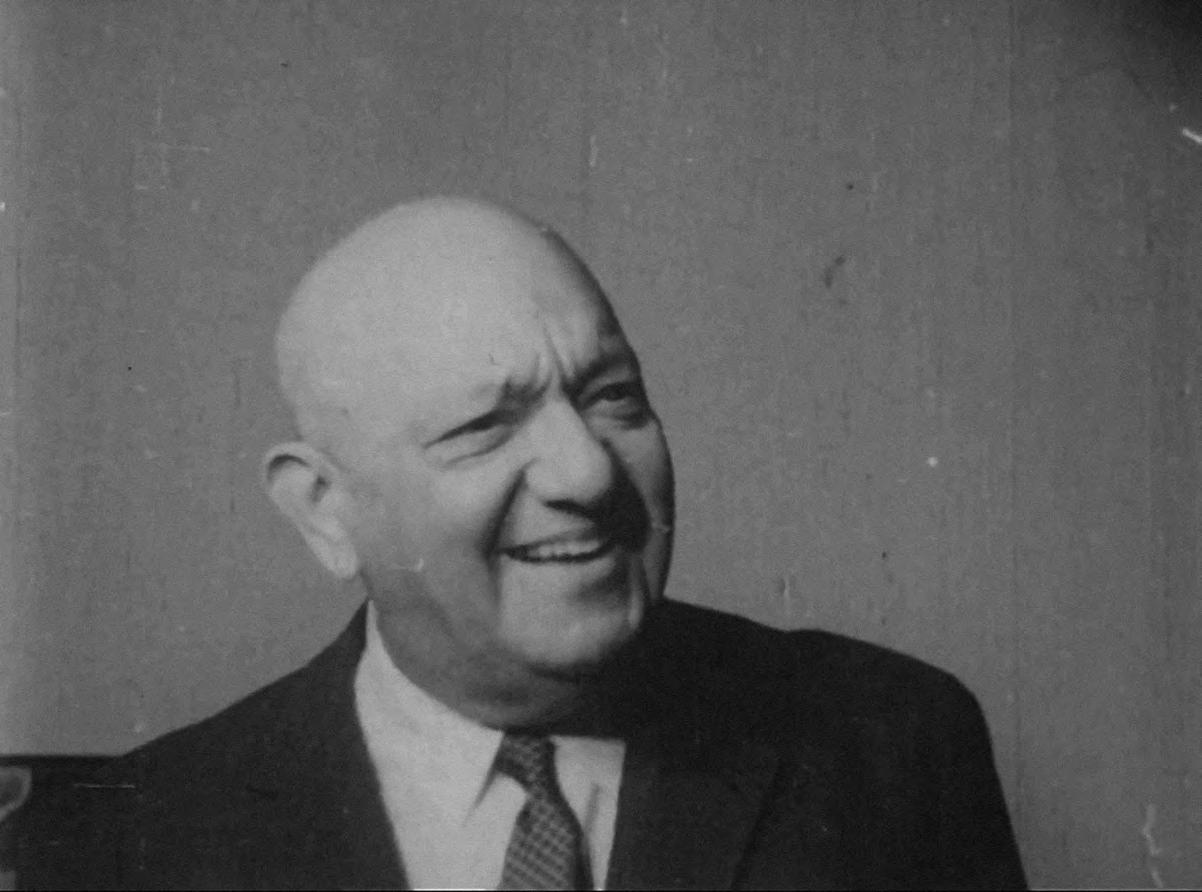



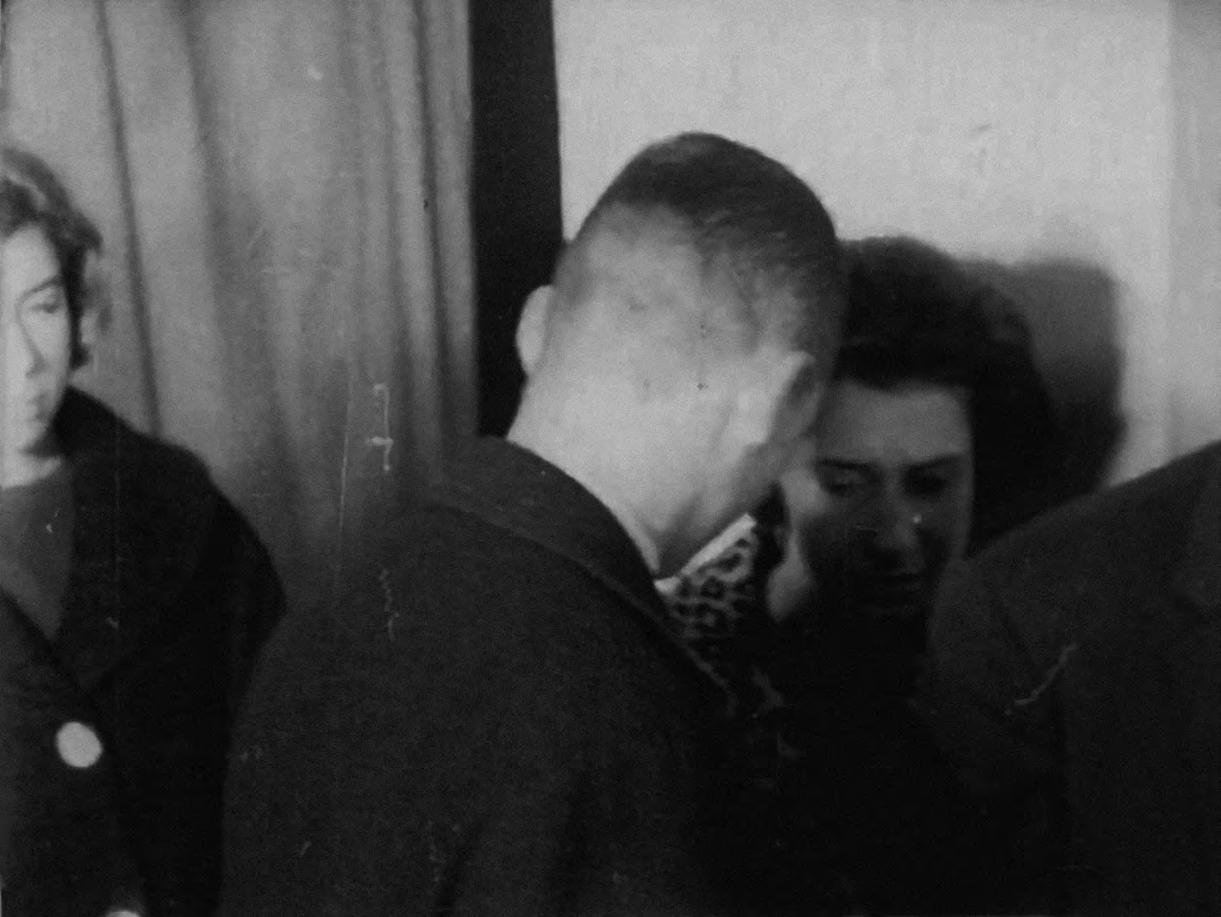


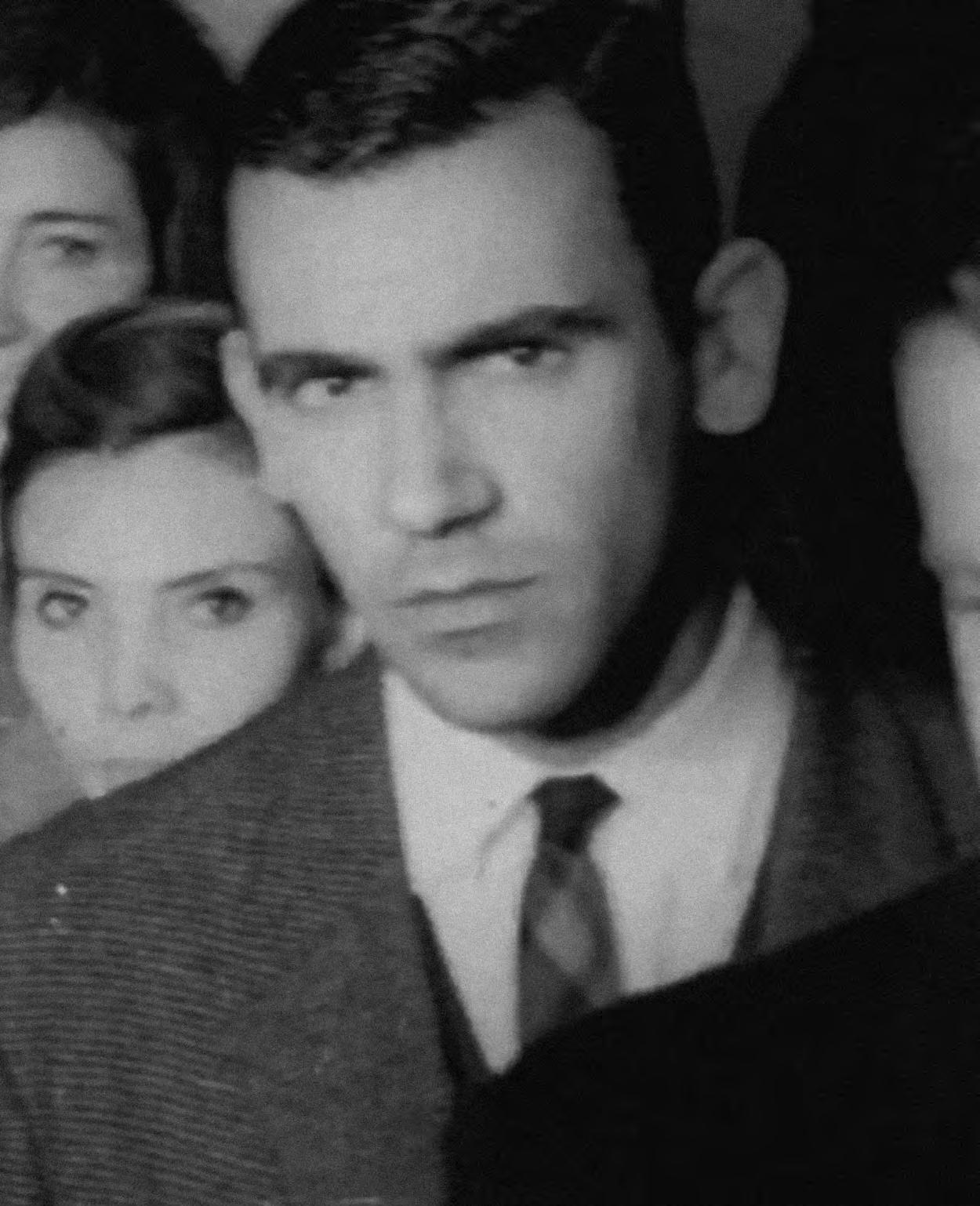

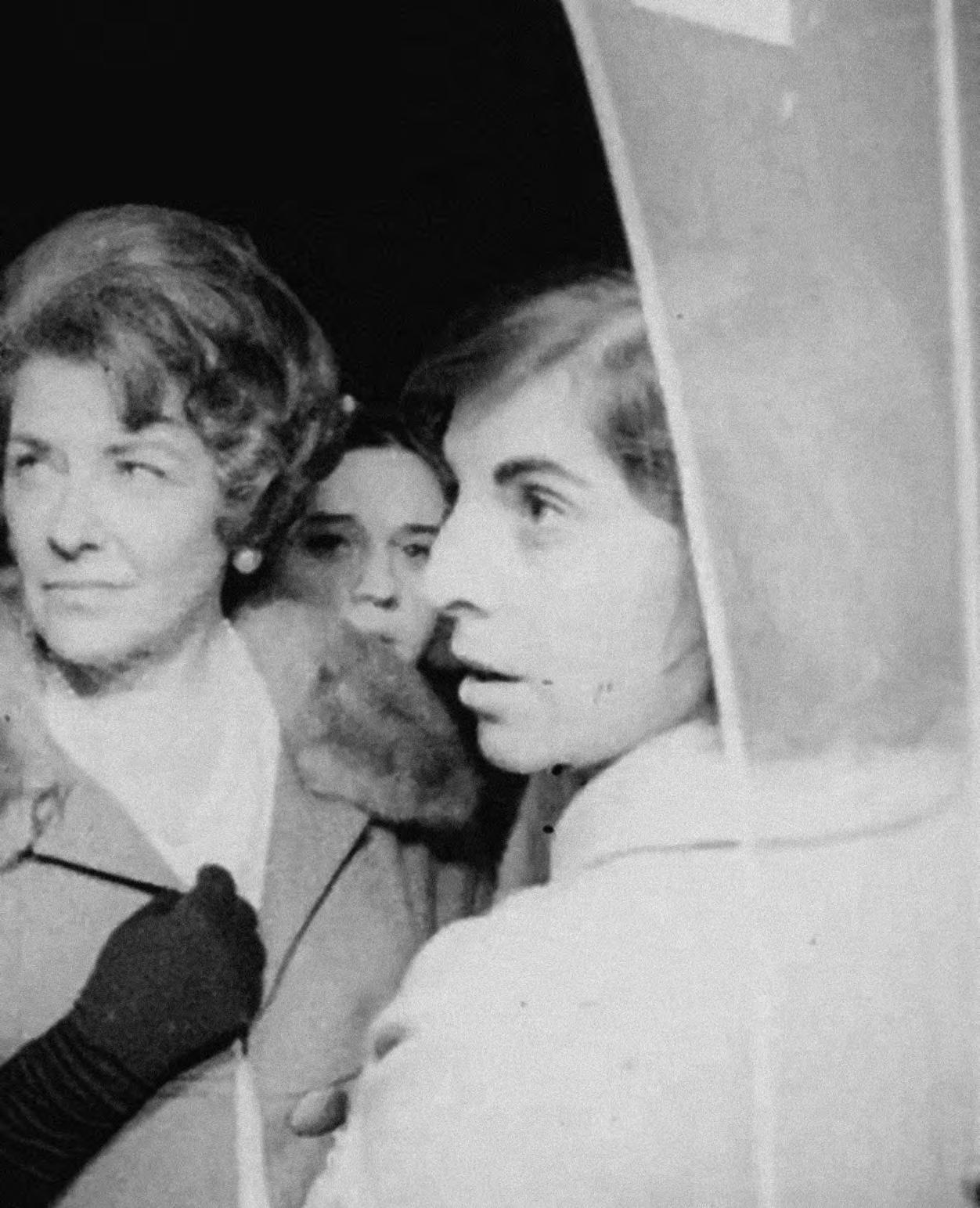

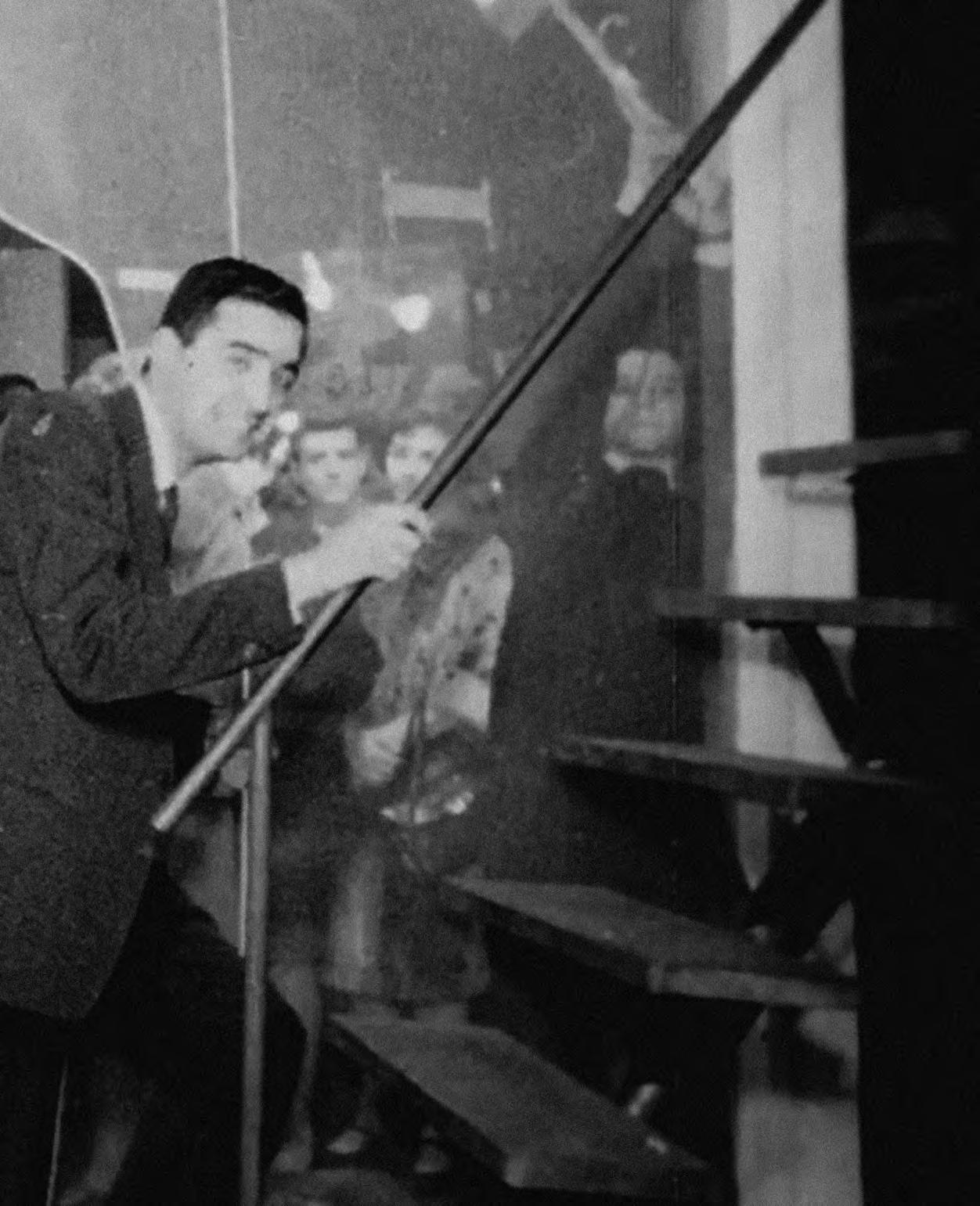




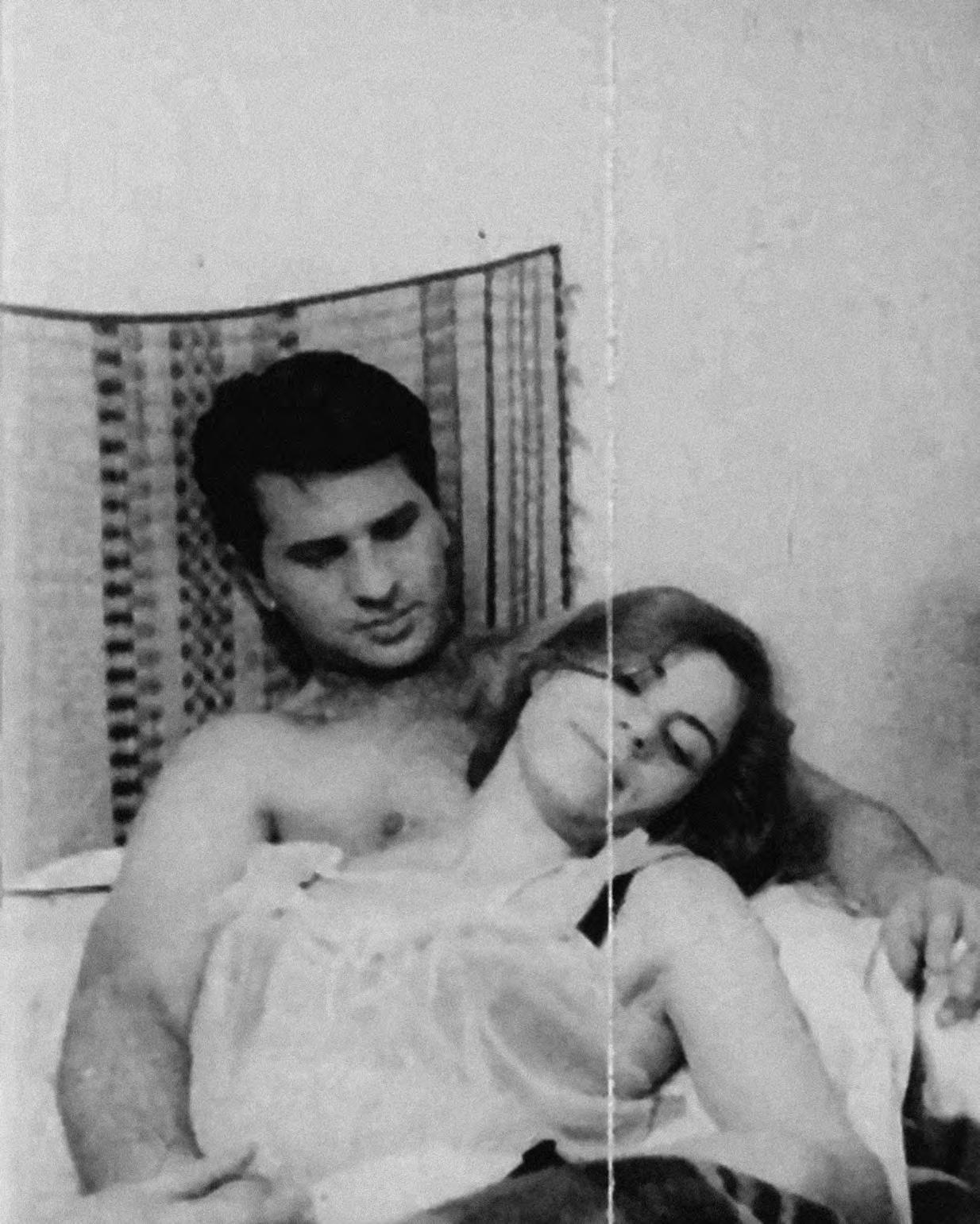
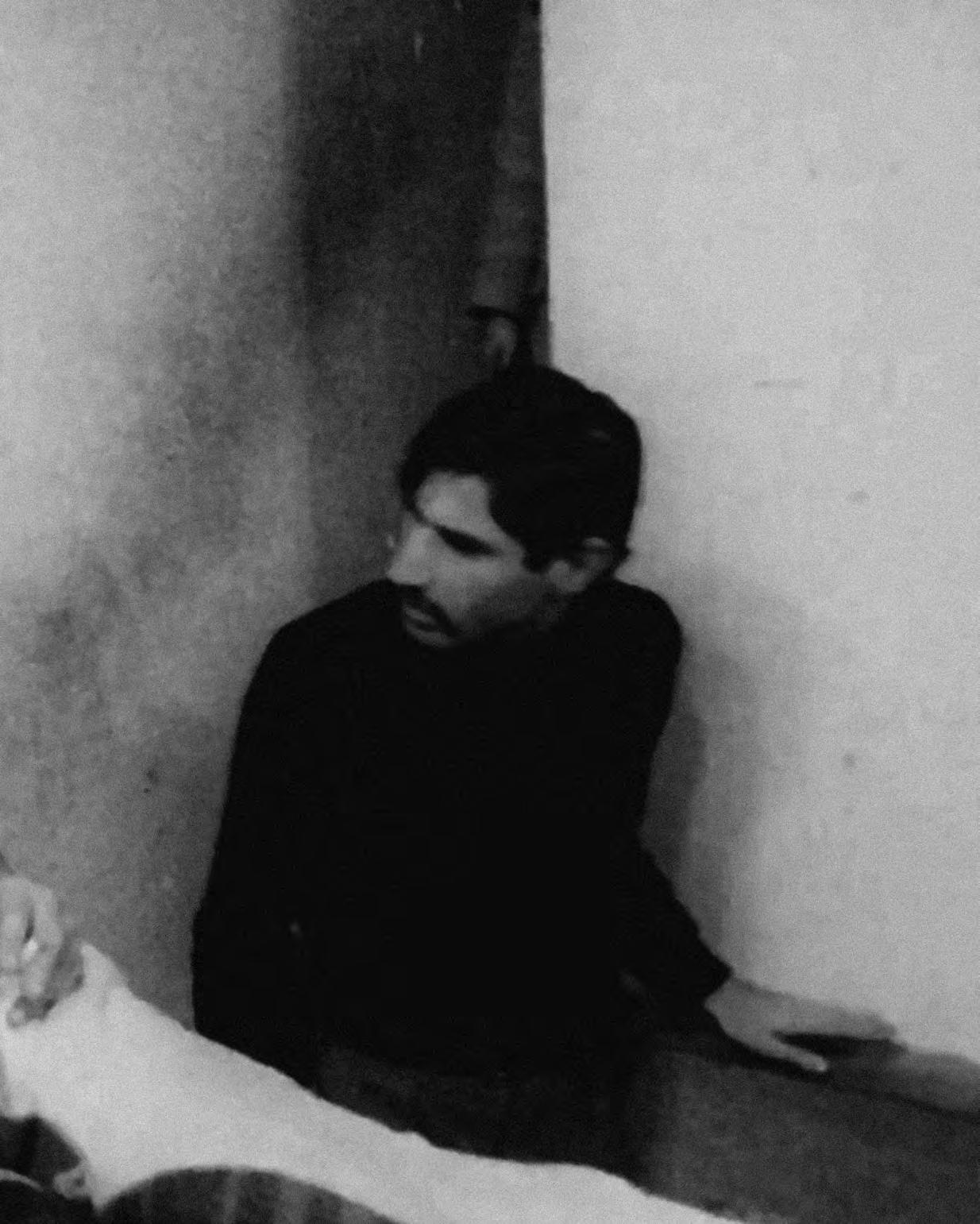
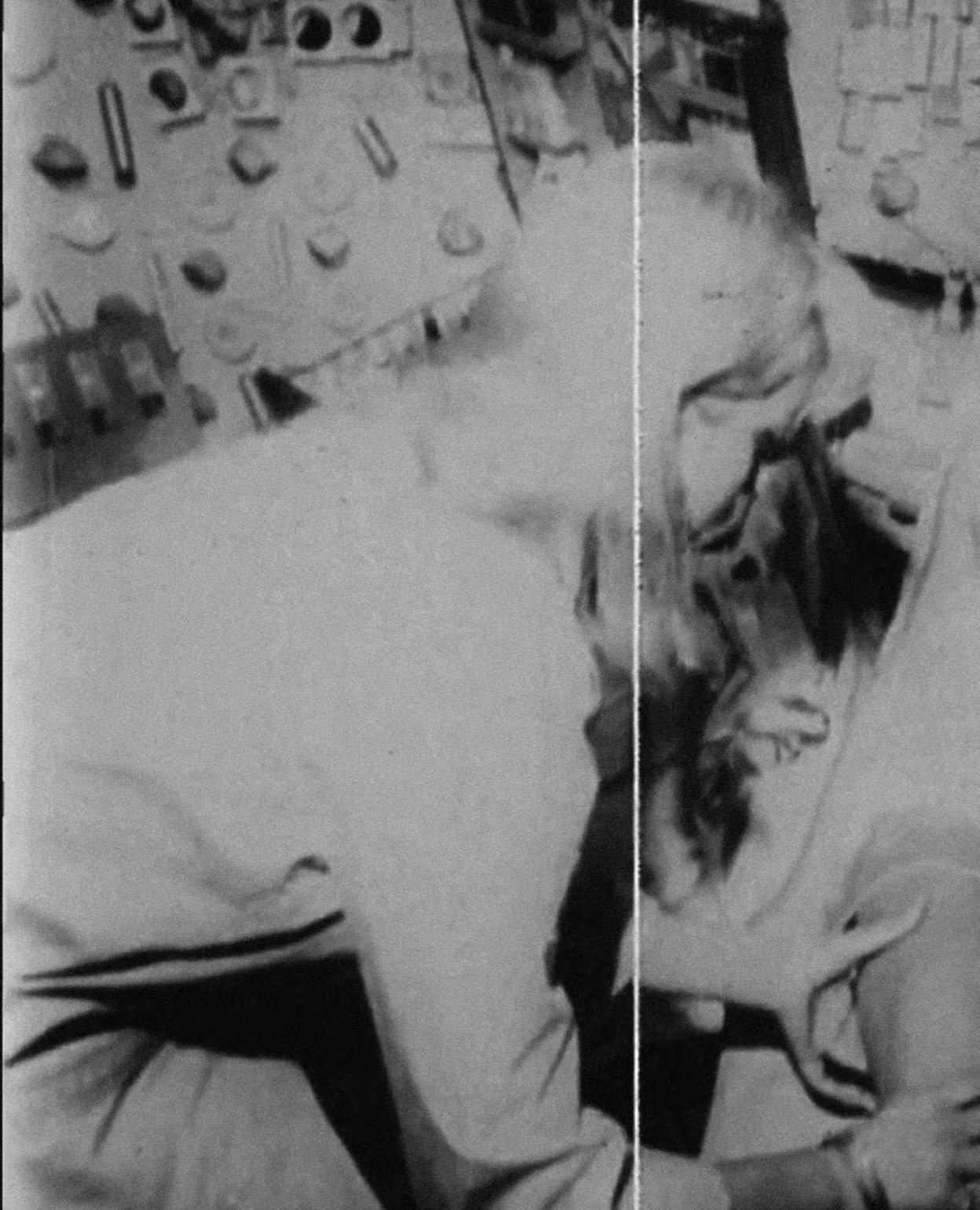
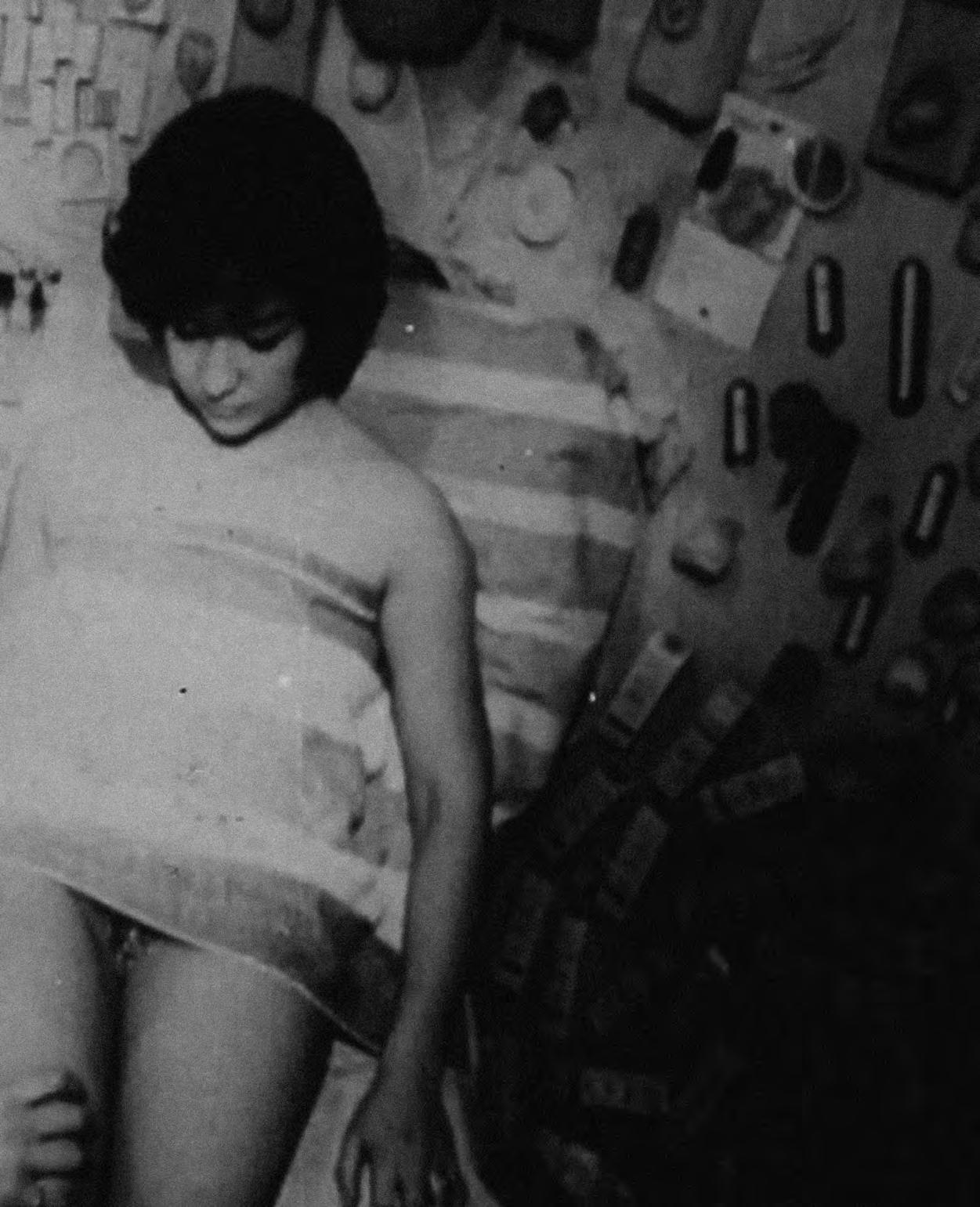


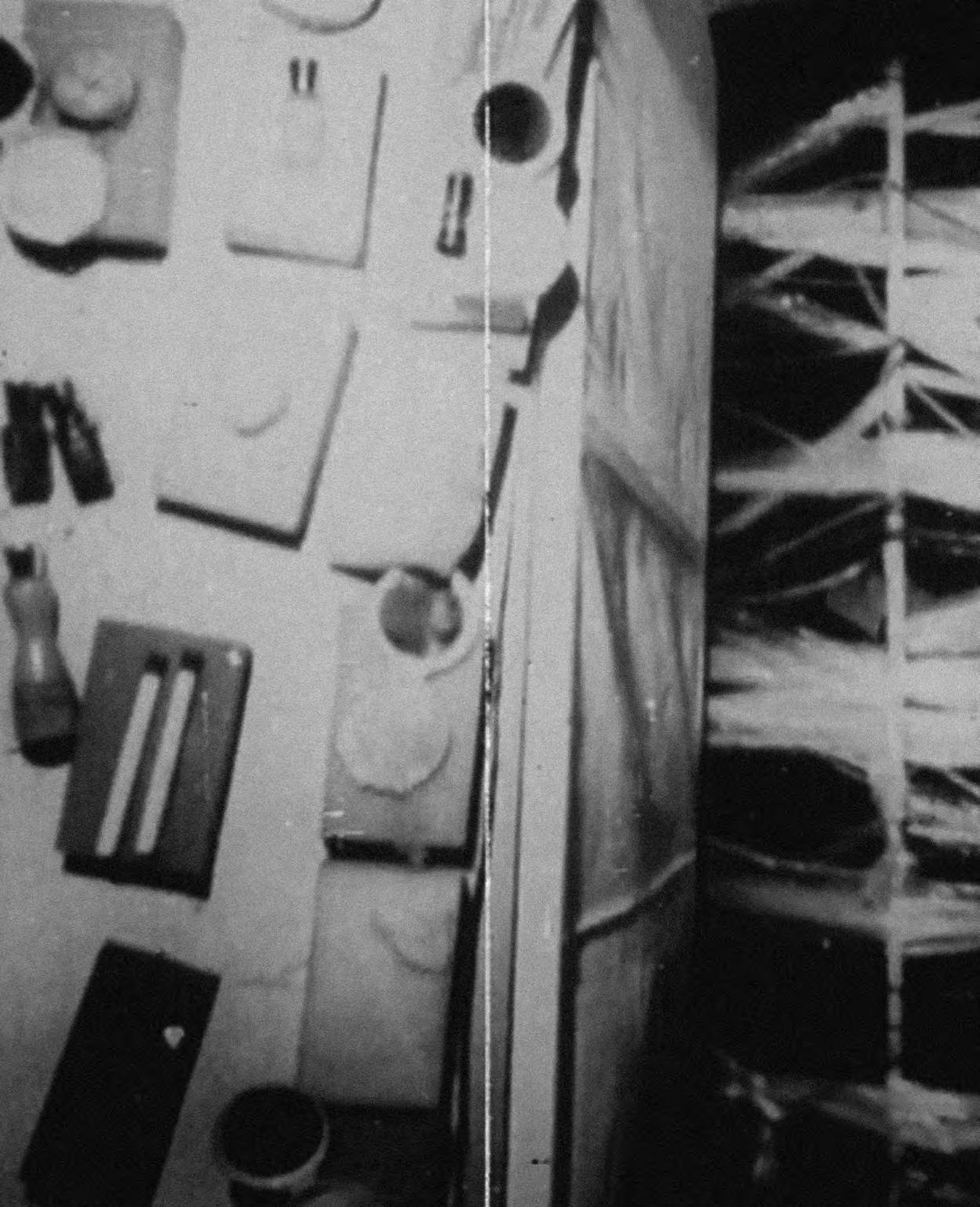
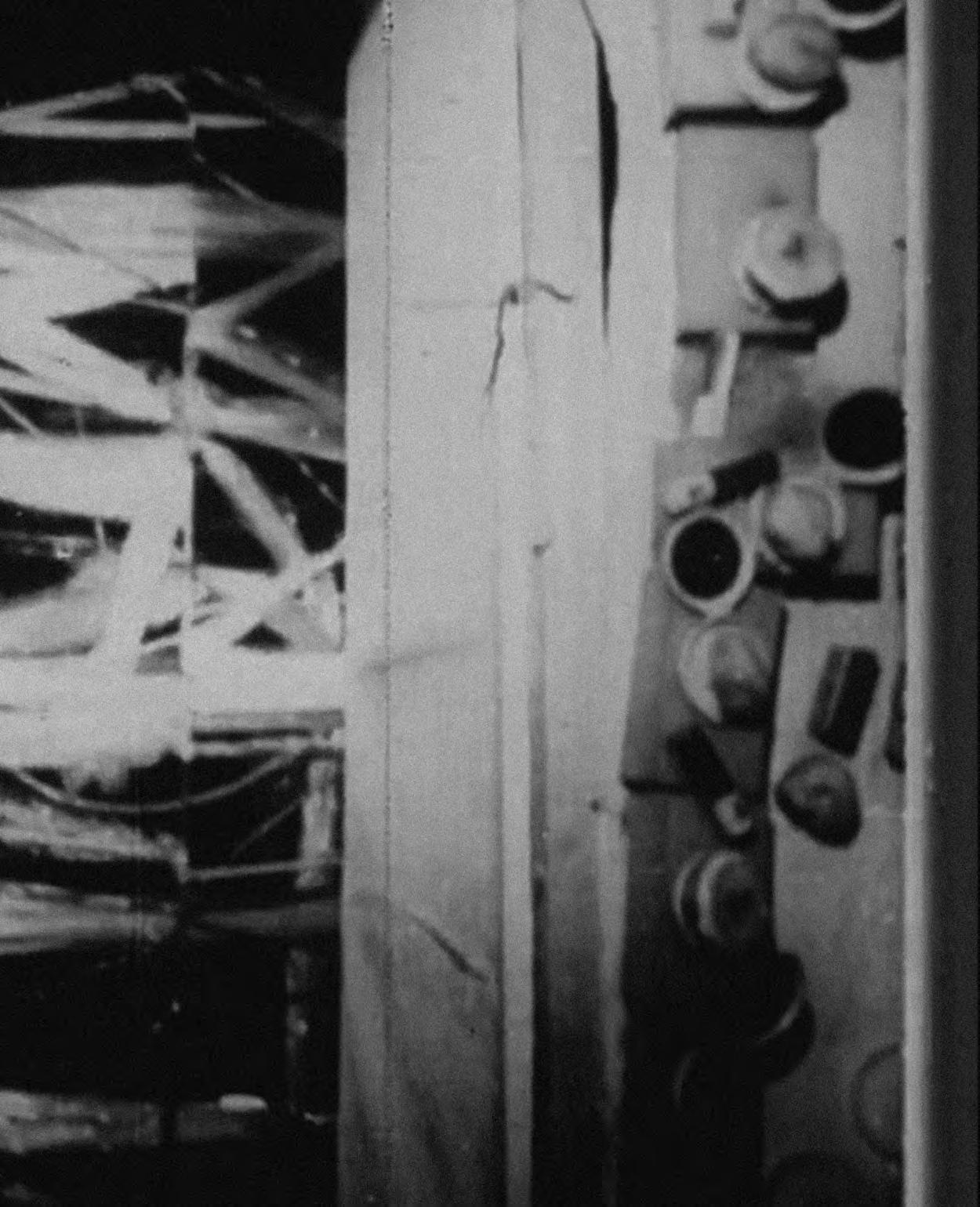

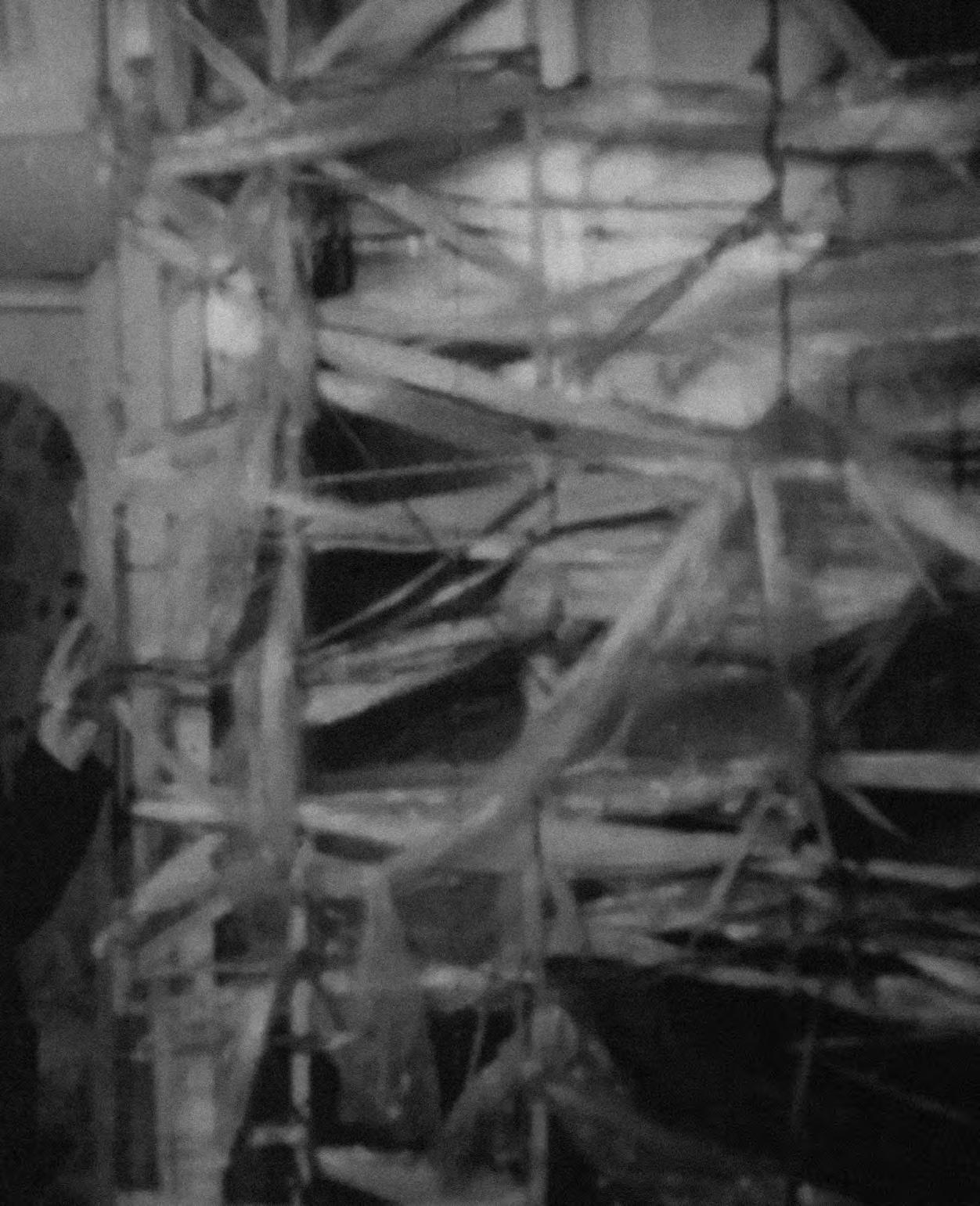

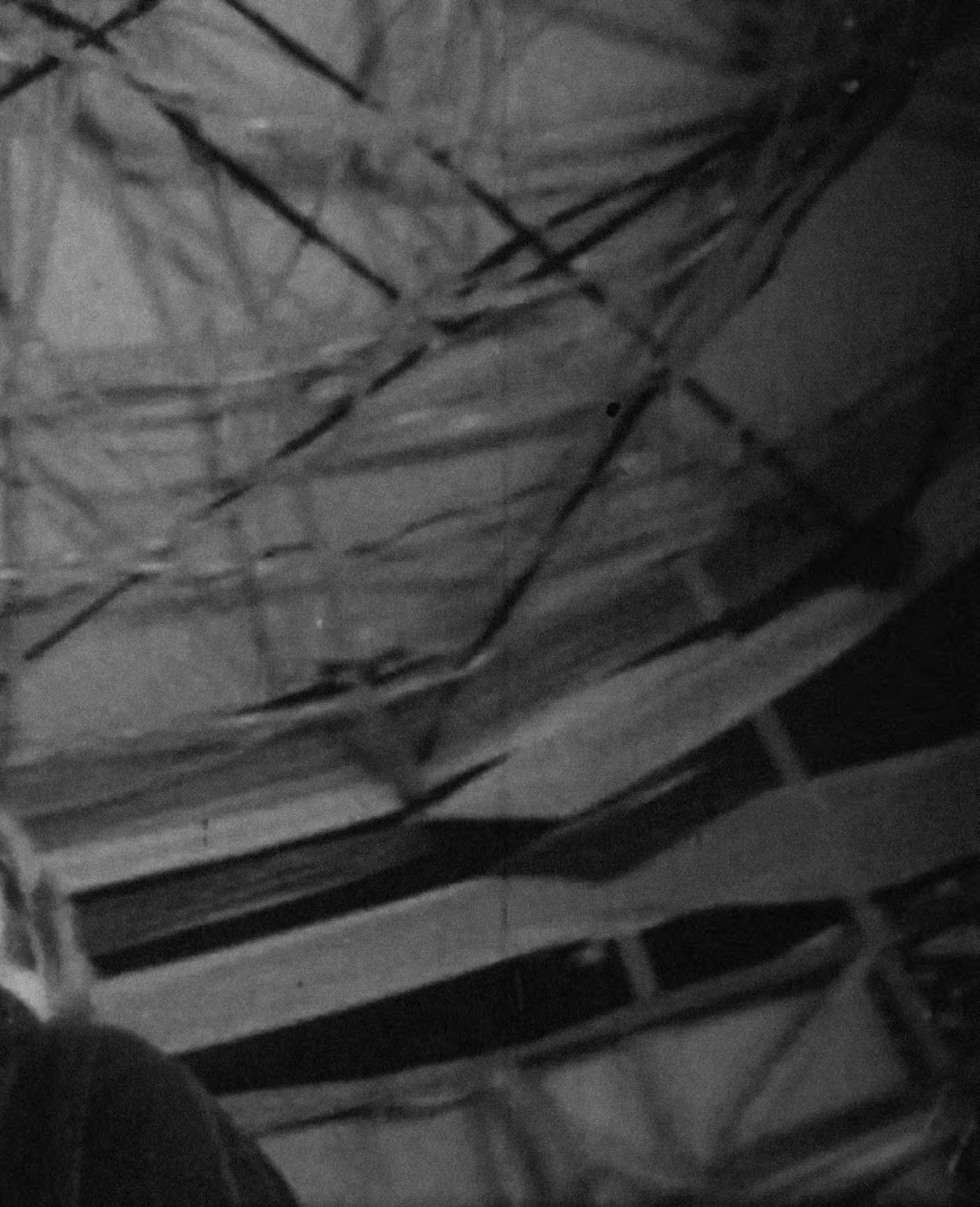
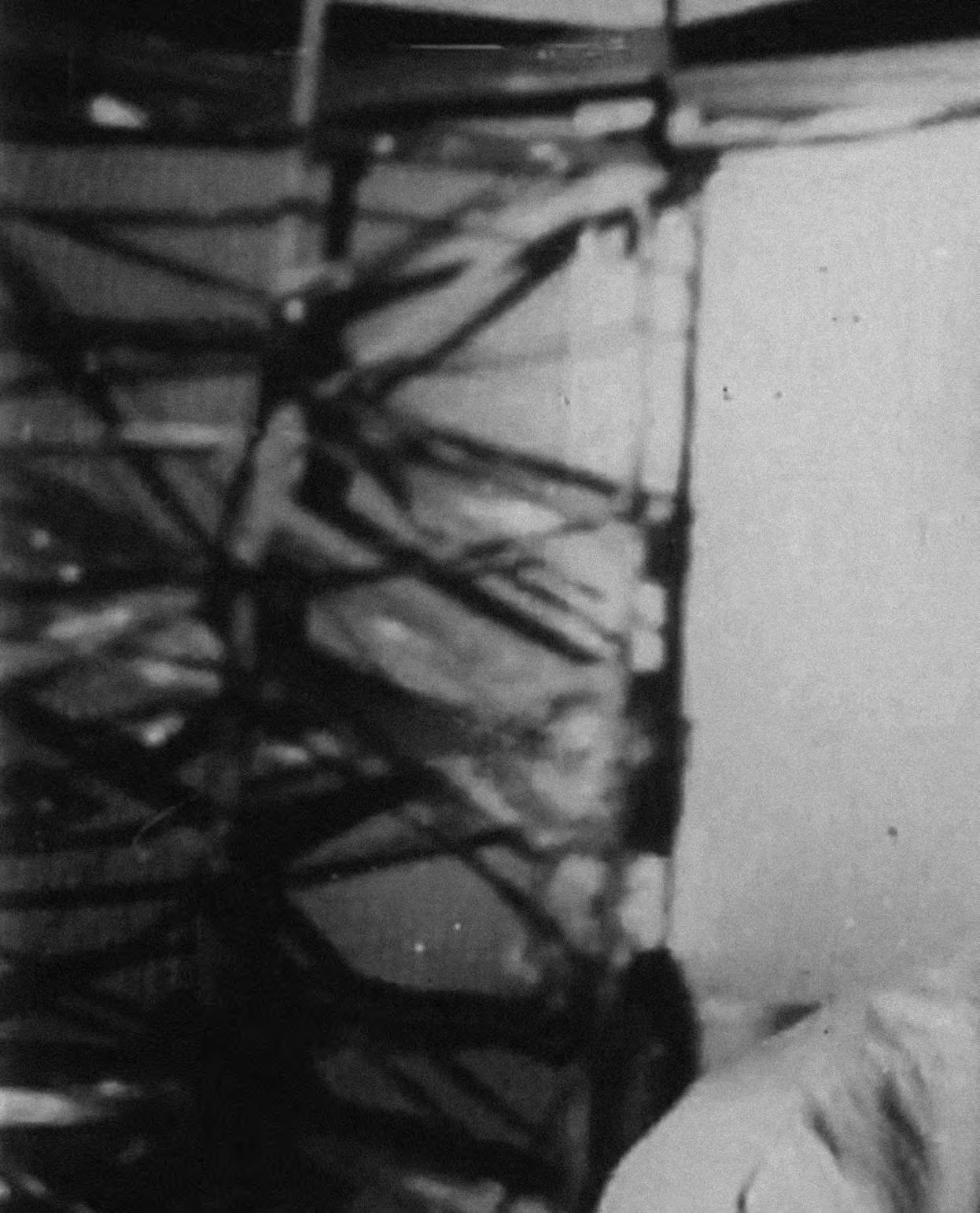

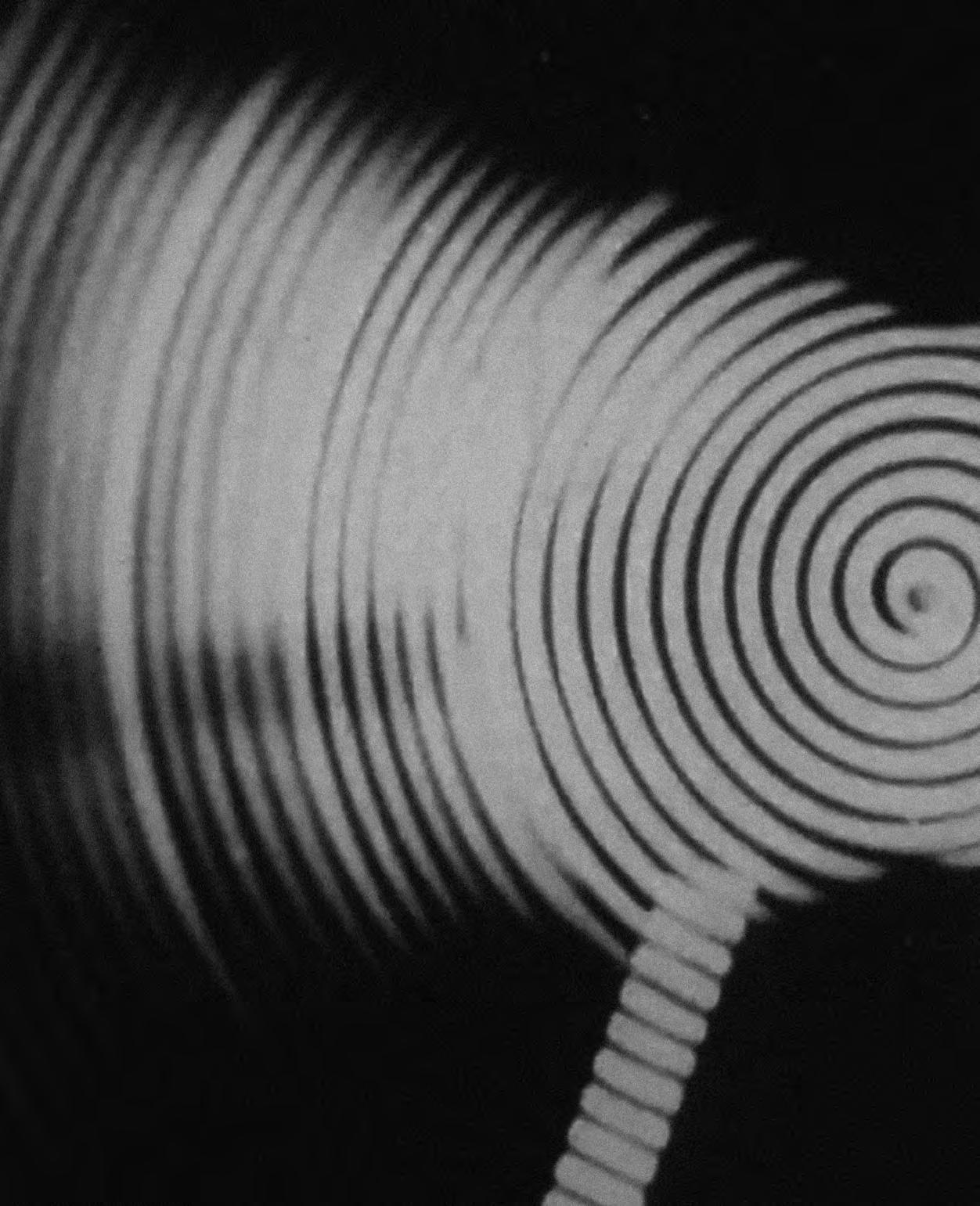

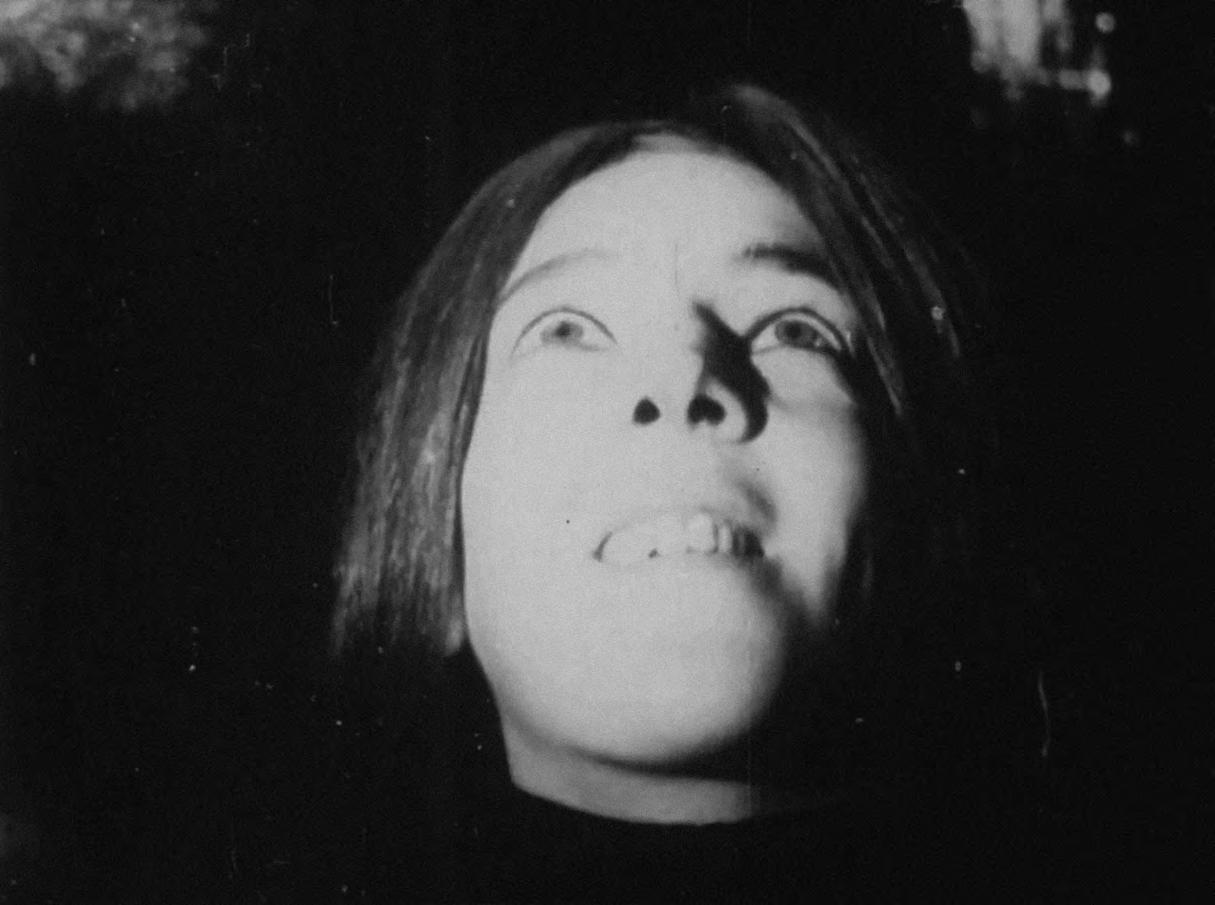

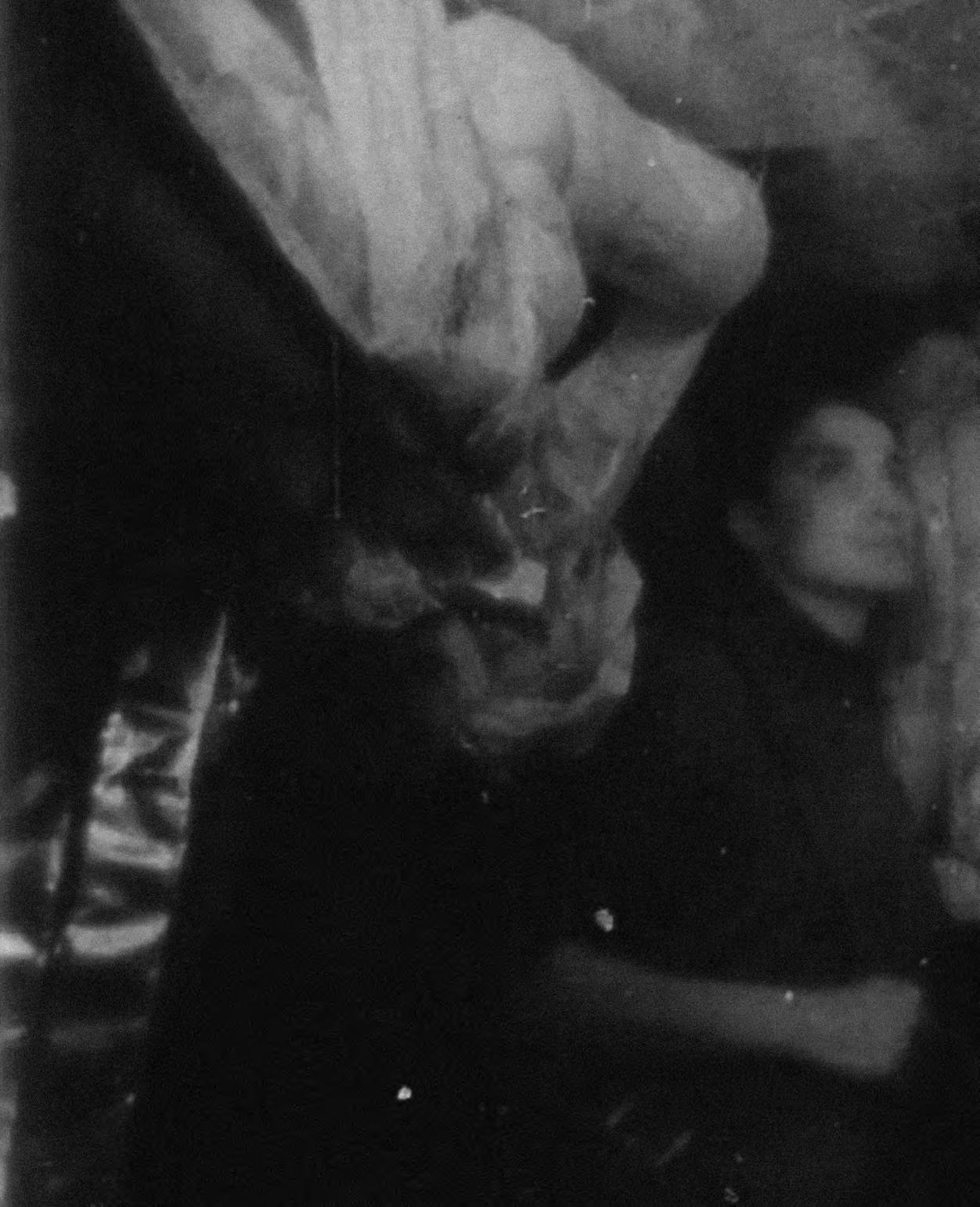



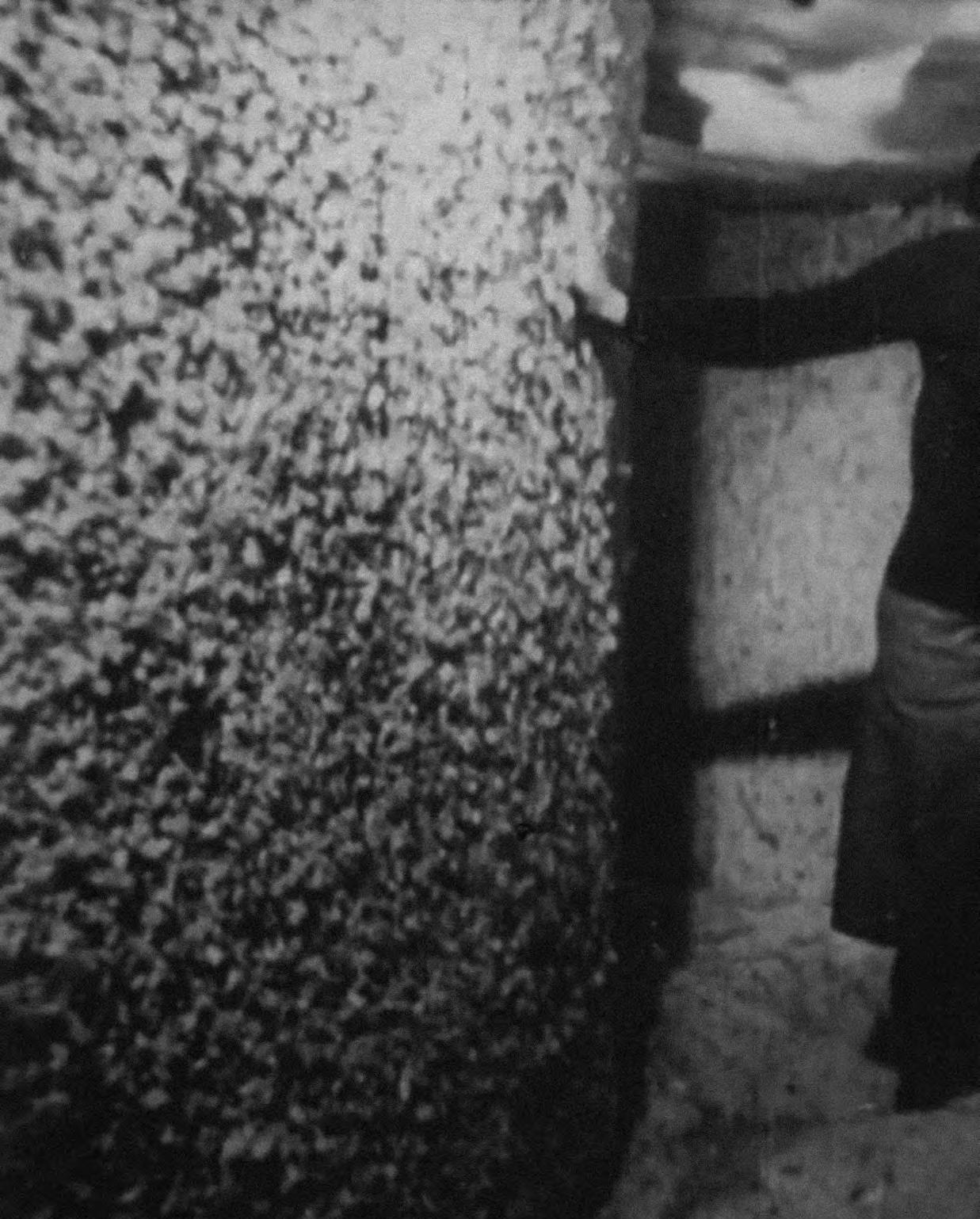
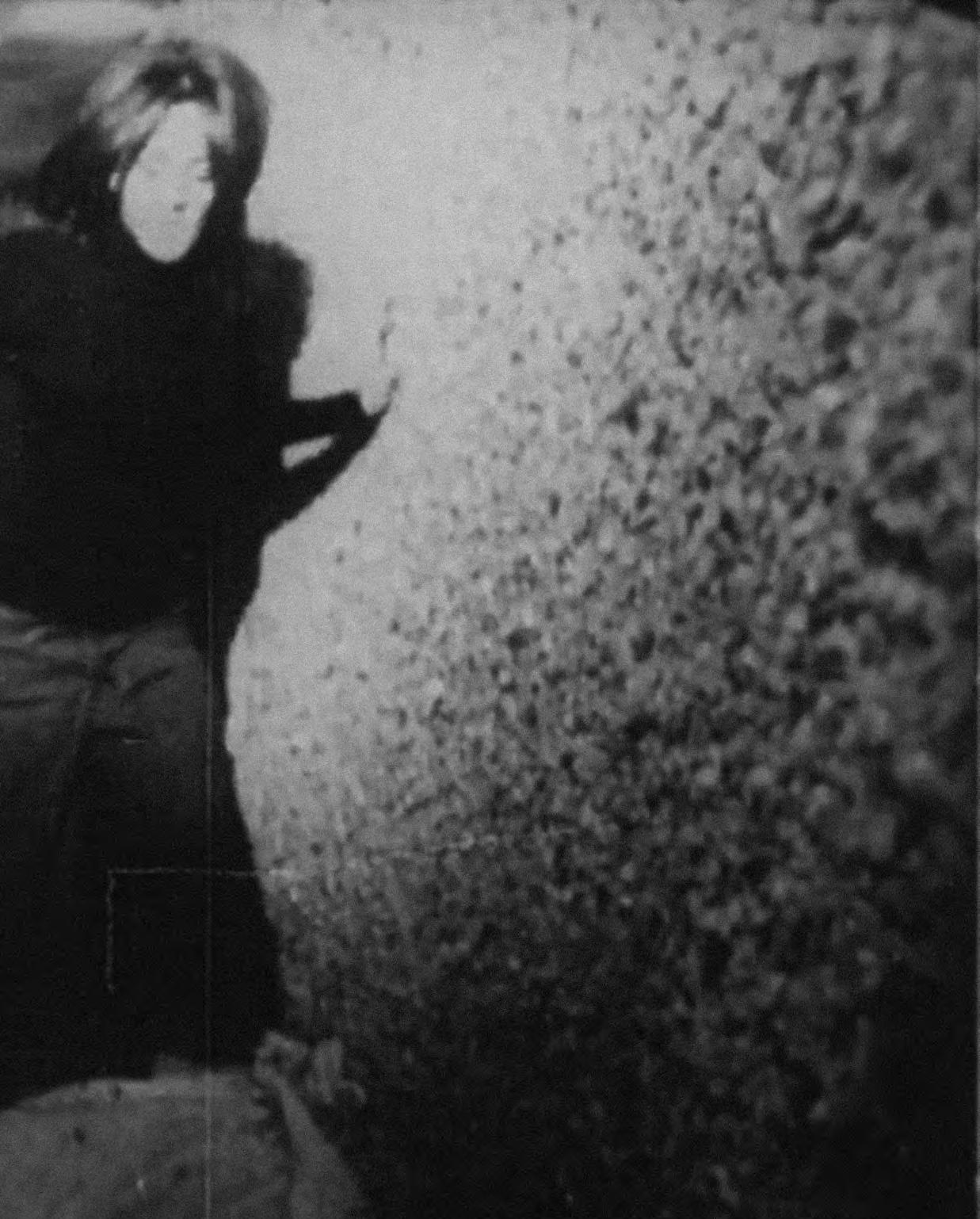
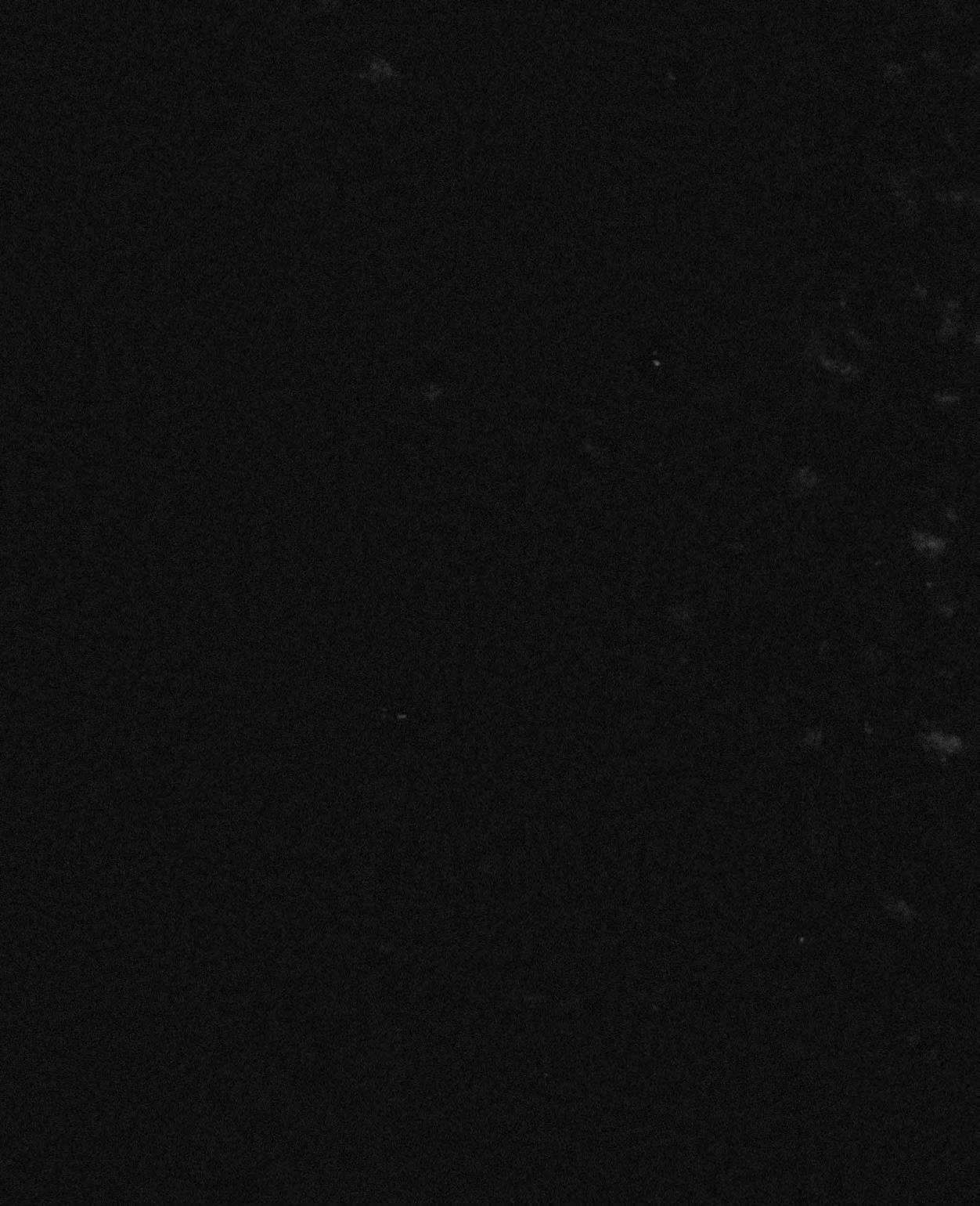






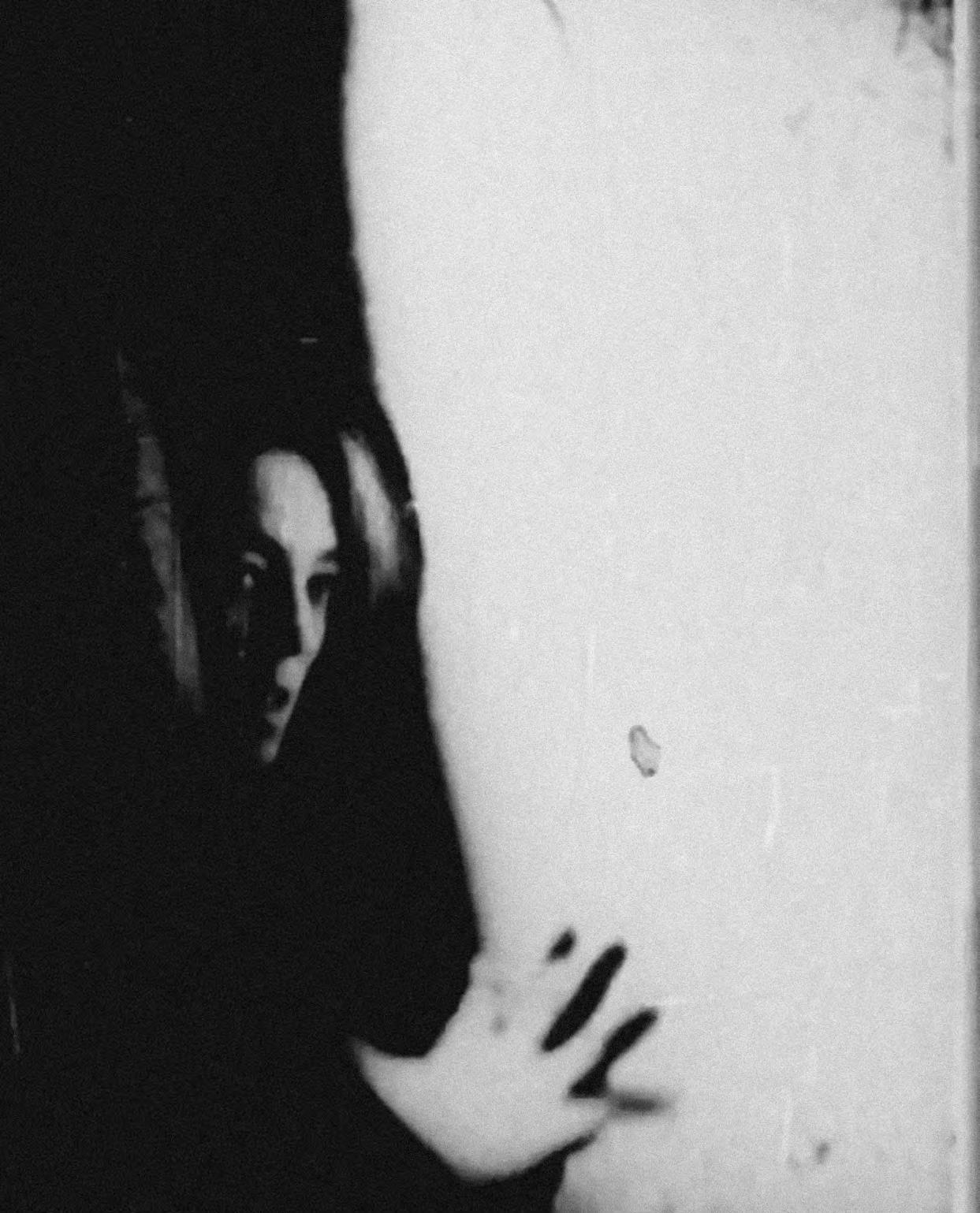
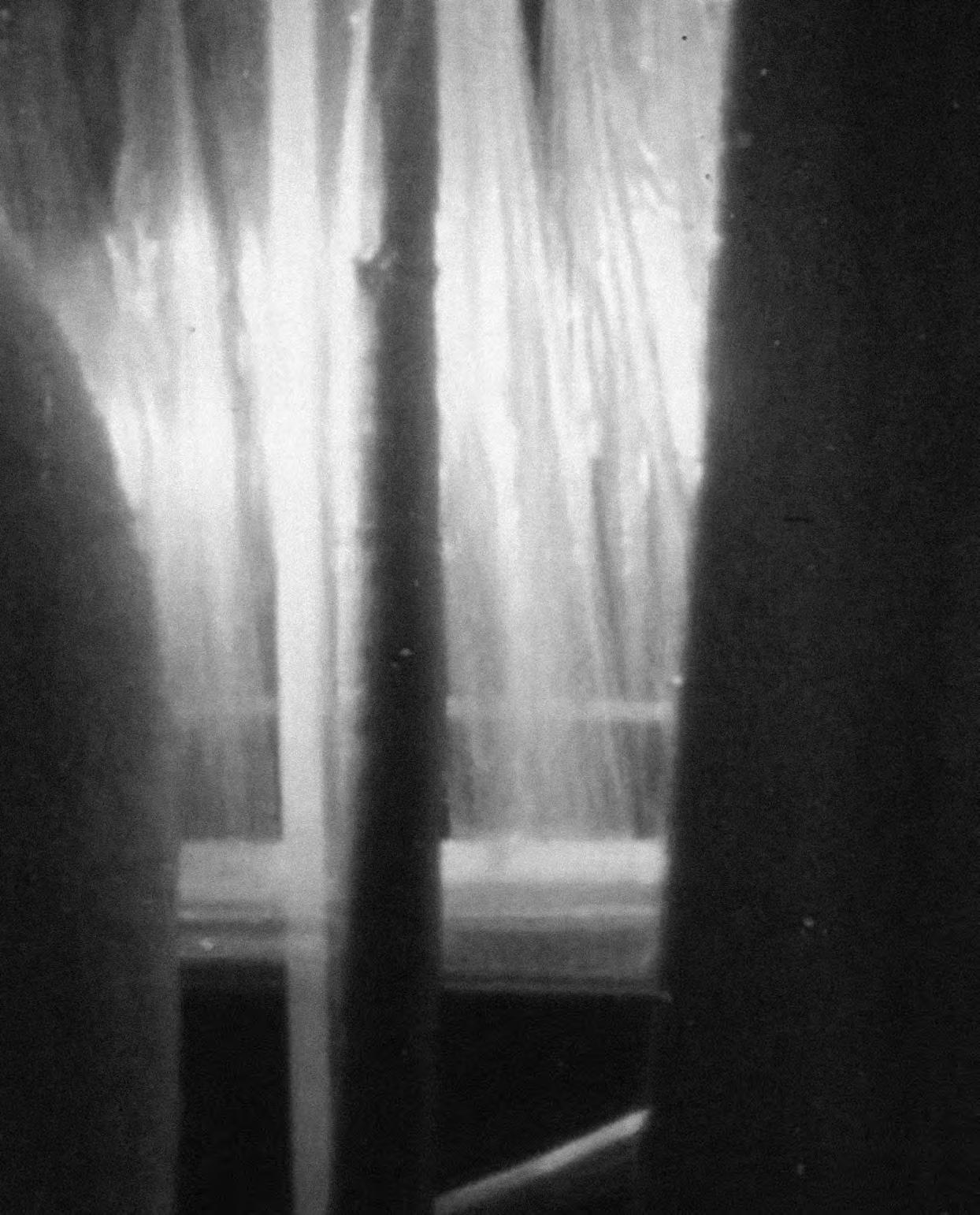
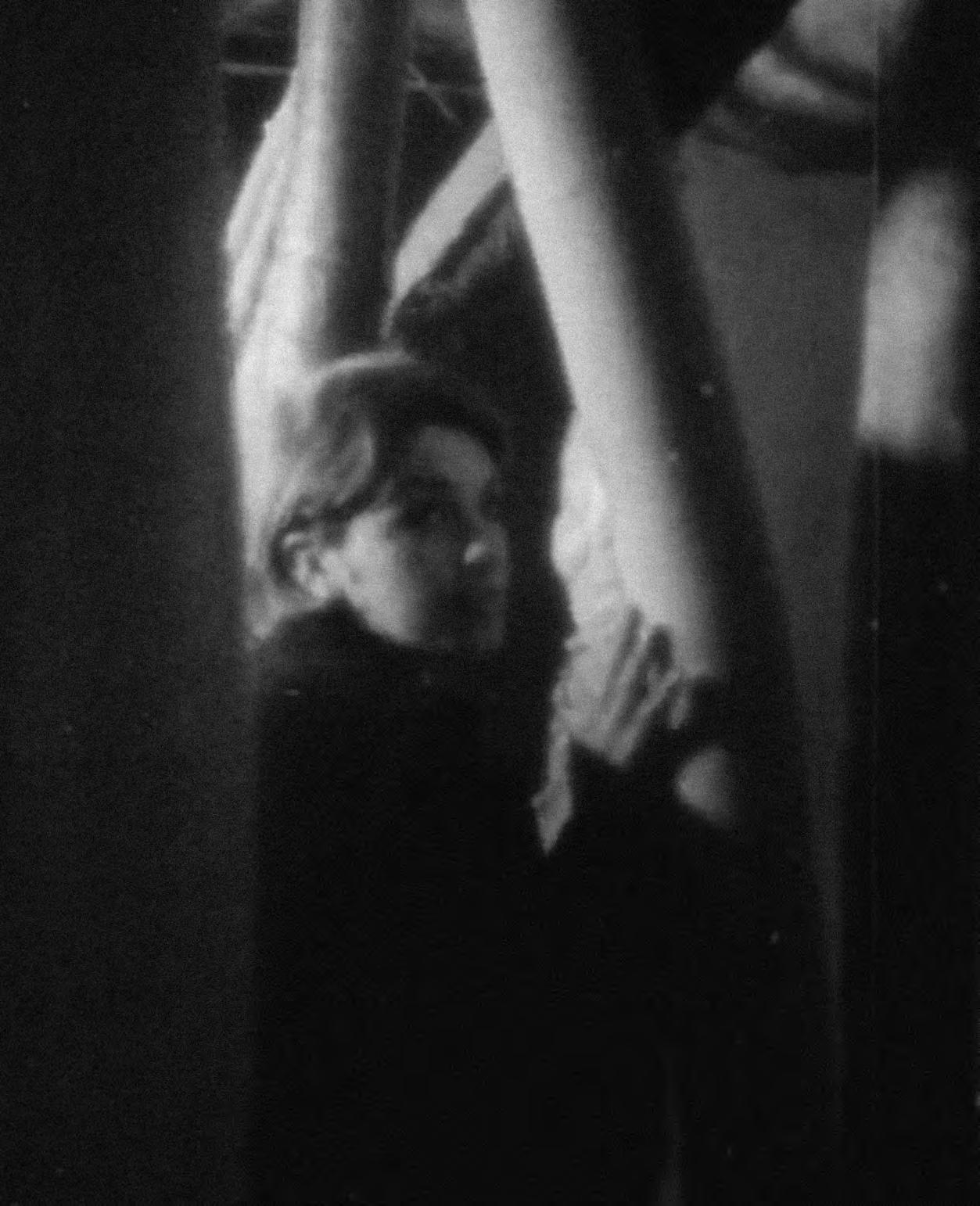



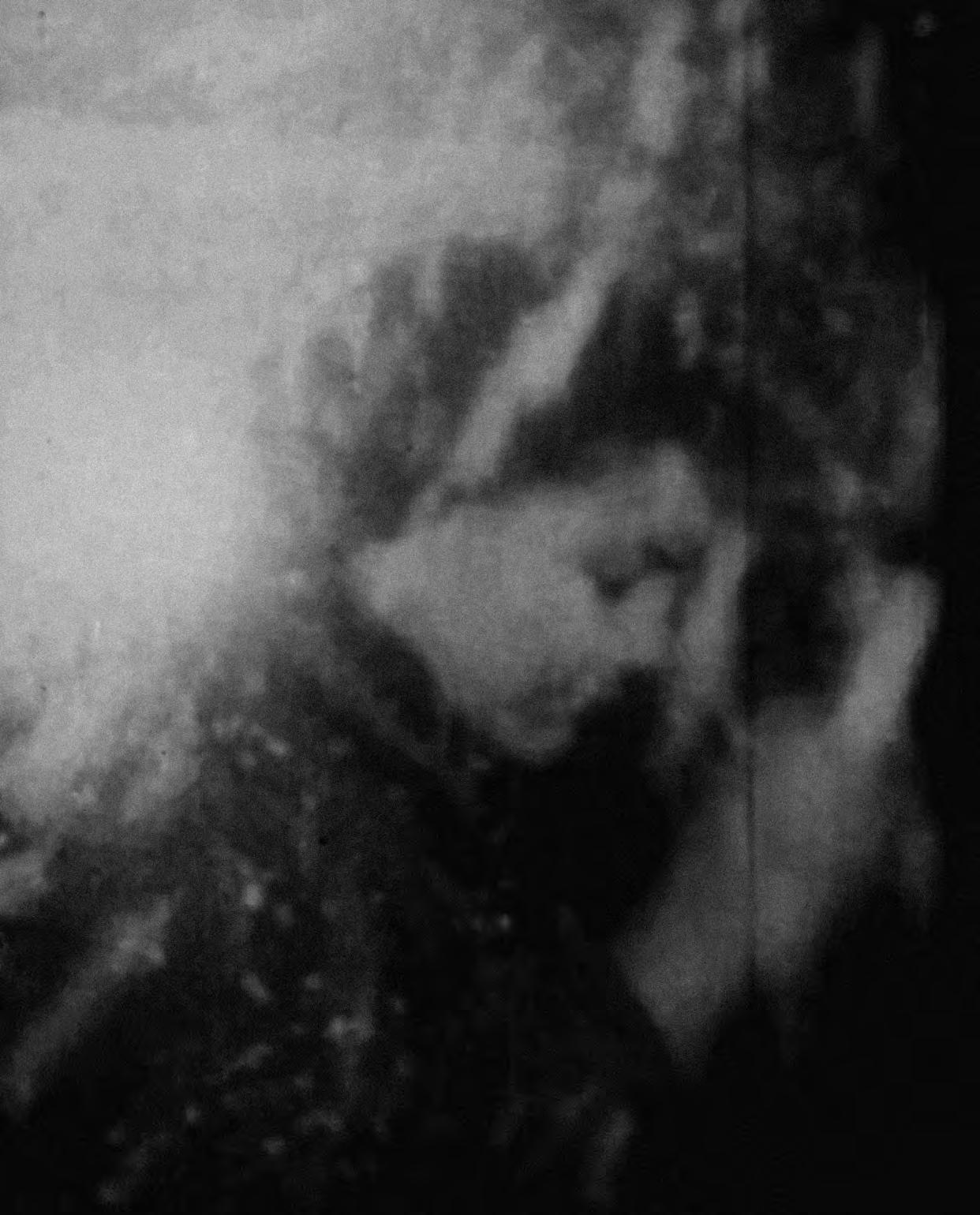
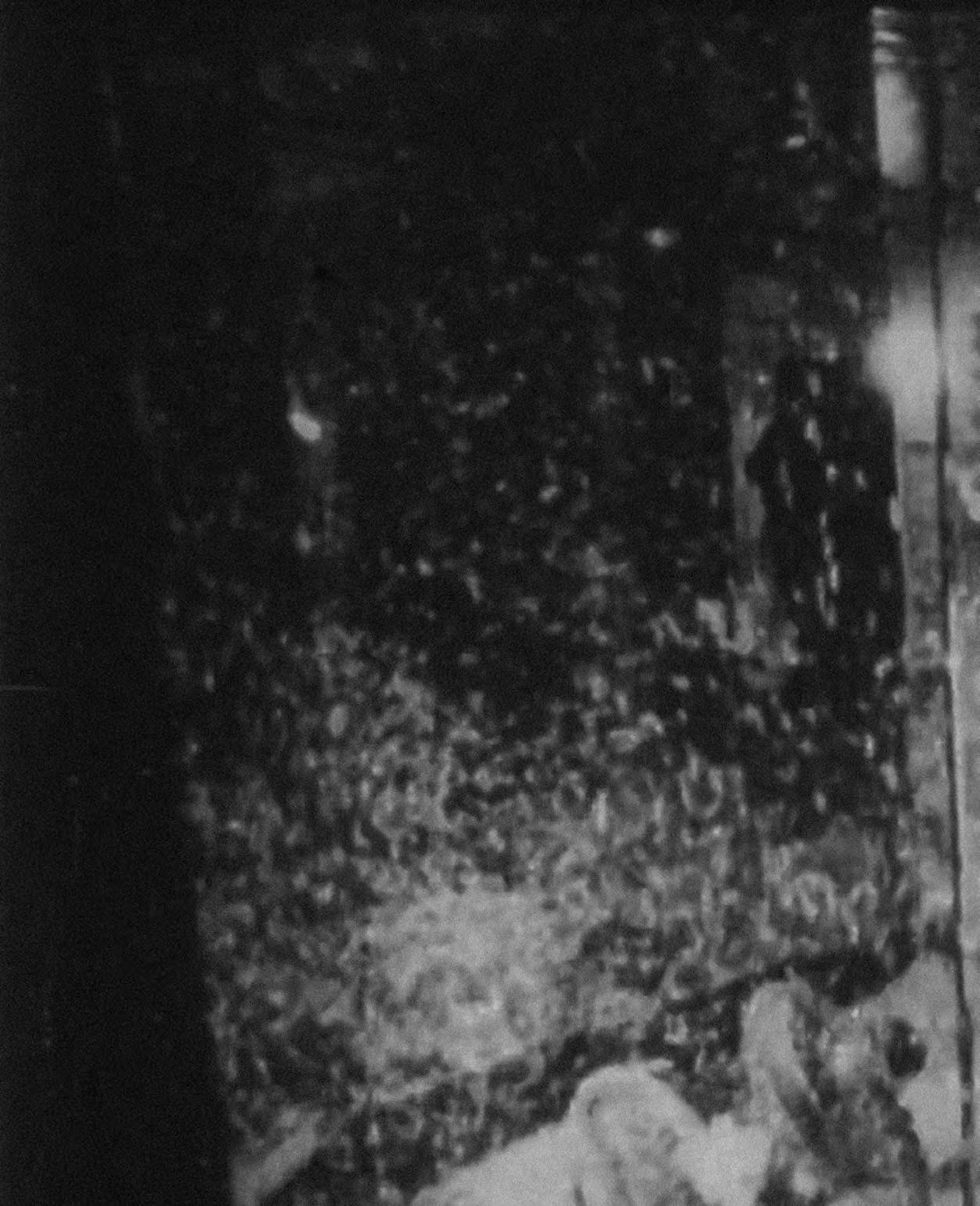




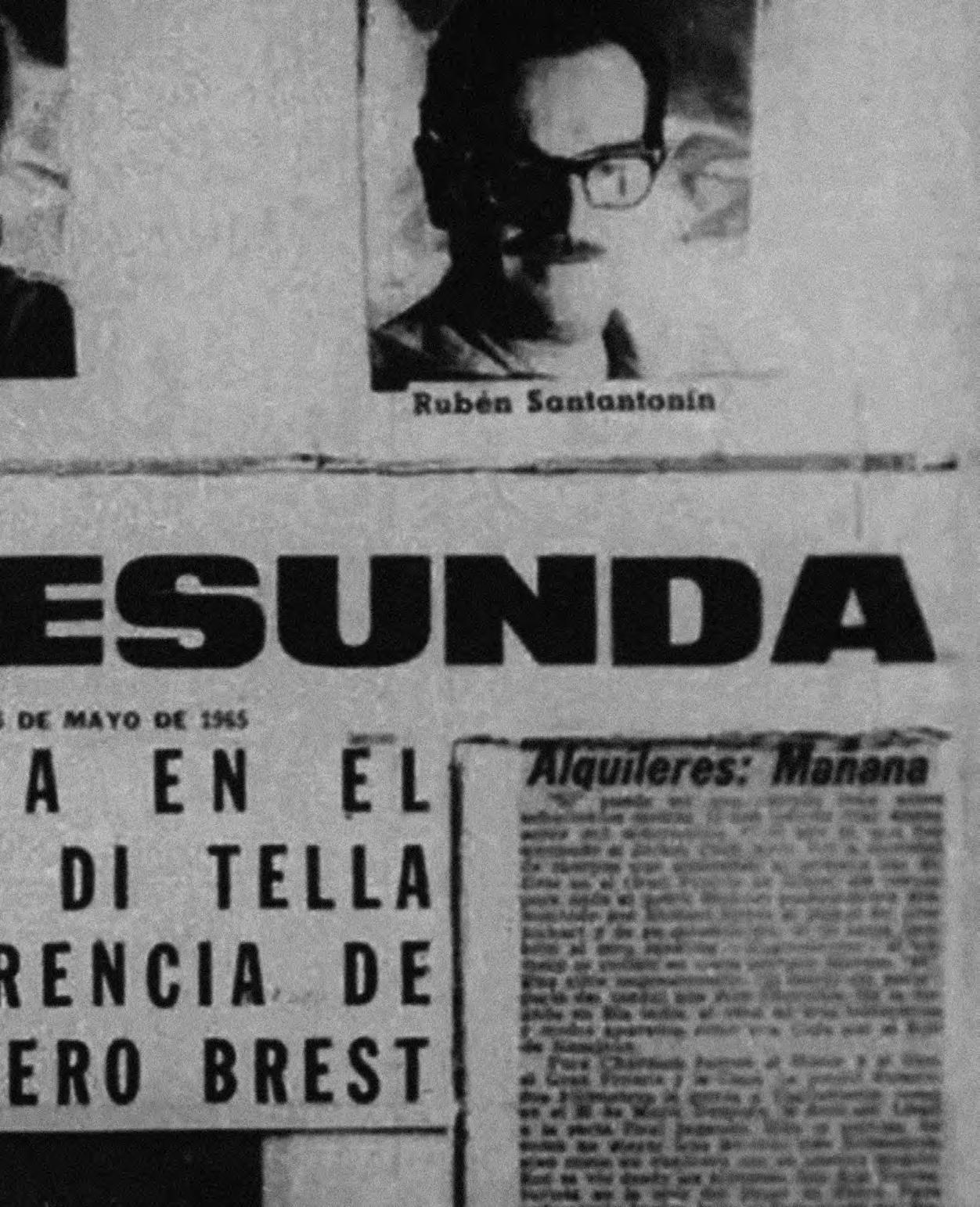

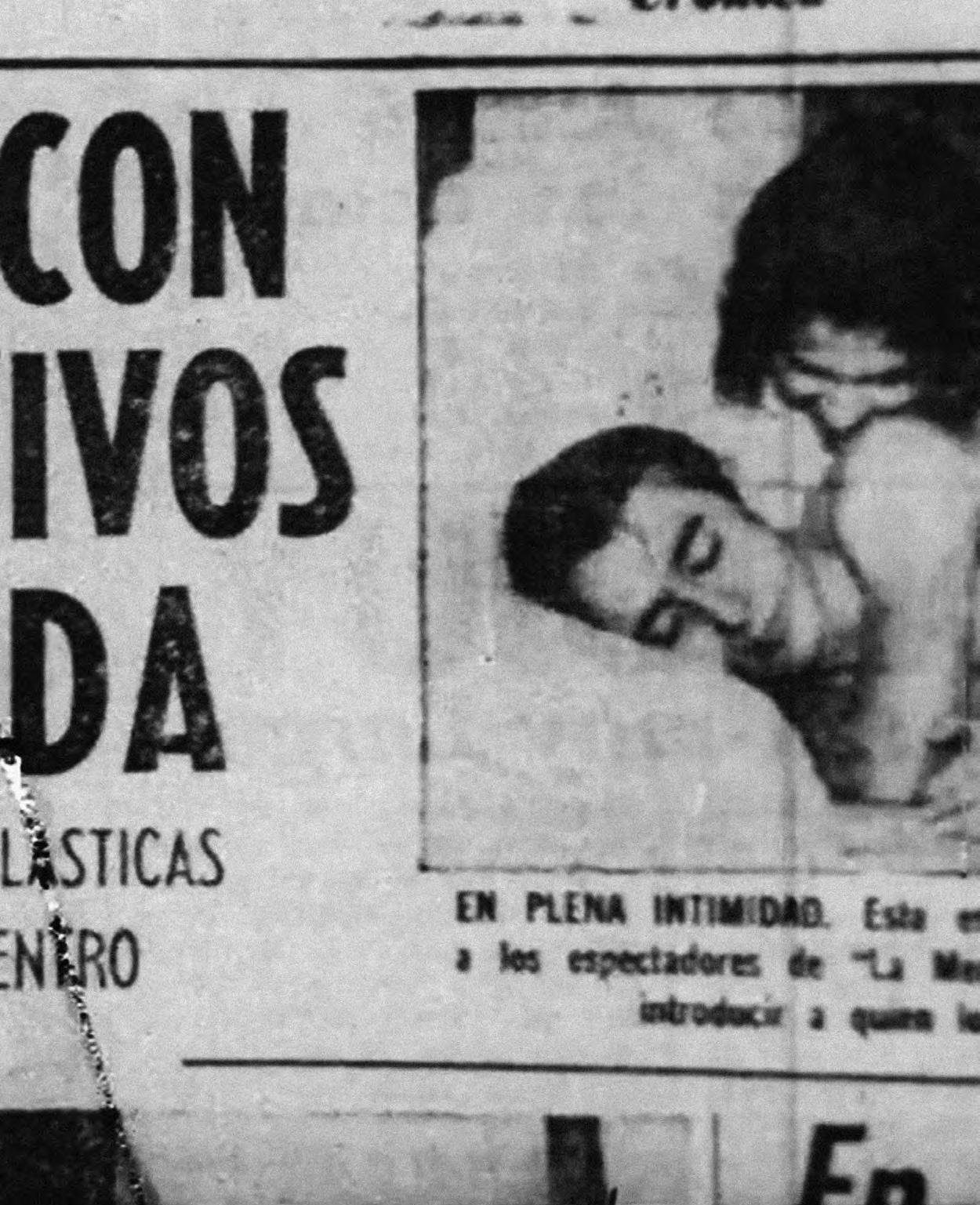
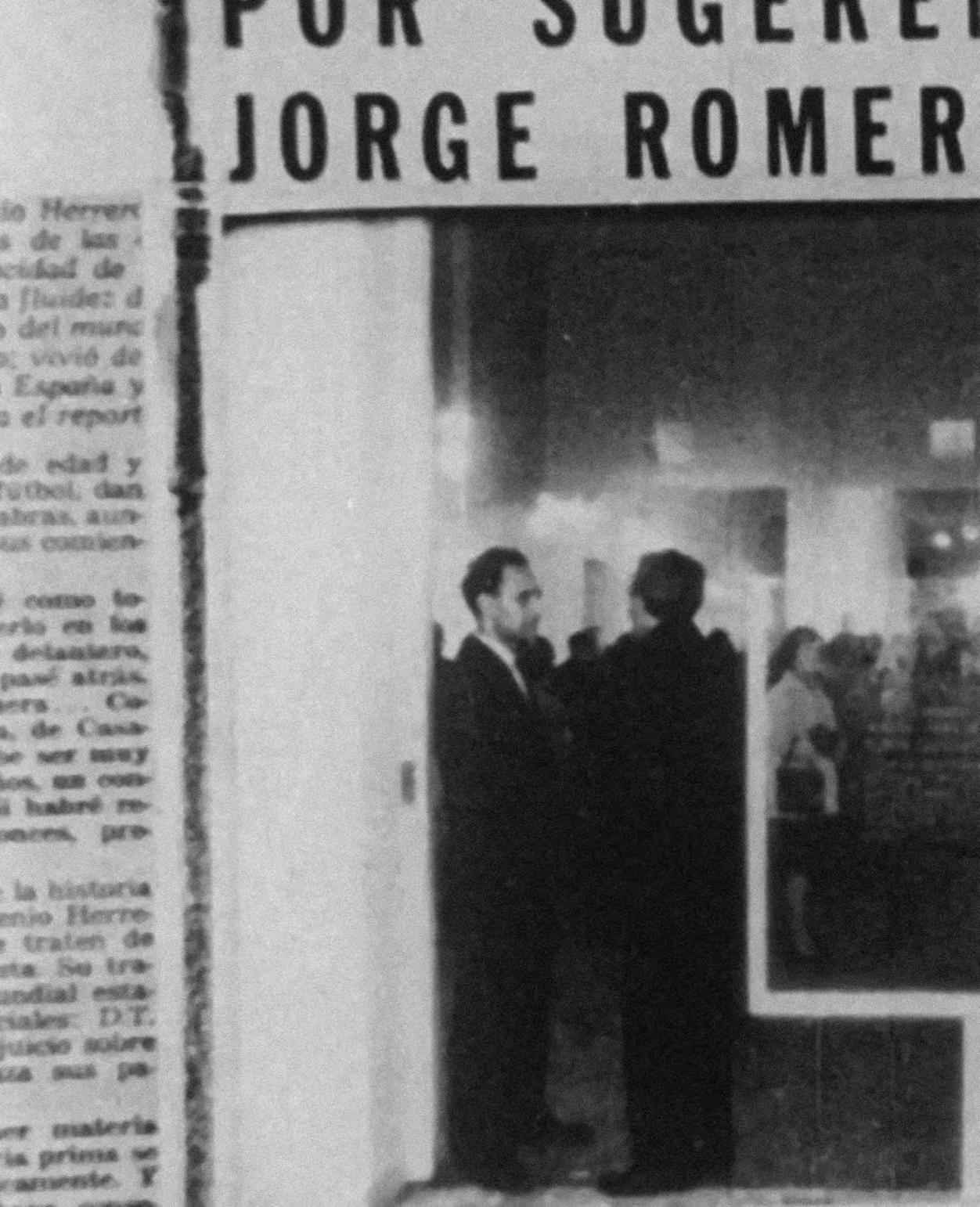


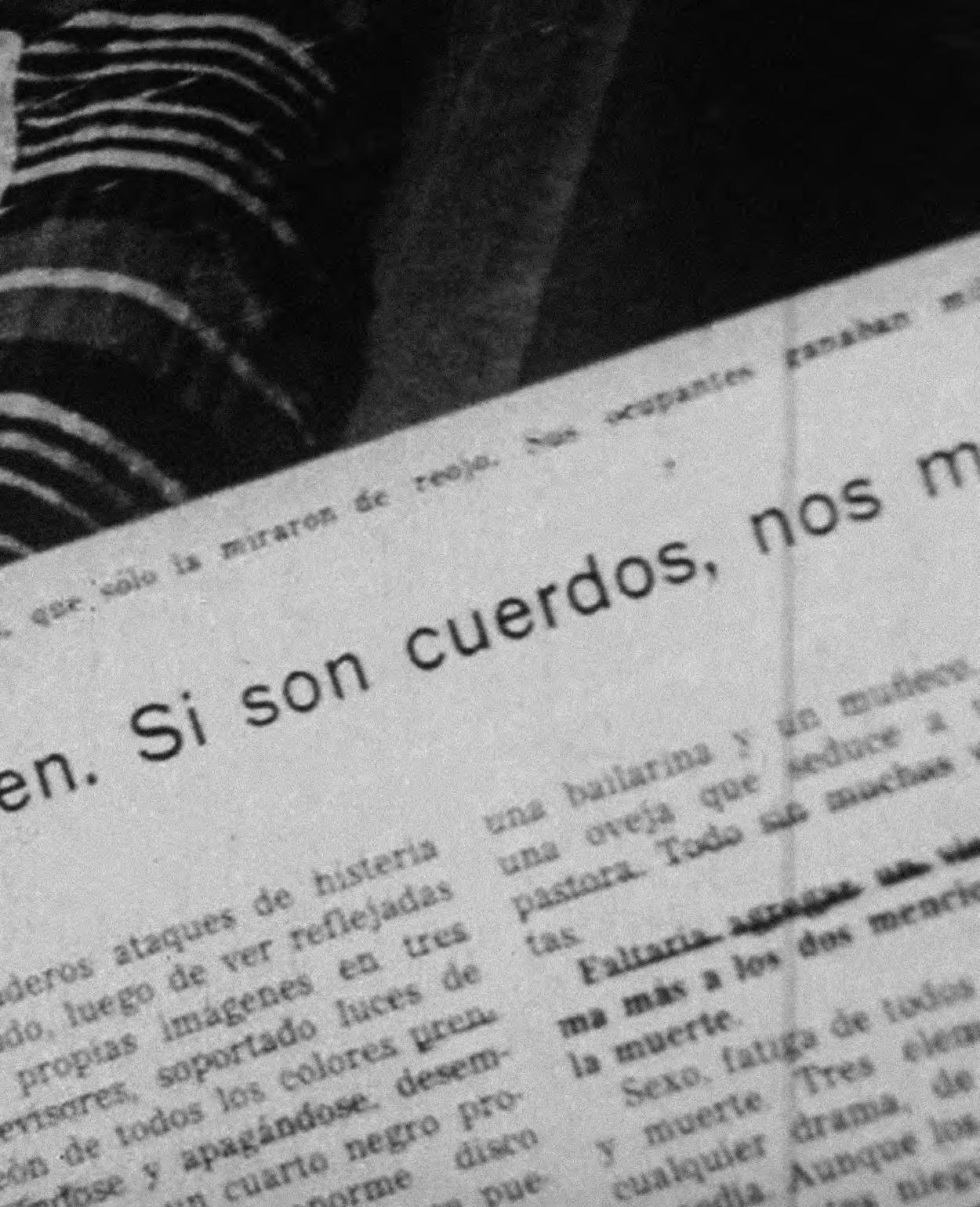

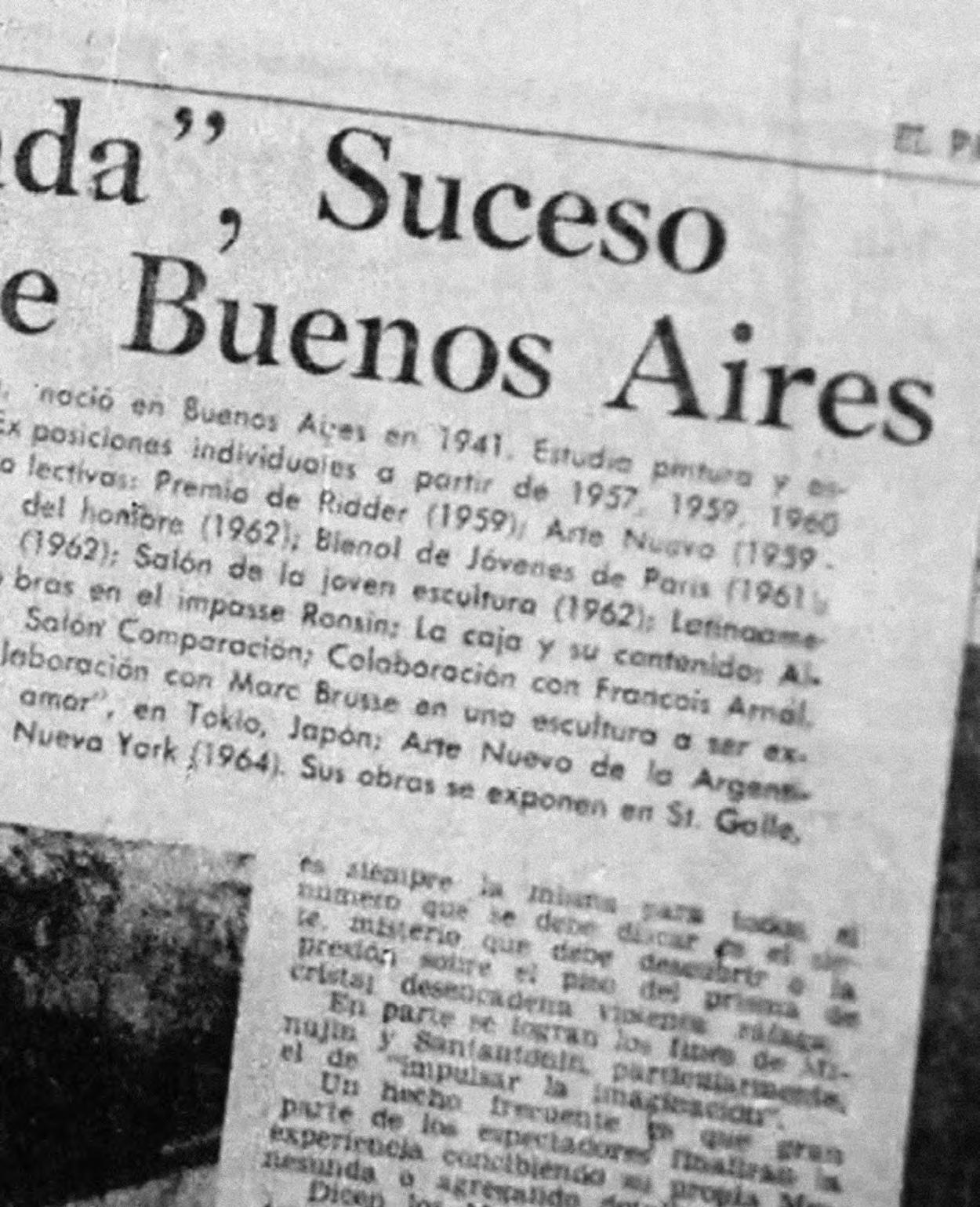
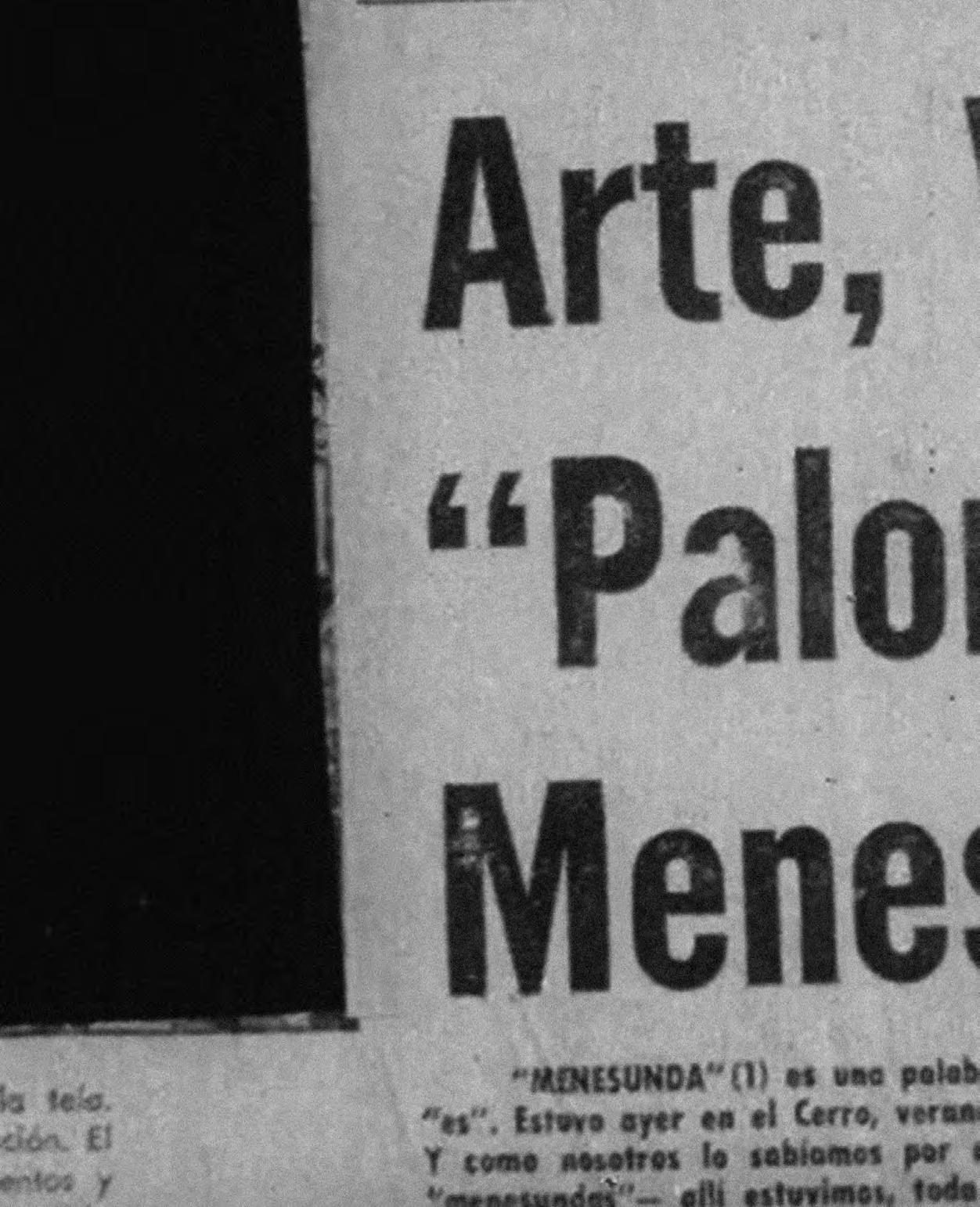
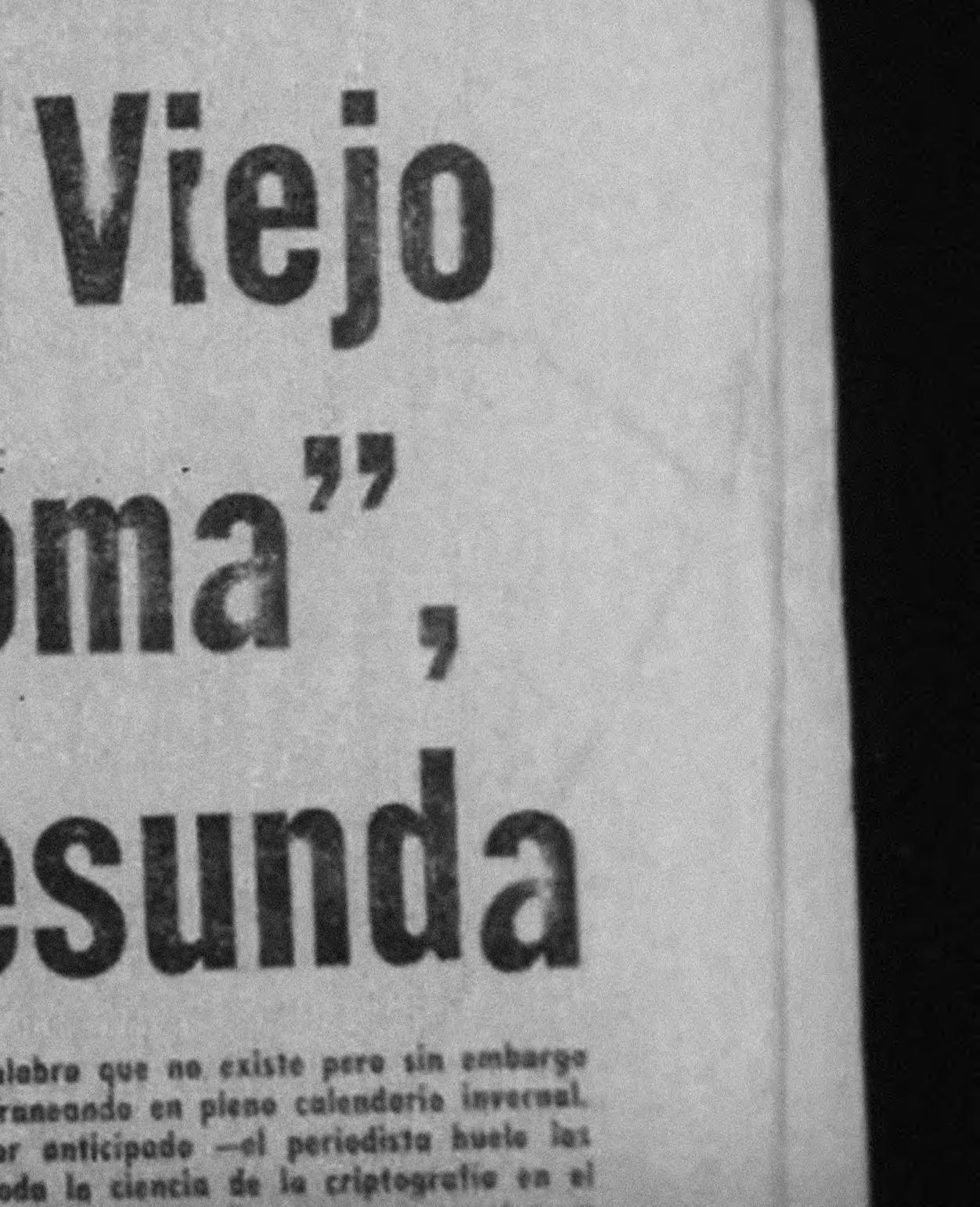

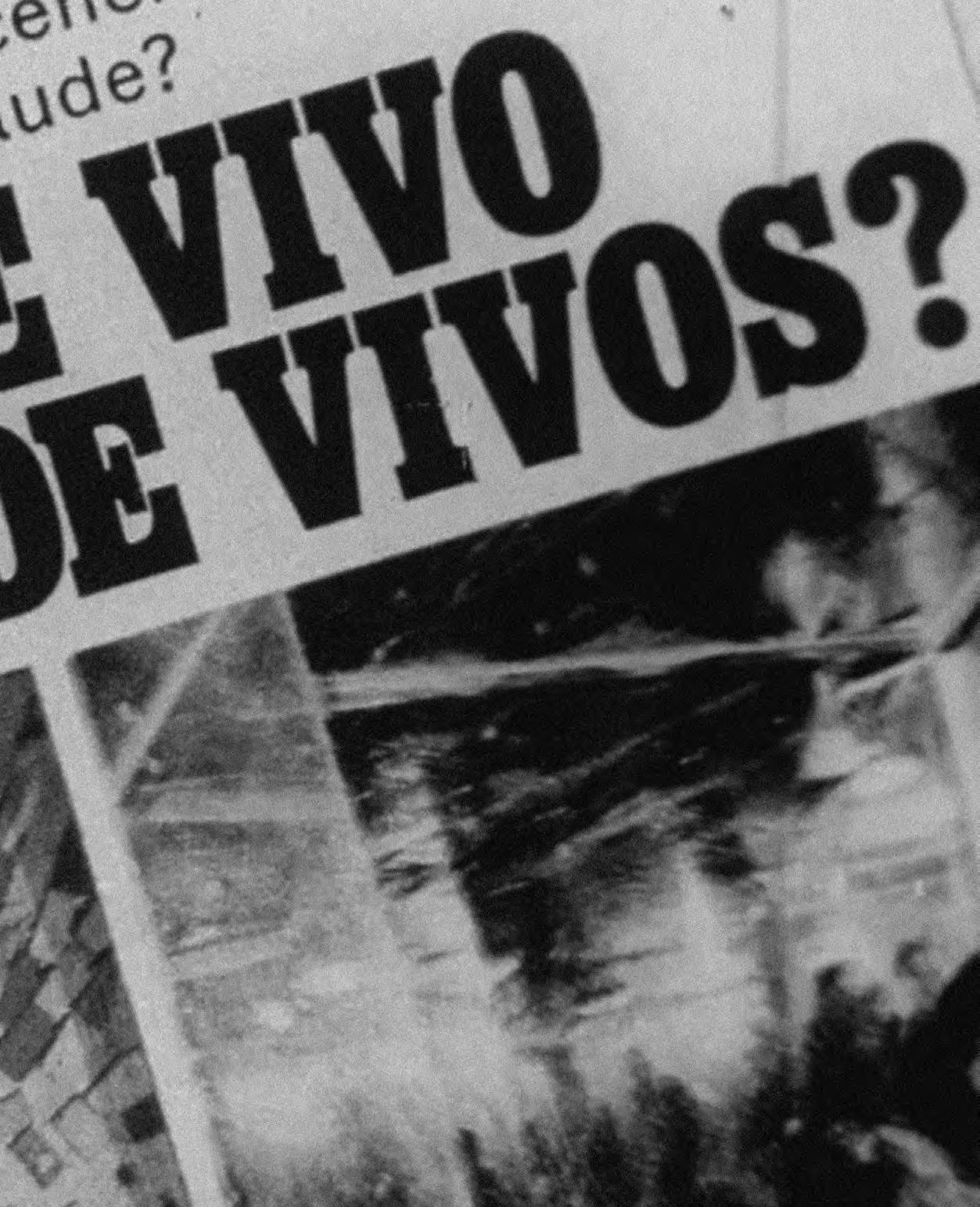
156
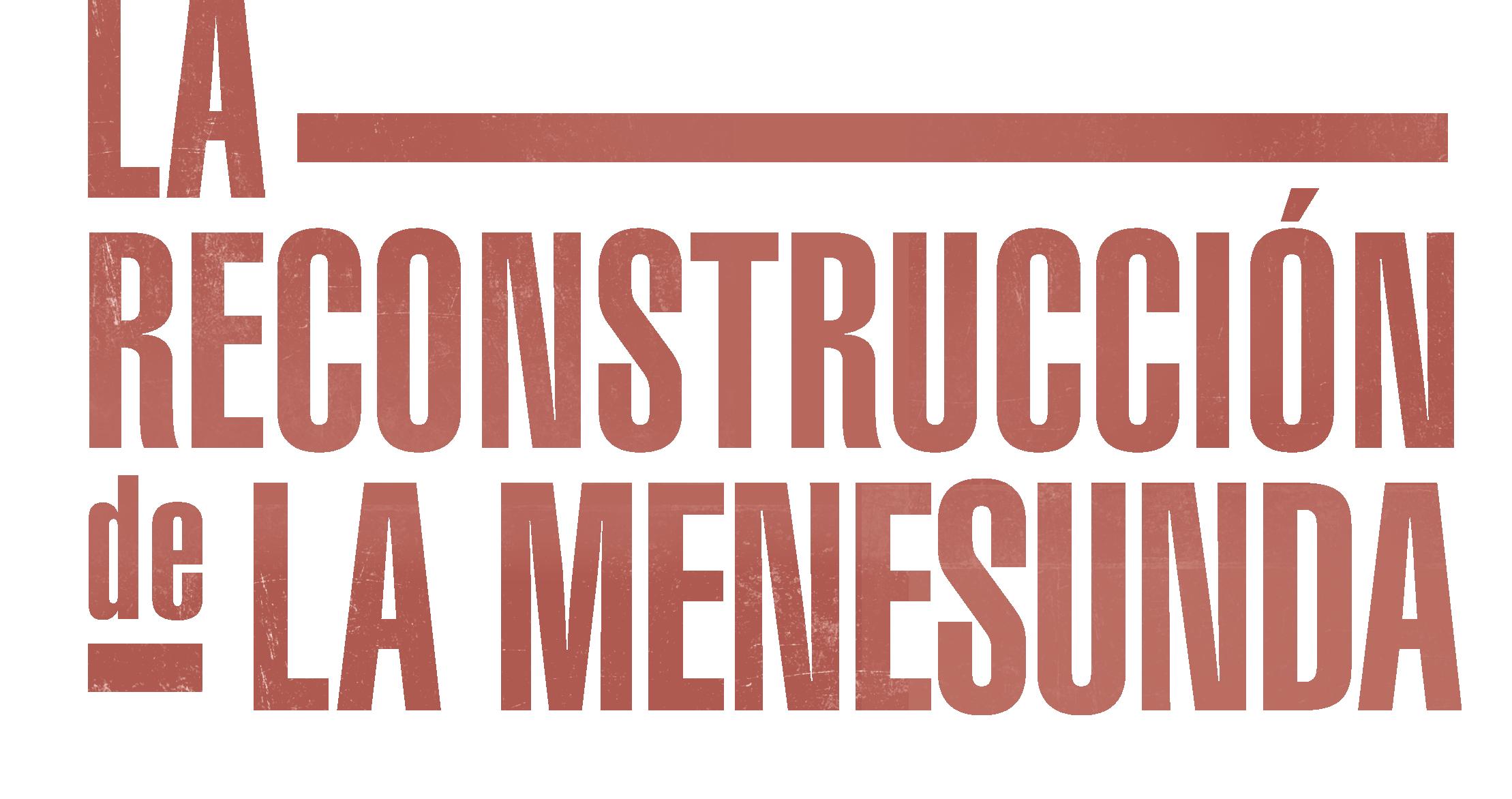
157
Por Sofía Dourron, Iván Rösler, Almendra Vilela, Javier Villa y Agustina Vizcarra
158
La reconstrucción de La Menesunda
archivos y medios de prensa, a una película filmada por Leopoldo Maler, a otra realizada por el noticiero cinematográfico Sucesos Argentinos y a un film en color perteneciente al Archivo Marta Minujín. A su vez, se tuvieron en cuenta descripciones del proyecto escritas por Minujín (textos de esa década y de años posteriores mecanografiados), como también textos documentales de Jorge Romero Brest y artículos de diarios y revistas. Se realizaron entrevistas a Minujín, Maler y Rodolfo Prayón, quienes colaboraron en el desarrollo y registro de La Menesunda de 1965.
La reconstrucción de La Menesunda planteó desafíos técnicos importantes:
A cincuenta años de su exhibición original en el Instituto Torcuato Di Tella, el Museo de Arte Moderno de Buenos Aires reconstruye, por primera vez en la historia, la complejísima obra La Menesunda, creada por Marta Minujín y Rubén Santantonín en colaboración con los artistas Floreal Amor, David Lamelas, Leopoldo Maler, Rodolfo Prayón y Pablo Suárez. El proyecto —construir una versión fiel al espíritu, visualidad y materialidad de la obra producida en 1965— implicó el trabajo conjunto de los departamentos de Curaduría, Producción y Conservación del Museo, de Marta Minujín y de un equipo de especialistas contratados para la ocasión, incluidos el arquitecto Fernando Manzone y la empresa de construcción Arqc Stand, liderada por Gerardo Peña.
Así como la obra original presentó desafíos técnicos inusuales para sus creadores, del mismo modo su reconstrucción significó un gran reto para todos los equipos del Museo y para todos los que participaron del proyecto, tanto en sus aspectos constructivos como conceptuales. Este texto da cuenta de las principales problemáticas que debieron abordarse en las diferentes instancias del desarrollo de la obra.
Ante todo, para emprender la reconstrucción, los distintos equipos de trabajo debieron basarse en una serie de fuentes históricas reunidas en el Archivo Marta Minujín, el Archivo Centro de Artes Visuales de la Universidad Torcuato Di Tella, el Archivo Jorge Romero Brest del Instituto Payró y el patrimonio del Museo del Cine Pablo Ducrós Hicken. Se recurrió a las fotografías de los diversos ambientes de la obra encontradas en esos
• Entender la planta original y cómo se disponían los ambientes en el espacio: cabe señalar que no existen planos de la obra y que el registro con el que se cuenta es limitado y fragmentario. Para dimensionar el espacio total que ocupaba el laberinto, el equipo de construcción visitó el local donde estaba ubicado el Instituto Torcuato Di Tella (ITDT), en la calle Florida 936, en Buenos Aires. También se utilizó un croquis de la exposición Experiencias visuales 67 encontrado en el Archivo del Instituto para determinar las medidas y la disposición del espacio original donde se montó La Menesunda. Luego de varias propuestas de plantas posibles para entender cómo se organizaba la estructura, se llegó al plano final. La definición de la planta también ayudó a entender de qué forma fueron construidos los ambientes y cuáles eran las relaciones funcionales entre todos los elementos que los componían.
• Definir el tamaño de cada uno de los ambientes: esta información resultaba fundamental para un proyecto que apela a momentos de encierro, a contorsiones del cuerpo, a diversas situaciones laberínticas con sus opciones, giros y recovecos. Si bien entender la estructura del laberinto limitó el rango de tamaños posibles, llegar a dimensiones exactas implicó estudiar a escala cada una de las fotografías con las que contábamos, tomando como eje medidas estándares como la de un ser humano, un escalón o un pedazo de piso de parquet, entre otras.
• Investigar los materiales utilizados en la realización original, identificarlos, averiguar cuáles de ellos aún se siguen fabricando, cuáles permitían reconstruir la materialidad y cuáles no: a todo eso se sumó la necesidad
159
1- Los autores ocupan los siguientes cargos en el Museo de Arte Moderno de Buenos Aires, Sofía Dourron: Asistente Curatorial, Iván Rösler: Jefe de Diseño y Producción de Exposiciones, Almendra Vilela: Coordinadora de Producción, Javier Villa: Curador de Arte Contemporáneo, Agustina Vizcarra: Asistente de Producción.
Por Sofía Dourron, Iván Rösler, Almendra Vilela, Javier Villa, y Agustina Vizcarra1
de ver cuáles cumplen las normas de seguridad vigentes, ya que hoy todos deben ser ignífugos y no tóxicos. Para lograrlo se realizó un trabajo de campo con especialistas de cada área, se visitaron mercados de segunda mano y se tomó contacto con las empresas que producían estos materiales en los años sesenta. Este trabajo posibilitó que cada uno de los materiales que se usaron para construir La Menesunda según Marta Minujín fuesen materiales originales o existentes en la época.
En los últimos cincuenta años, se fueron incrementando las medidas de seguridad preventivas en los museos. Esto implicó un trabajo de adaptación de algunos aspectos, que tuvieron que adecuarse a los requerimientos actuales, sin por ello alterar la estética ni la atmósfera de la obra de 1965. Por esta razón, la estructura exterior fue diseñada y producida pensando en tres factores que se desprenden de la problemática de realizar esta obra en la actualidad:
• Durabilidad: La Menesunda de 1965 se construyó sin considerar su perdurabilidad; la exhibición estuvo abierta al público durante quince días y luego fue desarmada, mientras que La Menesunda según Marta Minujín se podrá visitar a lo largo de cinco meses. Este cambio en la duración de la exhibición implicó una modificación en la construcción de la estructura externa, en busca de mayor solidez, que en esta oportunidad fue proyectada por un equipo de arquitectos y no sólo por los artistas.
• Transportabilidad: dada la posible itinerancia de la obra, su estructura fue concebida teniendo en cuenta que debe poder desarmarse, embalarse y volver a instalarse con cierta facilidad. Cada ambiente se construyó de manera independiente y modular, e incluso uno de ellos, la cabeza de mujer, se separa en dos para evitar daños en el traslado.
• Seguridad: considerando las reglamentaciones de seguridad vigentes, se colocaron puertas de escape y cámaras de monitoreo para preservar la seguridad del espectador en todo momento. Estos dispositivos están ocultos o disimulados para no alterar la experiencia.
• Accesibilidad: las características constructivas de la obra constituyen un impedimento para el público que la visita: restricciones de acceso para personas mayores y con dificultades para caminar, tanto como para niños menores de 16 años sin un adulto que los acompañe. Para un museo público del siglo XXI, este tipo de restricciones representa un problema que en 1965 no tuvo ningún tipo de consideración. Ante esta dificultad, se diseñó como alternativa una pequeña sala de documentación de fácil acceso, que reúne material histórico de la obra original y su repercusión mediática, como
también documentación actual de la reconstrucción a través de fotografías y maquetas.
Cada ambiente presentó problemáticas particulares:
Entrada
La reconstrucción abarcó incluso la zona previa a la entrada de la obra, dado que se reconstruyó la antesala original de ingreso a La Menesunda de 1965, replicando las paredes del ITDT, una de ellas en diagonal y la otra recta, para que los visitantes queden dispuestos en una fila idéntica a la original.
Allí, los visitantes eran recibidos por un cartel de acrílico transparente con un texto que en las fotografías resultaba ilegible. Luego de obtener la redigitalización del film de Leopoldo Maler, realizada por la Tate Modern, se pudo constatar que en el texto del cartel se leía el título de la exhibición y los nombres de los autores de la obra y sus colaboradores. Ese cartel se reprodujo de manera exacta.
También se reprodujeron los carteles que guiaban el recorrido de los visitantes a lo largo de diferentes instancias. Los originales estaban confeccionados en enchapado de madera y Letraset, material que, según su principal distribuidor en la Argentina, la tienda de productos de arte Villalba, dejó de fabricarse hace años. Para reemplazarlo se usó vinilo mate, que emula la textura del material original, y se copiaron las tipografías.
Túnel de neón
El túnel de neón es el primer ambiente al que se enfrenta el público desde la entrada. Para reconstruirlo, se buscó identificar en las películas las formas, los colores y los motivos de los tubos, así como la secuencia de encendido y apagado de todo el sistema.
Dentro del túnel se pueden escuchar sonidos de la calle Lavalle, especialmente creados para la obra por un productor de sonido, que utilizó distintas herramientas de edición para lograr una textura similar a la de las grabaciones de la época.
También hubo que producir los carteles lumínicos de acrílico que se encontraban a la izquierda del túnel, para lo cual se siguieron los patrones que se observan en los archivos fotográficos, ya que este tipo de carteles dejaron de fabricarse y no se consiguen en mercados de segunda mano.
Túnel de TV
El siguiente ambiente al que ingresa el visitante es el túnel de TV, cuya planta fue especialmente difícil de definir, dado
160
Análisis metrológico de la Entrada y del Túnel de TV de La Menesunda*
Metrological analysis of the Entrance and TV Tunnel of La Menesunda*
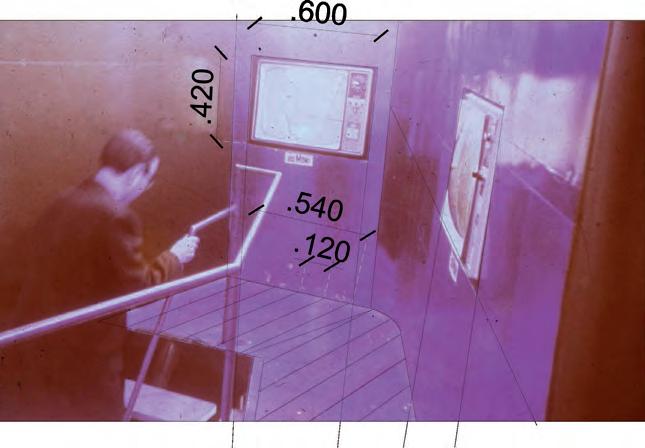

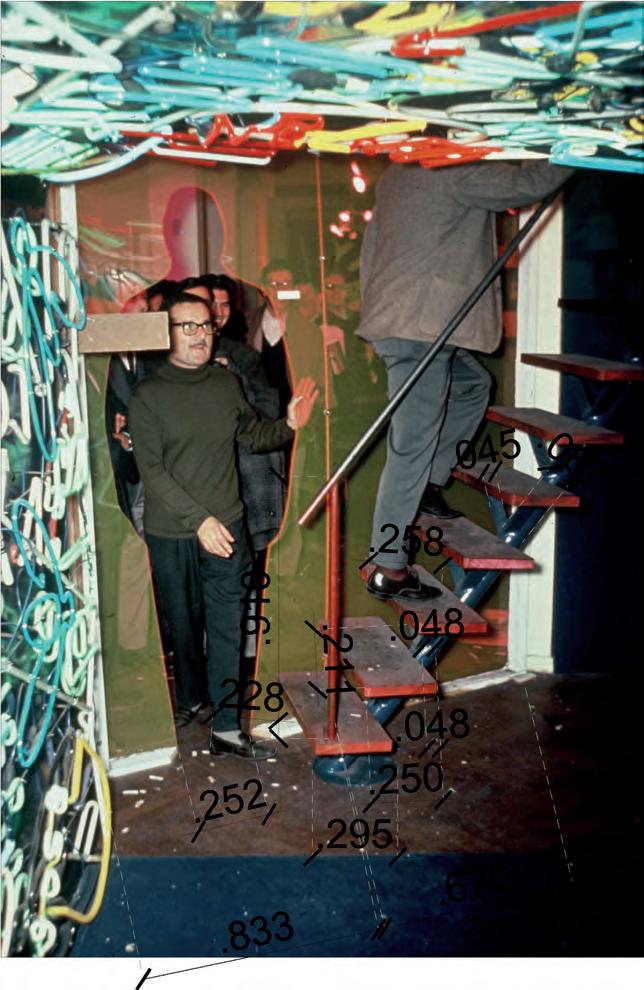
que no existen registros completos del original. Se dedujo a partir de su relación con el resto de la estructura arquitectónica y con los espacios contiguos y gracias al minucioso estudio y cálculo de Manzone y Peña, de acuerdo con las medidas de los televisores y los tablones de madera que componen el piso.
Los televisores originales habían sido un canje con la marca DuMont, que fabricó televisores en la Argentina sólo durante un breve período. Ante la imposibilidad de obtener los mismos en mercados de segunda mano y la dificultad de encontrar tecnologías prácticamente obsoletas en buen estado, se utilizaron modelos de televisores de los años sesenta, aunque fuesen de distintas marcas y tamaños. Al cierre de esta publicación, los televisores están siendo probados para verificar su funcionamiento durante un tiempo prolongado. En estos aparatos se reproducirán programas y publicidades de la televisión de aire de la época, pertenecientes al Archivo General de La Nación.
Dormitorio
Todos los elementos de esta sala —mueble combinado, ventilador, decoraciones de las paredes, manta escocesa, diarios— son de época y fueron comprados en sitios de Internet o en mercados de pulgas y antigüedades de la ciudad de Buenos Aires, salvo el velador de madera que fue hecho a medida por un equipo de realizadores convocados para reproducir algunos de los objetos.
El vano de la puerta de salida de este ambiente era muy bajo; en las películas se observa que cuando la gente sale se golpea la frente contra el marco. Se decidió mantener la altura original pese a los inconvenientes que pueda presentar para el público. Este detalle fue discutido por los equipos y la artista.
A su vez, se puso especial énfasis en la selección de la pareja, ya que es un componente fundamental de este espacio. A partir de imágenes de archivo se buscaron actores que se adecuaran a la estética de la época, que comprendieran lo que implica su participación y se comprometieran con la importancia de su rol en la reconstrucción histórica de la obra. Se presentaron aproximadamente mil candidatos, de los cuales se hizo una preselección. Finalmente, los cuarenta seleccionados fueron entrevistados por el equipo de Curaduría. Se seleccionaron ocho actores y performers con experiencia en trabajo corporal, dada la dificultad que implica permanecer cuatro horas casi inmóvil en una cama. Por esta razón se armaron turnos de cuatro horas, y una rotación entre días de semana y fines de semana. En la obra original sólo había dos parejas.
Cabeza de mujer
Minujín hizo especial hincapié en lograr reproducir cada detalle de los gestos y proporciones de la cabeza original. Para lograrlo se trabajó con realizadores que, con las imágenes del registro y la participación activa de la artista, modelaron la cabeza en una primera versión en Telgopor y luego en arcilla. A través de un examen minucioso de las fotografías del interior, se descubrió que había un orificio en el ojo izquierdo, que Minujín había mencionado pero que no había aparecido en registros previos, por el cual se podía mirar hacia afuera. Quienes lo descubrían podían ver la cara de la mujer reflejada en un espejo.
La Menesunda de 1965 contaba con el auspicio de la empresa de cosméticos Miss Ylang, que fue adquirida por una multinacional y finalmente desapareció del mercado. Por lo cual, todo el packaging que, junto con esponjas, algodones y elementos de maquillaje, recubre el interior de la cabeza fue realizado por un equipo de diseñadores gráficos que trabajó en la reconstrucción de la marca con sus iso-logotipos originales, gracias a las referencias encontradas: algunas publicidades y unos pocos productos de maquillaje comprados en mercados de antigüedades. La gráfica fue reproducida en todas las cajas y envases de acuerdo con los formatos, tamaños y colores observados en los registros fotográficos.
Por pedido expreso de la artista, para el casting de la maquilladora y la masajista que interactúan con el público ofreciendo sus servicios, se buscaron personas que reunieran los siguientes requisitos: que fuesen profesionales del oficio, que tuviesen un parecido físico con la maquilladora y la masajista originales —la maquilladora debía tener el pelo teñido de rubio y la masajista debía ser provocadora—, ya que la apariencia de ambas estaba vinculada a la estética camp de dicho espacio.
Finalmente, se realizó una selección de boleros populares de la época, basada en el libro De corazón a corazón, de Ricardo Risetti, y en testimonios orales.
Canasto giratorio
El canasto original había sido pensado para que girase en forma autónoma con un motor, pero, según el relato de Minujín, cada vez que lo prendían se cortaba la luz del Instituto. Por ese motivo, decidieron que fuera accionado manualmente por los visitantes. Este dato fue utilizado para definir cómo estaba construido y cómo era el sistema de rotación.
La búsqueda de los plásticos utilizados para su recubrimiento contó con la asistencia del conservador del
162
Análisis metrológico del Dormitorio, el Canasto giratorio y el interior de la Cabeza de mujer de La Menesunda
Metrological analysis of La Menesunda’s Bedroom, Revolving Basket and inside of the Woman’s Head

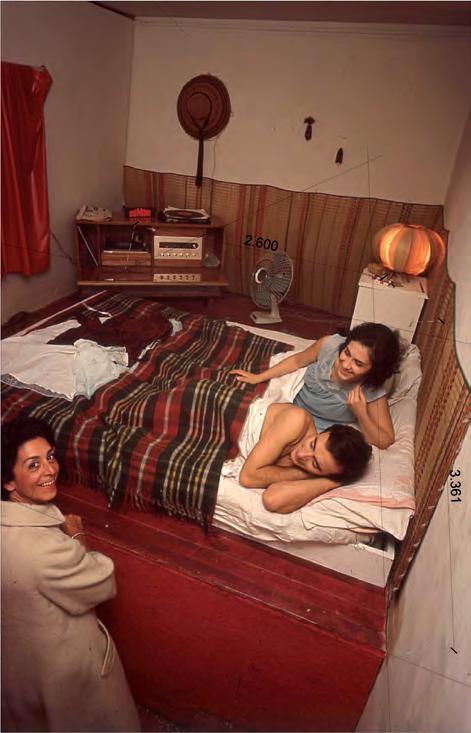

Análisis metrológico del Dormitorio de La Menesunda
Metrological analysis of the Bedroom of La Menesunda

164

165
Análisis metrológico de la Habitación octogonal de espejos de La Menesunda
Metrological analysis of La Menesunda’s Octogonal Mirror Room
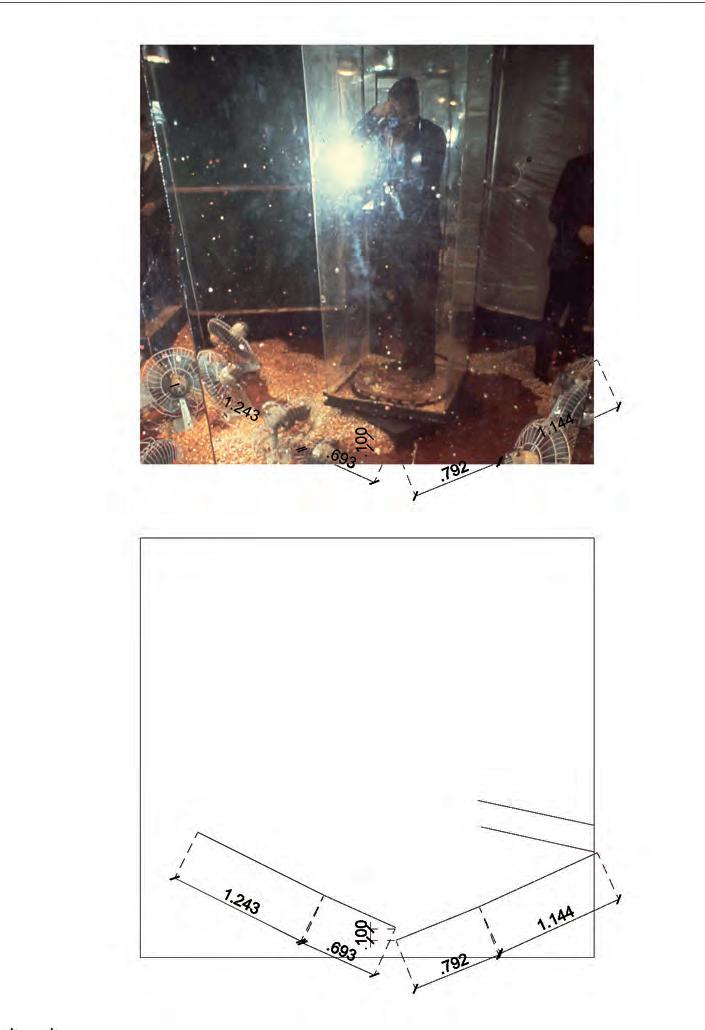

166
Museo Pino Monkes, ya que esta clase de materiales ha cambiado mucho en las últimas décadas. Se concluyó que se trataba de lona de pvc de color azul, rojo, verde, amarillo y negro.
Intestinos
Este espacio fue uno de los más complicados de reproducir, debido a su complejidad constructiva, su forma espiralada, las pendientes del techo, así como la escasa documentación existente. Nuevamente, la participación de Minujín fue esencial para lograr una planta final.
Para la producción de los “intestinos”, que recubren el interior, se convocó a un equipo de realizadores. Se fabricaron 250 metros de tubos de polietileno, se rellenaron con aserrín y se pintaron, según las indicaciones de la artista, de color “rosa intestino”. Dentro de este espacio se oye el sonido viscoso de intestinos moviéndose, realizado especialmente por un productor de sonido.
Al final del recorrido de este espacio, después de sacar la cabeza por un orificio, el visitante puede ver imágenes de la película A Summer with Monika, de Ingmar Bergman, que originalmente se proyectaban sobre una de las paredes de la sala y que, en este caso, se proyectarán sobre una pantalla. Todo este ambiente estará recubierto por una estructura que impedirá que el visitante vea el resto del laberinto, tal como sucedía con la obra original.
Ciénaga
Este espacio es un pasillo de piso blando y paredes recubiertas con copos de goma espuma, cuya longitud implicó largas discusiones y planteos sobre su relación con el resto de la estructura. Sin embargo, la mayor complejidad consistió en generar el tono lumínico del interior del espacio para emular la precaria iluminación de la obra original, utilizando polietileno transparente, acetatos y celofanes de colores verdes y azules.
Algunas notas de prensa de la época mencionaban la existencia de pequeños agujeros a través de los cuales el visitante podía mirar hacia afuera, pero no encontramos registro fotográfico alguno. Tiempo después de iniciada la investigación apareció una fotografía de prensa que mostraba esas mirillas y unos carteles con la leyenda “Mirar”, desde las cuales, de acuerdo con su disposición en el plano, se podía observar la cabeza de mujer. Estas mirillas también estarán presentes en la reconstrucción.
Teléfono
Este espacio planteó la mayor complejidad tecnológica de la obra, ya que la puerta sólo se abre cuando el visitante oprime el número correcto (y secreto) que activa el dispositivo.
Aquí se escucha a la operadora del 113 que repite la hora en tiempo real: se trata de una grabación de audio de la empresa telefónica actual. Es decir, no se oirá a la operadora que daba la hora en 1965, pues la grabación se cambió en el año 1981 y ningún archivo de la ciudad tiene los registros de voz de quien atendía en la obra original.
El ambiente está invadido por un fuerte olor a consultorio de dentista, originalmente producido por una sustancia química llamada “creosota”, que ya no se vende al público. El laboratorio Firmenich Argentina, a cargo de Bernardo Conti, produjo un aroma similar a base de clavo de olor, pero aún no se ha llegado a la versión final. Al cierre de este texto, el equipo de producción junto con el laboratorio sigue investigando y ensayando distintas opciones.
Heladera
Para la reproducción de este espacio se identificó la marca y el modelo exactos de las puertas de heladera ubicadas al ingreso y a la salida de este ambiente: la Siam 100. Luego de una búsqueda exhaustiva se consiguieron dos heladeras Siam 100 en un sorprendente estado de conservación. En las fotos de registro se observa que las puertas se cerraban solas con el agregado de un pequeño resorte, sistema que se reproducirá en la instalación.
La sensación de frío se ve enfatizada por la temperatura bajo cero y el sonido de vientos gélidos, también producidos para la obra.
Bosque de formas y texturas
Este es el espacio menos documentado de La Menesunda de 1965: no existen registros fotográficos y sólo hay una secuencia de unos pocos segundos de película. Se trata de un ambiente de cuyo techo penden bolsas de formas distintas, rellenas de copos de goma espuma y recubiertas con material de diversas texturas. Minujín confeccionó una lista de texturas: lija, corderito, tela de forro de abrigo, arpillera, hilo sisal, trapo de piso, pasto sintético, cuero, satén, metal. Se realizó una búsqueda de los materiales utilizados para lograrlas y se crearon los revestimientos para las formas. En una de las películas también se observó que una de las formas, que aparenta ser un colchón recubierto con una lona rayada de aproximadamente 3,50 x 0,45 cm, no pende del techo, sino que está sujeta al techo por sus extremos. Esta forma fue creada por un realizador.
Habitación octogonal de espejos
Para determinar el tamaño del octógono, el equipo constructor realizó un estudio detallado de las imágenes de archivo con el fin de analizar las medidas de los objetos reconocibles, como las tablas del techo y los listones del
167
piso de madera de caldén. Utilizando estas dimensiones como módulos de referencia, se calcularon las medidas de los espejos, el ancho de la cabina y la distancia que las separa.
Para la cabina acrílica ubicada en el centro del espacio se produjo el olor a frito característico de las calles del centro porteño, que en la obra original emanaba de una sartén con aceite quemado, que hoy, por razones de seguridad, se generará en forma de “fragancia”.
También se estudiaron con detenimiento las películas para determinar el sistema de funcionamiento de la cabina, el encendido de los ventiladores y el cambio de luz blanca a luz negra que se activan cuando ingresa el visitante.
Se rastrearon y compraron ventiladores de la misma marca y modelo que los que se utilizaron en 1965: Siam Aire. También se fabricó el papel picado circular igual al que se utilizó en La Menesunda original.
Algunos interrogantes curatoriales
Durante el proceso curatorial del proyecto surgieron diferentes interrogantes: algunos generales, que suelen plantearse al afrontar cualquier tipo de reconstrucción histórica, y otros específicos, relacionados directamente con La Menesunda.
Entre los interrogantes de carácter general, el primero que se planteó fue cómo recuperar en la actualidad el conjunto de relaciones materiales, sensoriales y simbólicas que hicieron posible la existencia de La Menesunda en 1965, sin caer en un ejercicio arqueológico de mera reconstrucción objetual, vacía de toda significación.
En estrecha vinculación con este primer problema surgió la pregunta por lo que podría diluirse o potenciarse al recuperar una experiencia propuesta hace 50 años. Por un lado, La Menesunda fue una obra polémica y novedosa para un público general y una experiencia de ruptura respecto de los lenguajes visuales de la década. Estas características la transformaron en una obra central del imaginario cultural argentino, que se fue cargando de múltiples significaciones y relecturas durante medio siglo. Su reconstrucción carece de las mismas características de novedad, polémica y ruptura, fundamentales en la potencia que generó la obra en quienes la experimentaron en 1965. Esta diferencia propone una nueva experiencia que, antes de su inauguración, es imposible comprender cabalmente, pero que podría licuar la carga legendaria depositada en la obra original.
Por otro lado, esta reconstrucción realizada en 2015 invita a hacer nuevas lecturas del pasado, pero también
despierta nuevas reflexiones y sensaciones en un contexto contemporáneo. Una de ellas está relacionada con el protagonismo del cuerpo, central en las rupturas estéticas de los 60, que se vincula con el acercamiento del arte a la vida, la liberación sexual o la violencia política, entre otros. En La Menesunda, el cuerpo del espectador es un elemento central de la pieza: sube y baja escaleras, se agacha, se estira, se marea en un canasto giratorio, pisa una ciénaga y se hunde, es rozado por diversas texturas para terminar proyectándose infinitamente en los espejos de un octógono. Se trata de un recorrido plagado de posibilidades de contacto con los materiales —trapos de piso y arpillera, pieles falsas, plásticos, cueros, telas y papeles—, que pone al tacto en primer plano. Es una situación poco usual en el campo artístico, por lo que cobra nuevas dimensiones en un contexto en el cual el contacto físico se ve cada vez más desplazado por la asepsia y el miedo al contagio. El ámbito de lo tocable se convierte, así, en algo poco deseable, sobre el cual, sin embargo, La Menesunda avanza enérgicamente.
En la actualidad, el uso de las tecnologías digitales está modificando las experiencias corporales: las relaciones sociales se entretejen dentro de mundos cibernéticos e hipervinculados. Así, La Menesunda traza una línea entre dos momentos singulares del cuerpo. Recupera una forma de percibir con todos nuestros sentidos, a la vez que nos permite reflexionar sobre la paulatina pérdida de lo físico en nuestras experiencias actuales, en favor de un predominio de lo visual y lo virtual.
Entre los desafíos específicos, el primero que surgió, incluso antes de tomar la decisión de realizar el proyecto, fue proponer la reconstrucción de una obra colaborativa con la presencia de uno solo de sus autores. La ausencia de Rubén Santantonín (1919-1969) constituyó un dilema central que ponía en cuestión la posibilidad misma de llevar a cabo el proyecto. Si bien la presencia de Santantonín en la versión de 1965 fue palpable durante todo el proceso de investigación, ya que sus reflexiones en torno al arte se trasladaron en forma directa a la obra, decidimos transformar esta disyuntiva en una oportunidad para trabajar en un proyecto de reconstrucción histórica con una artista viva, una de las más grandes agitadoras de la vanguardia artística argentina. La posibilidad de contar con la presencia de Minujín en cada paso del proceso se manifiesta como una oportunidad única y es, además, garante de su fidelidad histórica. Preocupados por comunicar muy claramente la ausencia del aporte presencial de Santantonín en la versión actual así como la presencia de Minujín, fundamental para finalizar muchos detalles no documentados, llegamos a la proposición de nombrar a este proyecto de reconstrucción La Menesunda según Marta Minujín.
168
Análisis metrológico de la Habitación octogonal de espejos de La Menesunda
Metrological analysis of La Menesunda’s Octogonal Mirror Room


Página izquierda:
Planta de La Menesunda según Marta Minujín.
Sala Primer Piso del Museo de Arte Moderno de Buenos Aires**
Left page:
Floorplan of La Menesunda according to Marta Minujín
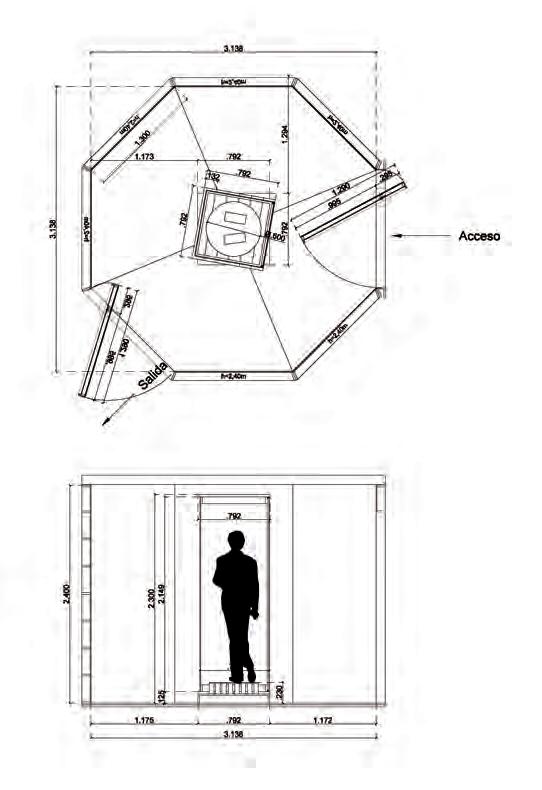
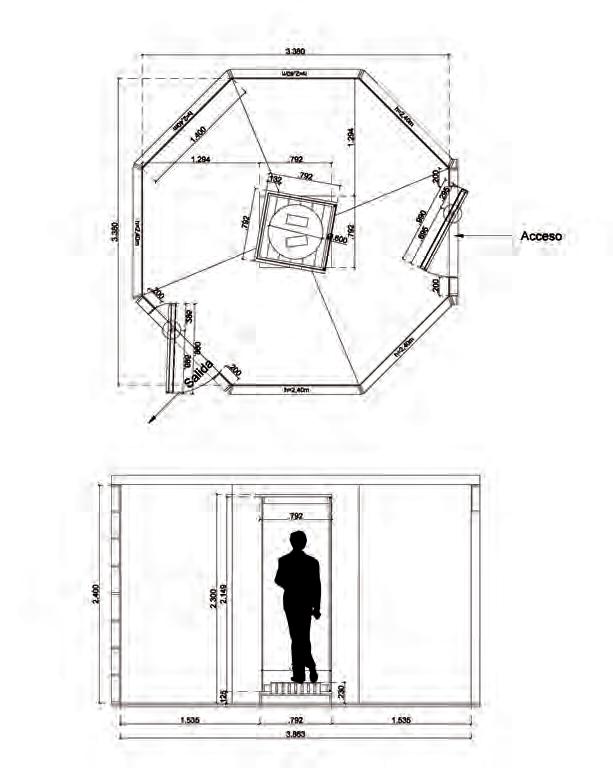
First floor Gallery of the Museo de Arte Moderno de Buenos Aires**
En esta página: Análisis metrológico de la Habitación octogonal de espejos de La Menesunda
On this page: Metrological analysis of La Menesunda’s Octogonal Mirror Room
171
Planta del Dormitorio, el Túnel de TV y el Túnel de neón en el Museo de Arte Moderno de Buenos Aires
Floorplan of the Bedroom, the TV Tunnel and the Neon Tunnel at the Museo de Arte Moderno de Buenos Aires

172
Planta y corte del interior de la Cabeza de mujer, el Canasto giratorio e Intestinos en el Museo de Arte Moderno de Buenos Aires
Floorplan and sectional view of the Woman’s Head, the Revolving Basket and Intestines at the Museo de Arte Moderno de Buenos Aires
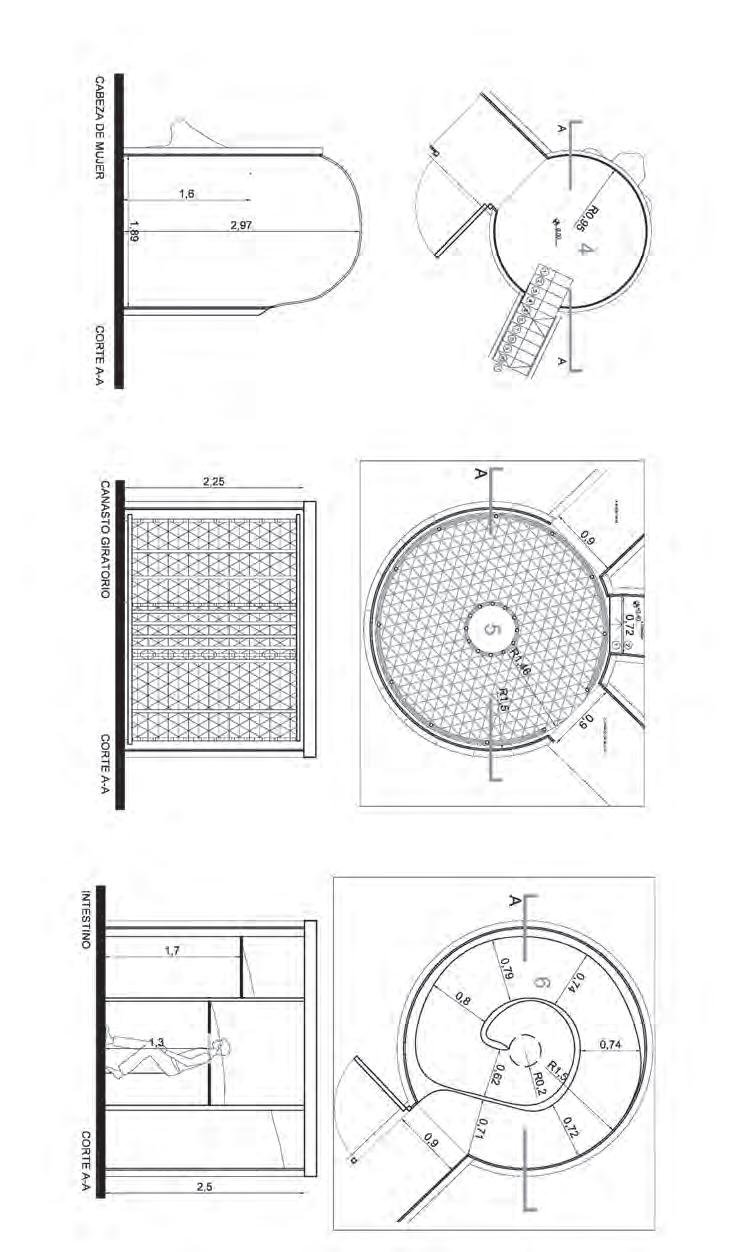
173
Plano de construcción del espacio Intestinos
Construction plan of the space The Intestines

174
Cortes del Dormitorio, el Túnel de TV y el Túnel de neón en el Museo de Arte Moderno de Buenos Aires
Sectional views of the Bedroom, the TV Tunnel, the Neon Tunnel at the Museo de Arte Moderno de Buenos Aires
* Todos los análisis metrológicos aquí reproducidos fueron elaborados por arqc stands bajo la supervisión de Gerardo Peña. The metrological analyses here included were realized by Gerardo Peña for arqc stands.
**Los planos y cortes aquí reproducidos fueron elaborados por el arquitecto Fernando Manzone. The floorplans and sectional views here reproduced were designed by architect Fernando Manzone.

175
176
Reconstructing La Menesunda
By Sofía Dourron, Iván Rösler, Almendra Vilela, Javier Villa and Agustina Vizcarra1
descriptions of the project by Minujín were also taken into consideration (typewritten texts from that decade and subsequent years), as well as texts by Jorge Romero Brest, and newspaper and magazine articles. Interviews were conducted with Minujín, Maler, and Prayón, who collaborated over the development and documentation of La Menesunda of 1965.
Reconstructing La Menesunda posed several technical challenges:
Fifty years on from the original exhibition at the Instituto Torcuato Di Tella, the Museo de Arte Moderno de Buenos Aires has, for the first time in history, reconstructed the work La Menesunda , created by Marta Minujín and Rubén Santantonín in collaboration with the artists Floreal Amor, David Lamelas, Leopoldo Maler, Rodolfo Prayón, and Pablo Suárez. This project —to construct a version faithful to the spirit, visuality, and materiality of the work produced in 1965— involved the joint efforts of the Museum’s Production, Conservation, and Curatorial Departments, working together with Marta Minujín and a bespoke team of specialists, including the architect Fernando Manzone and the construction firm Arqc Stand, headed up by Gerardo Peña.
Just as the original work set its authors unprecedented technical challenges, its reconstruction presented a huge task, both constructionally and conceptually, for all the teams at the Museum and all those taking part in the project. This text provides an account of the main problems that had to be tackled at the various stages of development of the work.
To start with, before embarking on the reconstruction process, the different work teams had to consult a series of historical sources in Marta Minujín’s personal archive, the archive of the Centro de Artes Visuales at the Universidad Torcuato Di Tella, the Jorge Romero Brest archive at the Instituto Payró, and the collection of the Museo del Cine Pablo Ducrós Hicken. They consulted photographs of the work’s various rooms found in archives and the press, as well as a movie by Leopoldo Maler, another by the Sucesos Argentinos newsreel, and a colour film from the Marta Minujín Archive. Written
• Understanding the original floorplan and how the rooms were distributed throughout the gallery space: No plans for the work exist and documentation is limited and fragmentary. So, to gauge the dimensions of the total space occupied by the labyrinth, the construction team visited the premises that used to house the Instituto Torcuato Di Tella (ITDT), at Florida 936, Buenos Aires. A sketch of the Experiencias Visuales ‘67 exhibition found in the ITDT’s archive was also used to determine the measurements and layout of the original space in which La Menesunda was mounted. After several proposals for possible floorplans to understand how the structure was organized, a final plan was reached. Defining the floorplan also helped to understand how the rooms were constructed and the functional relationships between the elements they were composed of.
• Defining the size of each room: This information was essential for a project that deploys moments of confinement, bodily contortions, various labyrinthine settings with their ins and outs, their twists and turns. Although reaching an understanding of the labyrinth’s structure limited the range of possible sizes, having exact dimensions involved studying every photo at our disposal to scale, taking standard measurements as a focus, such as human beings, steps, or pieces of parquetry.
• Researching the materials used in the original production, identifying them, finding out which of them are still manufactured, which enabled the materiality to be reconstructed and which did not: To do this, fieldwork was conducted with specialists in each area, second-hand markets visited, and contact made with the companies that produced these materials back in the ’60s. In addition to all this, there was the need to determine which ones meet today’s safety standards of fire-resistance and nontoxicity. The fieldwork enabled every one of the materials
177
1- The authors hold the following positions at the Museo de Arte Moderno de Buenos Aires: Sofia Dourron, Curatorial Assistant; Iván Rösler, Head of Exhibition Design and Production; Almendra Vilela, Production Coordinator; Javier Villa, Curator of Contemporary Art; Agustina Vizcarra, Production Assistant.
used in constructing La Menesunda según Marta Minujín to be original materials or materials existing in 1965.
Levels of preventive safety measures in museums have been on the rise over the past fifty years. This involved the adaptation of certain aspects to meet current requirements, without altering the aesthetics or the atmosphere of the original 1965 work. For this reason, the external structure was designed and produced mindful of three factors arising from the problems involved in realizing the work today:
• Durability: La Menesunda of 1965 was constructed with no thought for its longevity —the exhibition was open to the public for two weeks and was then dismantled; La Menesunda según Marta Minujín is open for five months. This change to the duration of the exhibition led to greater solidity in the construction of the external structure, designed on this occasion by a team of architects, and not only by the artists.
• Transportability: Given the potentially itinerant nature of the work, the structure was designed with ease of dismantling, packing, and reinstallation in mind. Every room was constructed as an independent module and one of them —The Woman’s Head— even divides into two to avoid damage in transit.
• Safety: Mindful of today’s regulations, fire doors and CCTV cameras were put in place to ensure the spectator’s safety at all times. These devices are hidden or disguised so as not to interfere with the experience.
• Accessibility: The work’s construction may constitute a barrier to the visiting public, including access restrictions on seniors and people with walking difficulties, and for unaccompanied under-16s. For a twenty-first-century public museum, this type of restriction represents a problem never countenanced in 1965. In light of this difficulty, a small, easily accessed documentation room was designed as an alternative, bringing together historic material from the original work and its media impact, as well as photographs and scale models of the current reconstruction.
Every room presented a specific set of problems:
The Entrance
The reconstruction even took in the area immediately preceding the entrance to the work, the original anteroom to the 1965 La Menesunda replicating the walls of the
ITDT —one diagonal, the other perpendicular— so that visitors are arranged in a row identical to the one in the original work.
In the anteroom, visitors were greeted by a transparent acrylic sign with a text that was unreadable in photographs. After the digitalization of Leopoldo Maler’s film by Tate Modern, on the sign could be made out the title of the exhibition, and the names of the work’s authors and their collaborators. This sign has been reproduced exactly.
The signs guiding visitors through the different rooms have also been reproduced. The original signs were in wood veneer and Letraset rubdowns, which, according to their main distributor in Argentina, the Villalba art materials shop, were discontinued years ago. In their stead, the original typography was copied in matt vinyl to emulate the texture of the original material.
The Neon Tunnel
The neon tunnel is the first room after the entrance. In order to reconstruct it, efforts were made to identify the shapes, colours, and motifs of the tubes from films, as well as the on-off sequence of the entire system.
Street sounds from Lavalle can be heard inside the tunnel, specially created for the work by a sound producer, who used different editing tools to create a texture that comes very close to the recordings of the day.
The luminous acrylic signs to the left of the tunnel also had to be produced, as the manufacture of this type of sign was discontinued and can no longer be found in second-hand markets. To do this, the patterns studied in the photographic archives were used.
The TV Tunnel
The next room the visitor enters is the TV tunnel, the floorplan of which was particularly tricky to define, there being no complete records of the original extant. This had to be worked out from the rest of the architectonic structure and adjacent spaces, and with the help of Manzone and Peña’s meticulous calculations based on measurements of the TV sets and wooden floorboards.
The original TV sets had been a trade-off with the DuMont brand, which manufactured televisions in Argentina for just a brief period of time. Faced with the impossibility of obtaining this brand of TV in second-hand markets and with the difficulty of finding such obsolete technology in mint condition, other models and sizes of TV set from
178
the 1960s were used. At the time of going to press, the reliability of the TV sets over an extended time period was being tested. These sets show ’60s TV shows and advertisements from the Archivo General de la Nación.
The Bedroom
All the elements in this room —radiograms, fan, wall decorations, tartan blanket, newspapers— are from the period and were bought on Internet sites and in flea markets or antique shops in Buenos Aires, the exception being the wooden lamp on the nightstand, which was handcrafted by a team of propmakers assembled to reproduce certain objects in the work.
The lintel of the exit door in this room was extremely low; in the film recordings, people can be observed bumping their foreheads on the doorframe as they leave. In spite of the inconvenience this detail may present to the public, it was discussed in depth by the teams and the artist, and a decision was made to stick by the original height.
At the same time, special emphasis was placed on the selection of the couple as a key component in this space. Based on archive images, actors were auditioned who fitted the aesthetics of the day, who understood the importance of their participation, and who were fully committed to their role in the historical reconstruction of the work. A shortlist of forty was drawn up from the approximately one thousand applicants, who were then interviewed by the Curatorial team. Given the difficulty of remaining almost motionless in a bed for four hours at a stretch, eight actors and performers with performing experience were selected to work four-hour shifts, alternating weekdays and weekends on a rota basis. The original work used just two couples.
The Woman’s Head
Minujín placed special emphasis on reproducing the smallest details of the expressions and proportions of the original head. To achieve this, propmakers set to work making use of archive images, and with the active participation of the artist, to model the head first in polystyrene, then in clay. Through meticulous examination of photos of the interior, a peephole was discovered in the left eye, which Minujín had mentioned, but which had not appeared in previous records. Visitors who discovered it could look outside and see the woman’s face reflected in a mirror.
La Menesunda of 1965 was sponsored by the Miss Ylang cosmetics company, which was acquired by a
multinational company and finally disappeared from the market. Accordingly, all the “packaging” covering the inside of the head —together with sponges, cotton wool, and elements of makeup— was produced by a team of graphic designers, who worked on reconstructing the brand and its original isologotypes through references in certain advertisements and a handful of makeup products purchased from antique market stalls. The graphics were reproduced on all the boxes and packaging, respecting the formats, sizes, and colours in the photographic records.
At the express request of the artist, the auditions for the makeup artist and the masseuse who offer their services and interact with the public was on the lookout for professionals in the trade with a physical resemblance to the original performers. The makeup artist had to be an unnatural blonde and the masseuse had to be provocative, their appearance being inextricably linked to the space’s camp aesthetic.
Finally, a selection of popular boleros from the period was made, based on Ricardo Risetti’s book De corazón a corazón (Heart to Heart) and on oral testimony.
The Revolving Basket
The original basket had been conceived to rotate independently, driven by a motor; but, according to Minujín, every time it was turned on the Institute’s lights went out. It was therefore decided that it should be operated manually by visitors. This detail was used to define how it was constructed and how the rotation mechanism worked.
The search for the plastics used in its coating had the assistance of Pino Monkes, the conservator of the Museum, since this category of materials has changed considerably over the last few decades. It was agreed that blue, red, green, yellow, and black PVC sheeting was involved.
The Intestines
This space was one of the most complicated to reproduce, due to the complexity of its construction, its spiral shape, the sloping ceiling, and the lack of existing documentation. Again, the intervention of Minujín was crucial in achieving the final floorplan.
A team of propmakers was assembled to recreate the “intestinal” lining of the interior. 250 meters of polyethylene tubing was manufactured. These were filled with sawdust and painted “intestine pink” according to the instructions
179
of the artist. Inside the space, viscous bowel movements can be heard, a sound effect designed specially for the work by a sound producer.
At the end of the circuit, visitors can poke their head through a hole and view images of Ingmar Bergman’s film Summer with Monika , originally projected on the walls of the room; this time around, they are projected on a screen. The whole room is enclosed in a structure to prevent the visitor seeing the rest of the labyrinth, as was the case with the original work.
The Swamp
This space is a corridor with a soft floor and walls coated in foam rubber. Its length involved protracted discussions and arguments about its relationship to the rest of the structure. However, the most complex issue was to emulate the makeshift lighting of the interior of the original work, using transparent polyethylene, acetates, and cellophanes in various shades of blue and green.
Some press articles from 1965 mentioned the existence of small holes through which the visitor could look out, but we could find no photographic evidence for these. Sometime after our researches got under way, a press photo came to light, showing just such peepholes and signs with the caption “Mirar” (Look). By plotting the position of these holes in the found image against the floorplan, we determined that what could be seen was the woman’s head. The peepholes are also present in the reconstruction.
The Telephone
This space was the most technologically complex of the entire work: the door only opens when the visitor punches in the (secret) number on the dial to activate the device. At this point the speaking clock —113 in Argentina— can be heard repeating the time in real time: an audio recording from a phone company of today. This is not the speaking clock of 1965, as the recording was changed in 1981 and there is no archive in the city that contains voice recordings of the operator who performed the speaking clock in the original work.
The room is filled with the pungent smell of a dentist’s office, originally produced by creosote, which is no longer for sale to the public. The Laboratorio Firmenich Argentina, headed up by Bernardo Conti, produced a similar aroma based on cloves, but the finished scent has not yet been produced. On going to press, the production team is still working with the laboratory to investigate and experiment with various alternatives.
The Icebox
In recreating this space, the exact brand and model of refrigerator doors—the Siam 100—were identified. These were located at the entrance and exit to this room. After an exhaustive search, two Siam 100 refrigerators were acquired in surprisingly good condition. From archive photographs, it can be seen that these doors self-closed with the addition of a small spring. A recreation of this mechanism is used in the installation.
The sensation of cold is emphasized by the subzero temperatures and the howling of icy winds also produced for the work.
The Forest of Forms and Textures
This is the least documented space of the 1965 La Menesunda : there are no photographic records, and there is only one film sequence lasting just a few seconds. From the ceiling of this room hang differently shaped bags stuffed with foam rubber and coated in textured material. Minujín has compiled a list of textures: sandpaper, lambskin, coat lining fabric, hessian, sisal twine, floorcloth, artificial grass, leather, satin, metal. A search was undertaken for the materials used to create the textures and the outer layers of the forms. In one film recording, it was also noticed that one of the forms, which appears to be a mattress covered in striped material, approximately 3.50 cm by 0.45 cm, does not hang down from the ceiling, but is attached to it by the ends. This form was recreated by a propmaker.
The Octagonal Mirror Room
To establish the dimensions of the octagon, the construction team undertook a detailed study of archive images, analyzing the measurements of recognizable objects, such as the planks of the ceiling and the laths of the caldén hardwood floor. Using these dimensions as reference modules, they calculated the measurements of the mirrors, the width of the booth, and the distance between them.
For the acrylic booth at the center of the space, the smell of fried food typical of the streets of downtown Buenos Aires was produced. In the original work, this came from a frying pan of burnt oil; today, for safety reasons, a “fragrance” has been used to reproduce it.
A careful study of film recordings was also made to determine the booth’s operating system, the workings of the fans, and the switch from white to black light, activated when the visitor enters.
180
Siam Air fans of the same model used in 1965 were tracked down and purchased, and the same round confetti was manufactured, identical to the kind used in the original La Menesunda.
Some curatorial question marks
A variety of issues emerged during the project’s curatorial process: some general, as typically arise when tackling any type of historical reconstruction; others specific, relating directly to La Menesunda.
Among the general issues, the first to rear its head was how, in the present, to recover the array of material, sensory, and symbolic relationships that made possible the existence of La Menesunda in 1965, without falling into an archeological exercise of mere objectual reconstruction devoid of all meaning.
Closely bound up with this first problem was the question about what might be diluted or amplified by reviving an experience designed 50 years ago. On the one hand, La Menesunda was a novel and controversial work for a general audience, at the same time as it was an experience of rupture with the visual languages of the 60s. These characteristics made it a central work of the Argentine cultural imaginary, which, in the course of a half century, has come to be charged with multiple meanings and readings. Its reconstruction lacks these characteristics of novelty, controversy, and rupture, which were so fundamental in the power that the work generated in those who saw it in 1965. This gap posits a new experience, which it is impossible before the opening of the work to fully comprehend, but which runs the risk of dissipating the legendary charge deposited in the original work.
On the other hand, the reconstruction carried out in 2015 invites people to make new readings of the past, but also awakens new thoughts and sensations in a contemporary context. One of these relates to the protagonism of the body, which is so central to the aesthetic ruptures of the ’60s and is linked with art approaching life, the sexual liberation, political violence, and so on. In La Menesunda, the spectator’s body is a central element in the piece: it goes up and down stairs, it crouches, it stretches, it gets dizzy in a revolving basket, it steps in a swamp and sinks, it is touched by a variety of textures, and is finally projected ad infinitum in an octagon of mirrors. It is a circuit that is fraught with possibilities of contact with the materials —floorcloths and hessian, false furs, plastics,
leather, fabrics and paper— that foregrounds the sense of touch. It is an unusual situation in the artistic field and accordingly takes on new dimensions in a context where physical contact is increasingly displaced by asepsis and the fear of contagion. The sphere of the touchable thus becomes something undesirable, and La Menesunda closes with this forcefully and vigorously.
Nowadays, the use of digital technologies is altering bodily experiences: social relations are interwoven within hyperlinked cyberworlds. La Menesunda thus draws a line between two particular moments of the body. It regains a way of perceiving with all our senses, while empowering us to reflect on the gradual loss of the physical in our day-to-day experiences at the expense of a predominance of the visual and the virtual.
Among the specific challenges, the first thing to arise —even before taking the decision to embark on the project— was to propose the reconstruction of a collaborative work with the presence of only one of its authors. The absence of Rubén Santantonín (19191969) was a central dilemma that called into question the very possibility of carrying out the project. While Santantonín’s presence in the version of 1965 was tangible throughout the research process, his thoughts about art being transferred directly to the work, we decided to turn this dilemma into an opportunity to work on a historical reconstruction project with a living artist, and one of the greatest agitators of the Argentine artistic avant-garde. The possibility of Minujín’s presence at every step in the process works as a unique opportunity and stands as a guarantee of its historical accuracy. In order to clearly communicate the absence of Santantonín’s on-site contribution in the current version, as much as Minujín’s presence, which was so fundamental in finalizing many undocumented details, we arrived at the proposition to name the reconstruction La Menesunda según Marta Minujín.
181

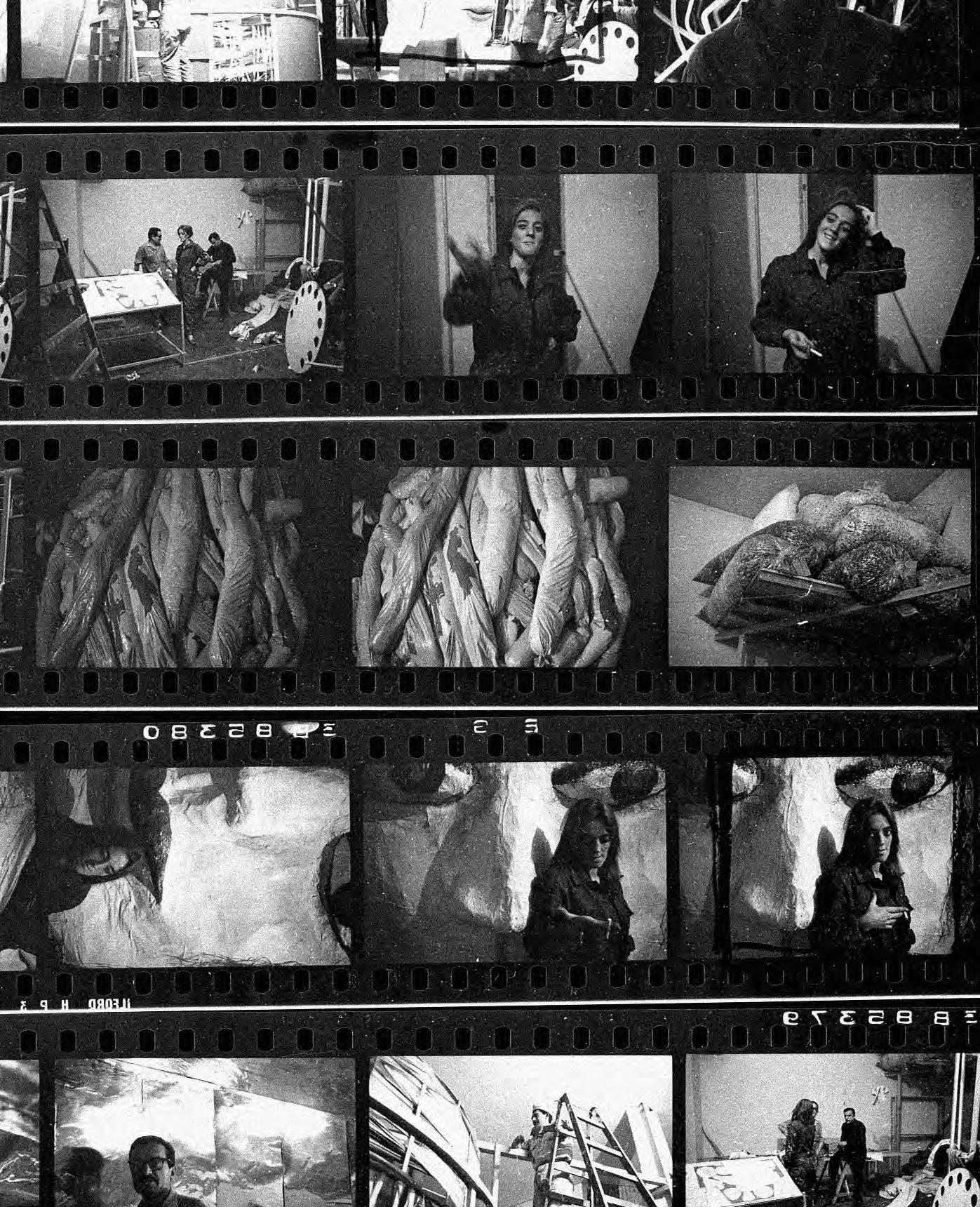
184
185
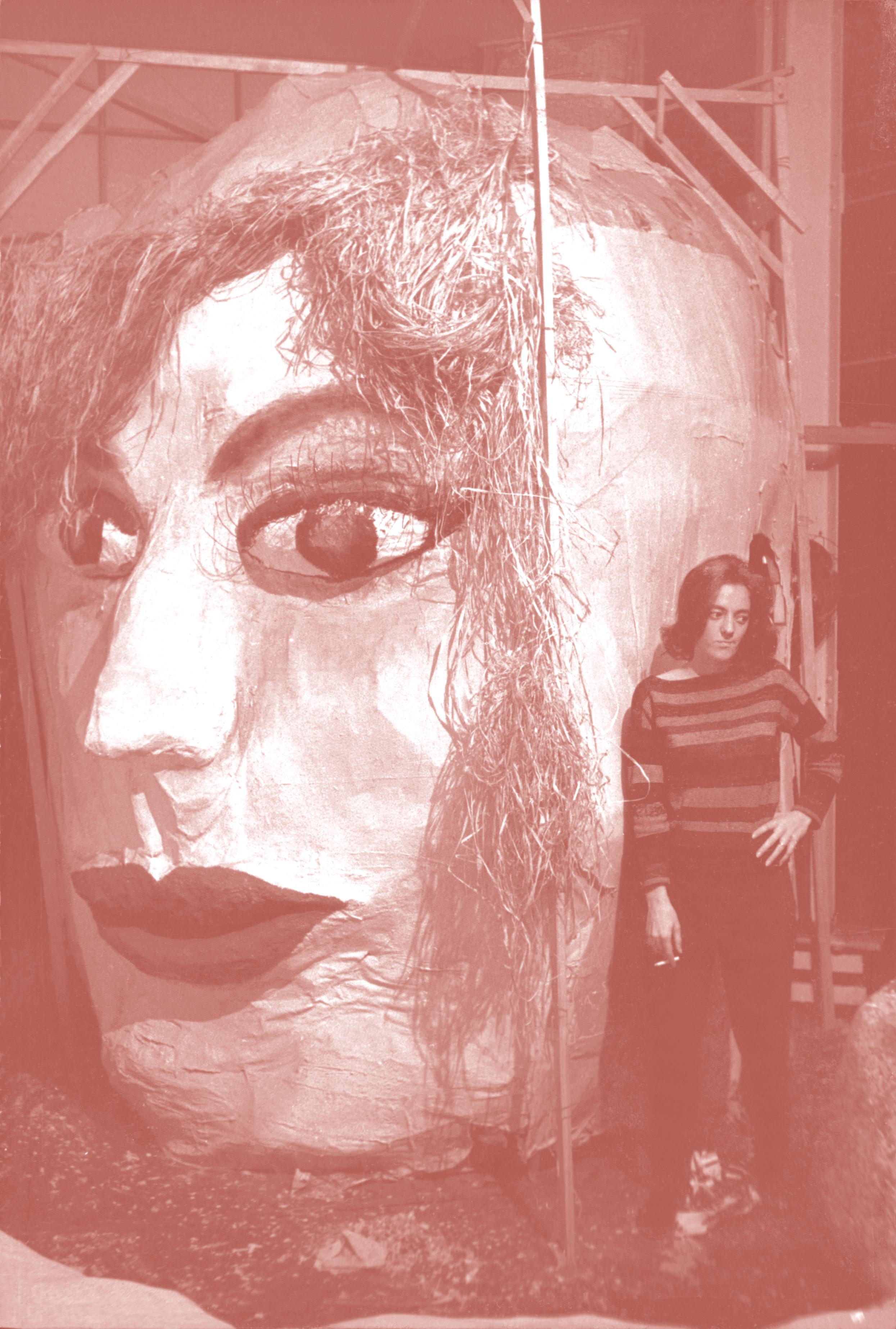
186
Marta Minujín: Una biografía
1943: Origen
Marta Minujín nace el 30 de enero de 1943 en Buenos Aires, Argentina.1 Vive en la calle Humberto Primo, barrio de San Cristóbal junto a su familia, compuesta por su padre, León Minujín, su madre, Amanda Inés Fernández, y su hermano, Luis Andino Minujín. En la planta baja funciona Casa Minujín, fábrica dedicada a la confección de ropa de trabajo, fundada por su abuelo paterno en 1907.
Los 50 - De las manchas al informalismo
A los doce años, ingresa a la Escuela de Bellas Artes Manuel Belgrano. Dos años después, su hermano enferma de leucemia. Durante esa época asiste, sin inscribirse, a clases en la Escuela de Bellas Artes Prilidiano Pueyrredón, en la Escuela Superior de Bellas Artes Ernesto de la Cárcova y en la Facultad de Filosofía y Letras de la Universidad de Buenos Aires. Realiza sus primeras obras, los “Homenajes”, dedicados a Vivaldi, Bach y Sibelius. Asimismo, retrata las grúas del viejo puerto de Buenos Aires con un palito de mimbre entintado y participa en diversos concursos de manchas junto a otros estudiantes en diferentes plazas de la ciudad.
En 1957 se recibe de maestra de Bellas Artes y comienza a exponer asiduamente en salones y premios institucionales.
En mayo de 1959, realiza su primera exposición individual, 8 dibujos de Marta Minujín, en el Teatro Agón de Buenos Aires. Durante ese año y el siguiente participa en el Premio De Ridder a la Joven Pintura Argentina junto a los artistas Alberto Greco, Víctor Chab, Nicolás García Uriburu, Jorge López Anaya, Rómulo Macció, Luis Felipe Noé, Martha Peluffo y Rogelio Polesello, entre otros. Para aquella época, Minujín ya es una asistente asidua del bar Moderno, punto de encuentro de los artistas activos del circuito porteño. En ese momento nace su amistad con Alberto Greco.
Los 60 - Entre París y Nueva York
En abril de 1961, invitada por la crítica de arte de origen francés Germaine Derbecq, directora de la galería Lirolay y casada con el escultor argentino Pablo Curatella Manes, Minujín participa en la muestra colectiva Davidovich. Heredia. Luzzati. Marchese. Minujín. En mayo exhibirá individualmente en la misma galería.
Poco después, Minujín es invitada a integrar el envío argentino a la Deuxième Biennale de Paris: Manifestation Biennale et Internationale des Jeunes Artistes. Minujín expone la obra Témoignage pour une tombe. Participan otros quince artistas, entre los cuales se encuentran Jorge López Anaya, Rómulo Macció, Luis Felipe Noé, Martha Peluffo y Luis Wells.
Hacia fines de agosto se presenta a una beca del gobierno francés que le permite cursar el año universitario 19611962 para realizar estudios de pintura en la École Nationale Supérieure des Beaux-Arts. La postulación es aceptada, pero Minujín nunca realiza los estudios indicados. “Yo llegué y estaba Greco. Me fui [a París] con Alberto Reyna y lo encontré. Vivía en un hotel, yo vivía en otro lado. Todos los días veía a Greco en París”.2
Durante ese viaje, Minujín frecuenta a diversos artistas argentinos que estaban en París, como Jorge de la Vega y Luis Felipe Noé. También conocerá a un grupo de escritores a partir de la amistad que entabla con la poeta argentina Alejandra Pizarnik; entre ellos, a Octavio Paz y André Pieyre de Mandiargues. En una de las tertulias junto a este círculo, se cruza con Jean-Paul Sartre, influencia ideológica fundamental durante su período parisino previo al Pop.
Entre febrero y marzo de 1962, Derbecq organiza en la Galerie Creuze de París la exposición Pablo Manes. Sculptures. Période parisienne 1921-1946. 30 Argentins de la nouvelle génération. Peintures. Sculptures. Objets. Minujín presenta la obra Le chien mort, mientras que Greco expondrá Arte Vivo: 30 ratas de la nueva generación. También participan Jorge de la Vega, Alberto Heredia, Gyula Kosice, Julio Le Parc, Luis Felipe Noé y Carlos Silva, entre otros. A partir de esta exposición, la obra de la artista comenzará a tener visibilidad en la crítica parisina. Por otro lado, Minujín continuará en contacto con los críticos de arte argentinos, con quienes mantiene correspondencia e intercambia información, sobre todo con Julio E. Payró, Hugo Parpagnoli y Rafael Squirru.
En Buenos Aires, Minujín participa en El hombre antes del hombre. Exposición de cosas, muestra colectiva organizada por Rafael Squirru en la Galería Florida y auspiciada por el Museo
La artista asegura haber nacido el 30 de enero de 1943 y que los documentos existentes que indican 1941 como fecha oficial de nacimiento fueron falsificados con el objetivo de conseguir la mayoría de edad dos años antes de lo permitido.
187
1-
2- Conversación con Javier Villa, taller de Marta Minujín, Buenos Aires, julio de 2010.
de Arte Moderno, del 7 al 30 de septiembre. Exponen también Noemí Di Benedetto, Kenneth Kemble, Jorge López Anaya, Aldo Paparella, Pérez Celis, Dalila Puzzovio y Rubén Santantonín, entre otros. Minujín presenta una obra que incluye, adosados a un enorme bastidor, colchones usados, escopetas, gorras y botas militares. Según relatará, la pieza tenía relación con el enfrentamiento entre colorados y azules, dos facciones del Ejército Argentino que luchaban por el poder.
En noviembre realiza su segunda exposición individual en Galería Lirolay, donde presenta obras con cartones, etiquetas comerciales y colchones, y aparecen nuevamente gorras y escopetas militares. Para la inauguración, con el consentimiento de Derbecq, convoca a unos ochenta conscriptos y ambienta el evento con marchas militares: la muestra se transforma en un escándalo. Durante ese año, también participa en el Premio de Honor Ver y Estimar, en el Museo Nacional de Bellas Artes (MNBA), Buenos Aires. En octubre, Minujín recibe una nueva beca para viajar a Francia. Permanecerá allí entre el 1° de diciembre de 1962 y el 30 de junio de 1963.
Ya en París, la artista organiza una exposición en su taller de la Rue Delambre, junto a Lourdes Castro y Alejandro Otero. En el catálogo anuncia que el día de cierre destruirá sus obras en el Impasse Ronsin, terreno baldío cedido por Niki de Saint Phalle, Jean Tinguely y Larry Rivers. Invita a Erik Beynom, Lourdes Castro, Christo, Élie-Charles Flammand, Paul Gette, José Hernández y Jean-Jacques Lebel, entre otros, para que “destruyan construyendo con su propia imagen”. Luego, un “verdugo” destruye lo producido con un hacha y, finalmente, Minujín suelta pájaros y conejos, rocía las obras con nafta y les prende fuego.3
Entre fines de 1963 y principios de 1964, Minujín trabajará junto con Mark Brusse en la realización de la obra La chambre d’amour, una estructura de madera construida por el holandés recubierta por colchones de colores estridentes confeccionados por la artista. La pieza es desarrollada especialmente para la exposición colectiva Du Labyrinthe à la Chambre d’amour, organizada por Jean Clarence Lambert en Tokyo, Japón. Participan, entre otros, Karel Appel, Jan Voss, Pierre Alechinsky.
A lo largo de 1964, la artista se vincula con prestigiosos críticos de arte que apoyarán su obra en tres puntos diferentes del planeta. Jan Van der Mark mostrará y venderá su trabajo en los Estados Unidos, Jorge Romero Brest le abrirá las puertas del Instituto Torcuato Di Tella (ITDT) y Pierre Restany difundirá su producción en Europa4 y mantendrá con la artista una larga amistad hasta su muerte.
En septiembre de ese año, Minujín gana el premio Nacional Instituto Torcuato Di Tella, con las obras Eróticos en Technicolor, colchones realizados con tela, gomapluma y pintura, colgados del techo con resortes, y ¡Revuélquese y viva!, construcción con colchones hechos con la misma técnica, a la que la gente podía ingresar y revolcarse.
En octubre, Minujín realiza su primer happening en Buenos Aires, en el programa de televisión La campana de cristal, de Canal 7. A partir de esta acción, la producción de Minujín comenzará a relacionarse cada vez más con los medios de comunicación masiva. Primera Plana, un par de semanas después del happening, informará:
Buenos Aires.– Encrespadas gallinas, untuosos atletas sólo cubiertos por slips, un poney sobre cuyo lomo bailoteaban baldes de pintura, y varias decenas de globos bastaron para erigir uno de los más estrepitosos escándalos que recuerda la televisión argentina. Fue hace dos semanas, en el programa que conduce Augusto Bonardo, La campana de cristal. Bonardo invitó a la desmelenada ganadora del Premio Di Tella, Marta Minujín (23 años), quien candorosamente le preguntó: “¿Quiere que le prepare un happening?” Incapaz de reconocer que no sabía de qué se trataba, Bonardo asintió, y sólo comenzó a inquietarse cuando vio que Minujín asaeteaba con el pincel la tela que acababa de embadurnar ante la cámara. A partir de ahí, se desató el aquelarre: el poney, escabritado, arrojaba ráfagas de pintura sobre el público; las gallinas sembraban el estudio de plumas y cacareos, y los elásticos culturistas rompían globos con estéticos desplazamientos, mientras Minujín improvisaba una danza sioux y Bonardo vociferaba: “¡Corten! ¡Corten! ¡Sáquenme de aquí a esta mujer demente!”5
A lo largo del año también participa en varias exhibiciones colectivas que buscan exportar el arte argentino a Estados Unidos: New Art of Argentina, en el Walker Art Center, Minneapolis, entre septiembre y octubre, organizada en conjunto con el Centro de Artes Visuales, ITDT, y Buenos Aires 64, organizada por Hugo Parpagnoli y el Museo de Arte Moderno de Buenos Aires en la Pepsi-Cola Company de Nueva York.
El año 1965 resulta significativo en la producción de la artista, ya que entre mayo y diciembre desarrolla tres proyectos fundamentales dentro de su práctica artística: La Menesunda, Suceso plástico y El Batacazo.
La Menesunda, proyecto que realiza junto a Rubén Santantonín, con la colaboración de Pablo Suárez, Floreal Amor, David Lamelas, Rodolfo Prayón y Leopoldo Maler, se expone del 27 de mayo al 11 de junio en el Centro de Artes Visuales del ITDT, Buenos Aires. De estructura laberíntica, el recorrido se
3- Ibídem. Minujín relatará que los pájaros representaban una expresión de libertad y los conejos, colchoncitos saltando.
4- Restany incluye a Minujín en importantes escritos, entre ellos, en su artículo “Buenos Ayres et le nouvel humanisme”, Domus , nº 425, Milán, abril de 1965.
5- Anónimo, “Happening”, Primera Plana, Buenos Aires, 10 de noviembre de 1964.
188
organizaba a partir de una secuencia no lineal de once espacios cúbicos, poliedros, triangulares y circulares recubiertos por diferentes materiales que generaban una gran diversidad de estímulos multisensoriales, diseñados para provocar y despabilar al espectador.
En Uruguay, el 25 de julio, Minujín presenta Suceso plástico, en el estadio Luis Tróccoli del Club Atlético Cerro, Montevideo. Minujín recordará Suceso plástico como el final violento y apoteósico de una primera serie de happenings. Al son de la Misa en Re de Bach, durante un lapso de diez minutos, un grupo de mujeres gordas rodaba por el piso, unas coristas besaban a cualquier hombre que se cruzara en su camino, un grupo de novios se envolvían a sí mismos con telas, los musculosos alzaban en andas a las mujeres, mientras una banda de motociclistas daba vueltas en círculos a su alrededor tocando bocina. En el tramo final, Minujín se subió a un helicóptero y comenzó a arrojar grandes cantidades de harina, lechuga y aproximadamente 500 pollos vivos sobre los participantes, causando gran impacto y desconcierto. Desbordada la situación, el happening fue clausurado.
En octubre, Minujín participa en el Premio Internacional Torcuato Di Tella 1965, con la obra El Batacazo. En esta oportunidad, los jurados son Giulio Carlo Argan, Alan Bowness y Jorge Romero Brest. Realizada en gran parte con el dinero del premio recibido en 1964 y retomando algunos preceptos de La Menesunda, El Batacazo se articulaba como un circuito de participación en el cual se sucedían cuatro situaciones: un primer espacio, que incluía varias siluetas de neón de jugadores de fútbol y rugby en diferentes posturas que se encendían y apagaban generando una secuencia de movimiento; el “ámbito del play boy”, donde el público debía tirarse por un tobogán y caía sobre una gran muñeca inflable de hule, inspirada en la famosa actriz italiana Virna Lisi; “el ámbito del astronauta”, con varios muñecos también de hule que aludían a las expectativas de la época sobre la posibilidad de que el hombre llegara a la Luna; y, finalmente, “el ámbito ecológico”, que incluía miles de abejas ubicadas entre paredes de vidrios y cantidades de conejos a los cuales Minujín se ha referido como “formas blandas en movimiento”.
En febrero de 1966, Minujín presenta El Batacazo en la Bianchini Gallery de Nueva York. En esta época, la artista se vincula con el galerista Leo Castelli y conoce a los artistas del circuito neoyorkino. Luego de la exposición, la obra quedará en un depósito donde, por falta de pago, será destruida. Poco después, recomendada por el artista Al Hansen, Gustav Metzger la invita a participar en el Destruction in Art Symposium (DIAS), previsto para septiembre de 1966 en el Institute of Contemporary Art (ICA), Londres. Minujín no asistirá, pero mandará información sobre su obra.
Minujín vuelve a Buenos Aires en octubre para realizar Simultaneidad en simultaneidad, como parte de Three Country
Happening, proyecto concebido junto a Allan Kaprow (EEUU) y Wolff Vostell (Alemania). Una obra en simultáneo en cada una de sus respectivas ciudades de origen: Buenos Aires, Nueva York y Berlín. Cada artista debía crear un happening que los otros deberían reproducir en el mismo día y horario. Simultaneidad en simultaneidad, el proyecto de Minujín, se desarrolló en la sala de teatro del Instituto Torcuato Di Tella en dos etapas. El jueves 13 de octubre, sesenta personas famosas, seleccionadas a partir de una especie de ranking mediático, fueron convocadas para participar del happening. La sala de teatro había sido equipada con sesenta televisores y sesenta radios ubicadas delante de cada una de las butacas de la platea. Cada uno de los invitados fue grabado, filmado y fotografiado de frente y perfil y, en paralelo, todo lo que acontecía en la sala podía verse en circuito cerrado de televisión. El lunes 24, los mismos invitados fueron convocados nuevamente a la sala del Instituto para vivir la experiencia de ver su imagen devuelta por los medios. Asimismo, asistían a la emisión de Invasión Instantánea, acción para la cual la artista eligió a tres personalidades (un periodista, una locutora de televisión y un boxeador), cuyas casas fueron “invadidas” por los diferentes medios de comunicación. El registro fílmico de los tres famosos fue transmitido a la medianoche a mil teleespectadores, quienes podían a su vez seguir las instrucciones que daba la artista por TV y por radio. Acto seguido, Canal 13 transmitió el happening de Vostell y Canal 11 transmitió el happening de Kaprow.
En 1966, mientras desarrolla Simultaneidad en simultaneidad, Minujín utilizará su primer overol, prenda unisex y de trabajo que le confeccionan los mismos sastres de la fábrica de su abuelo, Casa Minujín, y que continuará utilizando en el futuro, tanto en el taller como en algunas apariciones mediáticas y sociales.
Hacia fines de noviembre de 1966, Minujín retorna a Nueva York, donde permanecerá aproximadamente un año y medio. En abril de 1967, la artista viaja a Canadá para participar en el Pavillon de la Jeunesse de Expo 67, en Montreal, donde realiza Circuit Super-Heterodyne el 28 de ese mes, con la colaboración de Howard Swarcer. La artista definirá este proyecto como “una incursión en los medios de comunicación de masas”, y continuará con sus investigaciones influenciadas por las teorías de Marshall McLuhan. Tres grupos de diez personas cada uno, seleccionados a partir del procesamiento computarizado de los datos arrojados por una convocatoria pública, fueron sometidos a una “invasión mediática”: fotografiados, filmados y gabadas sus voces. Los registros se transmitieron posteriormente por televisión, en circuito cerrado, en la sala donde ocurría la acción. Mientras tanto, en un estudio de TV acontecía la segunda acción, el Concierto de famosos, en la cual ocho celebridades se sometieron a procedimientos similares, estableciendo así un juego a partir de su imagen especular y la imagen emitida por los televisores que trasmiten en vivo la acción.
189
Algunos meses después, Minujín diseña y construye, en colaboración con el ingeniero Per Biorn, el Minuphone, otra obra en la cual la tecnología y los medios asumirán un rol protagónico, pero donde a las lecturas de McLuhan comenzará a sumarse la influencia de la psicodelia a partir de la experiencia vital que tiene con el “hippismo neoyorkino”. Se trata de una cabina de teléfono intervenida con un sistema que reaccionaba a la secuencia de números marcada por el usuario generando una diversidad de estímulos sensoriales aleatorios: el cambio de color de las paredes laterales, la producción de un eco de la voz, la inyección de una humareda verde que envolvía al usuario. La obra es realizada con el dinero otorgado por la Beca Guggenheim, obtenida en 1966, y exhibida en la Howard Wise Gallery, Nueva York.
Durante la misma semana de mayo de 1968 en la que se realiza Experiencias 68 en el Centro de Artes Visuales del ITDT —exposición en la que aumenta la tensión entre los artistas argentinos y las instituciones artísticas , Minujín desarrolla Minucode en el Center for Inter-American Relations (hoy, la Americas Society), en Nueva York. Minucode fue una “ambientación social” en formato de video-instalación, que resultó de una convocatoria a grupos sociales de diversos campos profesionales: empresarios, políticos, modelos y artistas, quienes interactuarían en el marco de un mismo espacio considerado neutral. El proyecto buscaba crear una “atmósfera científico-social”, en la línea de las investigaciones que llevaba adelante la artista en aquel momento, orientada al estudio de los comportamientos humanos y sus reacciones frente a los procesos de mediatización. Minucode involucró la realización de cuatro cocktails. Cada encuentro fue registrado por seis cámaras, que aportaron diferentes puntos de vista. Asimismo, ocho personas (dos por cada grupo) seleccionadas como “líderes” tuvieron como tarea la creación de una segunda ambientación en una sala contigua, que se conoció con el nombre de Light Show, y que contó con la colaboración de Tony Martin. Minucode abrió sus puertas el 27 de mayo; allí podían verse las filmaciones de los cocktails proyectados sobre los muros de la sala y, en la sala contigua, la proyección de Light Show.
En julio, Minujín exhibe Importación-Exportación en las salas del Centro de Artes Visuales del ITDT. La institución le había otorgado dinero para importar la cultura hippie a Buenos Aires. Minujín retorna al país con accesorios, ropa y pósters, tecnología psicodélica como overhead projectors, luces estroboscópicas y máquinas de humo, y manifestaciones culturales como música y cine con influencias de la ideología hippie. Exportación, la segunda etapa de ImportaciónExportación, nunca pudo concretarse. Durante esos meses, en sesiones de ácido lisérgico, la artista realizará Diario underground. “Empiezo a tomar LSD y decido abandonar
el mundo de las galerías e internarme en la experiencia psicodélica, pero a fondo, como hago todas las cosas”.6
En 1969, Minujín realiza La imagen eléctrica junto al músico norteamericano Eric Saltzman (que estaba en esta ciudad asistiendo a un curso de música electrónica en el ITDT), un espectáculo de inspiración hippie que se inauguró en el ITDT el 26 de agosto y que la prensa describió del siguiente modo:
Alrededor de mil personas con atuendos indescriptibles […] escuchaban sonidos y miraban diapositivas y films proyectados (9 especiales para slides y 3 del tipo overhead) y 6 canales de sonido eléctrico, un conjunto beat –Almendra–, un extraño solista gutural –Federico Peralta Ramos–, un grupo de improvisación –Tiempo Lobo–, músicos del centro de experimentación y luz negra.7
Con este proyecto, Minujin trabajará por última vez dentro del ITDT, institución que cerrará su Centro de Artes Visuales en 1970 y que, durante cuatro años, bajo la dirección de Jorge Romero Brest, apoyó incondicionalmente a la artista.
Los 70 - Diez años de happenings Durante 1970, Minujín continúa viajando entre la Argentina y los Estados Unidos. En julio retoma la pintura realizando una exposición donde exhibe pinturas de 1959 y dibujos de 1970 en la Galería Anaconda, Buenos Aires. A su vez, presenta Festival de los pobres (Light Show), en el Teatro Payró, Buenos Aires. La proyección es organizada por el CAyC, institución creada recientemente y dirigida por Jorge Glusberg. Minujín trabaja con documentación de la comunidad hippie capturada por ella misma durante 1969 en Central Park, Nueva York, que mezcla con imágenes de la India y Nepal. También participa en el catálogo de Information, la celebre exposición colectiva curada por Kynaston McShine, en el Museum of Modern Art (MoMA), Nueva York.
En Buenos Aires, el 13 de septiembre de 1971, presenta Buenos Aires, hoy ya!, en el microcine de la Escuela Panamericana de Arte. El filmpenning, género inventado por la artista, mezcla cine, música, poesía y el teatro de la vida y desarrolla un happening durante diversas proyecciones en simultáneo, organizada en tres actos y un intervalo. La filmación tomó como “locaciones improvisadas” las casas de Graciela Borges, León Minujín, Oscar Korenblit, Eduardo Plá, Jorge Damonte, Federico Klemm, Rosita Frou-Frou y Gyula Kosice, entre otros.
En agosto de 1972, de regreso en los Estados Unidos, Minujín presenta Interpenning, en el Sculpture Garden del MoMA, Nueva York, nuevamente, con la asistencia técnica de Gary Glover y la participación de quince interpenactors. Interpenning se definía como una intervención que acontecía en el intervalo, en el “entre” de dos situaciones pautadas previamente. El público se ubicaba en el suelo, mientras los
190
6- Conversación con Victoria Noorthoorn, taller de Marta Minujín, Buenos Aires, 17 de mayo de 2010.
7- Panorama, 2 de septiembre de 1969, p. 30.
interpenactors, vestidos de verde y azul y equipados con lupas, linternas y espejos, caminaban en diagonal, tomaban de la mano al público y lo ubicaban en otro lugar, de acuerdo con un guión de movimientos rígidos, esquemáticos y cortantes diseñados por la artista. Susurraban también una selección de textos de Ouspensky, un maestro hippie
El 12 de junio de ese año, Minujín lleva a cabo Nicappening, una irrupción violenta junto a un grupo de performers al grito de “Nicappening”, en medio de una subasta en Sotheby’s Park Bennett, Nueva York, a beneficio de los refugiados del terremoto en Managua, ocurrido el 23 de diciembre de 1972.
El 3 y 4 de agosto, Minujín ocupa nuevamente el Sculpture Garden del MoMA para presentar Kidnappening, realizada con la colaboración de Gary Glover y cuarenta performers maquillados según cuadros cubistas del recién fallecido Pablo Picasso, que realizan movimientos y cantos combinando ópera, poesía y danza e instan a la audiencia a participar. Una vez finalizada esa etapa, secuestran a quince espectadores —que habían prestado su consentimiento previamente— para depositarlos en distintos lugares de Nueva York: un loft en el Soho, una peluquería, la casa de un crítico, un banquete en una casa elegante, entre otros. Minujín comenta que los raptos debían ser “amistosos” y que “cada actor debía agarrar del brazo a la persona asignada, cantándole: `Usted tiene que venir conmigo´”.
En la misma época, Minujín conoce a Julián Cairol, y con él y Juan Downey edita Cha-cha-chá, revista que aborda como temática general al artista latinoamericano en Nueva York. En octubre colabora nuevamente con Cairol en Four Presents: Time Aesthetically Registered, en la Stefanotty Gallery, Nueva York, una pieza de video/espectáculo de 60 minutos con la colaboración de Gregorio Rozas, entre otros. La obra consiste en una conferencia para cincuenta espectadores, invitados a asistir vestidos de gala. La conferencia es estructurada de modo tal de sufrir varias interrupciones sistemáticas que buscan generar una toma de conciencia sobre la percepción subjetiva del tiempo.
En 1975, al volver al país, Minujín declara “Cuando regresé de Nueva York, unos meses atrás, noté que Buenos Aires estaba lleno de personas que se sentían realmente fracasadas”;8 en consecuencia, en septiembre, organiza La academia del fracaso en el CAyC, que busca reconocer estigmas comunes y desmitificar los imperativos triunfalistas por medio de la apología y la digna asunción del fracaso. Se trata de un ciclo de conferencias sobre el fracaso dictadas por invitados especiales, objetos como el Frac-asado, ambientaciones como la Tarima triunfalista o acciones como una enfermera que vacuna contra el triunfalismo y otorga un diploma internacional, entre otros.
Poco después desarrolla una versión local de Kidnappening, que titula Opebuai y presenta como una “ópera hapenning”, en el Teatro Astral. La obra cobra un nuevo sentido al realizarse en Buenos Aires, al borde de un nuevo golpe de estado.
Hacia 1976, Minujín incursiona, al igual que artistas como Víctor Grippo, Luis Fernando Benedit o Alfredo Portillos, en las investigaciones sobre la cultura latinoamericana. En abril realiza Comunicando con tierra, proyecto que comienza con la extracción de 23 kilos de tierra de Machu Picchu. Dicha tierra tenía un primer objetivo, que nunca se completaría: distribuirla a veintitrés artistas de cada país de América Latina y, cuando la tierra llegara a destino, mezclarla con la del lugar. A su vez, cada artista debía llenar nuevamente el envase con tierra de su país y enviársela a Minujín para que volviera a enterrarla en las ruinas. El proyecto finalmente se presenta en junio como obra dentro de la exposición colectiva Arte en cambio II –1976–, en el CAyC, Buenos Aires, compuesta por un nido de hornero gigante, documentación de la extracción de la tierra y la proyección del video Autogeografía.
En julio de 1977, Minujín instala Espi-Art en la Galería Birger, Buenos Aires, en la que colaboran treinta y dos artistas, divididos en dos tandas, que permanecen durante varios días encerrados en cubículos para ser espiados por el público. Según el relato de la artista: “Era una época de mucha represión, donde no se podía caminar por la calle ni juntarse mucha gente en un mismo lugar; no era una obra política, pero era un reflejo de eso”.9
Durante ese año, Minujín explorará un nuevo género artístico, catalogado por ella misma como “arte agrícola en acción”. Primero realizará Repollos, en el Museu de Arte Contemporânea da Universidade de São Paulo, con la participación de Alejandro Larsen y Alejandro Kuropatwa. Luego, será el turno de Toronjas, en el Museo Universitario de Ciencias y Artes, en la ciudad de México. Y, por último, Pomelos, en el CAyC, Buenos Aires.
En 1978, Minujín dará inicio a una larga serie de obras de gran escala con participación masiva del público, que requieren un extenso trabajo de gestión, monumentos o mitos que en los próximos años irá tumbando, prendiendo fuego o transformando en alimento hasta su desaparición. La primera es el Obelisco acostado, en la I Bienal Latinoamericana de San Pablo, en San Pablo, entre noviembre y diciembre. La obra es financiada por Techint. En esta línea de trabajos crea, en 1979, Obelisco de pan dulce, en la II Feria de las Naciones, Predio Ferial de Palermo, Buenos Aires.
Los 80 - La década de las masas
De 1978 a 1983 se concentra el mayor foco de sus obras monumentales de participación masiva. En 1981, presenta Carlos Gardel de fuego, en la IV Bienal de Arte de Medellín, en
191
8- Anónimo, “El triunfo de los fracasados”, 7 Días , Buenos Aires, 17 de octubre de 1975. 9- Conversación con Javier Villa, taller de Marta Minujín, Buenos Aires, julio de 2010.
Medellín. La obra, de doce metros de alto, está recubierta con tejido metálico y algodón. El 15 de mayo –día de inauguración de la bienal–, Minujín le prendió fuego.
De octubre a diciembre, Minujín participa de la XVII Bienal Internacional de San Pablo, en San Pablo, con un grupo de esculturas. Para esa época, ya trabaja asiduamente en sus series de esculturas de evocación clasicista, fragmentadas o caídas, utilizando motivos como Venus, Hércules o la Victoria, entre otros, y técnicas tradicionales como el yeso, la cera perdida y el bronce.
En diciembre de 1983, realiza El Partenón de libros, en la Avenida 9 de Julio, Buenos Aires. El último día se reparten los veinte mil libros que recubren la obra; ocho mil son entregados a bibliotecas municipales. Lo auspicia el Grupo de Empresas Macri y lo apoya la Organización la Cámara Argentina del Libro. La obra también será apodada Monumento a la democracia.
En 1985, Minujín reconstruirá y reeditará algunas obras de los años sesenta y setenta. Por un lado, en marzo reconstruye ¡Revuélquese y viva! para la exposición colectiva Recordando el Di Tella. Homenaje a 25 años de su fundación, en la Fundación San Telmo, en Buenos Aires. Luego, mediante una fotoperformance, le paga la deuda externa argentina a Andy Warhol con choclos,10 recordando sus happenings y las obras con temáticas latinoamericanas. Por último, durante el mes de octubre, produce Laberinto Minujinda, en el Centro Cultural Ciudad de Buenos Aires, una serie de ambientaciones de gran escala donde revisita obras como La Menesunda.
En 1986, Minujín representa a la Argentina en la Bienal Internacional de Venecia. Inicialmente proyecta la Torre de Babel de libros, obra que no podrá realizar, y en su lugar expone La multiplicazione de Ercole, una serie de esculturas que termina exhibiendo sobre los cajones de madera en los cuales fueron trasladadas.
En noviembre de 1987, Minujín realiza una nueva obra de participación masiva en un espacio público: Operación perfume. La acción tiene lugar en la Avenida 9 de Julio, entre Lavalle y la Avenida Córdoba. Treinta personas convocadas y guiadas por la artista caminan por la avenida vestidas de blanco y, con equipos de fumigación, dispersan perfume natural de jazmín .
Los 90 - El retorno a la escultura
Durante los años noventa, Minujín desarrolla una producción eminentemente objetual, alternando esculturas facetadas de influencia griega y colchones fluorescentes con nuevas acciones y ambientaciones. Su obra será emplazada en importantes espacios públicos; por ejemplo, Músculos y nieve, escultura realizada en 1988 en ocasión de los Juegos
Olímpicos de Seúl 11 y Reuniendo la historia hacia la posteridad, donada para el edificio central de las Naciones Unidas, Nueva York, en 1994.
En esta época comienza una serie de revisionismos de los conceptualismos de los años sesenta y también de las lecturas de arte latinoamericano en los ámbitos internacionales. Minujín participa de estos debates y es incluida en numerosas exposiciones colectivas, entre las cuales se destacan las siguientes:
-The Latin American Spirit: Art and Artists in the United States: 1920-1970. Bronx Museum of the Arts, Nueva York. Del 29 de septiembre de 1988 al 31 de marzo de 1990.
-Pierre Restany. “Le coeur et la raison”. Musée des Jacobins, Morlaix. Del 12 de julio al 10 de noviembre de 1991. Participan también Gilbert & George, Marcel Duchamp, Claes Oldenburg, Antoni Muntadas, Jean Fautrier, Jorge Glusberg, Christo y otros.
-90-60-90. Fundación Banco Patricios, Buenos Aires. De marzo a abril de 1994.
-Corpus Delicti. Sex, Food & Body Politics. A Season of Performance from Latin America. Institute of Contemporary Arts, Londres, 1996.
-Out of Actions: Between Performance and the Object, 1949-1979. The Museum of Contemporary Art (MoCA), Los Ángeles. Del 8 de febrero al 10 de mayo de 1998.
-Arte de Acción. 1960-1990. Museo de Arte Moderno de Buenos Aires. Buenos Aires, 1999.
-En medio de los medios. Arte y medios en los 60. Museo Nacional de Bellas Artes, Buenos Aires. Agosto de 1999.
-8ª Muestra Internacional de Performance (Utopía / Distopía). Ex Teresa Arte Actual, México D.F. Del 13 al 23 de octubre de 1999.
Hacia finales de la década, en 1999, Jorge Glusberg organizó, en el Museo Nacional de Bellas Artes, la primera muestra antológica de Minujín. El núcleo central de la exposición son las esculturas fragmentadas que la artista realiza desde la década del ochenta, pero también algunas obras y reconstrucciones de los años sesenta y setenta, algunos colchones, la carcaza del Minuphone y otras obras participativas.
Los 2000 - Internacionalismo
La década de 2000 es para Minujín un momento de gran proyección internacional; su figura capta la atención de historiadores y curadores de diversas instituciones del mundo que la incluyen en sus libros y exposiciones que revisan la historia de los conceptualismos, el happening, el arte de los medios y la tecnología. Durante estos años, Minujín participa en una gran cantidad de exposiciones colectivas y bienales, y en exposiciones individuales de reconstrucción de algunos de sus proyectos y de realización de nuevas acciones. En 2010 se realiza una gran exhibición de sus obras producidas entre 1959
10- Minujín realizará otra acción de esta serie en Corpus Delicti. Sex, Food & Body Politics. A Season of Performance from Latin America, Londres, Institute of Contemporary Arts, 1996. La obra se tituló Solving the Conflict with Art and Corn, y en ella le pagó la deuda externa argentina a la doble de Margaret Thatcher.
11- La obra es expuesta en el Parque de la Villa Olímpica, Seúl, del 17 de septiembre al 2 de octubre de 1988. La selecciona un comité internacional compuesto por Thomas Messer, Pierre Restany, Yusuke Ankara y Ante Glibota.
192
y 1989. La exhibición curada por Victoria Noorthoorn propuso una mirada crítica sobre su producción de esas tres décadas.
Entre las últimas exposiciones individuales y colectivas, incluidos proyectos recientes y reconstrucción de obras históricas, se encuentran:
- Vivências / Lebenserfahrung / Life Experience, Viena, Generali Foundation. Del 15 de septiembre al 22 de diciembre de 2000.
-Les Années Pop. Centre George Pompidou, París. Del 15 de marzo al 2 de julio de 2001.
-Beyond Geography: Forty Years of Visual Arts at the Americas Society. Americas Society, Nueva York. Del 14 de julio al 8 de octubre de 2005.
-Wack! Art and the Feminist Revolution. The Museum of Contemporary Art, Los Ángeles. Del 4 de marzo al 16 de julio de 2007.
-Beginning with a Bang! From Confrontation to Intimacy. An Exhibition of Argentine Contemporary Artists 1960-2007. Americas Society, Nueva York. Del 28 de septiembre de 2007 al 5 de enero de 2008.
-Arte (no es) Vida. Actions by Artists of the Americas 1960-2000. El Museo del Barrio, Nueva York. Del 30 de enero al 1º de junio de 2008.
-7ª Bienal do Mercosul: Grito e Escuta. Fundação Bienal de Artes Visuais do Mercosul, Porto Alegre. Del 26 de septiembre al 29 de noviembre de 2009.
-Marta Minujín: Minucodes Americas Society, Nueva York. Del 2 de marzo al 30 de abril de 2010.
-Imán: Nueva York. Fundación PROA, Buenos Aires. Del 24 de julio al 30 de septiembre 2010.
-Marta Minujin: Sensación térmica. Centro Cultural del Bicentenario, Stgo. del Estero. Del 9 de noviembre a diciembre de 2012.
-Minuphone. Cabina de teléfono electrónica. Espacio Fundación Telefónica, Buenos Aires. Del 20 de julio a diciembre de 2012.
-Ágora de la Paz. Plaza Alemania, Buenos Aires. Del 4 al 13 de octubre de 2013.
-Ola Pop. Museo MAR, Mar del Plata. Del 21 de diciembre de 2103 al 20 de abril de 2014.
-9a Bienal do Mercosul: Se o tempo for favorável. Porto Alegre. Del 13 de septiembre al 10 de noviembre de 2013.
-Comunicando con Tierra - 1976. Henrique Faria BA, Buenos Aires. Del 19 de mayo al 17 de junio de 2014.
-Under the Same Sun. Guggenheim Museum, Nueva York. Del 2 de junio al 1 de octubre de 2014.
-International Pop. Walker Art Center, Minneapolis. Del 11 de abril al 29 de agosto de 2015.
-Archaeologies of Destruction, 1958-2014. Haverford College´s Cantor Fitzgerald Gallery, Pennsylvania. Del 20 de marzo al 1 de mayo de 2015.
-Encuentra a tu igual. Bienal de la Performance, Buenos Aires. 4 de julio de 2015.
-Transmissions: Art in Eastern Europe and Latin America, 1960–1980. The Museum of Modern Art, Nueva York. Del 5 de septiembre de 2015 al 3 de enero de 2016.
-The EY Exhibition: The World Goes Pop. Tate Modern, Londres. Del 17 de septiembre de 2015 al 24 de enero de 2016.
Por otra parte, los grandes museos del mundo se han interesado en su obra, que hoy forma parte de las siguientes colecciones:
Art Museum of the Americas, Washington
Centre National d’Art et de Culture Georges Pompidou, París Centro Andaluz de Arte Contemporáneo, Sevilla
Daros Latinamerica, Zürich
La Fundación Bancaria Caixa d’Estalvis i Pensions, Barcelona
Le Musée d´Art Contemporain de Dunkerque, Dunkerque
Museu de Arte Contemporânea da Universidade de São Paulo, San Pablo
Museum of Latin American Art, Los Angeles
The Museum of Modern Art, Nueva York
Museo La Tertulia, Cali
Museo Nacional Centro de Arte Reina Sofía, Madrid
Tate Modern, Londres
En octubre de 2015, Minujín recibe el Premio Internazionale “Lorenzo il Magnifico” alla Carriera Eminenti Personalità dell’Arte e della Cultura (Premio Internacional Lorenzo Il Magnífico a la Distinguida Trayectoria del Arte y la Cultura), entregado por la Florence Biennale, reconocimiento otorgado anteriormente a solo una docena de artistas en el mundo entero.
193
194
Marta Minujín: A Biography
1943: Early Life
Marta Minujín was born on the 30th of January, 1943 in Buenos Aires, Argentina.1 She lived on Humberto Primo street in the San Cristóbal neighbourhood together with her family: her father, León Minujín, her mother, Amanda Inés Fernández, and her brother, Luis Andino Minujín. Housed on the ground floor of their home was Casa Minujín, a workshop that made work clothes, founded by her paternal grandfather in 1907.
The 50s - From Splashes to Informalism
When she was twelve years old she entered the Escuela de Bellas Artes Manuel Belgrano. Two years later, her brother was diagnosed with leukaemia. During that period she informally attended classes at the Escuela de Bellas Artes Prilidiano Pueyrredón, the Escuela Superior de Bellas Artes Ernesto de la Cárcova and the Faculty of Philosophy and Literature at the Universidad de Buenos Aires and started to produce her first artworks, the “Homenajes” (Homages) series, dedicated to Vivaldi, Bach and Sibelius. She also drew the cranes at the old port of Buenos Aires with a wicker stick dipped in ink and took part in different amateur painting competitions in different parks in the city.
In 1957 she also received a Teaching degree in Fine Art and assiduously started to exhibit at salons and enter institutional competitions.
In May 1959, she held her first solo show, 8 dibujos de Marta Minujín (8 Drawings by Marta Minujín), at the Teatro Agón in Buenos Aires. Over the following two years she took part in the Premio De Ridder a la Jóven Pintura Argentina together with the artists Alberto Greco, Víctor Chab, Nicolás García Uriburu, Jorge López Anaya, Rómulo Macció, Luis Felipe Noé, Martha Peluffo and Rogelio Polesello, among others. By then, Minujín was a regular at the Moderno bar, where artists who were active on the Buenos Aires circuit tended to gather. It was there that her friendship with Alberto Greco began.
The 60s - Between Paris and New York
In April 1961, on the invitation of the French art critic Germaine Derbecq, the director of the Galería Lirolay and wife of the Argentine sculptor Pablo Curatella Manes, Minujín took part in the collective exhibition Davidovich. Heredia. Luzzati. Marchese. Minujín. In May she held a solo show at the same gallery.
Soon afterwards, Minujín was invited to join the Argentine delegation at the Deuxième Biennale de Paris: Manifestation Biennale et Internationale des Jeunes Artistes. Minujín exhibited the work Témoignage pour une tombe (Testimony to a Tomb). Fifteen other artists also took part, including Jorge López Anaya, Rómulo Macció, Luis Felipe Noé, Martha Peluffo and Luis Wells.
At the end of August, she applied for a grant from the French government to study painting at the École Nationale Supérieure des Beaux-Arts for the 1961-62 academic year. Her application was accepted but she never took the course. “I arrived and Greco was there. I went [to Paris] with Alberto Reyna and met up with him. He lived in a hotel and I lived somewhere else. I saw Greco in Paris every day.”2
During that trip, Minujín met with many different Argentine artists in Paris including Jorge de la Vega and Luis Felipe Noé. She would also meet a group of writers through her friendship with the Argentine poet Alejandra Pizarnik: these included Octavio Paz and André Pieyre de Mandiargues. At one of the gatherings of this circle, she met Jean-Paul Sartre, who was a fundamental ideological influence on her prior to her Pop period.
In February and March, 1962, Derbecq organized an exhibition at the Galerie Creuze in Paris: Pablo Manes. Sculptures. Période parisienne 1921-1946. 30 Argentins de la nouvelle génération. Peintures. Sculptures. Objets. Minujín presented the work Le chien mort (The Dead Dog), while Greco exhibited Arte Vivo: 30 ratas de la nueva generación (Live Art: 30 Rats from the New Generation). Other artists featured included Jorge de la Vega, Alberto Heredia, Gyula Kosice, Julio Le Parc, Luis Felipe Noé and Carlos Silva, among others. After this exhibition, the artist’s work started to attract more attention from the Parisian critics. Minujín would also stay in touch with several Argentine art critics with whom she kept up a correspondence and exchanged information, especially Julio E. Payró, Hugo Parpagnoli and Rafael Squirru.
In Buenos Aires, Minujín took part in El hombre antes del hombre. Exposición de cosas (Man Before Man. An Exhibition of Things), a collective show organized by Rafael Squirru at the Galería Florida and sponsored by the Museo de Arte Moderno, in September. Also featured at the exhibition were
1- The artist claims to have been born January 30, 1943, and that the existing documents declaring 1941 as the official year of her birth were forged in order to attain her majority two years before the legal age.
195
2- Conversation with Javier Villa at Marta Minujín´s studio, Buenos Aires, July 2010.
Noemí Di Benedetto, Kenneth Kemble, Jorge López Anaya, Aldo Paparella, Pérez Celis, Dalila Puzzovio and Rubén Santantonín, among others. Minujín presented a work of art that included used mattresses, shotguns, caps, and military boots contained within an enormous frame. She said that the piece referred to confrontations between the colorados and azules, two factions of the Argentine army who struggled with each other for power.
In November, she held her second individual exhibition at the Galería Lirolay, where she presented artworks featuring cardboard boxes and commercial labels as well as military caps and shotguns once more. At the opening, with Derbecq’s consent, she invited eighty conscripts to perform military marches at the event: the show caused a scandal. That year, she also took part in the Premio de Honor Ver y Estimar, at the Museo Nacional de Bellas Artes (MNBA), Buenos Aires. In October, Minujín received another grant to go to France. She would stay there between 1 December 1962 and 30 June 1963.
In Paris, the artist organized an exhibition at her studio on Rue Delambre, together with Lourdes Castro and Alejandro Otero. The catalogue announced that on the day the exhibition closed the artworks would be destroyed at Impasse Ronsin, an empty lot loaned to her by Niki de Saint Phalle, Jean Tinguely and Larry Rivers. She invited Erik Beynom, Lourdes Castro, Christo, Élie-Charles Flammand, Paul Gette, José Hernández and Jean-Jacques Lebel, among others, to “destroy by building in their own image.” First an ‘executioner’ would chop the artistic production up with an axe, before Minujín released birds and rabbits and poured petrol on the splintered artworks and set them on fire.3
At the end of 1963 and the beginning of 1964, Minujín worked with Mark Brusse on the construction of the artwork La chambre d’amour (The Chamber of Love), a wooden structure built by the Dutch artist covered in brightly coloured mattresses made by Minujín. The piece was prepared especially for the collective exhibition Du Labyrinthe à la Chambre d’amour, organized by Jean Clarence Lambert in Tokyo, Japan. Also participating were Karel Appel, Jan Voss and Pierre Alechinsky.
Throughout 1964, the artist built ties with prestigious art critics who championed her work in three different regions. Jan Van der Mark exhibited and sold her pieces in the United States, Jorge Romero Brest opened the doors of the Instituto Torcuato Di Tella (ITDT) to her and Pierre Restany promoted her production in Europe4 , they would stay close friends until his death.
In September that year, Minujín won the Premio Nacional
Instituto Torcuato Di Tella, with the works Eróticos en Technicolor (Erotics in Technicolor), mattresses made from fabric, foam and paint, hung by springs from the ceiling, and ¡Revuélquese y viva! (Roll Around and Live!) a mattress structure made with the same technique that the public could enter and roll around on.
In October, Minujín held her first happening in Buenos Aires, on the television programme La campana de cristal, on Channel 7. After this action, Minujín would be increasingly closely related to the mass media. A couple of weeks after the happening, Primera Plana would report:
Buenos Aires – Angry chickens, well-built athletes in their underclothes, a pony with cans of paint bouncing off its flanks and several dozen balloons were all it took to cause one of the most striking scandals ever seen on Argentine television. It happened two weeks ago, on the programme presented by Augusto Bonardo, La campana de cristal. Bonardo invited the unhinged winner of the Premio Di Tella, Marta Minujín (23), onto the programme and she candidly offered: “Would you like me to arrange a happening?’” Reluctant to admit that he didn’t know what that was, Bonardo agreed and only started to worry when he saw her approaching him with the marker pen with which she had just smeared the camera. After that, all hell broke loose: the pony, upset, started to splash the audience with paint, the chickens filled the studio with feathers and poop and the lithe bodybuilders burst balloons with aesthetic gymnastics while Minujín improvised a Sioux dance and Bonardo shouted: ‘Cut! Cut! Get this crazywoman out of here!”5
Throughout that year she would also take part in several collective exhibitions that sought to export Argentine art to the United States: New Art of Argentina, at the Walker Art Center, Minneapolis, between September and October, organized together with the Centro de Artes Visuales at the ITDT, and Buenos Aires 64, organized by Hugo Parpagnoli and the Museo de Arte Moderno de Buenos Aires at the Pepsi-Cola Company in New York.
1965 was an important year for the artist as, between May and December, she produced three projects that were fundamental to her artistic practice: La Menesunda, Suceso plástico and El Batacazo
La Menesunda, a project that she created together with Rubén Santantonín, with the collaboration of Pablo Suárez, Floreal Amor, David Lamelas, Rodolfo Prayón and Leopoldo Maler, was exhibited between May and June at the Centro de las Artes Visuales of the ITDT, Buenos Aires. Maze-like in structure, the tour was a non-linear succession of eleven cubic, polygon,
3-Ibid. Minujín said that the birds represented freedom and the rabbits, little jumping mattresses. 4-Restany mentions Minujín in several important texts, including his article “Buenos Ayres et le nouvel humanisme”, Domus , nº 425, Milan, April 1965. 5-Anonymous, “Happening”, Primera Plana , Buenos Aires, 10 November 1964.
196
triangular and circular spaces covered with different materials that generated a wide range of multi-sensory experiences designed to provoke and shock the spectator.
In Uruguay, on 25 July, Minujín presented Suceso plástico, at Club Atlético Cerro’s Luis Tróccoli Stadium in Montevideo. Minujín would remember Suceso plástico as the violent, earth shattering climax to her first series of happenings. To the tune of Bach’s Mass in B Minor, for a ten minute period a group of obese women rolled around the floor, a set of cheerleaders kissed any man they came across, a group of lovers wrapped themselves up in cloth, the stronger ones lifting up the women on platforms, while a gang of motorcyclists drove round and round honking their horns. Towards the end, Minujín got into a helicopter and started to throw large amounts of flour, lettuce and approximately 500 live chickens onto the participants, causing shock and confusion. With the situation getting out of control, the happening was brought to a close.
In October, Minujín took part in the Premio Internacional Torcuato Di Tella 1965, with the work El Batacazo. On this occasion, the jurors were Giulio Carlo Argan, Alan Bowness and Jorge Romero Brest. Made with a large part of the money she had received from winning the prize in 1964 and returning to some of the concepts explored in La Menesunda, El Batacazo took the form of a participatory circuit in which four situations took place: a first space that included several neon silhouettes of football and rugby players in different postures flashing on and off to create a moving sequence; the ‘playboy’ room where the audience had to jump onto a toboggan and crash into a large rubber inflatable doll inspired by the famous Italian actress Virna Lisi; ‘the astronaut room’ which also featured inflatable rubber dolls that alluded to the expectations of the time about man walking on the moon, and finally ‘the ecological environment’ which included thousands of bees placed between glass walls and a large number of rabbits that Minujín described as ‘soft forms in movement’.
In February 1966, Minujín presented El Batacazo at the Bianchini Gallery in New York. At the time, the artist had ties to the gallery owner Leo Castelli and met several artists on the New York circuit. After the exhibition, the artwork would be left in storage and after a failure to pay the storage fees, it would be destroyed. Soon afterwards, on a recommendation by the artist Al Hansen, Gustav Metzger invited Minujín to take part in the Destruction in Art Symposium (DIAS), planned for September 1966 at the Institute of Contemporary Art (ICA), London. Minujín wouldn’t attend but she did send information about her work.
Minujín returned to Buenos Aires in October to create Simultaneidad en simultaneidad (Simultaneity in Simultaneity), as part of the Three Country Happening, a project conceived together with Allan Kaprow (USA) and Wolf Vostell (Germany). These works would be enacted simultaneously by the artists in each of their cities of origin: Buenos Aires, New York and Berlin.
Each of them had to create a happening that the others would reproduce on the same day at the same time. Simultaneidad en simultaneidad, Minujín’s project, took place in the auditorium of the Instituto Torcuato Di Tella in two stages. On Thursday, 13 October, sixty famous people selected according to a kind of media ranking, were invited to take part in the happening. The auditorium had been equipped with sixty televisions and sixty radios placed in front of each of the seats. All of the guests were recorded, filmed and photographed from front on and in profile while everything that went on in the space was filmed and broadcast on closed circuit television. On Monday the 24th, the same guests were invited back to the auditorium to experience seeing their image played in the media. They also attended the broadcast of Invasión Instantánea (Instantaneous Invasion), an action for which the artist chose three personalities (a journalist, a television presenter and a boxer) whose homes were invaded by different media. The films of the three celebrities were broadcast at midnight to a thousand television viewers who could also follow the instructions the artist gave over the television and the radio. Next, Channel 13 transmitted Vostell’s happening while Channel 11 transmitted the one created by Kaprow.
In 1966, as she was working on Simultaneidad en simultaneidad, Minujín put on her first pair of overalls, a unisex work garment made by the tailors at her grandfather’s workshop Casa Minujín, and she would continue to wear them in the future in her workshop and for media and society appearances.
At the end of November 1966, Minujín returned to New York, where she would stay for approximately a year and a half. In April 1967, she went to Canada to take part in the Pavillon de la Jeunesse de Expo 67, in Montreal, where she made Circuit Super-Heterodyne (Super-Heterodyne Circuit) on the 28th of that month with the collaboration of Howard Swarcer. The artist would describe this project as “an incursion into mass media”, and she continued her experimentation influenced by the theories of Marshall McLuhan. Three groups of ten people selected by a computer from data gathered from a public survey were subjected to a ‘media invasion’: photographed, filmed and recorded. The recordings were later broadcast on closed circuit television, in the room where the action was taking place. Meanwhile, in a TV studio a second action was taking place, the Concierto de famosos (Concert of the Famous), at which eight celebrities were subjected to similar procedures, thus establishing a play between their putative image and the image broadcast on the televisions showing the live action.
A few months later, Minujín designed and built, in collaboration with the engineer Per Biorn, the Minuphone, another artwork in which technology and media played an important role but in which McLuhan’s texts would begin to be superseded by the psychedelic influences she encountered in her life as a ‘New York hippie’. It was a telephone cabin altered with a system that reacted to the sequence of numbers entered by the user
197
to generate different random sensory stimuli: the side walls changed colour, an echo effect was applied to the voice or green smoke was injected to envelop the user. The work was made with money from a Guggenheim grant obtained in 1966 and exhibited at the Howard Wise Gallery in New York.
During the same week in May 1968 in which Experiencias 68 was held at the Centro de las Artes Visuales at the ITDT —an exhibition that accentuated the tension between Argentine artists and artistic institutions— Minujín created Minucode at the Center for Inter-American Relations (today called the Americas Society), in New York. Minucode was a ‘social installation’ in video-installation format for which people from different social groups and professions; businessmen, politicians, models and artists, were invited to interact in a space that was considered neutral. The project sought to create a ‘social-scientific atmosphere’ as part of the research the artist was working on at the time into human behaviour and reactions to the media. Minucode involved the organization of four cocktail parties. Each gathering was recorded by six cameras from different vantage points. In addition, eight people (two from each group) selected as ‘leaders’ had the task of creating a second installation in the next room, which was known as the Light Show and featured the collaboration of Tony Martin. Minucode opened on 27 May, projecting the films of the cocktail parties on the walls of the gallery while the next room featured the projection of the Light Show.
In July, Minujín exhibited Importación-Exportación (ImportationExportation) in the galleries of the Centro de las Artes Visuales at the ITDT. The institution had given her money to import hippie culture to Buenos Aires. Minujín returned to the country with accessories, clothes and posters, psychedelic technology such as overhead projectors, strobe lighting and smoke machines and cultural exhibits such as music and cinema influenced by hippie culture. Exportación, the second stage of Importación-Exportación, never occurred. During those months, at sessions when she took LSD, the artist would make Diario underground (Underground Diary). “I started to take LSD and decided to leave the world of galleries and delve into the psychedelic experience, to give it my full commitment, like I do with everything.”6
In 1969, Minujín created La imagen eléctrica (The Electric Image) together with the North American musician Eric Saltzman (who was in the city attending a course on electronic music at the ITDT), a hippie-inspired show that opened at the ITDT on 26 August that was described by the press as follows: Around a thousand people in indescribable outfits […] listened to sounds and looked at slides and films projected onto the walls, ceilings and floors, wonders created by the simultaneous use of thirteen projectors (9 specially for slides and 3 overhead projectors)
and 6 electric sound channels, a beat combo –Almendra– a strange guttural soloist –Federico Peralta Ramos–, an improvisational group –Tiempo Lobo– musicians from the experimentation centre and ultraviolet light.7
This was the last time that Minujin worked at the ITDT, which would close its Centro de las Artes Visuales in 1970. For four years, under the directorship of Jorge Romero Brest, the institution had provided unconditional support.
The 70s – Ten years of happenings
In 1970, Minujín continued to travel between Argentina and the United States. In July she returned to painting, holding an exhibition of her paintings from 1959 and her drawings from 1970 at the Galería Anaconda, Buenos Aires. She also presented Festival de los pobres (Light Show) (Festival for the Poor [Light Show]), at the Teatro Payró, Buenos Aires. The projection was organized by the CAyC, a recently founded institution directed by Jorge Glusberg. Minujín worked with recordings of hippie communities she had filmed in Central Park, New York, mixed with images of India and Nepal. She also took part in the catalogue for Information, the famous collective exhibition created by Kynaston McShine at the Museum of Modern Art (MoMA), New York.
In Buenos Aires, on 13 September 1971, she presented Buenos Aires, hoy ya! (Buenos Aires, Today, Right Now!), at the microcinema of the Escuela Panamericana de Arte. The filmpenning, a genre invented by the artist, mixed cinema, music, poetry and the theatre of life, presenting a happening during different simultaneous projections organized into three acts and an interval. The filming made use of ‘improvised locations’: the houses of Graciela Borges, León Minujín, Oscar Korenblit, Eduardo Plá, Jorge Damonte, Federico Klemm, Rosita FrouFrou and Gyula Kosice, among others.
In August 1972, back in the United States, Minujín presented Interpenning at the Sculpture Garden of the MoMA, New York, with the technical assistance of Gary Glover and the participation of fifteen interpenactors. Interpenning described itself as an intervention that took place in the interval, ‘in between’ two previously established situations. The audience sat on the ground while the interpenactors, dressed in blue and green and equipped with magnifying glasses, torches and mirrors, walked in diagonal lines, taking audience members by the hand and placing them somewhere else in accordance with a script of sharp, rigid, structured movements set out by the artist. They also whispered a selection of texts by Ouspensky, a hippie master.
In April 1973, Minujín and Richard Squires, an artist, actor and museum guard at the Corcoran Gallery, with whom the artist had made the work Minusquire the year before, presented a
198
6-Conversation with Victoria Noorthoorn, Marta Minujín’s workshop, Buenos Aires, 17 May 2010. 7- Panorama, 2 September 1969, p. 30.
new project at the Harold Rivkin Gallery, Washington. The exhibition 200 Mattresses was divided into two parts: for the first ten days Squires performed It’s a Dog’s Life. Then, from the 17th to the 27th, under the title The Soft Gallery, Minujín organized different events conceived by artists such as Juan Downey, Mike Breed, Ray Johnson and Al Hansen, inside a space covered in mattresses the artists obtained from a closed hotel.
On 12 June that year, Minujín performed Nicappening, in which she masterminded a violent invasion of an auction together with a group of performers shouting ‘Nicappening’, at Sotheby’s Park Bennett, New York, in support of refugees from the Managua earthquake which had occurred on 23 December 1972.
On the 3rd and 4th of August, Minujín returned to the Sculpture Garden at the MoMA to present Kidnappening, made in collaboration with Gary Glover and forty performers made up to resemble cubist paintings by the recently deceased painter Pablo Picasso, who performed movements and songs combining opera, poetry and dance and encouraged the audience to participate. Once this stage was over, they kidnapped fifteen participants —who’d given prior consent— and left them in different parts of New York: a loft in Soho, a hairdressers, a critic’s house, a banquet in a mansion, and more. Minujín says that the abductions had to be ‘friendly’ and that each actor had to take the assigned person’s arm, singing: “You need to come with me.”
During this period, Minujín met Julián Cairol, and with him and Juan Downey published Cha-cha-chá, a magazine for Latin American artists in New York. In October, she collaborated with Cairol again on Four Presents: Time Aesthetically Registered, at the Stefanotty Gallery, New York, a 60 minute video/spectacle piece with the collaboration of Gregorio Rozas, among others. The artwork consisted of a conference for fifty spectators who were invited to attend in evening dress. The conference was structured in such a way that several systematic interruptions occurred whose intention was to generate awareness of the subjective perception of time.
In 1975, on returning from New York, Minujín declared “When I got back from New York a few months ago, I noticed that Buenos Aires was full of people who genuinely felt like failures,”8 so, in September, she organized La academia del fracaso (The Academy of Failure) at the CAyC, which sought to identify common stigmas and undermine triumphalist imperatives via the medium of apology and the dignified admission of failure. It involved a cycle of conferences on failure given by special guests, objects such as Frac-asado, installations such as Tarima triunfalista (Triumphalist Dais)
and actions such as a nurse giving vaccinations against triumphalism and the award of an international diploma, among others.
Soon afterwards, she created a local version of Kidnappening, which she called Opebuai and presented as an ‘opera happening’ at the Teatro Astral. The work took on new meaning when it was held in Buenos Aires, which was on the cusp of another coup d’état.
In 1976, Minujín took an interest, like other artists including Víctor Grippo, Luis Fernando Benedit and Alfredo Portillos, in research into Latin American culture. In April she created Comunicando con Tierra (Communicating with Earth) a project that began with the extraction of 23 kilos of earth from Machu Picchu. The purpose intended for this earth was never fulfilled: to distribute it to twenty-three artists from each country in Latin America and, when the earth reached its destination, to mix it with earth from those countries. In turn, each artist was to fill the package with earth from their country and send it to Minujín so she could bury it at the ruins. The project was finally presented at the collective exhibition Arte en cambio II –1976– (Art in Transition II – 1976), at the CAyC, Buenos Aires, consisting of a giant ant’s nest, recordings of the earth being dug from the ground and a projection of the video Autogeografía (Self-geography).
In July 1977, Minujín installed Espi-Art at the Galería Birger, Buenos Aires, which featured thirty-two artists divided into two sections who spent several days locked inside cubicles where they could be spied upon by the public. The artist remembers: “There was a lot of repression going on at the time, you couldn’t walk on the street or hold gatherings with lots of people in the same place. It wasn’t a political work, but a reflection of that.” 9
During that year, Minujín would explore a new artistic genre, which she described as “agricultural art in action.” First she presented Repollos (Cabbages), at the Museu de Arte Contemporânea da Universidade de São Paulo, with the participation of Alejandro Larsen and Alejandro Kuropatwa. Then came Toronjas (Grapefruit), at the Museo Universitario de Ciencias y Artes, in Mexico City and finally Pomelos (Grapefruit), at the CAyC, Buenos Aires.
In 1978, Minujín commenced upon a series of large scale artworks that featured mass participation by the public. These required extensive planning periods and the creation of monuments and myths that over the next few years would collapse, catch on fire or transform into food before disappearing entirely. The first was Obelisco acostado (Prone Obelisk), at the 1st Latin American Biennial of São Paulo,
199
8-Anonymous, “The Triumph of the Failures”, 7 Días , Buenos Aires, 17 October 1975. 9-Conversation with Javier Villa, Marta Minujín’s studio, Buenos Aires, July 2010.
between November and December, financed by Techint. Continuing with this line of work, in 1979 she created Obelisco de pan dulce (Sweet Bun Obelisk), at the II Feria de las Naciones, Predio Ferial de Palermo, Buenos Aires.
The 80s - The decade of the masses
Between 1978 and 1983, she placed greatest focus on monumental works featuring mass participation. In 1981, she presented Carlos Gardel de fuego (Carlos Gardel in Fire), at the IV Bienal de Arte de Medellín. The artwork, which was twelve metres high, was covered with a metal and cotton net. On 15 May –the day the biennial opened– Minujín set it on fire.
From October to December, Minujín took part in the 17th International Biennial of São Paulo, with a set of sculptures. During this period, she was already working hard on her series of classically inspired fragmented and collapsed sculptures, using motifs such as Venus, Hercules and Victory and traditional techniques such as plaster, wax and bronze.
In December 1983, she made El Partenón de libros (The Parthenon of Books), on Avenida 9 de Julio in Buenos Aires. On the last day, the twenty-thousand books that covered the artwork were given away, eight thousand to municipal libraries. It was sponsored by the Macri Business Group and supported by the Argentine Chamber of the Book. The work would also become known as Monument to Democracy.
In 1985, Minujín would rebuild and re-publish some of her works from the sixties and seventies. In March she rebuilt ¡Revuélquese y viva! for the collective exhibition Recordando el Di Tella. Homenaje a 25 años de su fundación (Remembering the Di Tella. A Homage on its 25th Anniversary), at the Fundación San Telmo, in Buenos Aires. Then, in a photo-performance she paid Argentina’s foreign debt to Andy Warhol in corn,10 an action reminiscent of her happenings and works with Latin American themes. Finally, in October, she produced Laberinto Minujinda (Minujinda Labyrinth), at the Centro Cultural Ciudad de Buenos Aires, a series of large scale installations in which she revisited works such as La Menesunda.
In 1986, Minujín represented Argentina at the International Venice Biennale. Initially, she planned to make Torre de Babel de libros (Book Tower of Babel), an artwork she was unable to realize and instead exhibited La multiplicazione de Ercole (The Multiplication of Ercole), a series of sculptures that ended up being exhibited on top of the wooden boxes in which they were shipped.
In November 1987, Minujín made a new mass participation artwork in a public space: Operación perfume. The action took
place on Avenida 9 de Julio, between Calle Lavalle and Avenida Córdoba. Thirty people invited and guided by the artist walked along the avenue dressed in white, using fumigation equipment to spray natural jasmine perfume.
The 90s - The return to sculpture
During the nineties, Minujín chiefly produced object-based art, alternating faceted sculptures influenced by the Ancient Greeks and fluorescent mattresses with new actions and installations. Her work would be placed in important public spaces, for example, Músculos y nieve (Muscles and Snow), a sculpture made in 1988 for the Seoul Olympic Games11, and Reuniendo la historia hacia la posteridad (Reuniting History with Posterity), were donated for exhibition at the main United Nations Building in New York in 1994.
During this period international critics started to reassess the conceptualism of the sixties and seventies and readings of Latin American art. Minujín took part in these debates and was included in numerous collective exhibitions, notably the following:
-The Latin American Spirit: Art and Artists in the United States: 1920-1970. Bronx Museum of the Arts, New York. From 29 September 1988 to 31 March 1990
-Pierre Restany. “Le coeur et la raison”. Musée des Jacobins, Morlaix. From 12 July to 10 November 1991. Also taking part were Gilbert & George, Marcel Duchamp, Claes Oldenburg, Antoni Muntadas, Jean Fautrier, Jorge Glusberg, Christo and others
-90-60-90. Fundación Banco Patricios, Buenos Aires. From March to April 1994
-Corpus Delicti. Sex, Food & Body Politics. A Season of Performance from Latin America. Institute of Contemporary Arts, London, 1996
-Out of Actions: Between Performance and the Object, 19491979. The Museum of Contemporary Art (MoCA), Los Angeles. From 8 February to 10 May 1998
-Arte de Acción. 1960-1990 (Action Art. 1960-1990). Museo de Arte Moderno de Buenos Aires. Buenos Aires, 1999
-En medio de los medios. Arte y medios en los 60 (In the Middle of the Media. Art and Media in the 60s). Museo Nacional de Bellas Artes, Buenos Aires. August 1999
-8ª Muestra Internacional de Performance (Utopía / Distopía) (8th International Performance Exhibition [Utopia/Dystopia]). Ex Teresa Arte Actual, Mexico City. From 13 to 23 October 1999
At the end of the decade, in 1999, Jorge Glusberg organized at the Museo Nacional de Bellas Artes, the first anthological exhibition of Minujín’s work. The focus of the exhibition was
200
10- Minujín will carry out another action within this series: en Corpus Delicti. Sex, Food & Body Politics. A Season of Performance from Latin America, Londres, Institute of Contemporary Arts, 1996. The work was known as Solving the Conflict with Art and Corn, in which she paid Margaret Thatcher’s double the Argentine foreign debt. 11- The work is exhibited at the Olympic Park, Seoul, from 17 September to 2 October, 1988. It was selected by a commission made up of Thomas Messer, Pierre Restany, Yusuke Ankara and y Ante Glibota.
on the fragmented sculptures that the artist made in the eighties, but also other works and reconstructions of pieces from the sixties and seventies, some mattresses, the shell of Minuphone and other participative works.
The 2000s – Internationalism
The 21st Century has been a period in which Minujín has enjoyed growing international recognition and fame. She is attracting the interest of historians and curators from different institutions across the world, who include her work in their books and exhibitions on conceptualism, happenings, media art and technology. During these years, Minujín has taken part in a large number of collective exhibitions, biennials and solo exhibitions reconstructing some of her projects and performing new actions. In 2010, she held a large exhibition of works produced between 1959 and 1989. The exhibition was curated by Victoria Noorthoorn and presented a critical focus on her works from the last three decades.
Among the latest individual and collective exhibitions, including recent projects and reconstructions of historic works, are:
-Vivências /Lebenserfahrung / Life Experience, Vienna, Generali Foundation, From 15 September to 22 December 2000
-Les Années Pop. Centre George Pompidou, Paris. From 15 March to 2 July 2001
- Beyond Geography: Forty Years of Visual Arts at the Americas Society. Americas Society, New York. From 14 July to 8 October 2005
-Wack! Art and the Feminist Revolution. The Museum of Contemporary Art, Los Angeles. From 4 March to 16 July 2007
-Beginning with a Bang! From Confrontation to Intimacy. An Exhibition of Argentine Contemporary Artists 1960-2007. Americas Society, New York. From 28 September 2007 to 5 January 2008
-Arte (no es) Vida. Actions by Artists of the Americas 1960-2000. El Museo del Barrio, New York. From 30 January to 1 June 2008
-7ª Bienal do Mercosul: Grito e Escuta. Fundação Bienal de Artes Visuais do Mercosul, Porto Alegre. From 26 September to 29 November 2009
-Marta Minujín: Minucodes. Americas Society, New York. From 2 March to 30 April 2010
-Imán: Nueva York (Magnet: New York). Fundación PROA, Buenos Aires. From 24 July to 30 September 2010
-Marta Minujín: Sensación Térmica (Marta Minujín: Wind Chill Factor). Centro Cultural del Bicentenario, Stgo. del Estero. From 9 November to December 2012
-Minuphone. Cabina de teléfono electrónica (Minuphone Electronic Booth). Espacio Fundación Telefónica, Buenos Aires. From 20 July to December 2012
-Ágora de la Paz (Agora of Peace). Plaza Alemania, Buenos Aires. From 4 to 13 October 2013
-Ola Pop. Museo MAR, Mar del Plata. From 21 December 2013 to 20 April 2014
-9 Bienal do Mercosul: Se o tempo for favorável. Porto Alegre. From 13 September to 10 November 2013
-Comunicando con Tierra – 1976 (Communicating with Earth – 1976). Henrique Faria BA, Buenos Aires. From 19 May to 17 June 2014
-Under the Same Sun. Guggenheim Museum, New York. From 2 June to 1 October 2014
-Inernational Pop. Walker Art Center, Minneapolis. From 11 April to 29 August 2015
-Archaeologies of Destruction, 1958-2014. Haverford College´s Cantor Fitzgerald Gallery, Pennsylvania. From 20 March to 1 May 2015
-Encuentre su igual (Find Your Equal). Bienal de la Performance, Buenos Aires. 4 July 2015
-Transmissions: Art in Eastern Europe and Latin America, 1960–1980. MoMA, New York. From 5 September 2015 to 3 January 2016
-The EY Exhibition: The World Goes Pop. Tate Modern, London. From 17 September 2015 to 24 January 2016
The world’s great museums have also taken an interest in her work, which today forms part of the following collections:
Art Museum of the Americas, Washington
Centre National d’Art et de Culture Georges Pompidou, París Centro Andaluz de Arte Contemporáneo, Sevilla Daros Latinamerica, Zürich
La Fundación Bancaria Caixa d’Estalvis i Pensions, Barcelona Le Musée d´Art Contemporain de Dunkerque, Dunkerque Museu de Arte Contemporânea da Universidade de São Paulo, San Pablo
Museum of Latin American Art, Los Angeles
The Museum of Modern Art, Nueva York
Museo La Tertulia, Cali
Museo Nacional Centro de Arte Reina Sofía, Madrid Tate Modern, Londres
In October 2015, Minujín was awarded the Premio Internazionale “Lorenzo il Magnifico” alla Carriera Eminenti Personalità dell’Arte e della Cultura (International Award “Lorenzo Il Magnifico” / Lifetime Achievement Award for Distinguished Career Contributions to Art) by the Florence Biennale. This recognition has previously been conferred on just a handful of artists across the world.
201

202
Rubén Santantonín: Biografía de un pintorcosista
El origen
Rubén Santantonín nace el 14 de diciembre de 1919, en la Provincia de Buenos Aires, Argentina. Durante su adolescencia vivió en el barrio de Villa Ballester, donde conoció a los artistas Ceferino Carnacini y Carlos Ripamonte, este último será quien lo instará a incursionar en los caminos del arte. Tal como lo consignan algunas biografías de los años sesenta, en 1943 Santantonín se inicia, de manera autodidacta, en la experimentación con la pintura. Abocado desde temprana edad a una empresa familiar dedicada a la producción de corpiños para damas (formas que reaparecerían en sus trabajos futuros), su práctica artística sólo cobró impulso a comienzos de los sesenta. Poco se sabe de la vida del artista, cuya corta carrera se inició de manera casual y atípica y que recorrió un camino distinto al de la mayoría de los artistas con los que luego expondría y colaboraría. Los pocos años que abarca esta biografía describen el tránsito del artista por los circuitos del arte argentino, en estrecha vinculación con la vanguardia de la década del sesenta. Autodefinido “pintorcosista”,1 Santantonín jugó un fugaz pero decisivo papel en los derroteros de las vanguardias artísticas de aquella década, al romper los límites de los lenguajes artísticos e influir con sus obras, sus escritos y su presencia tanto en los jóvenes de la época como en las generaciones de artistas por venir.
Los primeros pasos
Después de finalizar el Bachillerato, Santantonín asiste durante algunos años a la Escuela Manuel Belgrano y toma clases en los talleres de la Sociedad Estímulo de Bellas Artes, donde conoce a Jorge López Anaya, artista, crítico e historiador que organiza, en 1958, la primera exposición individual de Santantonín en la misma institución.
A tono con las tendencias de la época, a fines de la década del cincuenta, Santantonín expone su producción de pinturas abstractas.
Por aquellos años frecuenta el M.E.E.B.A. (Asociación de Estudiantes y Egresados de Bellas Artes), donde conoce al pintor Emilio Renart y se relaciona con otros artistas con los que se reunía asiduamente para intercambiar ideas sobre el campo artístico de Buenos Aires.
1960
De agosto a septiembre de 1960 realiza su segunda exposición individual, Santantonín expone pinturas, en la Galería Van Riel. Allí exhibió un grupo de pinturas abstractas, en las que ya se ve el germen de la morfología que posteriormente utilizará en su arte de las cosas. A través de esta exposición conoce a Kenneth Kemble y a Luis Felipe Noé, quienes lo introducirán en el movimiento informalista y en la incipiente vanguardia del arte argentino.
1961
En septiembre, participa junto con Wells de la exposición Collages y cosas, en la Galería Lirolay. Santantonín presenta por primera vez las cosas: bultos informes de telas enyesadas y materiales de descarte, papeles, cartones y tientos de cuero, que penden del techo con alambres o hilos. Las obras fueron acompañadas del texto/manifiesto que el artista titula Hoy a mis mirones, 2 donde declara: “Creo que hago cosas. Intuyo que comienzo a descubrir una forma de hacer que me coloca frente a la encrucijada existencial con una más intensa vibración que si reduzco mi ser, con su dilatada ansiedad, al canon de la pintura”. Santantonín llamó “mirones” a los espectadores de sus obras, anticipando las discusiones sobre la actitud y el rol del espectador en el arte de los años sesenta.
Esta exposición generó una fuerte reacción entre la crítica y el público, a raíz de la cual Kenneth Kemble publica un artículo en el Buenos Aires Herald en el que se refiere a Wells y a Santantonín como “artistas malditos”, artistas incomprendidos por su innovación, auténticos creadores y revolucionarios que se anticipan al futuro y se arriesgan a ser ignorados. Sus palabras dan cuenta del impacto que estos artistas tuvieron en la comunidad artística: “Here are two cases of youngish Argentine artists (one is 22 but the other is over 40) who have guts and adventurous spirit. If only those who paint in oils would follow their example and investigate with such utter lack of inhibitions, our visual arts would easily lead the world in creative spirit in a very brief period of time.”3
1- Según la ficha completada por el artista para el Museo de Arte Moderno de Buenos Aires. Archivo de la Biblioteca del MAMBA sobre 227, folio 3.
2- Santantonín, Rubén, Collage y cosas , Galería Van Riel, Buenos Aires, 18 de septiembre de 1961, folleto de exposición.
3- Kemble Kenneth, “Argentina’s Band of the Damned”, Buenos Aires Herald , Buenos Aires, 25 de septiembre de 1961.
203
En sintonía con las palabras de Kemble, el 23 de diciembre, Santantonín le escribe a Marta Boto, ya instalada en París, sobre las repercusiones de la muestra: “Aunque no te aclare mucho te diré que desde la exposición en Van Riel, que estimo negativa para afuera y muy positiva para mi interioridad, todos mis esfuerzos últimos, desde el punto de la creación, tienden a agujerear ese manto. Se entiende que no descubro yo esa situación ni estoy solo en tan grande ambición”. Su carta evidencia que se trata de un período de transformación, un punto de inflexión hacia el interior de su producción y también para el campo artístico de Buenos Aires.
En agosto de este año, Santantonín participa en el Premio Varig del Museo de Arte Moderno, en la Asociación de Arte Nuevo.
1962
En marzo participa en la exposición Collage, en la Galería Lirolay, junto con Roberto Aizenberg, Juan Battle Planas, Antonio Berni, Noemí Di Benedetto, Nicolás García Uriburu, Kemble, López Anaya, Marta Minujín, Renart, Reyna, Antonio Seguí, Wells, exposición prologada por el crítico y futuro director del Museo de Arte Moderno, Hugo Parpagnoli.
En septiembre de ese mismo año, Rafael Squirru, fundador y primer director del Museo de Arte Moderno (MAM), organiza El hombre antes del hombre. Exposición de cosas, una muestra colectiva que explora la creciente producción de los jóvenes artistas de la ciudad, promovida por la Galería Florida y auspiciada por el MAM, donde también exponen Marta Minujín, Enrique Barilari, Zulema Ciordia, Francisca De los Reyes, Francisco Díaz Hermelo, Noemí Di Benedetto, Kenneth Kemble, Nelia Licenziato, Jorge López Anaya, Olga López, Marta Minujín, Aldo Paparella, Pérez Celis, Dalila Puzzovio, Hugo Rodríguez, Jorge Roiger, Enrique Romano, Eduardo Scornavache, Silvia Torras y Nieves Tudo. En el folleto, Squirru relata que la idea de esta exhibición surgió de una charla mantenida con Marta Minujín y Rubén Santantonín con respecto a la situación derrotista e indiferente del ambiente artístico contemporáneo en el país y dice: “el ‘hombre antes del hombre’ […] es un intento de expansión de la conciencia, una incursión para asumir […] toda la realidad pasada, aun aquella anterior a la presencia del hombre-hombre que hoy conocemos”.4 En el tono de Squirru se percibe el eco de los sentimientos de Santantonín, que se encuentran plasmados en sus escritos personales.
En la misma época, es invitado a participar en la exhibición Nuevos nombres en el Arte Argentino en la Embajada de Estados Unidos y participa en el Premio Ver y Estimar, dirigido por Jorge Romero Brest, en el Museo Nacional de Bellas Artes.
Años después, en su ensayo “Autoconciencia cultural: la crisis de nuestra crítica de arte”, Kemble recordará la fuerte marca que en él dejó Santantonín y sus esfuerzos por difundir su trabajo:
“Nadie con un mínimo de sensibilidad y discernimiento que viviera ese momento podría negar la osadía de las invenciones que lograron Wells, Santantonín y Renart por ejemplo, originalísimos creadores aquí y en cualquier lugar del mundo. Cuando en 1962 hice un viaje a Nueva York, Ivan Karp de la Galería Leo Castelli (la galería más importante de Nueva York en ese momento porque con Andy Warhol, Lichtenstein y otros marcaba las pautas de la vanguardia) quedó fascinado con las diapositivas de las obras de Santantonín y me citó en París donde se hallaría Castelli para mostrárselas. No pude conocerlo a Castelli, por circunstancias fortuitas, y así se selló la suerte de un gran creador casi ignorado entre nosotros que luego, unos años más tarde, moriría de un infarto”.5
1963
Un año después se presenta nuevamente al Premio Ver y Estimar, pero a pesar de haber participado dos veces y contar con el apoyo de sus colegas no obtiene ningún tipo de reconocimiento. Ese año es invitado a formar parte del envío argentino a la VII Bienal de São Paulo, junto con Kemble, Aldo Paparella, Luis Seoane, Juan Carlos Castagnino, Raúl Carmelo Russo, Martha Peluffo y Roberto Aizenberg, de la cual participa con las piezas Climasapo, Vuelo negado y Espaldarazo.
Participa del Salón de Pintura y Escultura Argentina en el Musée d’Art Moderne de la Ville de París y del Premio Nacional de Pintura Instituto Torcuato Di Tella junto a Roberto Aizenberg, Ernesto Deira, Luis Felipe Noé, Rogelio Polesello, Antonio Seguí y Jorge De la Vega. En el catálogo del Premio Di Tella se presenta un texto suyo junto a uno de Kemble. Las vehementes palabras de Santantonín testimonian el fuerte compromiso del artista con su tiempo, característica que se traslada de manera plástica a su obra: “Porque amo mi tiempo así como es, cruel, descarnado, frenético, precario, pero verídico. Lo amo porque está probando que puede existir con el no-juicio, en el desvalor, ardientemente, aceptando su realidad, la realidad de su dolor joven, la realidad del dolor nuevo de mi tiempo”.6
Este año comienza a crear su proyecto Arte-cosa rodante que, según sus escritos, sería una gran forma rojiza que evocaría los monstruos populares de Bolivia y Perú, montada sobre un jeep que recorrería distintos lugares de la región, invitando a la gente a ingresar y allí adentro a descubrir una serie de acciones multidisciplinarias y estímulos sensoriales. Con este proyecto Santantonín profundiza en su problematización
5-
la crisis de nuestra crítica de arte”, en Pluma y pincel, Buenos Aires, agosto de 1976.
6- Santantonín, Rubén, Kemble, Kenneth, “Rubén Santantonín”, en Premio Internacional de Pintura Di Tella 1963 , Instituto Torcuato Di Tella, Buenos Aires, 1963, catálogo.
204
4- Squirru, Rafael, El hombre antes del hombre , Galería Florida, Buenos Aires, 7 de septiembre, folleto de exposición.
Kemble, Kenneth, “Autoconciencia cultural:
sobre la pasividad del espectador ante la obra de arte, y la necesidad de producir un efecto intenso y duradero capaz de generar una transformación en el ser humano.
1964
Ese año se realizan, en Estados Unidos, dos exhibiciones colectivas de arte argentino que avanzan en la senda de la internacionalización del arte argentino. Santantonín participa en ambas.
La primera, titulada New Art of Argentina, es organizada por el Walker Art Center de Minneapolis, dirigido por Jan Van der Marck, y el Centro de Artes Visuales de Instituto Torcuato Di Tella. La muestra se presenta en el Walker Art Center entre septiembre y octubre; en The Akron Art Institute, Ohio, entre octubre y noviembre; en la Atlanta Art Association, Atlanta, entre diciembre y enero, y en The University of Texas, en Austin, de febrero a marzo. Junto con Santantonín exponen Libero Badii, Osvaldo Borda, Marta Minujín, Ernesto Deira, Rómulo Macció, Luis Felipe Noé, Miguel Ocampo, Martha Peluffo, Rogelio Polesello, Mario Pucciarelli, Jorge de la Vega, Delia Cancela, Hugo Demarco, José Antonio Fernández Muro, Noemí Gerstein, Sarah Grilo, Enio Iommi, Gyula Kosice, Eduardo Mac Entyre, Dalila Puzovio, Antonio Seguí, Carlos Silva, Carlos Squirru, Luis Tomasello, Miguel Ángel Vidal, Magariños, Kasuya Sakai, Antonio Berni, Julio Le Parc, Clorindo Testa y Víctor Chab. La segunda muestra, organizada por Hugo Parpagnoli, se llevó a cabo en la Pepsi Cola Company de Nueva York y se llamó Buenos Aires 64. Participaron, entre otros, Emilio Renart, Antonio Berni, Luis Felipe Noé, León Ferrari, Alberto Heredia, Luis Wells y Marta Minujín.
En la Argentina, Santantonín participa en Objeto 64, en el Museo de Arte Moderno de Buenos Aires, organizada también por Parpagnoli, cuyo prólogo da cuenta de un tipo de producción que escapa a las categorizaciones utilizadas hasta el momento para hablar de obras de arte: “Ni pinturas ni esculturas, ni dadá ni pop (pese a las lamentaciones de los críticos), estos productos porteños, tan pronto lógicos como arbitrarios; algunos tristes, otros desopilantes; exaltación de lo siniestro, lo cursi o lo cruel; espectáculos objetivos o excitantes subjetivos, tienen en común tres dimensiones físicas y el sello de una actitud explosiva. Cada cual explota como se le antoja”.7 Esta descripción se ajusta a las formulaciones que Santantonín venía planteando sobre su trabajo desde el debut público de sus cosas, en 1961.
Poco después participa en la exposición Sexteto, en la Galería Lirolay, junto con cinco artistas: Marta Minujín, Delia Cancela, Zulema Ciordia, Pablo Mesejean y Dalila Puzzovio. La prensa rápidamente la presenta como una muestra de arte pop, categoría
que encuentra resistencia en varios de los artistas, Santantonín rechaza de manera categórica esta denominación y declara: “Ante todo, rechazamos la denominación que Primera Plana da a nuestra exposición, al calificarla de pop-art”.8
En junio, realiza una exposición individual en la Galería Lirolay, que titula simplemente Cosas, la muestra es acompañada por un texto que enuncia de manera clara el programa estético que Santantonín desarrolla entre 1960 y 1964. Bajo el título Porque nombro “cosas” a estos objetos, el artista declara: “Hay algo en el objeto que hace que el hombre se sienta enfrentado a él. Como si lo mirara, rodeara o juzgara. Es la sensación producida por la presencia fría, inabordable del objeto. Carente de todo indicio humano, hay algo que no se puede soportar en los objetos, algo que queda separado del hombre …”. 9
También presenta, junto con Wells, Minujín, Kemble y Renart, un proyecto al Instituto Torcuato Di Tella para una obrarecorrido, pero no lograron el apoyo de la institución para conseguir los fondos para llevarlo adelante. A su vez participa en la muestra L’ Art Argentine Actuel en el Musée National d’Art Moderne de París.
1965
En mayo presenta La Menesunda, creada junto a Marta Minujín, en el Instituto Torcuato Di Tella por comisión de Jorge Romero Brest. Realizada con la colaboración de Pablo Suárez, David Lamelas, Rodolfo Prayón, Floreal Amor y Leopoldo Maler, el laberinto de ambientaciones multisensoriales evoca un proyecto previo que Santatonín tituló Arte-cosa rodante, pero que nunca pudo llevar a cabo. El folleto manifiesta las ideas sobre el arte que los artistas intentaron materializar en la obra: “La Menesunda no es como las exposiciones de cuadros o esculturas de cualquier clase de cosas IMÁGENES – SIMBOLOS que limitan el ‘existir’ aún siendo profunda la ‘mirada’ del contemplador MENOSCABANDO el ‘tiempo’”.10. Los artistas buscaban, ante todo, estimular y movilizar al espectador con una serie de estímulos visuales, sensoriales e incluso morales.
La Menesunda provocó un frenesí mediático y un aluvión de público totalmente insospechado; se trata del inicio de la conformación de un nuevo público para la cultura. La prensa equiparó la instalación con todo tipo de espectáculos populares, parques de diversiones y aberraciones a la moral occidental y cristiana, alejándola del propósito y recepción que Santantonín había imaginado para su creación.
1966
Un último dato lo aporta Roberto Jacoby: Santantonín colabora con Jacoby y Eduardo Costa en su obra Happening de la participación total, tomando las trece fotografías de distintos
7- Parpagnoli, Hugo, Objeto 64 , Museo de Arte Moderno de Buenos Aires, Buenos Aires, noviembre de 1964, folleto.
8- “Arte: Ortopedia, humor y algunas obsesiones” en Primera Plana, Buenos Aires, vol. 2, no. 3, 21 de enero de 1964.
9- Santantonín, Rubén. “Por qué nombro ‘cosas’ a estos objetos”, en Cosas , Galería Lirolay, Buenos Aires, junio de 1964.
10- Minujín, Marta, Santantonín, Rubén, Romero Brest, Jorge, La Menesunda , Instituto Torcuato Di Tella, Buenos Aires, mayo de 1965, folleto.
205
lugares de la ciudad de Buenos Aires que acompañaron el texto que los jóvenes artistas entregaron a la prensa, dejando constancia de una acción que jamás se llevó a cabo. Es el inicio del arte de los medios.
Luego de 1965 y del episodio de La Menesunda, Santantonín deja de producir, cerrando un ciclo en su vida. Un formulario completado de puño y letra del artista remite a un viaje a Italia en 1966. Nada se sabe de su destino ni propósito.
1969
La última acción que Santantonín lleva a cabo en relación a sus cosas es una gran pira donde les prende fuego, haciéndolas desaparecer por completo. Sólo han sobrevivido a este afán de destrucción unas pocas obras que se encontraban en colecciones, algunas públicas, otras privadas. Producto de la frustración y la impotencia ante los avances de la espectacularización del mundo del arte, o bien fruto de su propia desilusión respecto del poder transformador del arte, Santantonín elimina toda evidencia de su intento de contribuir a este proceso.
El 20 de abril de 1969, Rubén Santantonín muere de un infarto.
206
Rubén Santantonín: Biography of a “painter-thingist”
Origins
Rubén Santantonín was born on 14 December 1919, in Buenos Aires Province, Argentina. During his adolescence he lived in the neighbourhood of Villa Ballester where he met the artists Ceferino Carnacini and Carlos Ripamonte, the latter of whom encouraged him to commence an artistic career. Biographies from the sixties claim that it was only in 1943 that Santantonín began to experiment with painting in a self-taught manner. Thrust from an early age into the family business, making women’s bras (forms that would appear in his future work) his artistic practice only began to take off in the early sixties. Little is known about the artist’s life, his short career began in unusual, almost random fashion and took a very different path to the majority of artists with whom he would exhibit and collaborate. This biography provides an account of the few years during which the artist kept close company with the avant-garde movement in Argentine art in the sixties. Describing himself as a pintor-cosista (painterthingist),1 Santantonín played a fleeting but decisive role in the revolutionary artistic avant-gardes of the decade, casting off the limitations of artistic language of the time and influencing both his young contemporaries and future generations with his works, texts and presence.
The first steps
After finishing school, Santantonín attended the Escuela Manuel Belgrano for a few years, taking classes at the workshops of the Sociedad Estímulo de Bellas Artes, where he met Jorge López Anaya, an artist, critic and historian who organized, in 1958, Santantonín’s first solo exhibition at the same institution.
In line with the trends of the time, in the late fifties, Santanonín exhibited abstract paintings.
During those years, he frequented the M.E.E.B.A. (Association of Fine Arts Students and Graduates), where he met the painter Emilio Renart and interacted with other artists who met regularly to exchange ideas about the art scene in Buenos Aires.
1960
Between August and September 1960, he held his second solo exhibition, Santantonín expone pinturas (Santantonín Exhibits Paintings), at the Galería Van Riel. In this occasion he exhibited a group of abstract paintings, inspiration for the morphology he would subsequently use in his art of things. It was through this exhibition that he met Kenneth Kemble and Luis Felipe Noé, who introduced him to the Informalists and the emerging avant-garde movement of Argentine art.
1961
In September, he and Wells took part in the exhibition Collages y cosas (Collages and Things), at the Galería Lirolay. This was where Santantonín presented his things for the first time: shapeless bundles of plastered cloth and waste materials, paper, cardboard and leather straps, which were hung from the ceiling from wire or thread. The works were accompanied by the text/manifesto that the artist entitled Hoy a mis mirones (Today, to my Gawkers), in which he declares: “I think that I make things. I sense that I am starting to discover a method that places me at a more intense existential crossroads than if I were to reduce myself, with all my well-developed anxiety, to the canon of painting.” Santantonín called spectators of his works ‘mirones’ (gawkers),2 anticipating discussions of the attitude and role of the spectator of art in the sixties.
This exhibition generated a strong reaction among the public and critics, leading Kenneth Kemble to write an article in the Buenos Aires Herald in which he referred to Wells and Santantonín as ‘damned artists’, whose innovations were misunderstood and whose genuine, revolutionary creativity was ahead of its time and thus at risk of being ignored. His words reveal the impact these artists had on the artistic community at the time: “Here are two cases of youngish Argentine artists (one is 22 but the other is over 40) who have guts and adventurous spirit. If only those who paint in oils would follow their example and investigate with such utter lack of inhibitions, our visual arts would easily lead the world in creative spirit in a very brief period of time”.3
In keeping with Kemble’s words, on 23 December, Santantonín wrote to Marta Boto, who had moved to Paris, about the repercussions of the exhibition: “Although it might not clarify much, let me tell you about the exhibition at Van Riel, which I believe was negative from the outside and very positive in
207
1-This description can be found in the form filled out by the artist for the Museo de Arte Moderno de Buenos Aires. MAMBA library archive, envelope 227, folio 3.
2-Santantonín, Rubén, Collage y cosas, Galería Van Riel, Buenos Aires, 18 de septiembre de 1961, exhibition brochure.
3-Kemble, Kenneth, “Argentina’s Band of the Damned”, Buenos Aires Herald, Buenos Aires, 25 September 1961.
my interior, all my efforts, from a creative point of view, tend to poke holes in that ceiling. Obviously, I am not claiming to have discovered this state of affairs and nor am I alone in this great ambition.” His letter shows that this was a period of transformation, a moment of reassessment of his work and the art scene in Buenos Aires.
In August that same year, Santantonín took part in the Premio Varig organized by the Museo de Arte Moderno, at the Asociación de Arte Nuevo.
1962
In March, he took part in the exhibition Collage at the Galería Lirolay, together with Roberto Aizenberg, Juan Battle Planas, Antonio Berni, Noemí Di Benedetto, Nicolás García Uriburu, Kemble, López Anaya, Marta Minujin, Renart, Reyna, Antonio Segui, and Wells, an exhibition whose catalogue featured a prologue by the critic and future director of the Museo de Arte Moderno, Hugo Parpagnoli.
In September that year, Rafael Squirru, the founder and first director of the Museo de Arte Moderno (MAM), organized El hombre antes del hombre. Exposición de cosas (Man Before Man. An Exhibition of Things), a collective exhibition that explored the expanding output of young artists in the city, promoted by the Galería Florida and sponsored by the MAM, which also featured works by Marta Minujín, Enrique Barilari, Zulema Ciordia, Francisca De los Reyes, Francisco Díaz Hermelo, Noemí Di Benedetto, Kenneth Kemble, Nelia Licenziato, Jorge López Anaya, Olga López, Marta Minujín, Aldo Paparella, Pérez Celis, Dalila Puzzovio, Hugo Rodríguez, Jorge Roiger, Enrique Romano, Eduardo Scornavache, Silvia Torras and Nieves Tudo. In the flier for the show, Squirru wrote that the idea for the exhibition came to him during a conversation with Marta Minujín and Rubén Santantonín about the defeatist and indifferent local art scene: “’Man Against Man’ […] is an attempt to increase awareness, an incursion to appropriate [...] all of past reality, even that which came before the presence of the man-man we know today.”4 Squirru’s tone echoes the sentiments Santantonín revealed in his personal texts.
During that same period he was invited to take part in the exhibition Nuevos nombres en el Arte Argentino (New Names in Argentine Art) at the United States Embassy and also entered the Premio Ver y Estimar, coordinated by Jorge Romero Brest at the Museo Nacional de Bellas Artes.
Years later, in his essay “Autoconciencia cultural: la crisis de nuestra crítica de arte” (Cultural self-awareness: the crisis in our art criticism) Kemble would remember the strong impression that Santantonín made on him and his efforts to promote his work:
“No-one with an ounce of sensitivity and discernment living today can deny the audacity of the inventions made, for example, by Wells, Santantonín and Renart; they are extremely original creators here and anywhere else in the world. When I went to New York in 1962, Ivan Karp at the Leo Castelli Gallery (the most important gallery in New York at the time because it set the tone for the avant-garde with Andy Warhol, Lichtenstein and the others) was fascinated by slides of works by Santantonín and made an appointment for me to show them to Castelli in Paris. As things worked out, I wasn’t able to meet Castelli and thus the fate of a great but almost unknown creator who would die of a heart attack a few years later was sealed.”5
1963
A year later, he entered the Premio Ver y Estimar once again, but in spite of having taken part twice and receiving the support of his colleagues, he didn’t receive any of the awards. That year he was invited to join the Argentine delegation to the 7th São Paulo Biennial together with Kemble, Aldo Paparella, Luis Seoane, Juan Carlos Castagnino, Raúl Carmelo Russo, Martha Peluffo and Roberto Aizenberg, for which he presented the pieces Climasapo (Climatetoad), Vuelo negado (Flight Denied) and Espaldarazo (Back Slap).
He also took part in the Salon of Argentine Painting and Sculpture at the Musée d’Art Moderne de la Ville de Paris and the Premio Nacional de Pintura Instituto Torcuato Di Tella together with Roberto Aizenberg, Ernesto Deira, Luis Felipe Noé, Rogelio Polesello, Antonio Seguí and Jorge De la Vega. The catalogue for the Di Tella prize included a text by him as well as one by Kemble. Santantonín’s forceful words bear witness to the artist’s commitment to his time, as shown by the conceptual shifts in his work: “Because I love my time as it is, cruel, raw, frenetic, precarious but genuine. I love it because it is proving that it can exist without judgement or evaluation, passionately accepting reality, the reality of young pain; the reality of the new pain of my time.”6
That year he began his project Arte-cosa rodante (Art-mobile thing) which his texts described as a large reddish form that would evoke the popular monsters of Bolivia and Peru, mounted on a jeep that would travel to different places in the region, inviting people to come inside and experience a series of multi-disciplinary actions and sensory stimuli. With this project, Santantonín expanded his investigations into the issue of the passivity of the spectator faced with a work of art and the need to produce an intense, lasting effect capable of generating a transformation in human beings.
4- Squirru, Rafael, El hombre antes del hombre (Man Before Man), Galería Florida, Buenos Aires, 7 September, exhibition brochure. 5- Kemble, Kenneth, “Autoconciencia cultural: la crisis de nuestra crítica de arte” (Cultural self-awareness: the crisis in our art criticism), in Pluma y pincel , Buenos Aires, August 1976.
,
208
6- Santantonín, Rubén, Kemble, Kenneth, “Rubén Santantonín”, in Premio Internacional de Pintura Di Tella 1963
Instituto Torcuato Di Tella, Buenos Aires, 1963, catalogue.
1964
In 1964, two collective exhibitions of Argentine art were held in the United States, continuing the trend of internationalization of Argentine art. Santantonín took part in both.
The first, entitled New Art of Argentina, was organized by the Walker Art Center in Minneapolis, run by Jan Van der Marck, and the Centro de Artes Visuales at the Instituto Torcuato Di Tella. The exhibition was presented at the Walker Art Center between September and October, at The Akron Art Institute, Ohio, between October and November; at the Atlanta Art Association, Atlanta, between December and January, and The University of Texas, at Austin, from February to March. Exhibiting with Santantonín were Libero Badii, Osvaldo Borda, Marta Minujin, Ernesto Deira, Rómulo Macció, Luis Felipe Noé, Miguel Ocampo, Marta Peluffo, Rogelio Polesello, Mario Pucciarelli, Jorge de la Vega, Delia Cancela, Hugo Demarco, José Antonio Fernández Muro, Noemí Gerstein, Sarah Grilo, EnioIommi, Gyula Kosice, Eduardo Mac Entyre, Dalila Puzovio, Antonio Segui, Carlos Silva, Carlos Squirru, Luis Tomasello, Miguel Ángel Vidal, Magariños, Kasuya Sakai, Antonio Berni, Julio Le Parc, Clorindo Testa and Víctor Chab. The second exhibition, curated by Hugo Parpagnoli, was organized by the Pepsi Cola Company in New York and called Buenos Aires 64. Also taking part were Emilio Renart, Antonio Berni, Luis Felipe Noé, León Ferrari, Alberto Heredia, Luis Wells and Marta Minujín.
In Argentina, Santantonín took part in Objeto 64 (Object 64) at the Museo de Arte Moderno de Buenos Aires, also organized by Parpagnoli, whose prologue described a type of production that defied existing artistic categories: “Not paintings or sculptures, not Dada or Pop (in spite of the lamentations of the critics), these products of Buenos Aires can be as logical as they are arbitrary: some of them are sad and others are horrifying, they exalt the sinister, the kitsch and the cruel; objective spectacles and exciting subjects, they have in common the three physical dimensions and the effect of an explosive attitude. They all explode however they see fit.”7 This description is in line with the concepts that Santantonín had been developing around his work since the public debut of his things in 1961.
Soon afterwards, he took part in the exhibition Sexteto (Sextet), at the Galería Lirolay, together with five other artists: Marta Minujín, Delia Cancela, Zulema Ciordia, Pablo Mesejean and Dalila Puzzovio. The press was quick to describe it as a Pop Art exhibition, a categorization that was resisted by several of the artists and flatly rejected by Santantonín, who declared: “First of all, we reject Primera Plana’s description of our exhibition as pop-art.”8
In June, he held an individual exhibition at the Galería Lirolay that was simply titled Cosas (Things). The exhibition was accompanied by a text that clearly stated the aesthetic programme that Santantonín had developed between 1960 and 1964. Headed Por qué nombro “cosas” a estos objetos (Why I call these objects ‘things’), the text states: “There is something about the object that makes man feel challenged by it. As though it looks at, envelops or judges them. This is the sensation produced by the cold, distant presence of the object. Lacking any indications of humanity there is something that objects cannot stand, something that separates them from man...”9
In addition, together with Wells, Minujín, Kemble and Renart, he presented a project at the Instituto Torcuato Di Tella for an artwork the audience could traverse, but they could not convince the institution to provide the funding to build it. He also took part in the exhibition L’ Art Argentine Actuel at the Musée National d’Art Moderne in Paris.
1965
In May, La Menesunda, created in partnership with Marta Minujín, was presented at the Instituto Torcuato Di Tella, commissioned by Jorge Romero Brest. Created with the help of Pablo Suárez, David Lamelas, Rodolfo Prayón, Floreal Amor and Leopoldo Maler, the maze of multi-sensory situations evoked a previous never-realized project that Santatonín called Arte-cosa rodante (Art-mobile thing). The brochure explained the artistic ideas that the artists tried to express with the artwork: “La Menesunda isn’t like exhibitions of paintings or sculptures of all kinds of things, IMAGES – SYMBOLS that are limited to ‘existing’ even under the profound ‘gaze’ of the spectator TO THE DETRIMENT of ‘time.’”10 The artists sought above all to stimulate and mobilize the spectator with a series of visual, sensorial and even moral stimuli.
La Menesunda caused a media frenzy and attracted a completely unexpected flood of public interest. It signalled the creation of a new audience for culture. The press compared the installation to all manner of popular shows, theme parks and affronts to Western, Christian morality. The reaction was wildly different from that which Santantonín had expected, or intended, for his creation.
1966
The last entry in this biography is provided by Roberto Jacoby: Santantonín collaborated with Jacoby and Eduardo Costa on their work Happening de la participación total (Happening of Total Participation), taking thirteen photographs in different
Lirolay, Buenos Aires, June 1964.
10- Minujín, Marta, Santantonín, Rubén, Romero Brest, Jorge, La Menesunda, Instituto Torcuato Di Tella, Buenos Aires, May 1965, brochure.
209
7- Parpagnoli, Hugo, Objeto 64 , Museo de Arte Moderno de Buenos Aires, Buenos Aires, November, 1964, brochure. 8- “Arte: Ortopedia, humor y algunas obsesiones” (Art: Orthopedics, humour and a few observations) in Primera Plana, Buenos Aires, vol. 2, no. 3, 21 January 1964.
9- Santantonín, Rubén. “Por qué nombro ‘cosas’ a estos objetos” (Why I call these objects ‘things’), in Cosas , Galería
places in the city of Buenos Aires that accompanied the text that the young artists sent to the press, providing evidence of an action that never took place. This marked the beginning of media art.
After 1965 and the La Menesunda episode, Santantonín stopped producing art, thus ending a cycle in his life. A form diligently filled out that year by the artist mentions a trip to Italy. No-one knows to where or for what purpose.
1969
The final act that Santanonín carried out with his things was to build a large pyre on which he set them on fire, thus ensuring that they disappeared completely. Only a few works in public and private collections survived this destructive impulse. Whether out of the frustration and impotence he felt at the art world’s increasing superficiality or his disillusionment with the transformative power of art, Santantonín got rid of any evidence that he had ever tried to contribute to the process.
On the 20th of April, 1969, Rubén Santantonín died of a heart attack.
210
Bibliografía
García Canclini, Néstor, La producción simbólica, teoría, método en sociología del arte, México, Siglo XXI, 1979.
Giménez, Edgardo (ed.), Jorge Romero Brest: la cultura como provocación, Buenos Aires, edición del autor, 2006.
Lebel, Jean-Jacques, El Happening, Buenos Aires, Nueva Visión, 1967.
Longoni, Ana y Mestman, Mariano, Del Di Tella a Tucumán Arde. Vanguardia artística y política en el 68 argentino, Buenos Aires, El Cielo por Asalto, 2000.
AA. VV., Historia general del arte argentino, vol. X, Buenos Aires, Academia Nacional de Bellas Artes, 2005.
Anzorena, Oscar R., Tiempo de violencia y utopía (1966-1976), Buenos Aires, Editorial Contrapunto, 1988.
Arte de acción 1960-1990 (cat. exp.), Buenos Aires, Museo de Arte Moderno de Buenos Aires, 1999.
Barnitz, Jacqueline, “Conceptual Art and Latin America: A Natural Alliance”, en Encounters/Displacements (cat. exp.), Austin, Archer M. Huntington Art Gallery, College of Fine Arts, The University of Texas, 1992.
——, “Latin American Artists in the US 1950-1970”, en Latin American Artists in the US / 1950-1970 (cat. exp.), New York, Gorwin-Ternbach Museum at Queens College, 19 de abril al 19 de mayo de 1983.
——, Twentieth-Century Art of Latin America, Austin, The Texas University Press, 2001.
Bayón, Damián, America Latina en sus artes, México, Siglo XXI, 1974.
——, El artista latinoamericano y su identidad, Caracas, Monte Ávila Editores, 1977.
Brett, Guy, “Life Strategies: Overview and Selection Buenos Aires-London-Rio de Janeiro-Santiago de Chile, 1960-1980”, en Out of Actions. Between Performance and the Object, 1949-1979 (cat. exp.), Los Angeles, The Museum of Contemporary Art (MOCA), 8 de febrero al 10 de mayo de 1998.
Buccelato, Laura, Greco Santantonín (Cat. exp), Buenos Aires, Fundación San Telmo, 9 de noviembre al 6 de diciembre, 1987.
Charters, Ann (ed.), The Penguin Book of the Beats, London, Penguin Books, 1992.
Doyle, Jennifer y otros (ed.), Pop Out: Queer Warhol, Durham, Duke University Press, 1966.
Ferguson, Russell, Hand-painted Pop: American Art in Transition: 1955-62, Los Angeles, The Museum of Contemporary Art, 1992.
Giunta, Andrea, “Las batallas de la vanguardia entre el peronismo y el desarrollismo”, en Burucúa, José Emilio (dir.), Nueva historia argentina. Arte, sociedad y política, vol. II, Buenos Aires, Sudamericana, 1999.
——,Vanguardia, internacionalismo y política. Arte argentino en los años sesenta, Buenos Aires, Paidós, 2001.
Glusberg, Jorge, Art in Argentina, Milano, Giancarlo Politi Editore, 1986.
——, Del Pop Art a la Nueva Imagen, Buenos Aires, Ediciones de Arte Gaglianone, 1985.
——, El arte de la performance, Buenos Aires, Ediciones de Arte Gaglianone, 1986.
Grieco y Bavio, Alfredo, Cómo fueron los 60, Buenos Aires, Espasa Calpe, 1995.
Guasch, Anna María, El arte último del siglo XX. Del pos-minimalismo a lo multicultural: 1968-1995, Madrid, Alianza, 2000.
Gustavino, Berenice, “Prácticas más allá de la crítica en la escritura sobre arte de los años sesenta: los prefacios-tipo de Pierre Restany”, en IX Jornadas Nacionales de Investigación en Arte en Argentina, la Plata, FBA - UNLP, 2013, documento electrónico.
Herrera, María José, “En medio de los medios. La experimentación con los medios masivos de comunicación en la Argentina de la década del sesenta”, en AA.VV., Arte argentino del siglo XX, Buenos Aires, FIAAR, 1997.
Katzenstein, Inés (ed.), Escritos de vanguardia. Arte argentino de los años 60, Buenos Aires, Fundación Espigas y Fundación PROA, y New York, The Museum of Modern Art, 2007.
King, John, El Di Tella y el desarrollo cultural argentino en la década del sesenta, Buenos Aires, Ediciones de Arte Gaglianone, 1985.
——, Los nuevos realismos, 1957-1962. Estrategias del objeto, entre ready-made y espectáculo (cat. exp.), Madrid, Museo Nacional Centro de Arte Reina Sofía, 2010. Kaprow, Allan, Essays on the Blurring of Art and Life, Los Angeles, University of California Press, 1993.
Longoni, Ana y Carvajal, Fernanda (comp.), Minuphone 1967-2010, Buenos Aires, Espacio Fundación Telefónica, 2010.
Longoni, Ana, “Action Art in Argentina from 1960: The Body (Ex)posed”, en Arte #Vida. Actions by Artists of the Americas 19602000 (cat. exp), New York, El Museo del Barrio, 30 de enero al 1° de junio de 2008.
Lopez Anaya, Jorge, Arte Argentino. Cuatro siglos de historia (1600-2000), Buenos Aires, Emecé Editores, 2005.
——, Historia del Arte Argentino, Buenos Aires, Emecé, 1997.
——, La vanguardia informalista. Buenos Aires 1957-1965, Buenos Aires, Ediciones Alberto Sendrós, 2003.
——, Ritos de fin de siglo. Arte argentino y vanguardia internacional, Buenos Aires, Emecé, 2003.
Marchán Fiz, Simón, Del arte objetual al arte de concepto, Madrid, Akal, 1988.
Masotta, Oscar, “Estética de vanguardia y comunicación de masas”, en Conciencia y estructura, Buenos Aires, Corregidor, 1980 (1era edición 1968)
——, El “Pop-Art”, Buenos Aires, Columba, 1967.
——, Revolución en el arte. Pop-art, happenings y arte en los medios en la década del sesenta, Buenos Aires, Edhasa, 2004.
Masotta, Oscar y otros, Happenings, Buenos Aires, Jorge Álvarez, 1967.
Noorthoorn, Victoria, Marta Minujín. Obras 1959-1989, Buenos Aires, Malba-Fundación Eduardo F. Costantini, 2010.
Pacheco, Marcelo, “La década del sesenta”, en Shaw, Edward (coord.), Seis décadas del arte argentino, Buenos Aires, Universidad Torcuato Di Tella, 1998.
Pellegrini, Aldo, Panorama de la pintura argentina contemporánea, Buenos Aires, Paidós, 1967.
Pellettieri, Osvaldo (ed.), De Eugene O´Neill al “Happening”. Teatro norteamericano y teatro argentino 1930-1990, Buenos Aires, Galerna, 1996.
211
Selección de libros, catálogos, ensayos y ponencias
Popper, Frank, Arte, acción y participación. El artista y la creatividad de hoy, Madrid, Akal, 1989.
Rangel, Gabriela (ed.), Beginning with a Bang! From Confrontation to Intimacy. An Exhibition of Argentine Contemporary Artists, 1960-2007 (cat. exp.), New York, Americas Society, 28 de septiembre de 2007 al 5 de enero de 2008.
——, Marta Minujín: Minucodes, New York, Americas Society, 2015.
Restany, Pierre, Les nouveaux réalistes, Paris, Editions Planete, 1968.
Romero Brest, Jorge, “La imagen y el imaginar”, Washington, Américas, n°12, diciembre de 1966.
——, Arte visual en el Di Tella. Aventura memorable en los años 60, Buenos Aires, Emecé, 1992.
——, Arte visual: pasado, presente y futuro, Buenos Aires, Rosenberg-Rita Editores, 1981.
——, El arte en la Argentina. Últimas décadas, Buenos Aires, Paidós, 1969.
——, Ensayo sobre la contemplación artística, Buenos Aires, Eudeba, 1966.
Sayres, Sohnya; Stephanson, Anders; Aronowitz, Stanley y Jameson, Frederic (eds.), The 60´s without Apology, Minneapolis, University of Minnesota Press, 1984.
Sontag, Susan, “Los happenings: un arte de yuxtaposición radical”, en Contra la Interpretación, Buenos Aires, Alfaguara, 1996.
Traba, Marta, Arte de América Latina: 19001980, New York, Banco Interamericano de Desarrollo, 1994.
——, Dos décadas vulnerables en las artes plásticas latinoamericanas 1950-1970, México, Siglo Veintiuno Editores, 1973.
212

213
214
215
CRÉDITOS EXPOSICIÓN
Autora
Marta Minujín
Curaduría
Victoria Noorthoorn
Sofía Dourron
Javier Villa
Dirección de Producción
Iván Rösler
Arquitecto
Fernando Manzone
Equipo de Construcción
Arqc Stands:
Gerardo Peña
Luciano Basso
Irene González del Río
Producción de la Reconstrucción
Almendra Vilela
Agustina Vizcarra
Coordinación General
María José Oliva Vélez
Montaje
Luis María Ducasse
Juan Manuel De San Bruno
Celeste Simona Cardaropoli
Enrique Martínez
Asistente de Marta Minujín
Trinidad Taboas
Asistencia de Producción
Carolina Perez Goñi
Amanda Mujica
Daniela Romero
Diseño de Packaging
Sebastián Lahera
Neones
Sergio Santos
Desarrollo de Fragancias
Bernardo Conti
Producción Musical
Ignacio Cantisano
Realizadores
Agustín Inchausti
Santiago Rey
Antonella Pasini
Iluminación, Sonidos y Tecnologías
Jorge López
Asistente de Iluminación, Sonidos y Tecnologías
Jerónimo Costa
CRÉDITOS DESARROLLO DE FONDOS
Desarrollo de Fondos
María Florencia Munaretto
Silvia Braun
Relaciones Internacionales
Verena Schobinger
Asistencia Régimen de Promoción Cultural
Isabel Palandjoglou
CRÉDITOS PUBLICACIÓN
Edición General
Ruben Mira
Victoria Noorthoorn
Autores
Sofía Dourron
Victoria Noorthoorn
Iván Rösler
Almendra Vilela
Javier Villa
Agustina Vizcarra
Coordinación Editorial
Ailin Staicos
Diseño Gráfico Editorial
María Sibolich
Diseño Gráfico del Proyecto
Francisco Capuzzi
Lucía Ladreche
María Sibolich
Corrección de Textos
Julia Benseñor
Traducciones al Inglés
Ian Barnett
Kit Maude
Fotografías
Archivo Centro de Artes Visuales de la Universidad Torcuato Di Tella
Archivo Marta Minujín
Capturas fotográficas del film de Leopoldo Maler
Juan Carlos Goicochea
216
EQUIPO MUSEO DE ARTE MODERNO DE BUENOS AIRES
Victoria Noorthoorn Directora
Joaquín Rodríguez Coordinador de Dirección
/CURADURÍA
Javier Villa Curador de Arte Contemporáneo
Alejandro Tantanian Curador de Teatro
Jimena Ferreiro Coordinadora del Departamento Curatorial y Curadora Asistente
María Amalia García Curadora Asociada
Sofía Dourron Laura Hakel Asistentes Curatoriales
Andrea Wain Investigadora León Ferrari
/PATRIMONIO
Marcelo Pacheco Asesor de Patrimonio
Valeria Semilla Coordinadora de Patrimonio
Adrián Flores Administración y Registro del Patrimonio
Beatriz Montenegro de Antico Especialista Fotografía y Obra sobre Papel
Valeria Orsi Especialista Videoarte
Celestino Pacheco Especialista Pintura y Escultura
Jorge Ponzone Especialista Diseño Gráfico e Industrial
Helena Raspo
Asistente de Gestión de Colección
Viviana Gil Fotografía de Obra
/CONSERVACIÓN
Pino Monkes Jefe de Conservación
Silvia Borja Conservadora
/EXPOSICIONES TEMPORARIAS
María José Oliva Vélez Coordinadora de Exposiciones Temporarias
Victoria Olivari Registro de Obra de Exposiciones Temporarias
/DISEÑO Y PRODUCCIÓN DE EXPOSICIONES
Iván Rösler Jefe de Diseño y Producción de Exposiciones
Micaela Bendersky Almendra Vilela Coordinadoras de Producción
Ana Laura Colombo Agustina Vizcarra Asistentes de Producción
Jorge López Iluminación, Sonido y Tecnologías
Claudio Bajerski
Luis María Ducasse Montaje
/COMUNICACIÓN
Ailin Staicos Coordinadora de Comunicación
María Sibolich Diseñadora Gráfica Senior
Francisco Capuzzi
Lucía Ladreche Diseñadores Gráficos
Mercedes Ezquiaga
Victoria Onassis Prensa
Mariel Breuer
Redes Sociales
Josefina Tommasi Fotografía
/EDUCACIÓN
Florencia González de Langarica Responsable de Gestión Educativa
Marina De Caro Curadora Pedagógica
Mariano Gilmore Coordinador Ejecutivo de Educación
Germán Paley Coordinador de Comunidades
Celeste Cardaropoli
Nicolás Crespo
Cristina Godoy
Gabriela Gugliottella
Lucía Hourest
Agustina Meola Hernán Ruiz Educadores
Inés Raitieri
Asesora Pedagógica
/BIBLIOTECA
Alejandro Atias
Mónica Lerner
Jefes de Biblioteca
/ATENCIÓN AL PÚBLICO
Patricia Becerra Agustina Ferrer Ángeles Foglia
Stella Monteros
Mesa de Entrada
Catalina Fleitas
Marcelo Kovacs
Ramiro Lopez Nunes
Laura Núñez
Noelia Oviedo
Andrea Peirano
César Tula
Guardias de Sala
/PLANEAMIENTO ESTRATÉGICO
Marcela Gol Parés Planeamiento Estratégico
/DESARROLLO DE FONDOS
María Florencia Munaretto Jefe de Desarrollo de Fondos
Silvia Braun Coordinadora de Desarrollo de Fondos
Verena Schobinger Coordinadora de Cooperación Internacional
Isabel Palandjoglou Asistente de Desarrollo de Fondos
/ADMINISTRACIÓN
Vicente Sposaro Jefe de Administración
Adrián Cordero Gerente Ejecutivo y Legal
Liliana Gómez
Romina Ortoleva Agustín Paredes
Carla Sposaro Asistentes de Administración
Gabriel Durán Coordinador de Servicios Generales
Patricia Ceci
Karina Castro
Esther González
Rosana Ojeda
Patricia Pelleti Mantenimiento
217
COMISIÓN DIRECTIVA ASOCIACIÓN AMIGOS DEL MODERNO
Marcelo Podestá Presidente
Marion Eppinger
Chantal Ferrari de Erdozain Vicepresidentes
Miguel Santarelli Secretario
Stefanía Vecchi de Lagos Mármol Prosecretaria
Mónica Vallarino Gancia de Erize Tesorera
Pablo Javier Blanco Protesorero
Agustín Agraz
Roberto Alvarez
Helena Estrada
María Claudia Gómez Gez
Miguel Angel Gutiérrez
Ignacio Marseillán
Inés Palenque de Pujals
Guillermo Ruberto
Emmanuelle Supervielle
Mónica Vailati de Muro de Nadal Vocales Titulares
Larisa Andreani de Perkins
Agustina Blaquier
Carla C. Boscatto
Abel Guaglianone Vocales Suplentes
Alberto V. Lisdero
Titular Comisión Revisora de Cuentas
Juan Javier Negri
Suplente Comisión Revisora de Cuentas
DONANTES INDIVIDUALES
Marcelo Podestá
Erica Roberts
Círculo De Mecenas & Padrinos
Roberto Alvarez
María Braun
Magdalena Cordero
Chantal F. de Erdozain
Abel Guaglianone
Stefania V. de Lagos Mármol
María Migueles
Diego Radivoy
Guillermo M. y Lorenzo Ruberto
Círculo de Educación
Roberto Álvarez
Vivi y Marcelo Argüelles
Pablo Javier Blanco
Andrés Eduardo Brun
Juan José Cattaneo
Cecilia Duhau
Franco Livini
Marcelo Podestá
María Cristina Radonic
Erica Roberts
Mónica Vallarino Gancia de Erize
Amigos Benefactores & Donantes anónimos
218
219
220




























































































































































